

The Ultimate Self-Guided Venice Walking Tour [UPDATED 2023]
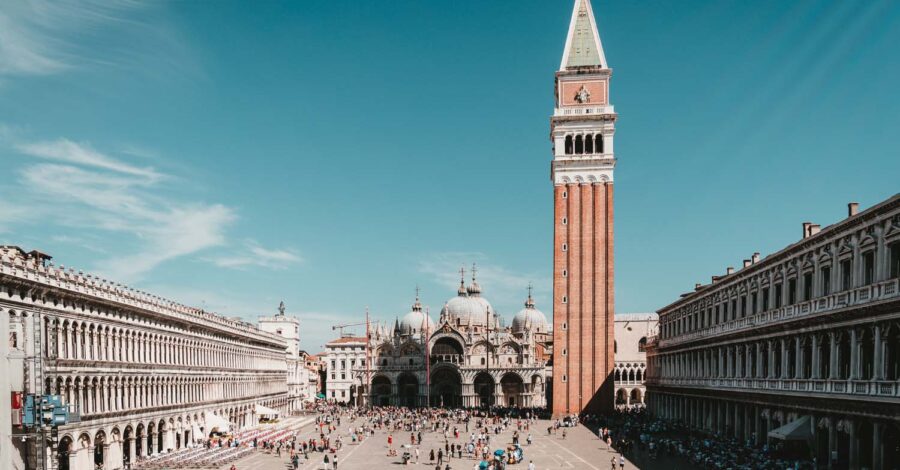
The city of Venice is made up of 118 islands, 400 bridges and 150 canals. But you might be surprised to learn it’s a pretty walkable city. The entire island can be explored in one, albeit long, day. No one neighbourhood is ever too far away from another. As such, there is a real connection between all the different parts of the island. Venice had only so much land to grow on before spilling into the ocean. Every brick, every stone and every bridge needed to be made with thoughtful consideration. The city’s architecture needed to be a cohesive part of this great puzzle. And walking around, it feels like entering a living art and history museum.
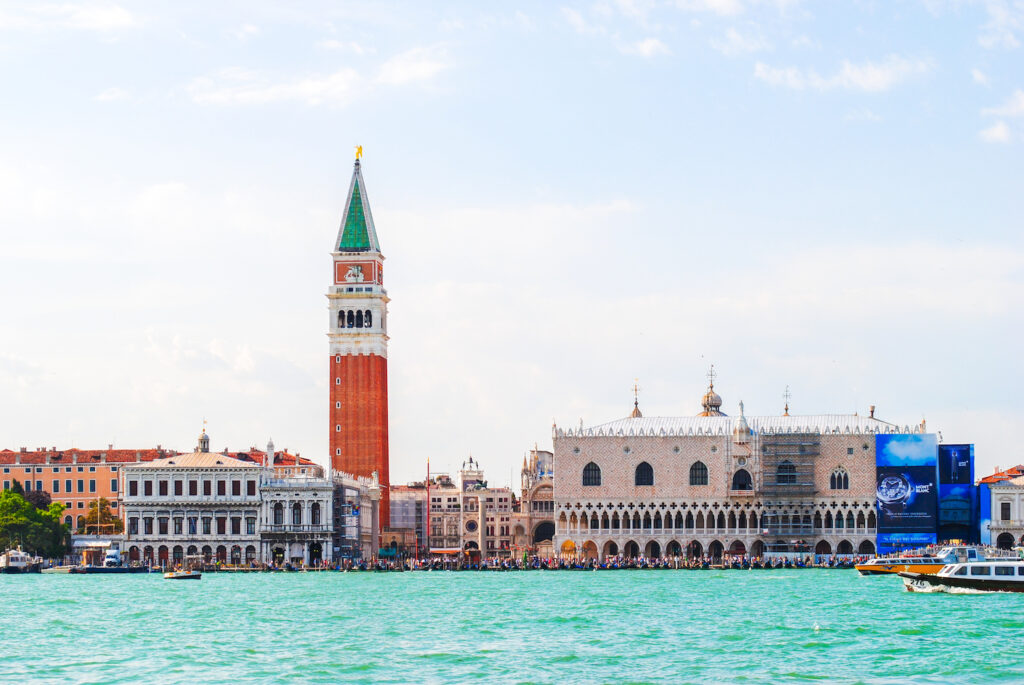
You could take dozens of walking tours around Venice, specializing in different themes or neighbourhoods. But this walking tour is perfect if you have limited time to see the city. Or you just want a good introductory tour to take you around the iconic places which helped form the history and culture of this city.
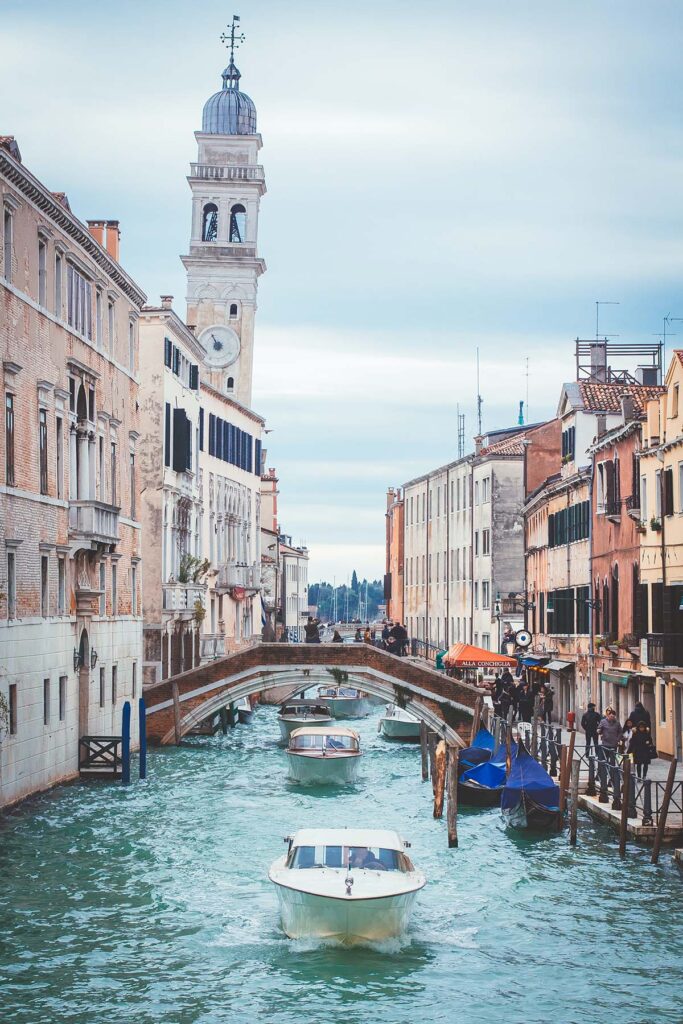
Walking Tour Details
How long is this walking tour.
This walking tour takes you around some of the most important landmarks around the island. I recommend leaving a whole day for it since it spans almost the entire city. Or you could break the tour into sections to spread over a few days. This tour serves as a great introduction to the various districts. Giving you a glimpse of where you might like to come back and explore more later.

When Should I do this walk?
Monday is a great day to do this tour. Most museums are closed on Mondays, yet the churches we will visit will remain open. Mondays are also when people have gone back to work, so you’ll get a better idea of what the neighbourhood looks like when all the shops are open. Businesses are bustling, and the cafes serve their daily customers. You can, of course, for this tour any day of the week, but I always recommend Mondays due to the museum’s closures.
Start the tour early in the morning. The earlier, the better. I usually wake up before dawn and go to St. Mark’s Square. As the sun rises above the city, the square is almost empty , except for the pigeons . There’s nothing like it. Well worth the sacrifice of a little bit of sleep.
When is the Best Time to Visit Venice
The best time to visit Venice is during the shoulder seasons of spring and fall, from April to June and September to November, respectively. During these months, the weather is pleasant, and the crowds are fewer, allowing you to explore the city without the hustle and bustle of peak tourist season. However, keep in mind that Venice experiences high tides, known as acqua alta, from November to March, which can make certain parts of the city inaccessible.
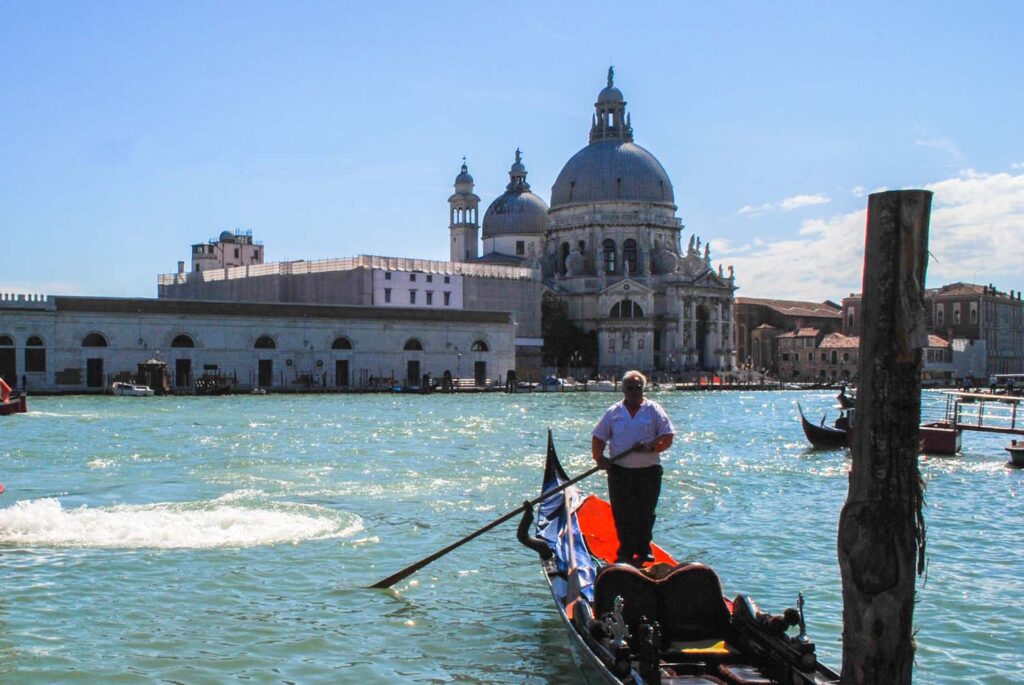
Venice Tourist Tax
Starting January 1st, 2023, Venice will implement a Tourist Tax for anyone staying in the city overnight. This tassa di soggiorno or tourist tax will be included in your hotel, B&B and alternative accommodation fee.
But soon, the city will be implementing a day-visit ticket. This is set to cost anywhere from €3 to €10. Visitors from cruise ships or the mainland must book their tickets to visit Venice in advance. This system has not yet been activated, but once online, day visitors will need to pre-register and select the day on which they plan to visit the city.
This new system is being implemented to help visitors contribute to the protection and safeguarding of Venice. All the money from these taxes goes directly toward improving the quality of public services and museums. As well as maintenance to prevent this historic city from sinking into the ground forever.
Start of the Tour: St. Mark’s Square
The best place to start your tour is standing in the centre of the Piazza San Marco or St. Mark’s Square. Arrive here as early as you can. There is something truly magical about being here as the sun rises on the square. You’ll see the beautiful rose-gold sunlight begin to kiss the cobblestone and bricks around you. The sun seems to bring the square to life as cafe owners take out their colourful chairs and pigeons flock around gawking tourists (but please don’t feed them!)
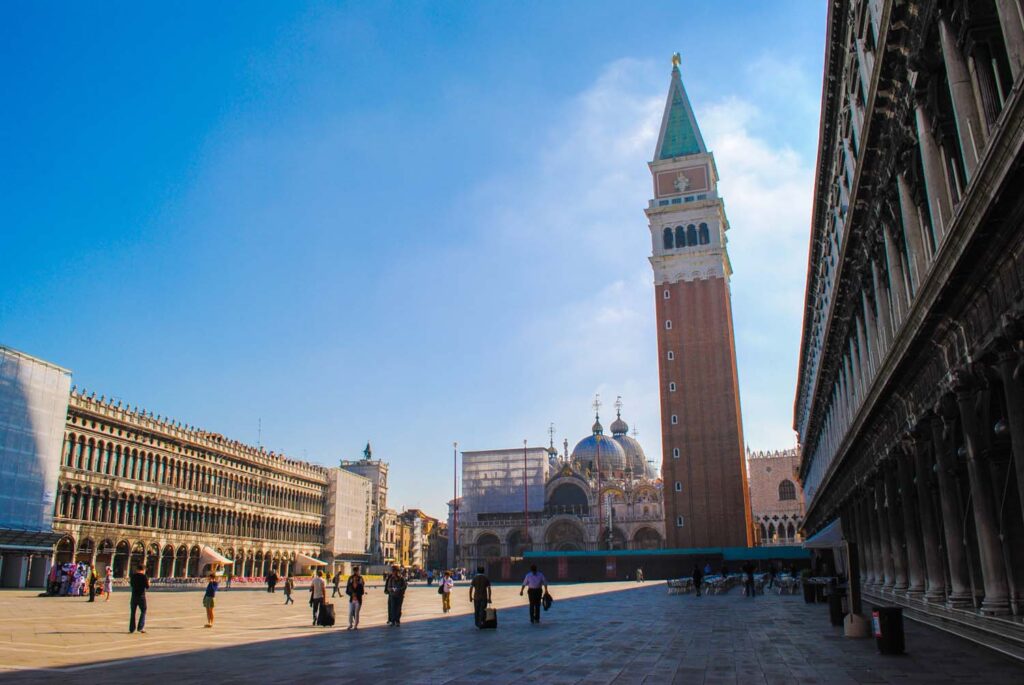
Standing in the centre of the square, in front of the Basilica, you can turn around 360 degrees and see one spectacular sight on top of another. In this small area, you’ll find the St Mark’s Basilica , the great Campanile (Belltower), the Procuratie, the Piazzetta, Doge’s Palace , Bridge of Sighs and Torre dell’ Orologio . There is rarely a time when you’ll visit the square when they aren’t some form of construction or renovation going on. With all these historical sights in one place, something is bound to be falling apart and in need of repair. Try to look past that and don’t let it ruin your experience.
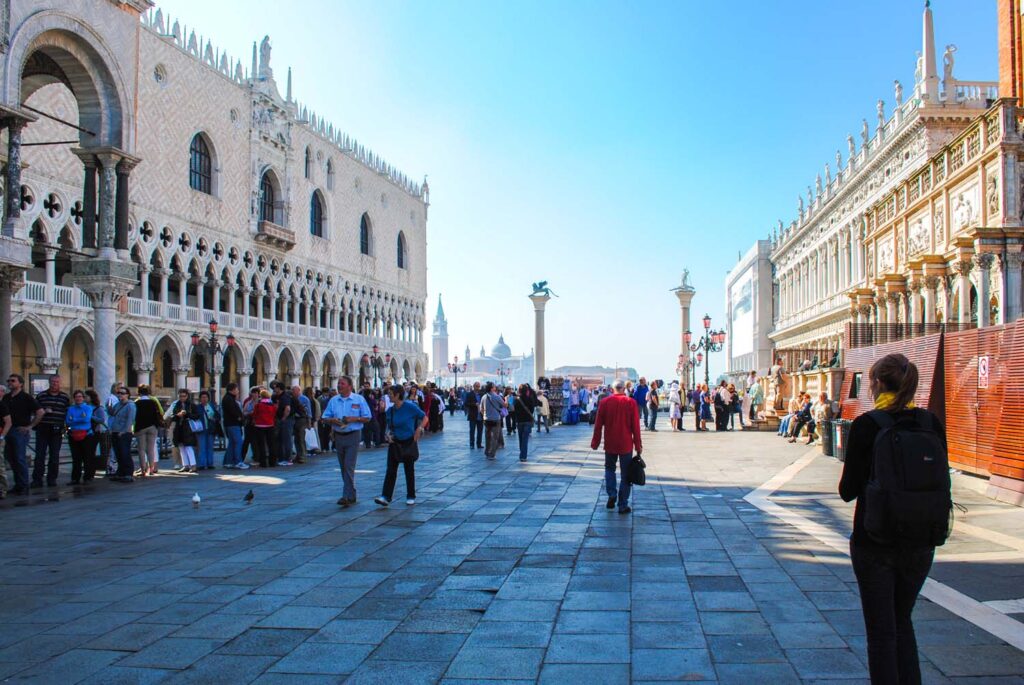
The square is named after the patron saint of Venice, Saint Mark . In 828, a relic of St. Mark was stolen from Alexandria and brought back to Venice by La Serenissima’s great naval fleet. The Venetian Doge, awed by the acquisition of this precious relic, adopted Saint Mark as the new patron Saint of Venice (whose honour had previously been given to Saint Theodore).
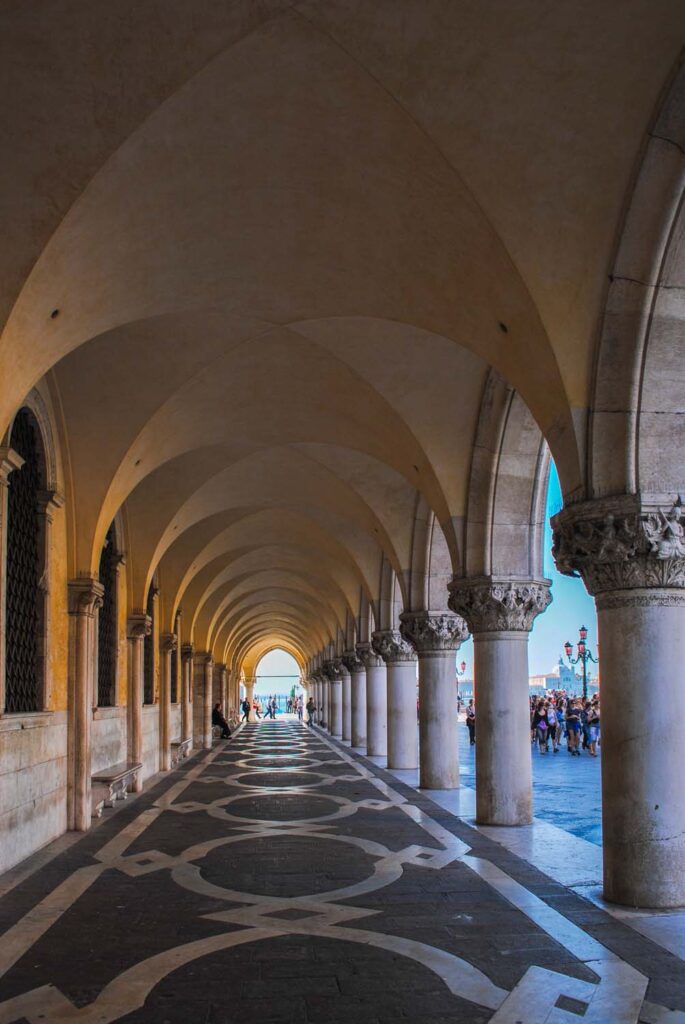
A city with a saintly relic immediately rose in power and prestige. Relics were the first tourist attraction of the medieval world. Pilgrims would come from all over the world to pray at the churches that preserved these relics. Pilgrims, much like tourists today, needed food and shelter. And therefore, they brought lots of money into the city.
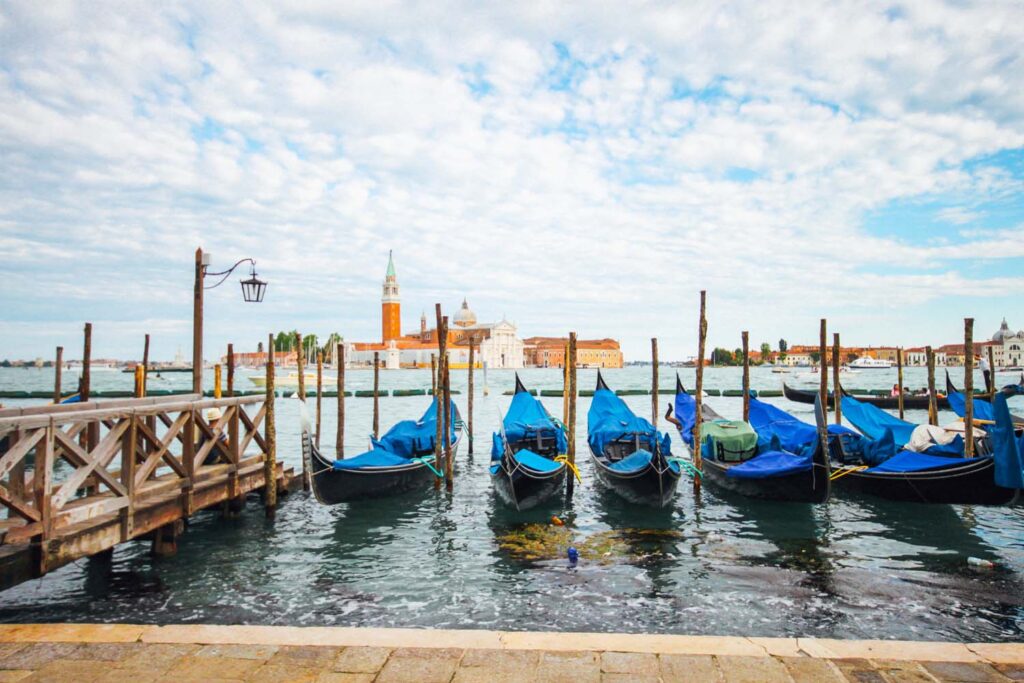
A grand church to house the precious artifact began to be built in 836. Even back then, the church and the nearby Doge’s palace were highlights of the medieval city of Venice. A great square was needed to further showcase the opulence the Doge wanted to project. In 1172, orchards were demolished surrounding this area, and the Piazza San Marco was built. It’s been rumoured that upon visiting St. Mark’s square for the first time, Napoleon himself degreed that it was “ the drawing room of Europe .”
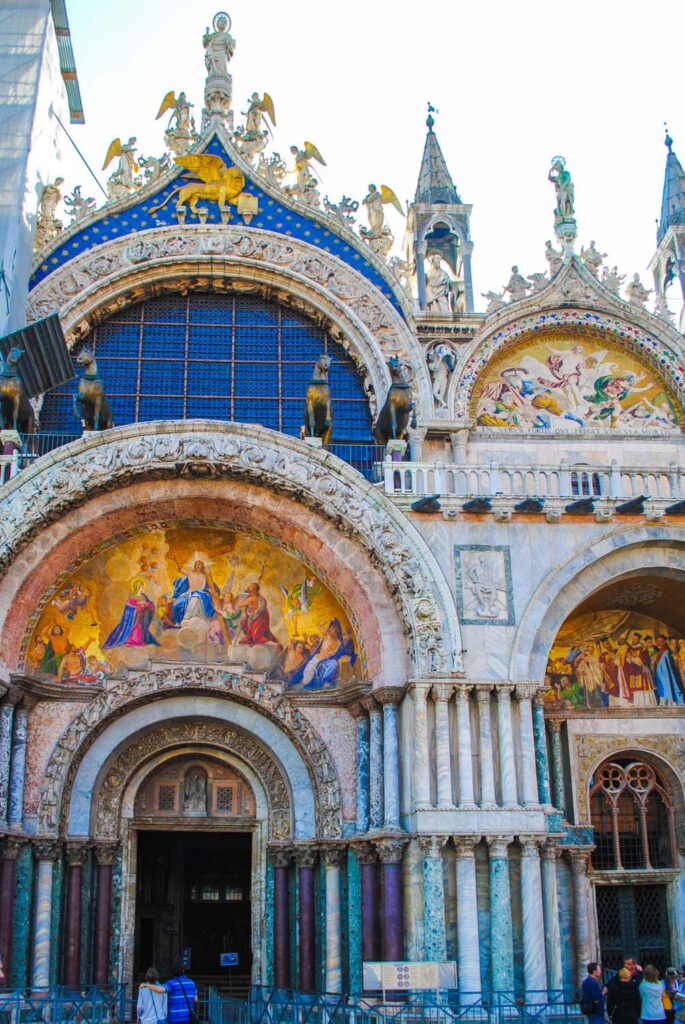
The Procuratie
The simplistic yet elegant buildings along the north and south sides of the square are called the Procuratie. The Procuratie is most identifiable by the stunning arcade that wraps around this side of the square. The arcade features distinct Byzantine arches that shield visitors from the elements.
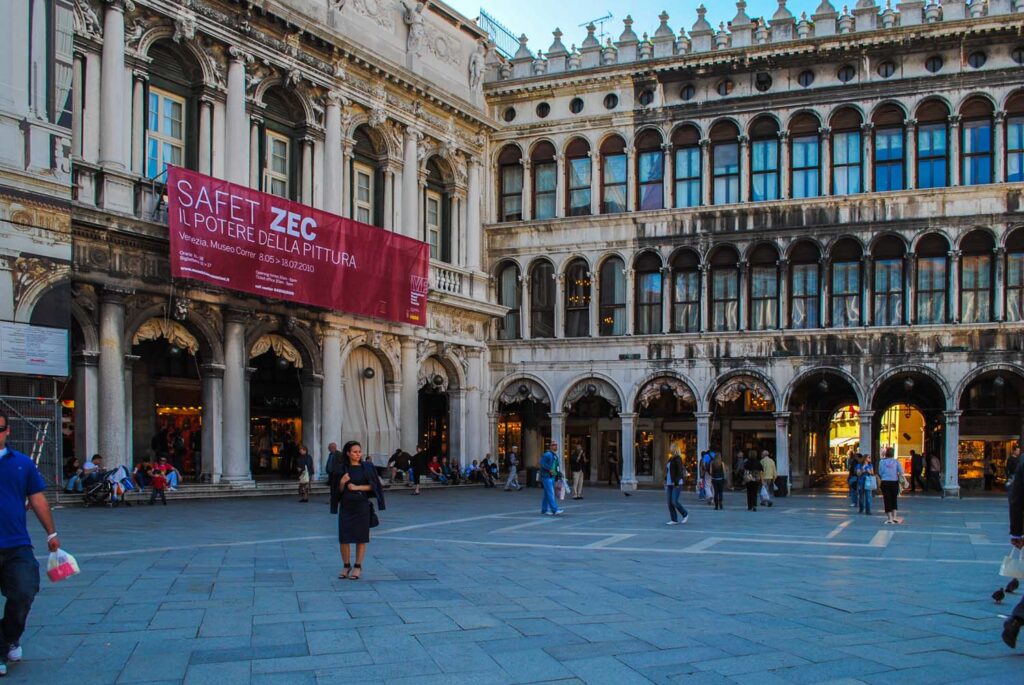
The Procuratie once served as the offices of the Venetian Republic, also called La Serenissima . Today they house the Correr Museum , the Museum of the Risorgimento , and the Archeological Museum . Each one of these is an incredible place to visit. But the Correr Museum is my favourite with its collection of art detailing the history of the city of Venice.
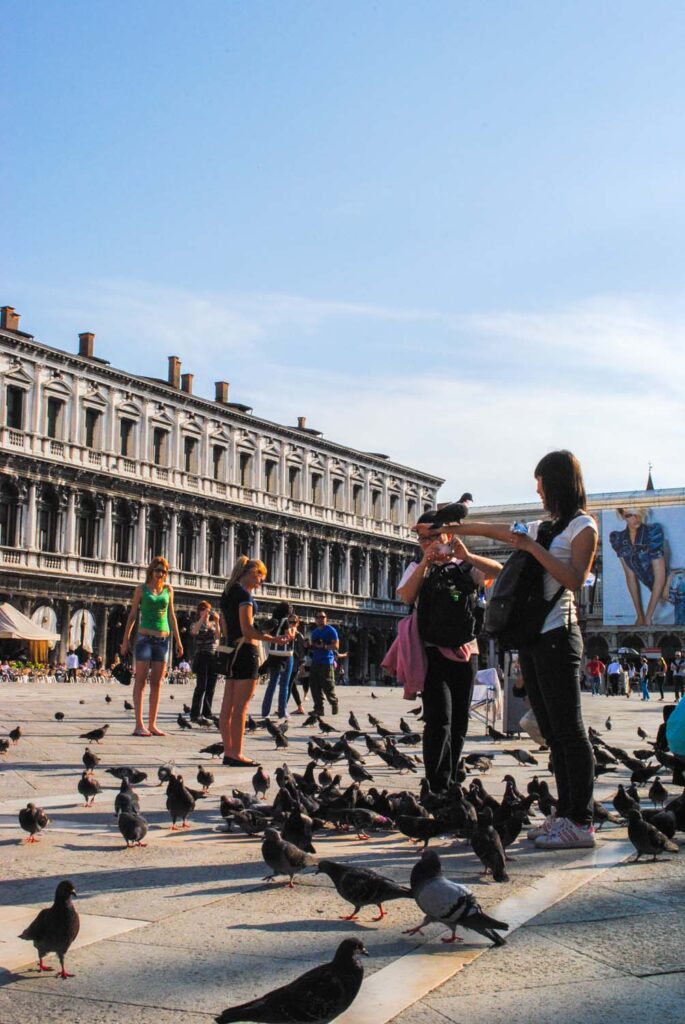
The Lion of Venice
Throughout St. Mark’s square, you’ll see various lion sculptures adorning doorways, columns and facades. The official ‘Lion of Venice’ is usually seen with his paw resting upon a bible. And he is not just any lion, but St. Mark’s Lion. St. Mark was often referred to as a lion, as he preached the word of the lord so powerfully it almost seemed like a roar. Legend says that when St. Mark was travelling through Europe and arrived in Venice, he was visited by an angel. The angel told him Venice would be where his body would rest for eternity. His remains were originally interred in Alexandra but moved to Venice, where the basilica was built to honour them as the angel had foreseen.
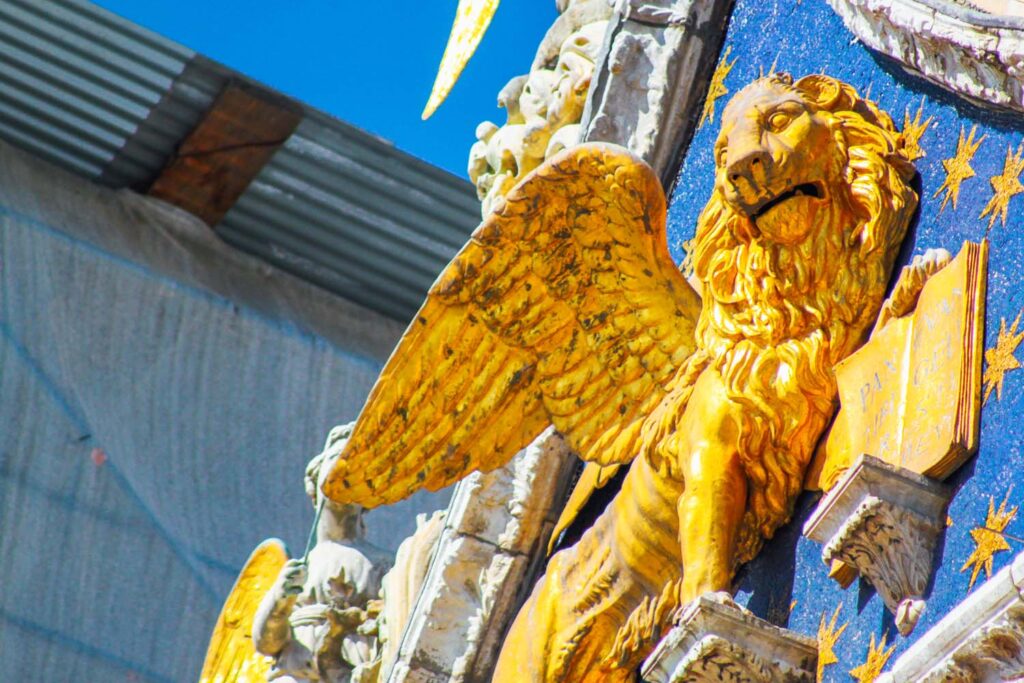
Caffe Florian
Now housed inside one of the old Procuratie is perhaps the most sumptuous cafe in Venice or perhaps Europe itself. Although this cafe is by no means cheap, it’s a splurge that I think is worth it to experience the incredible interiors and history to be found within. The Caffe Florian was founded in 1720 and has served patrons like Charles Dickens and Lord Byron . There is a €6 cover charge to even enter the cafe. But along with enjoying the lavish interiors, you’ll also be treated to live music throughout the cafe. Palacial red velvet couches and chairs are spread across the huge cafe, a maze of cozy antechambers. Each room is covered in ornate paintings, large Murano glass mirrors, gold foiled frames and intricate frescos plastered on the ceiling.
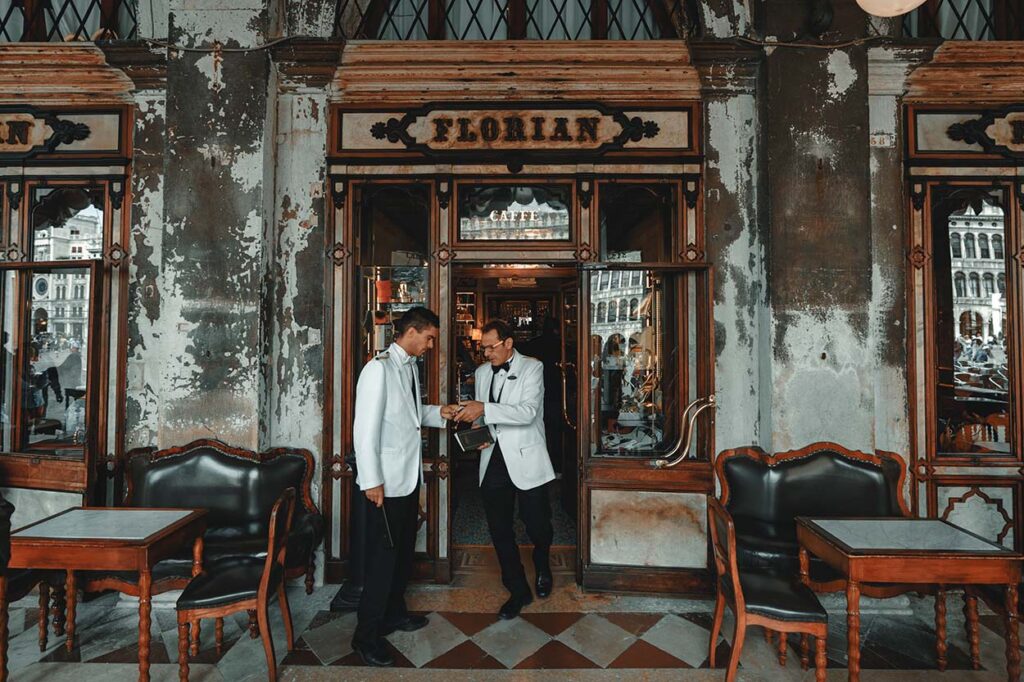
To save money, go to the bar and order your food or drinks there. Although you won’t get a seat, the bar menu is vastly cheaper than table service. An espresso at the bar will still run you €5, but again, you’re here for the atmosphere. If you’d rather save your money, you can opt to give this a miss. Instead, grab a coffee on your way toward St. Mark’s square from any local cafe to enjoy while you peruse the sights around you.
The Campanile
Standing guard in the centre of the square is the 323ft tall Campanile or Belltower . The low-level buildings throughout Venice are in stark contrast to the towering red brick Campanile. Its little pointed tower pokes out atop the skyline no matter where you end up in Venice. While the original tower was built in 1514, the current one is a reconstruction from 1912 after its collapse in 1902. It’s incredible to imagine that such a tall structure could survive for so long-standing atop the shifting waters below. But it wasn’t actually the water which proved to be the biggest enemy of the tower; it was lightning. Lightning struck the tower multiple times over the years, causing several fires and severe internal damage to the structure.
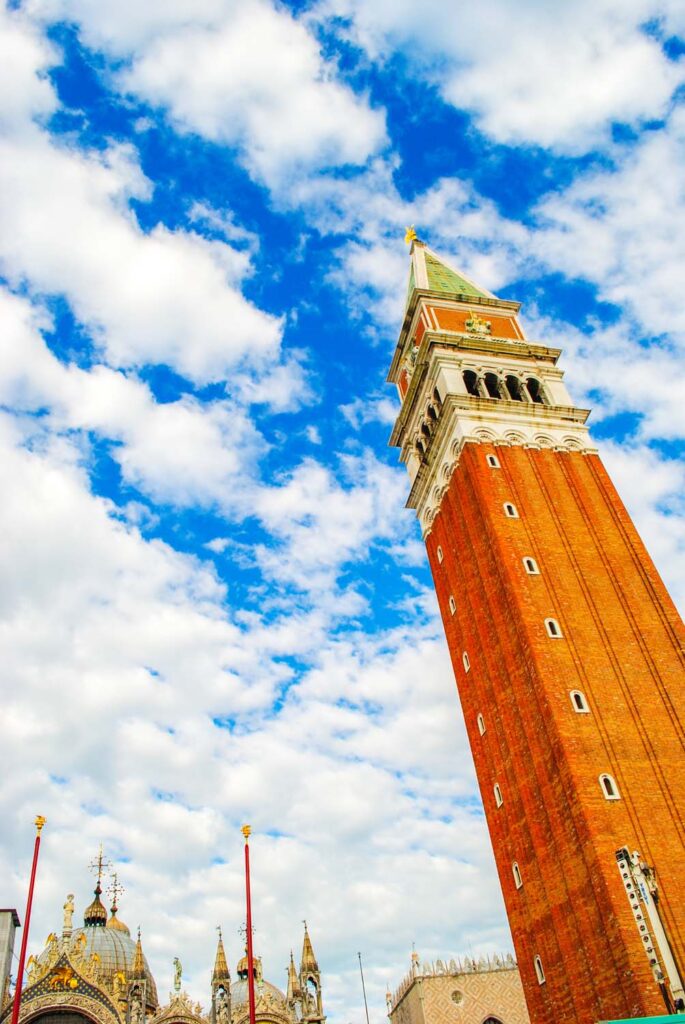
The Bells of the Campanile
The tall base of the tower is designed with a fluted shaft that reaches up towards the belfry. On each side of the belfry are a series of arched windows looking out over the square. Inside the belfry are five huge bells. Each one was used to call the people of Venice to attention. The bells have their own distinctive name and special significance. The Renghiera bell announced executions. The Mezza Terza would declare that a session of the Senate was taking place. The Nona sounded the midday hour. The Trottiera was used to assemble the Maggiore Consiglio and the Marangoni, the largest of the bells, rang to mark the beginning and end of the working day. Before anyone even had watches to tell time or Twitter to announce the day’s news, these bells were all the public had to get collective, daily information.
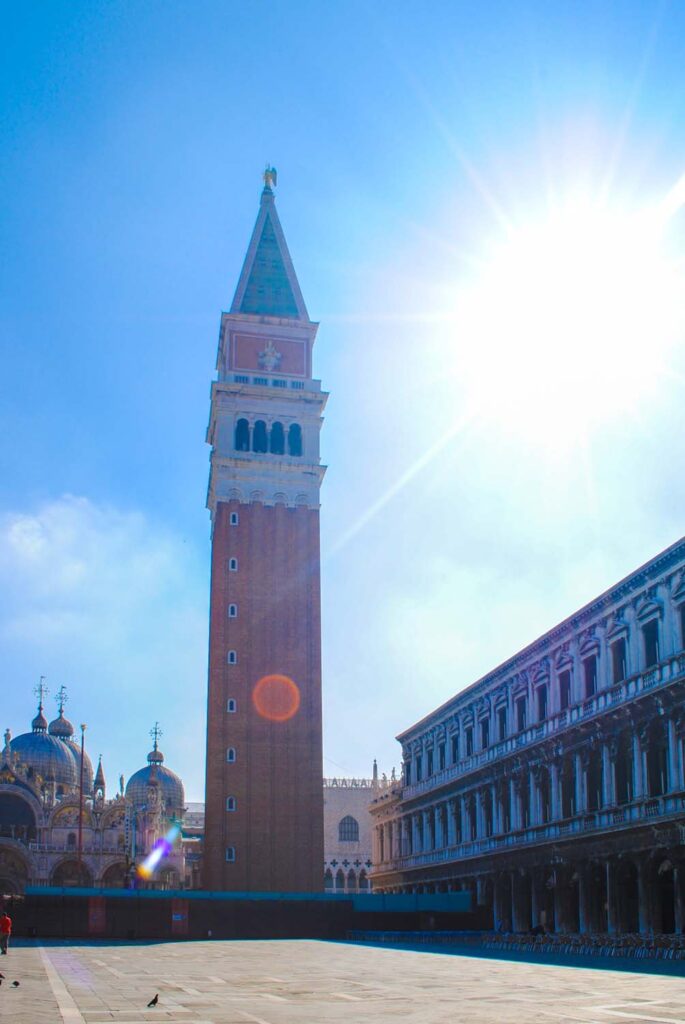
Above the arches of the belfry is another level of brickwork decorated with various sculptures on either side. On one farside, you’ll see the Lion of St. Mark and on the other, the female representation of Venice, in the shape of the Lady Justice. The golden weathervane which crowns the tower is sculptured into the angel Gabriel. He stands tall, reaching out toward the citizens below.
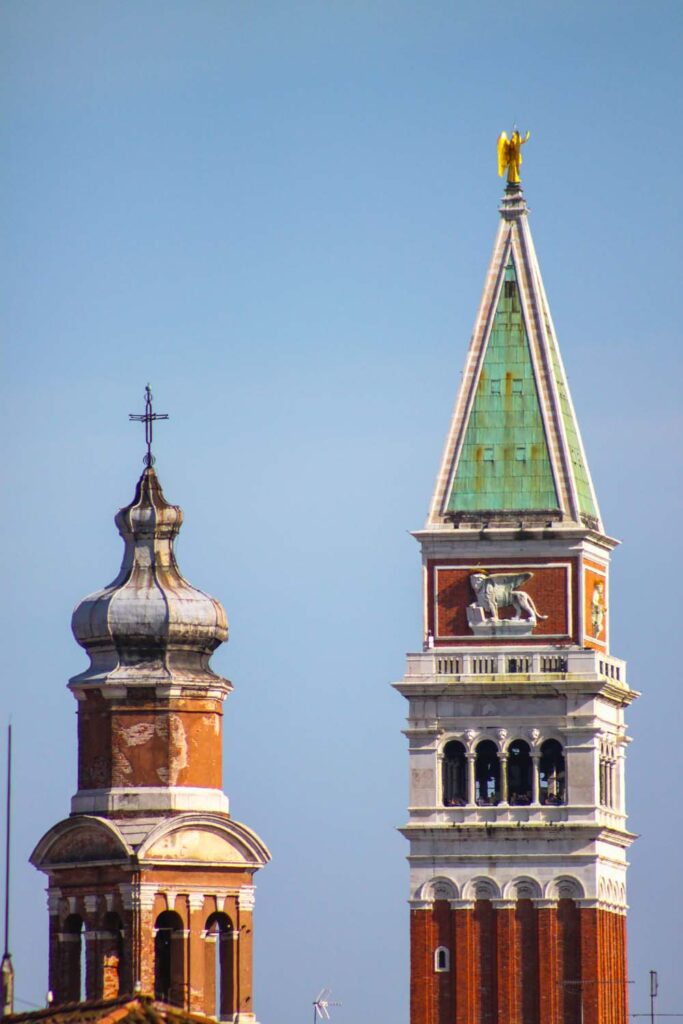
Torre Dell’Orologio
Turn to the square’s northeast corner, and look up at the bright blue and gold details decorating the fantastical Torre Dell’Orologio . In the morning light, the sun glints off the golden dials. The clock was built in the 15th century when the possession of a mechanical clock symbolized the wealth and power of a city. The clock was positioned facing out towards the water so that any foreign ships could see the time from the canals as they passed through. With a spyglass, of course, their eyesight wasn’t that good.
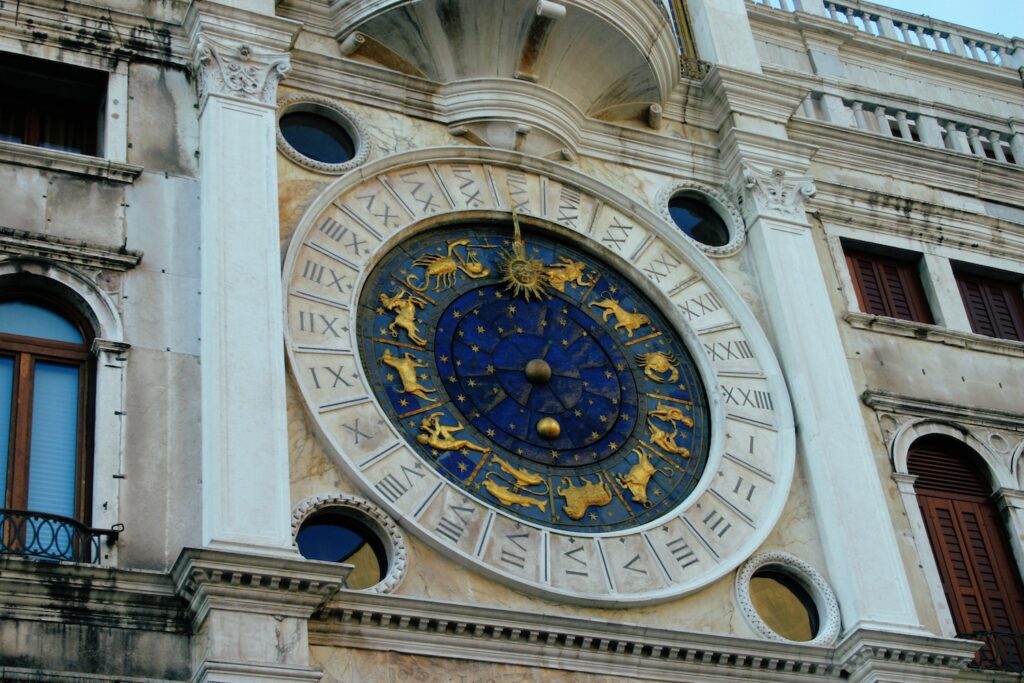
Atop the tower containing the clock, you can see two small bronze figures who carry large hammers in their hand. These figures move upon the hour to strike the bell, causing the bells to ring. One of the figures is a young man, and the other is an old man, symbolizing the passage of time. Once more, we see the image of the Lion of Venice above the clock, set against a blue sky of golden stars. Below the lion is the figure of the Virgin Mary with the baby Jesus wrapped in her arms. On either side of her are two blue panels with the time represented in roman numerals on the left. And on the right in Arabic numerals, as was the tradition during the Byzantine era.
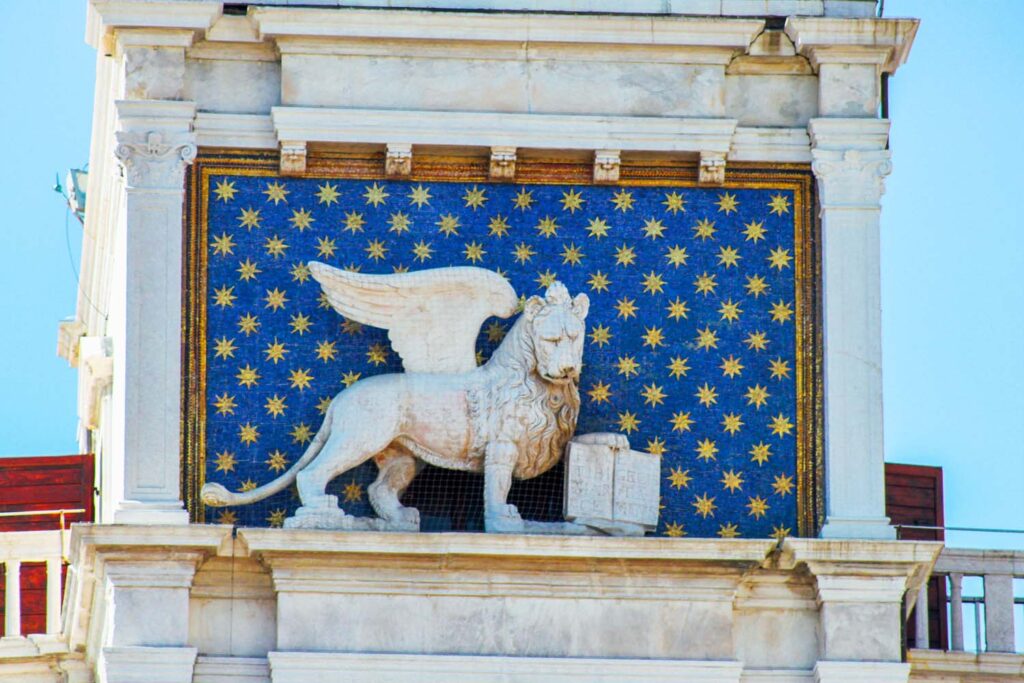
The Clock Face
The most impressive feature of the clock are the blue and gold sculptural engravings set within the numerals. Each one was fantastically carved to represent the signs of the zodiac. The central dial, emblazed with the sun’s image, revolves around the zodiac signs. But rather than showing the time, the sundial marks the date. The smallest dial, closest to the central, holds a tiny orb representing the phase of the moon that changes throughout the year.
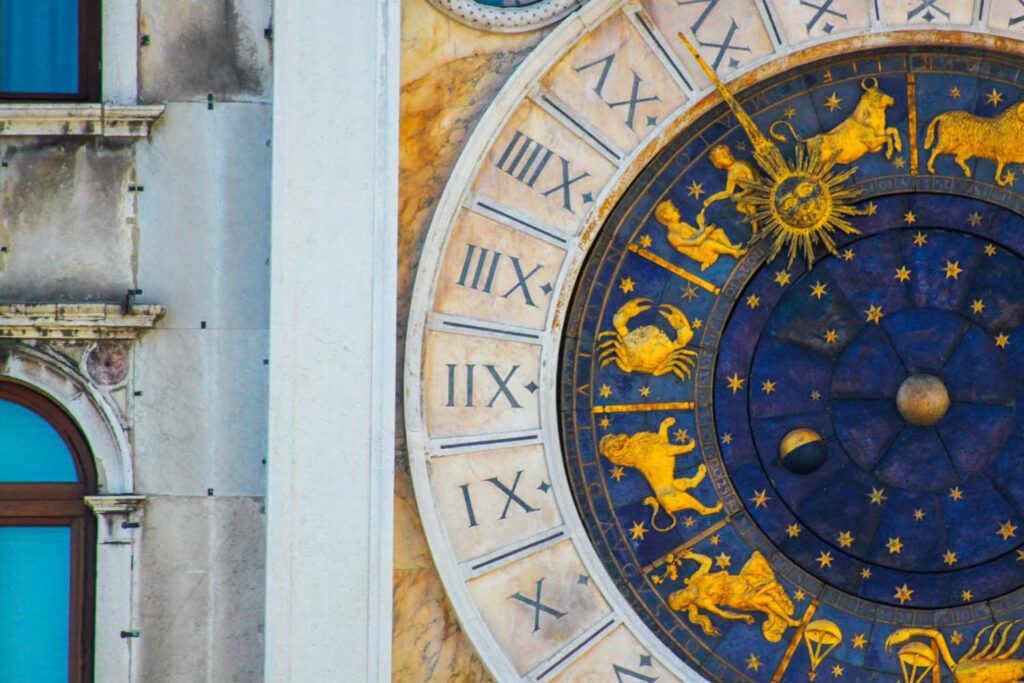
St Mark’s Basilica
St. Mark’s Basilica is one of the most precious treasures from the Byzantine period. Preserved in amber, there are so many aspects of history, art, culture and faith from that era. The most significant elements of the church’s design are the mighty, tiled onion domes that glitter against the sea-blue sky. The bulb-shaped domes with their golden finials lanterns give the church that middle eastern appearance that defined Byzantine art and architecture.
Exterior Design of St. Mark’s
The exterior of St. Mark’s Basilica can be studied by looking at its three distinctive areas; the lower level, upper level, and domes. The lower-level mosaics portray scenes from the life of Saint Mark, for whom the church derives its name. In the central arch where the enormous doorway is located, there is the largest mosaic, which depicts the Last Judgment. The original mosaic would have been made in the 13th century, but this current incarnation is from the 19th century after much-needed restorations. The portals that lead into the church are held up by marble columns in a plethora of colours and patterns. Each one is set inwards, towards the doorway, creating a foreshortening perspective. Giving the viewer the effect of being pulled into the church.
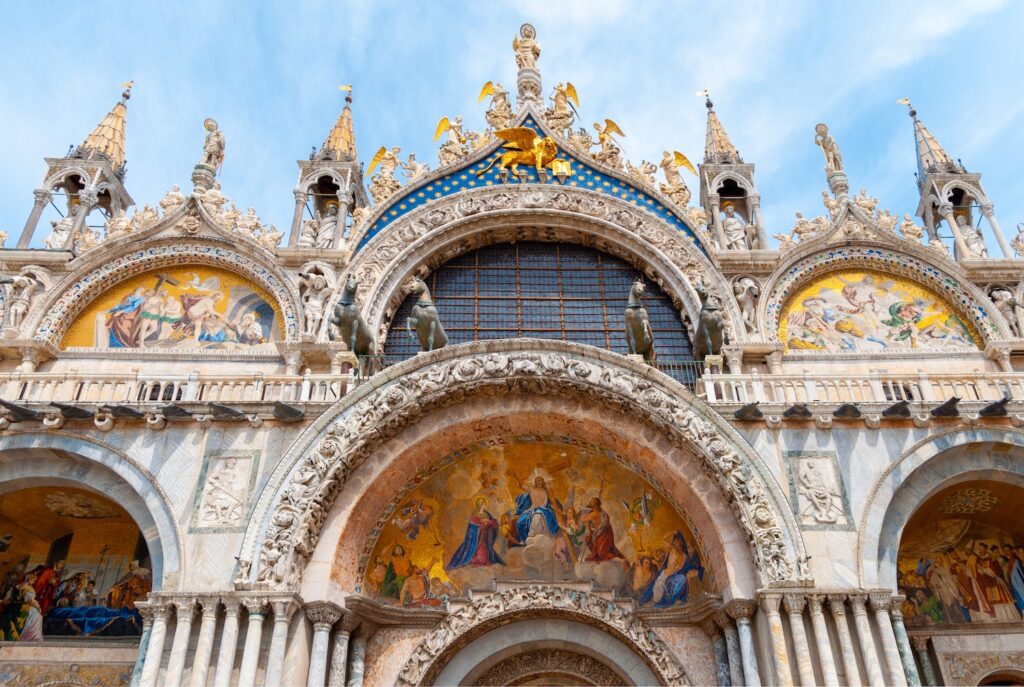
On either side of the central portal, the mosaics depict the life of St. Mark. The mosaic on the left is the only surviving piece from the 13th century. Above these central portals, we can study the arched lunettes. These mosaics depict the life of Christ.
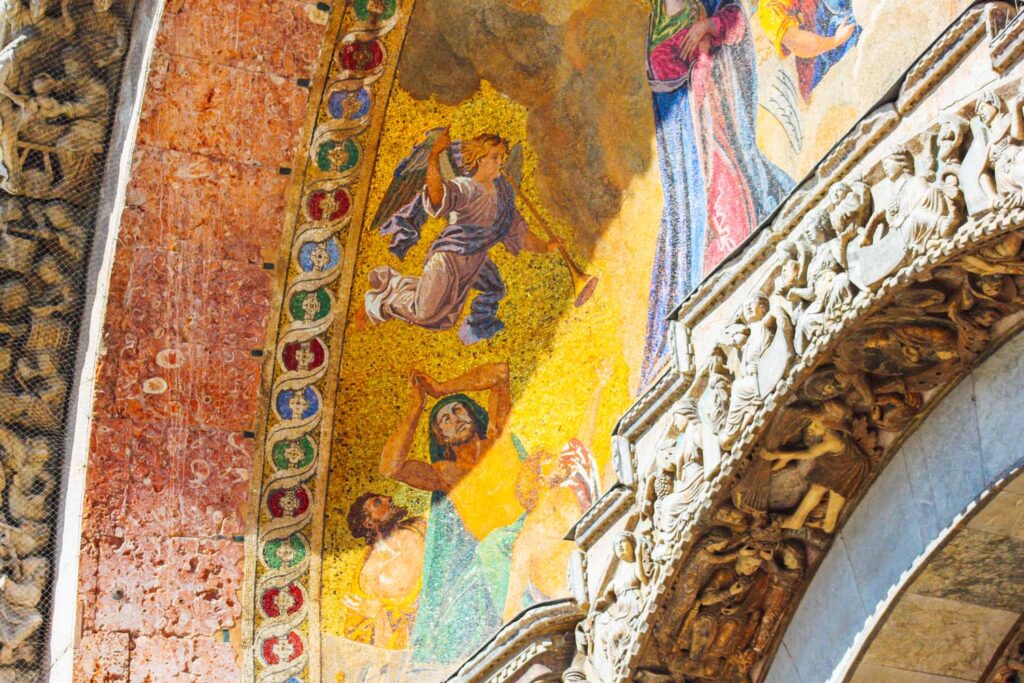
The Balcony
The upper-level balcony is home to four important bronze horses. These are the Horses of Saint Mark-Lysippos . Originally stolen from Constantinople in 1252. The ones outside the church today are replicas of the original sculptures, as these suffered terribly from the elements. They were brought inside the church museum to ensure they could be preserved for years. The bronze horses date all the way back to classical antiquity. It is rumoured that perhaps they were once a part of the Arch of Trajan in Rome . Positioned pulling an emperor’s chariot. But these horses were one of the many trophies collected during the Crusades, which is how they journeyed to Venice.
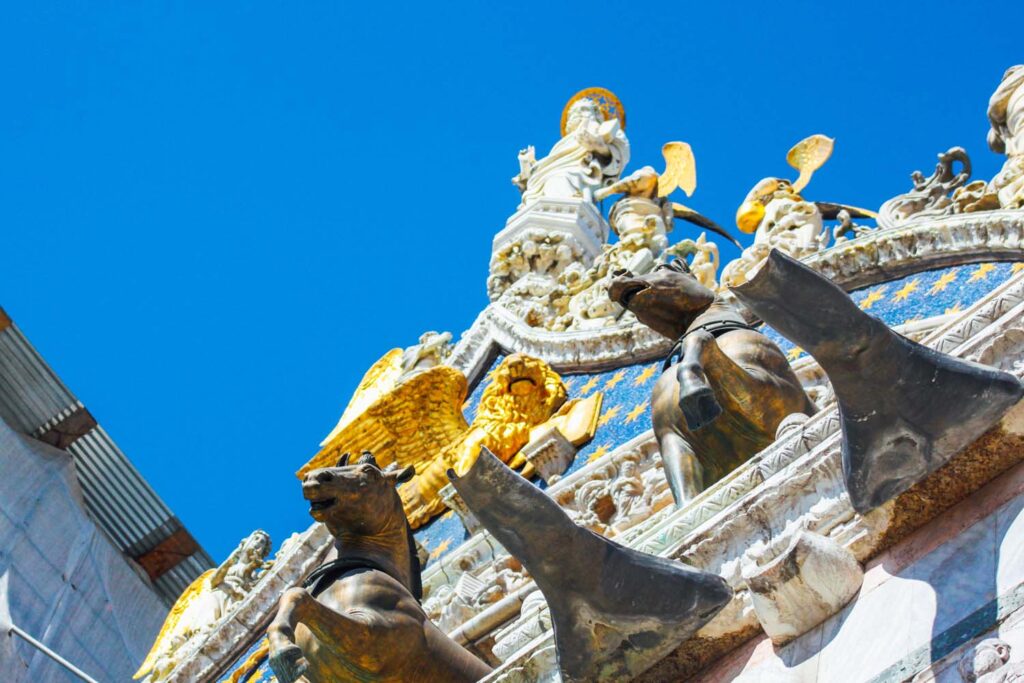
Ogee Arches
Arching behind the golden horses and above the second-floor lunettes are a series of ogee arches. Ogee arches are a type of arch with an S-shaped curve consisting of two arcs that meet at a point. Not only do these designs add an aesthetically pleasing element to the building, but they also serve a functional purpose by providing additional support for the structure. Ogee arches have a rich history in architecture and can be traced back to various ancient civilizations, including the Romans and the Greeks. However, the use of ogee arches in Islamic architecture during the 12th and 13th centuries is where they gained prominence and influenced such structures as the basilica we see today.
Set within the central arch is the gilded and winged lion of Venice. Standing brightly against the blue-tiled sky and golden stars. Saint Mark and his choir of six angels decorated the top of the facade, looking down on the throngs of visitors below.
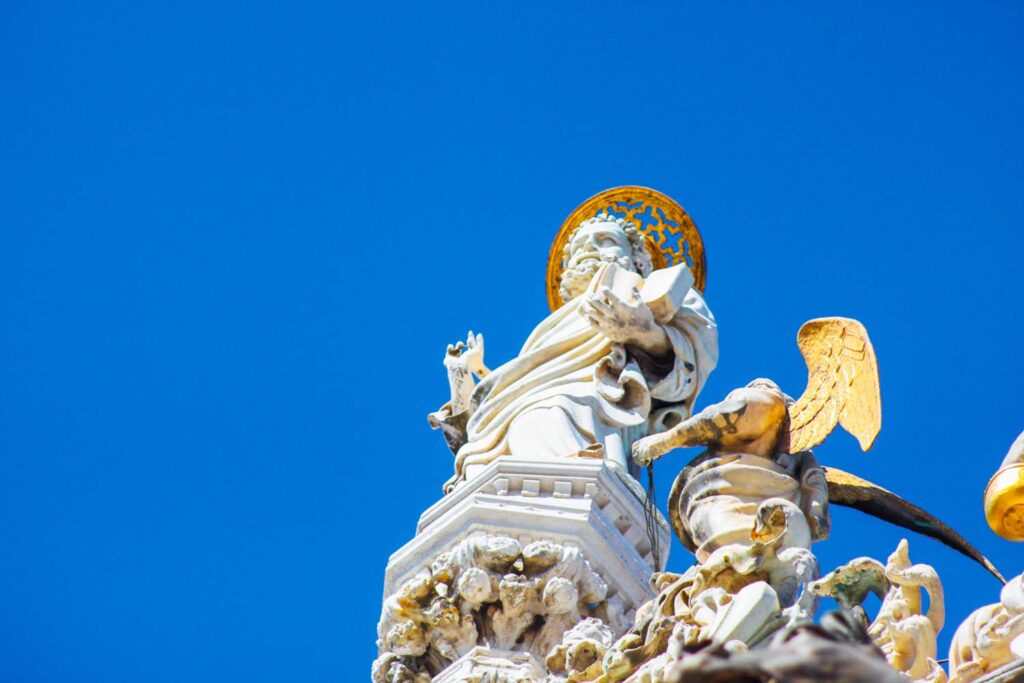
Admission & Tickets to St. Mark’s Basilica
If you want to go inside the Basilica, be warned that the queue can get very long. And you need to book your tickets in advance and select the exact arrival time. But even with these timed tickets, you will still need to wait in line. Reserved timed tickets to cost €20.50 and include an audio guide. There is also an option to purchase a skip-the-line ticket, but this will cost €39. Free cancellation is included in your ticket, which must be done 24 hours in advance for a full refund. I would choose the earliest reservation time to ensure you are the first in the door, leaving the rest of your day open.
No large bags or backpacks are allowed inside the basilica. If you have one, leave it at the Ateneo San Basso in the Piazzetta dei Leoncini (at the north facade to the left of the main entrance.) Be sure to do this before you get in line as you don’t want to be turned away and have to line up again. Remember that the basilica requires guests to adhere to their dress code. No bare shoulders or shorts, and men should wear shirts.
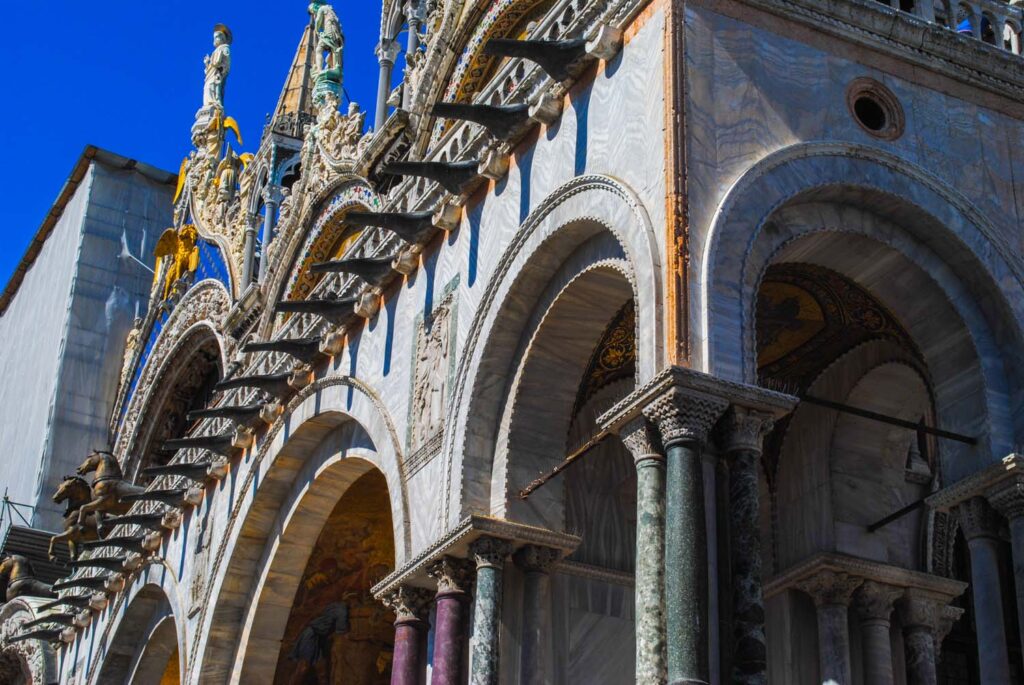
Interior of St. Mark’s Basilica
Upon entering the church, you’ll first notice the overwhelming amount of golden mosaics covering everything from the floors to the ceiling of the building. There are over 85,000 square feet of mosaics in St. Mark’s Basilica. The light reflects off the surface of the glass, and depending on the time of the day, the light can change the effect and the appearance of the interior. There was such a large amount of gold used in the church’s construction that the residents of Venice began to call it the Chizea d’Oro or the Gold Church .
View this post on Instagram A post shared by Erika Diehl (@circa_naviculam)
Because the Basilica was built during the Byzantine age, architectural methods weren’t as advanced as they are now. You’ll notice thick walls, hundreds of columns and the heavy use of marble, which were used as rudimentary supports. They needed to use the strongest of materials to help keep the multi-domed ceiling from caving in.
Inside the church are the treasures of the fourth crusade on the holy land. During the 4th century, Venice deemed itself the holiest place on earth. And therefore, all the treasures crusading armies found were brought to Venice. One such treasure was the Pala d’Oro . The Pala d’Oro is the frame enclosing the high altar inside the church. It is decorated with panels featuring 1,300 pearls, 300 emeralds, 300 sapphires, 400 garnets, 100 amethysts, rubies, and topazes. A glittering masterpiece.
View this post on Instagram A post shared by Matt Rochell (@mattrochell11)
Porta Della Carta
When you exit the church, be sure to take a moment to study the Porta della Carta on the south side of the church. In 1442, the ceremonial entrance was built to connect the basilica to the Doge’s Palace . The doorway is dripping in gothic ornamentation, with two tall, thin pinnacles flanking either side of the statue of the Doge Francesco Foscari. The statue of the Doge is seen kneeling before the Lion of Saint Mark. Below each pinnacle, we can also spot various statues representing the cardinal virtues.
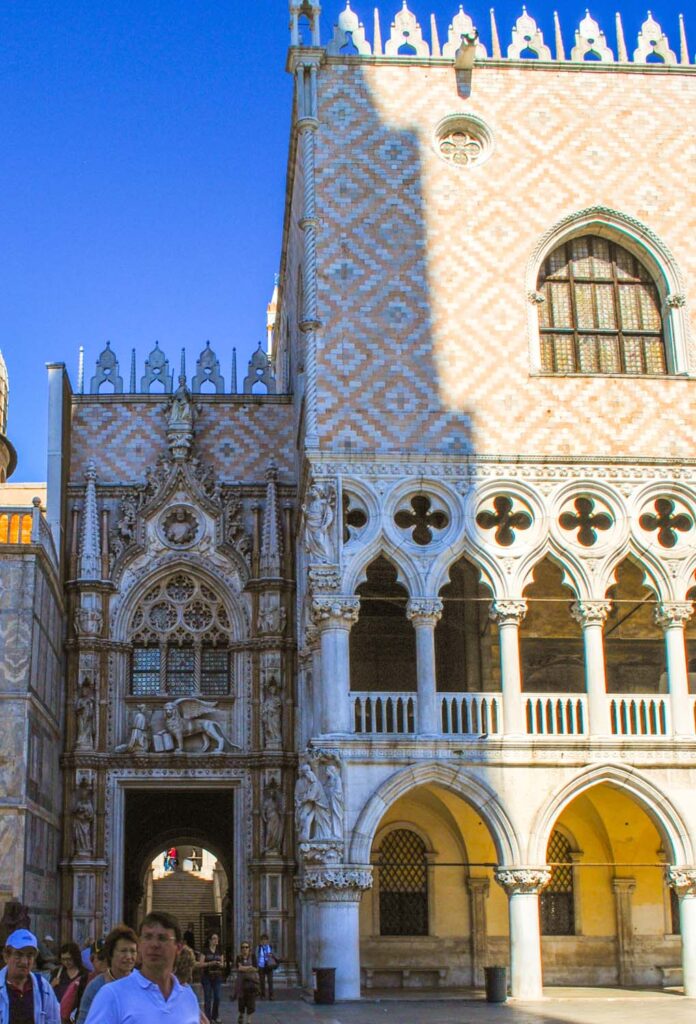
Doge’s Palace
A Venetian Doge is something that many of you may not have heard of before. A Doge is pretty much like an English Duke; who served as the leader of the Republic of Venice from 726 to 1797. The Doge would rule over Venice from his seat of power inside the incredible Doge’s Palace . Today the building serves as a public museum .
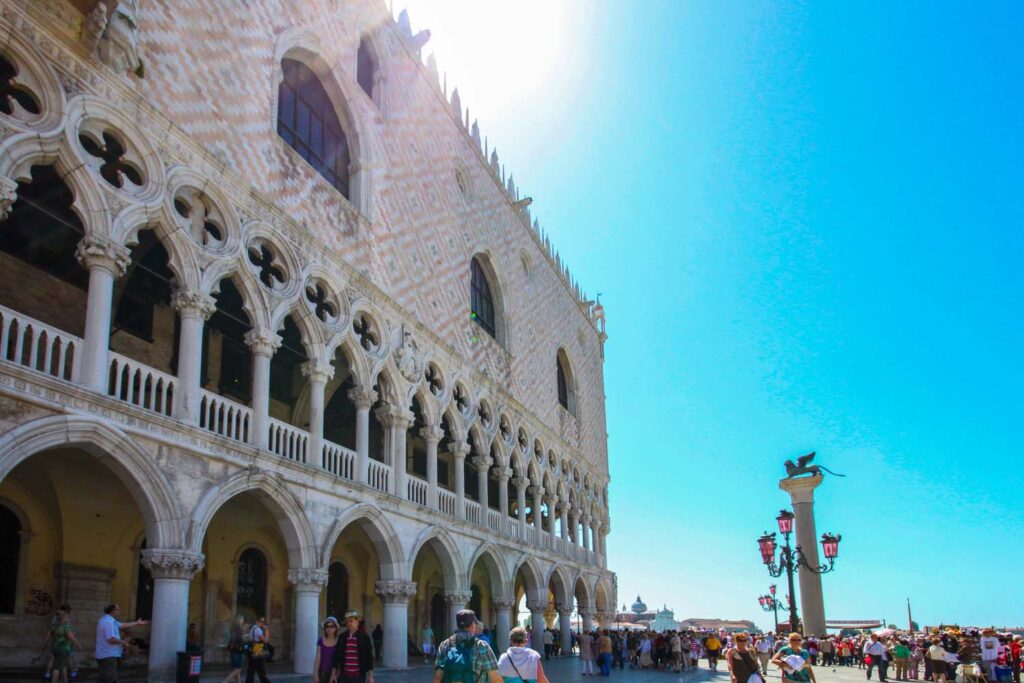
The building itself is a wonder to behold. Despite the enormity of the upper structure, it looks almost weightless as it is supported by these delicate pink Verona marble columns. The columns are decorated with a lacy pattern, making them look even more fragile. The top of the building is adorned with spiked merlons that look like meringue frosting atop this architectural cake.
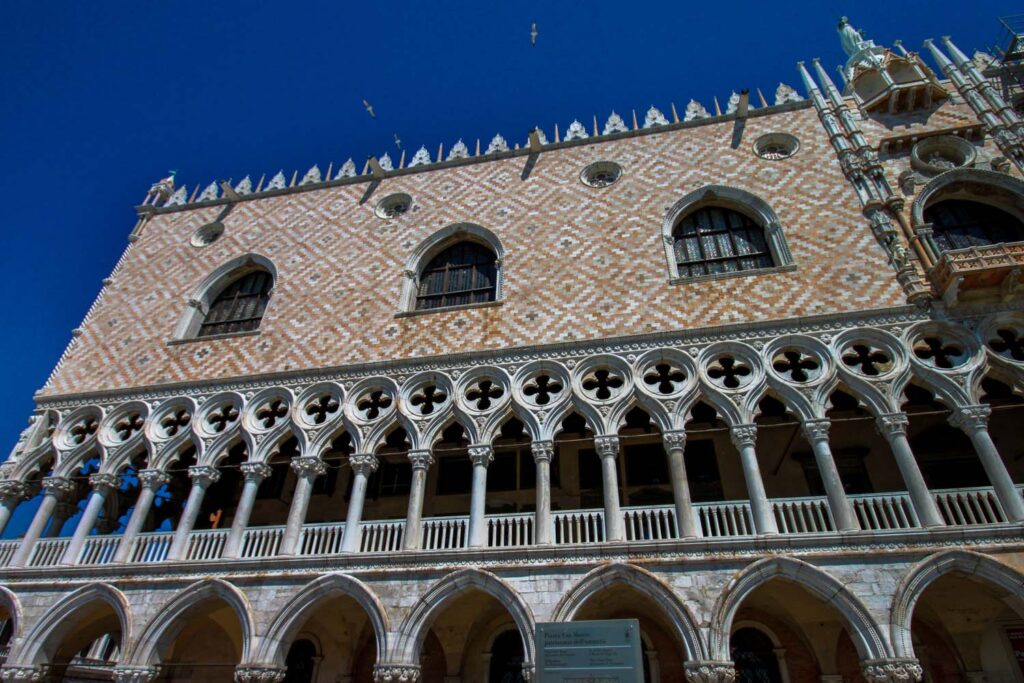
Walk through the arcade under the Doge’s Palace and study the individual capitals atop the exterior columns. Each one features a different set of sculptures with various animals, vegetal designs and more!
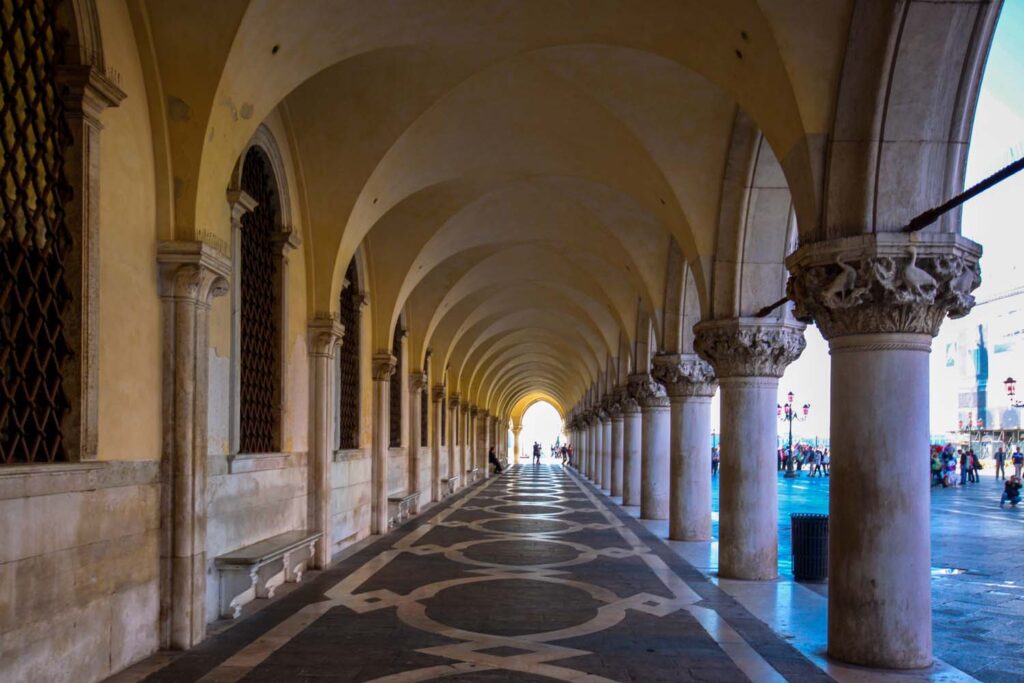
Piazzetta
Past the Basilica, walk south towards the water, where you can find the Piazzetta . The Piazzetta is the smaller square to the south of the main square. In the middle of the square are two large two columns made of red marble. These two columns were where death sentences were announced during the medieval ages.
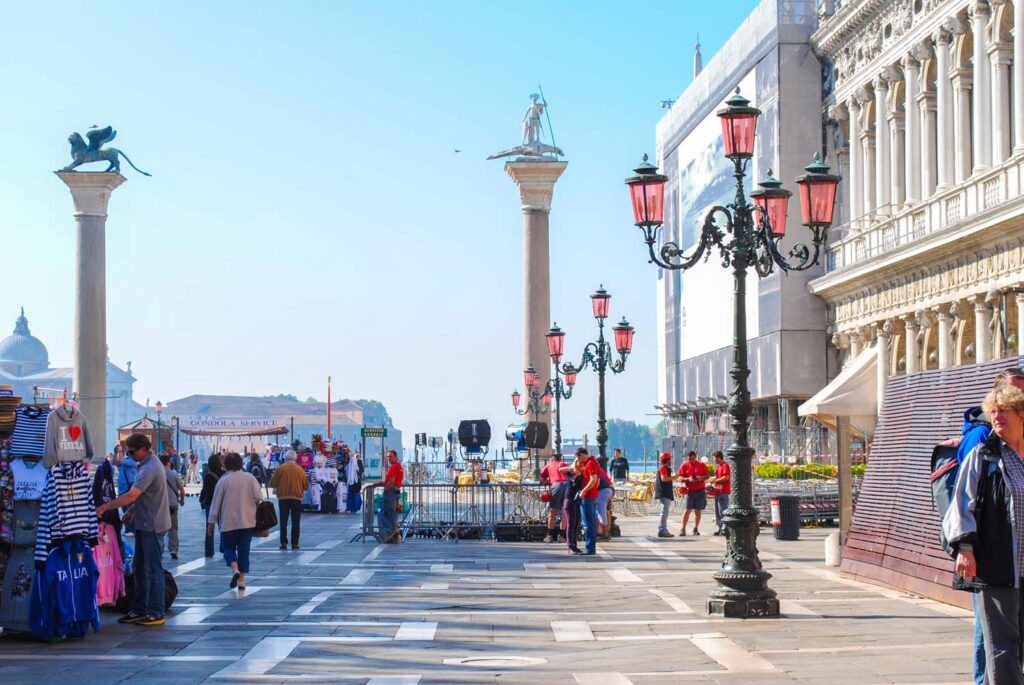
At the top of the columns are two statues. Each depicts one of the patron saints of Venice, St. Mark and St. Theodore , on the left and right, respectively, if you’re facing the water. St. Mark is depicted as the winged lion of Venice, and St. Theodore can be seen standing atop, of all things, a crocodile . In his hand, he holds a spear which we can assume he used to slay the giant crocodile. Saint Theodore is commonly known for slaying a dragon, not a crocodile. But perhaps the Venetian artists of the time had little knowledge of what a real dragon looked like, so instead, they carved the next best thing, which I guess was a crocodile. Makes sense when you think about it!
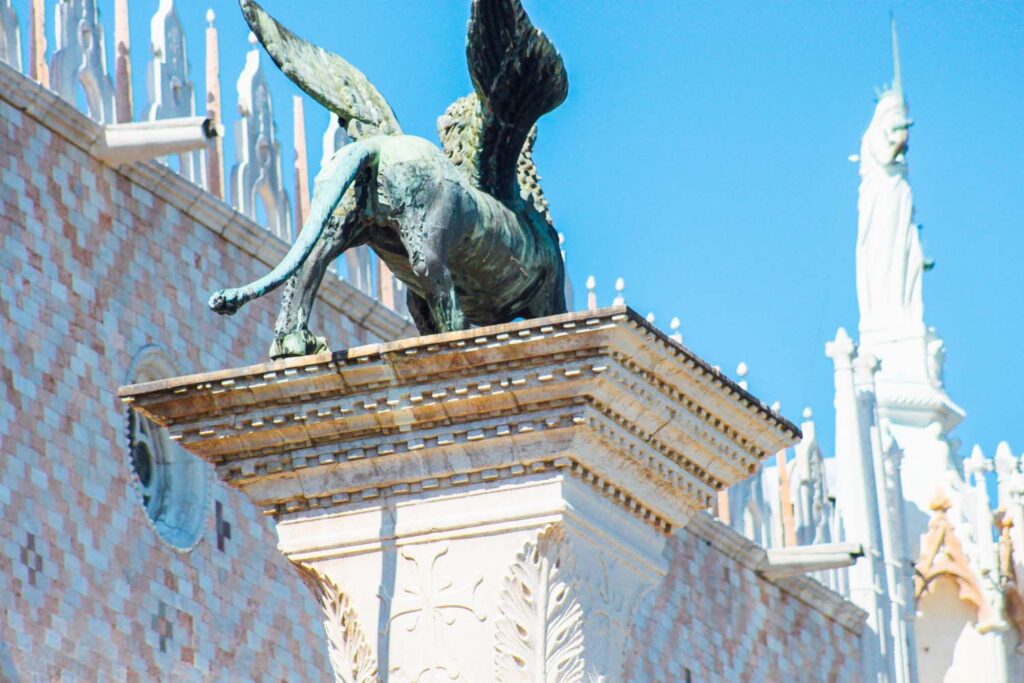
The Bridge of Sighs
Walk around the Doge’s Palace until you turn to face the Bridge of Sighs . The bridge of sighs was created to join the interrogation rooms of the Doge’s Palace to the prison across the canal. If you were found guilty by the Serenissima, you were sent to prison, but upon crossing the bridge, you were allowed to look out at Venice one last time. Two small, square windows on the bridge allowed prisoners this one moment of reflection before facing their possible lifetime of imprisonment. The windows on the bridge are covered in tightly knit wrought iron bars, so no one could make an escape.
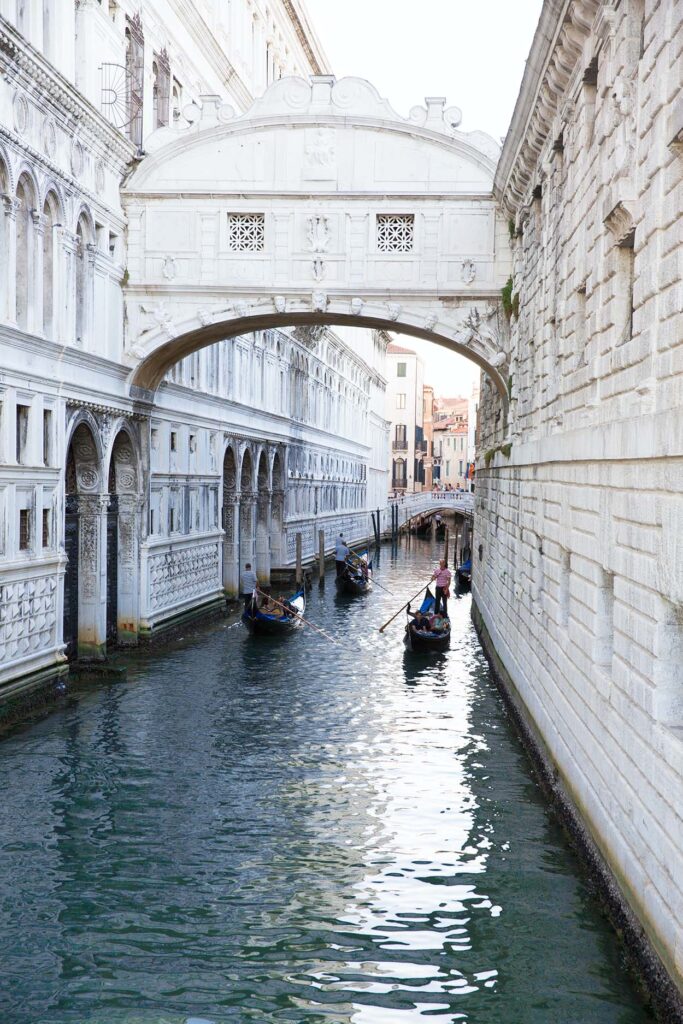
Calle de Fabbri
Head back to the area in front of the Basilica, and walk north along the Calle de Fabbri , crossing over the Ponte dei Dai . Calle is the Italian word for a narrow street. Like many streets in Venice, this one is named after the occupation of the people who worked in this area. Fabbri means locksmith , and it was along his street where you’d once have found the city’s locksmiths at work. Head northwest on Calle dei Fabbri and turn left onto Calle S. Gallo until you reach the Ponte Tron .
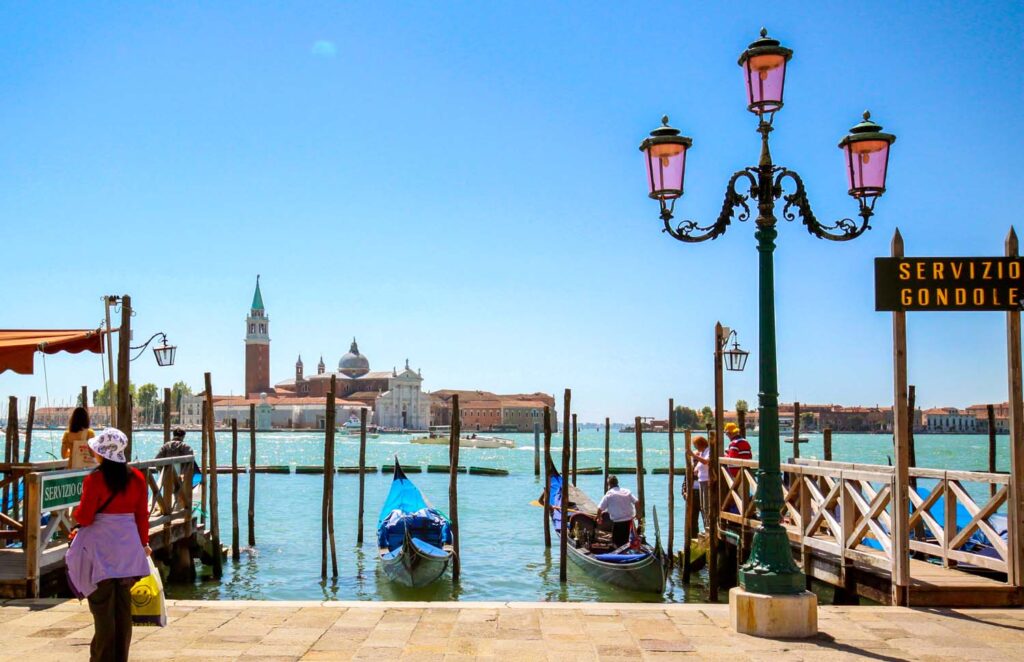
Due to the proximity to St. Mark’s square, this bridge is often pretty crowded. But its old stone design and views out to the gondola-covered canals aren’t anything to whizz past. If you’re lucky enough to be here when it’s quiet, this is one of the more romantic spots in the city. Even on busy days, I love just standing here just watching the gondola traffic. Sometimes dozens of gondolas get stuck in this narrow canal. See, even Venice has traffic jams!
View this post on Instagram A post shared by Nat & Mase: GoTo Travel Guides (@natandmase)
Pont dei Fuseri
Continue southwest on Calle Tron, turning right onto Calle Frezzaria as it curves and becomes Calle Barcaroli. Make a right north onto Ramo dei Fuseri to the bridge Ponte Dei Fuseri. There are 400 bridges in Venice which cross 150 canals! Before Venice’s bridges were built, these little islands all acted as their own private communities. These communities needed to be self-serving with their own churches, markets, shops, and micro-culture. Even today, you can still make out the borders of these various micro-neighbourhoods as you cross from one bridge to another. As you reach the Pont dei Fusari , you are finally starting to get away from the tourist crowds, and the real Venice starts to open up for you.
View this post on Instagram A post shared by Mirko Franzo (@mirko.pn)
Continue along Calle dei Fuseri and turn left onto Calle de la Vida o de le Locande. Then, turn left onto Scala Contarini del Bovolo, where you’ll find the towering Palazzo Contarini del Bovolo.
Palazzo Contarini del Bovolo
This brick Palazzo Contarini del Bovolo has become an iconic viewpoint in Venice. The Palazzo’s incredible, honeycomb-like spiral staircase, with a fantastic balcony at the top, provides one of the most amazing views across the city and over St. Mark’s square. The staircase is called the “Scala Contarini del Bovolo ” or “the snail.”
Built in the 15th century for the wealthy Contarini family , the house became notable for its unique outer staircase. In 1952 Orson Welles also fell in love with the house. He even featured it in his film adaptation of Shakespeare’s Othello . The Palazzo was closed for many years, but in 2016 it opened its doors to the public. You can climb the stairs to the top for three euros and get a snap of the skyline.
View this post on Instagram A post shared by Janet Magnin (@janets.planet.25)
Corte Teatro & Teatro Goldoni
Head back to the Calle de la Vida o de le Locande and walk west towards the Calle de la Vida o de le Locande/Campo Manin. Turn right onto Rio Terrà S. Paternian, then make another left onto Calle Minelli. Walk along Minelli until you reach the Corte Teatro. Walking along the Corte Teatro until you come to the square at the end of the street.
This dreamy square, with a lovely nearby cafe, is surrounded by red and yellow-painted buildings. But dominating the square is also a HUGE boring grey wall. Why are we looking at a large grey wall , you ask? Well, this is the back entrance to the Teatro Goldoni . But Why are we looking at the back, not the front? Well, the front is even less interesting if you can believe it. But the history of this building is such an important part of Venice’s past that it’s worth stopping here for the story!
During the 17th century, trade had begun to twindle in Venice, with other European ports being able to accept larger ships than Venice. Rich families who had made their money in trade needed to suddenly find other means of earning funds. In the 17th century, Opera was quickly becoming the most popular activity for the aristocrats to indulge in. But at the time, it was only performed in private courts. Seeing an opportunity here, rich Venetian families began to invest in building theatres that could bring Opera and music to the public.
View this post on Instagram A post shared by M. Colley (@colleytravels)
Teatro Vendramin
Suddenly, theatres began to pop up all over Venice, each vying for the most popular singers to draw in the biggest audience. The Teatro Vendramin was the original name of the first theatre, which stood here in 1622. It was built by the illustrious Vendramin family . The theatre was renovated in 1720 and named after the infamous Venetian actor Carlo Goldoni .
But the renovation of 1720 destroyed all of the original, elaborate Renaissance architecture, and we were left with the boring interior and exterior design you can see today. Luckily, some intelligent historians preserved the archives before the renovation. This included a copy of every play, the list of previous actors and, most importantly, the original architectural drawings was saved as well.
The theatre was kept in the same family for years. And when it came time to restore it in the 19th century, architects could discover precisely what the original theatre looked like inside and restore its interior to its former beauty. Sadly, we are still waiting for the exterior to get the same treatment. Today, the theatre is used by the Teatro Stabile del Veneto to put on modern productions and musical performances.
View this post on Instagram A post shared by Elvis Nick (@elvisnick_official)
The Grand Canal
Continue walking north along the Corte Theatro , through an almost impossibly narrow alley, until you emerge out into the bright light of the Grand Canal along the Riva del Carbon . As this is the first time we are really faced with the view of the Grand Canal, we should talk a little bit about this ever-so-important waterway. The Venetian Grand Canal splits the city of Venice in two.
The original waterway was much narrower and was a branch of the river Brenta . Ancient Venetian fishermen were once the only ones who lived along its shores in simple stilt houses. Stilt houses ensured the rising tides didn’t wash their houses away.
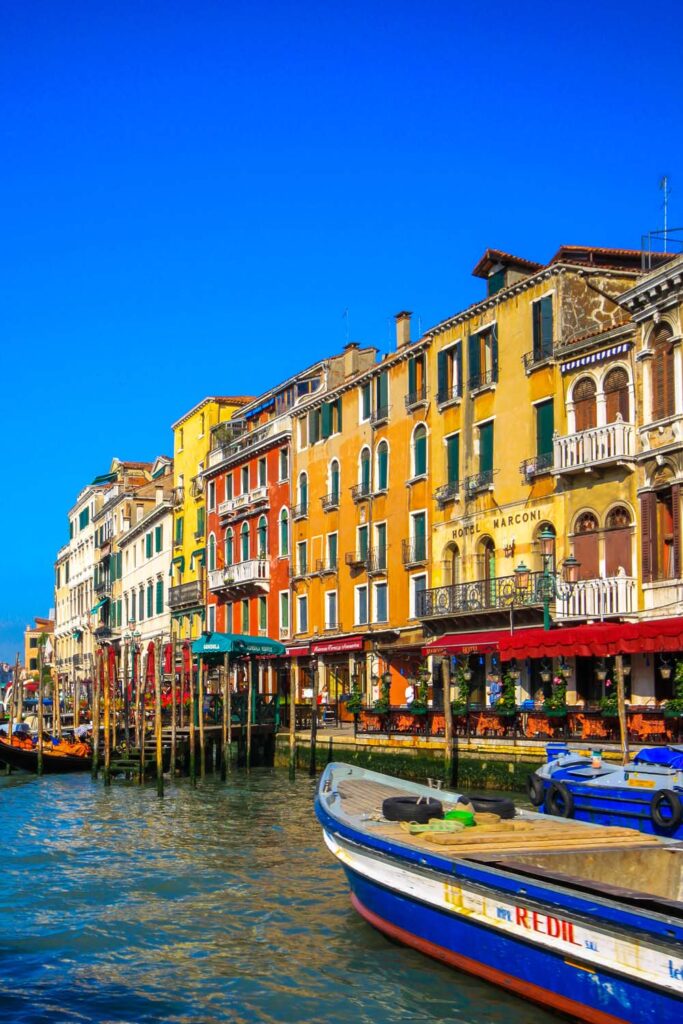
History of the Grand Canal
It wasn’t until the 9th century, when the Doge moved his palace into the more protected area of what would become St Mark’s square, that the canal was widened. A broader canal was needed to make room for the enormous ships which were brought in and used to bring building materials for the grand palace. The canal soon became less of a fishing spot and more like a luxurious main street, but one made of water. Wealthy families began buying cheap property and building huge manors along the now Grand Canal.
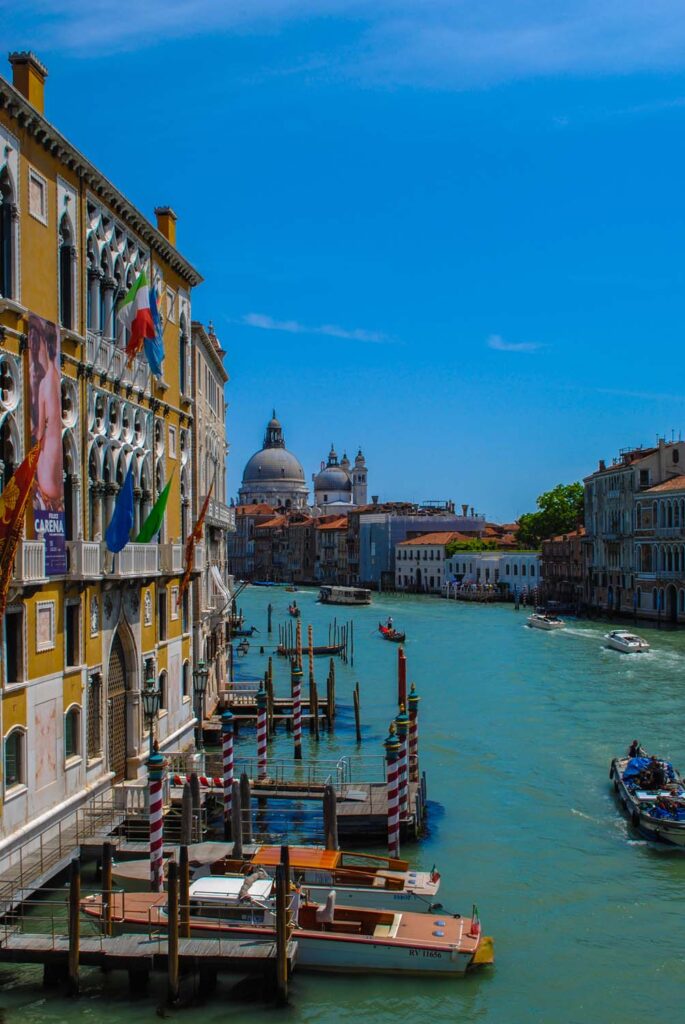
The grand canal was now the main entryway into the city, and the Venetian Republic wanted every building lining it to demonstrate the city’s power, wealth and artistic sensibilities. Like a parade of the best architecture Europe had to offer. This huge canal is now flanked by 170 illustrious buildings. Some dating back to as early as the 13th century.
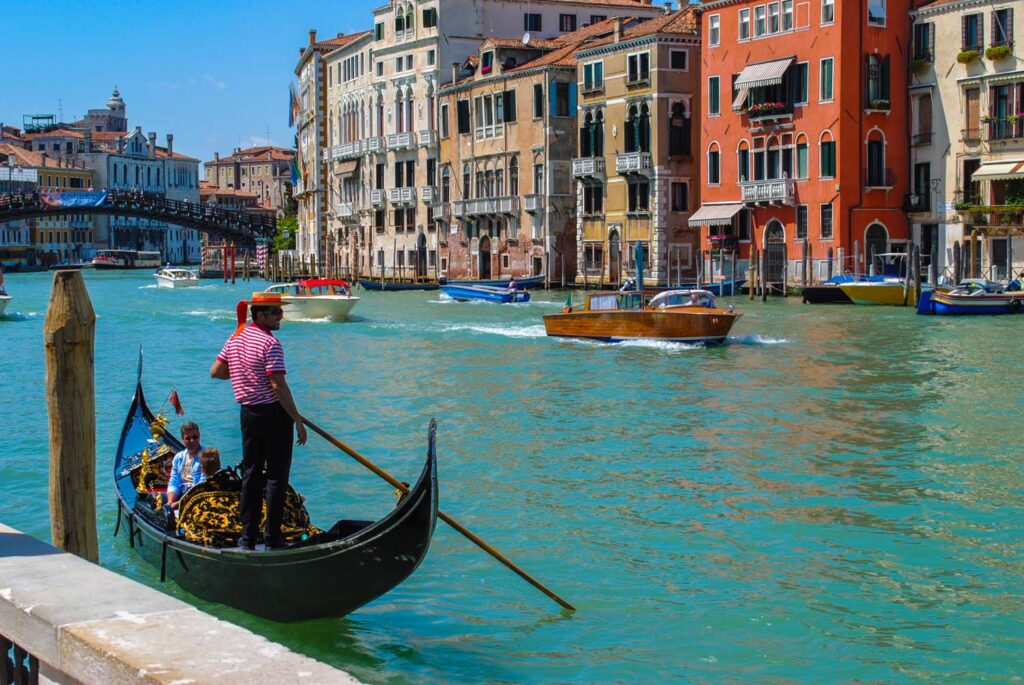
Palazzo Bembo
Turn right and walk along with the Riva del Carbon until you reach a stone bridge. Stop just before the bridge to admire the red building to your right. This is the Palazzo Bembo . This unbelievable building was owned by the Bembo family and was built in the 15th century! Obviously, there has been many renovations and restorations over time, but the original structure shockingly remains much unchanged.
The design of the building encompasses much of what traditional Venetian architecture looked like in the 15th century. The Byzantine influence was still going strong! And you can spot various of their traditional elements fused together here in the polyforms which cover the facade. A polyform is a multi-light window used on the upper floors to bring light into the structure by using wider openings.
View this post on Instagram A post shared by Manuela (@manubi6)
Pietro Bembo was born in Venice in 1470 and built the Palazzo Bembo as his lavish residence. Pietro Bembo was one of the most influential Venetian scholars and writers who helped develop the Tuscan language. He also spent much of his life creating and promoting a madrigal , a secular form of music developed during the Renaissance. He believed that music should be for more than just religious devotion. That music could be used to express everyday human emotion. That seems obvious to us now, but at the time, music was mainly composed for the church. And the subject matter was exclusively religious. We have Pietro Bembo to thank, in a small part, for why we have pop and rock music today!
Rialto Bridge
Continue along with the Riva del Carbon as it turns into the Riva del Ferro , walking along the edge of the Grand Canal. Emerging from the last arcade, you’ll be greeted almost immediately by the sight of the bright white stones of the Rialto bridge . The Rialto Bridge is the most famous of Venice’s canal bridges. It is also the oldest of the four major bridges connecting the various districts and neighbourhoods. The original bridge built here in 1173 was first made of wood. It went by the name Ponte Della Moneta , which means “ money bridge .” The name reflected the industry of the area. This was where the largest mint in Venice once stood. People would flood into their area and cross the bridge at all hours of the day to deposit and take out their cash!
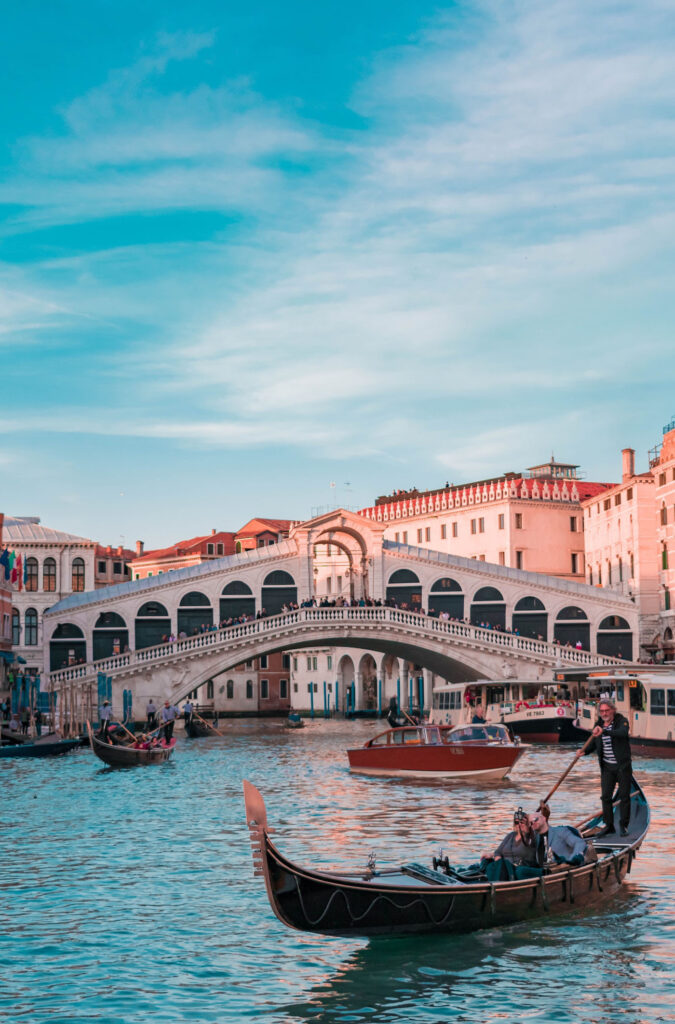
The old wooden bridge was split down the center and could be raised on either side to allow tall ships to enter these narrow canals. This was of the utmost importance, especially when the Rialto Market opened, as boats would come in mass to deliver fresh fruits, vegetables and fish to the centre of Venice. But as time passed, the old wooden bridge wasn’t up to snuff. After years and years of wear, riots, fires and crowds, eventually, it collapsed.
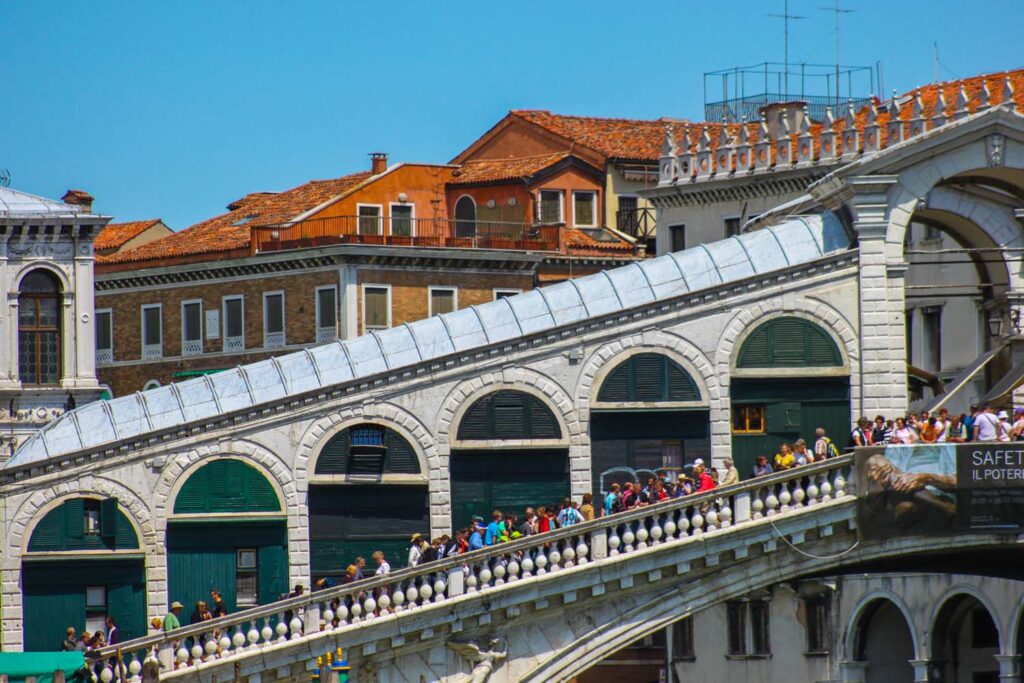
New Rialto Bridge
The new Rialto bridge design was completed in 1551. The architect who designed it did away with the raised wooden design and favoured stone as it was more durable and could last the test of time. Since the stone bridge couldn’t be raised, he needed to ensure that it was tall enough at its peak to accommodate the galley ships that needed to pass through. The result was this grand arched design that has such a theatrical quality to it.
Atop the stone bridge are a series of covered porticos which contain shops on either side. The addition of shops allowed the bridge to earn rent on the space. The money from this goes towards the maintenance of the bridge. A large arch, like the crown, is set in the center of the porticos atop this stunning structure.
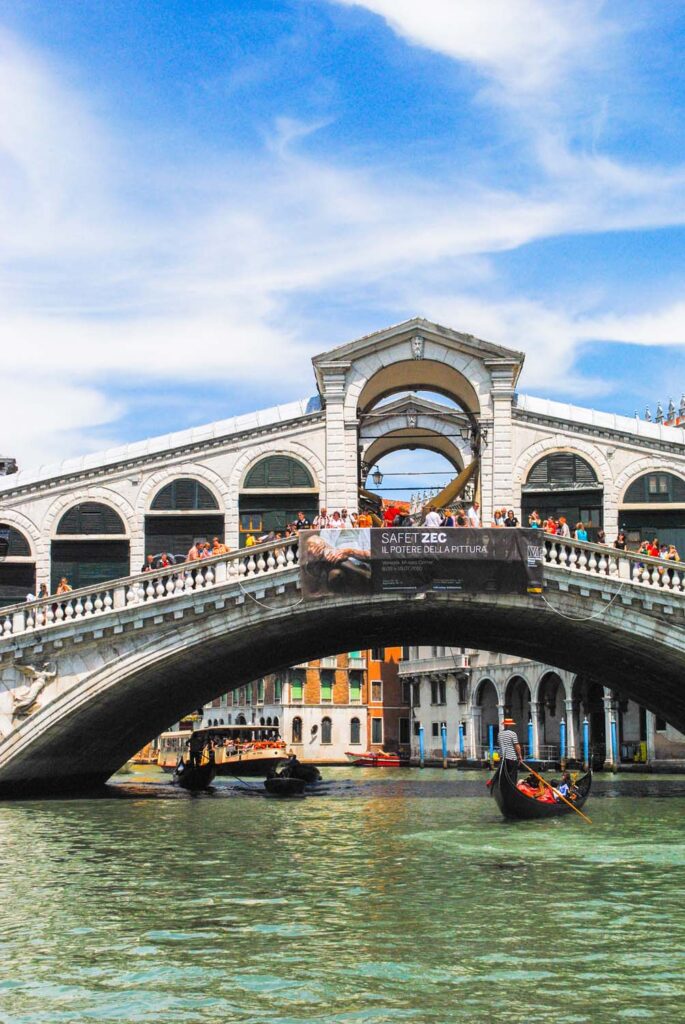
Avoiding the Tourist Traps
Unfortunately, the shops along the bridge are somewhat of a tourist trap, selling tacky souvenirs along the entire walkway. But, if you look at it from afar, you can ignore the tourist tat and focus only on the gorgeous silhouette it forms about the teal waters of the canal.
If you’re looking for a spot to sit to enjoy the view, there are these two little nooks on the bottom of the bridge where you can sit beside the water. This is one of the most amazing places to watch boats and gondolas float by, with stacks of fruits and vegetables coming into the market as the midday sun casts its bright rays down on the city. Once you’ve taken in all, there is to see below, walk up the bridge and make sure to stop in the centre to get that iconic view across Venice and the Grand Canal.
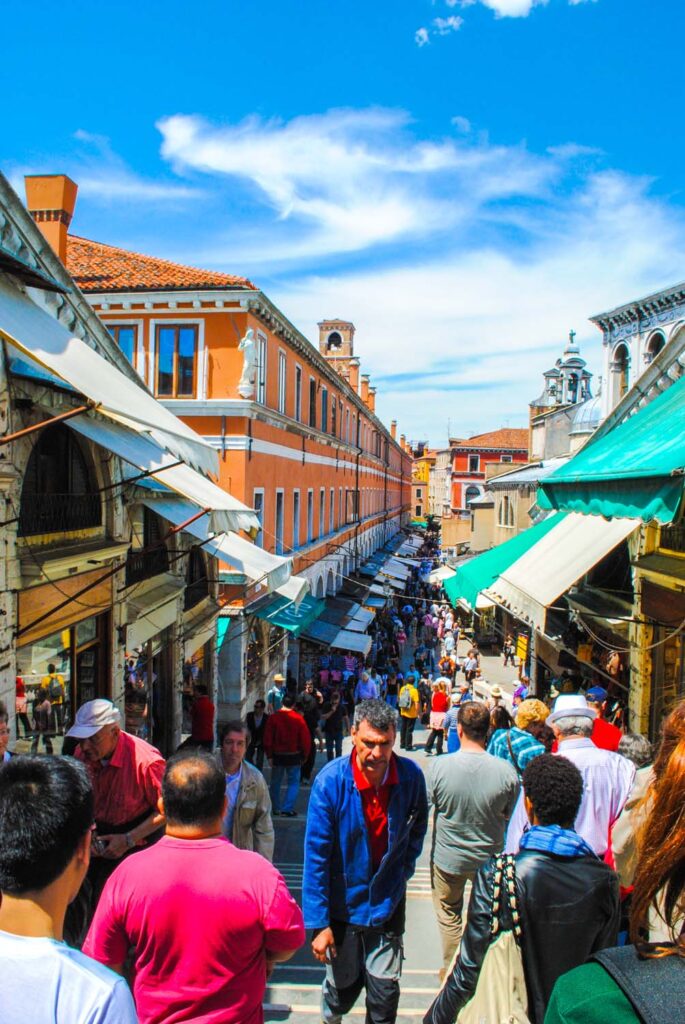
Chiesa di San Giacomo di Rialto
Crossing the bridge and heading to the island on the other side, you’ll walk through the Campo de San Giacomo di Rialto . This unassuming square is dominated by a rather small, strange-looking church. This is the Chiesa di San Giacomo di Rialto , supposedly the oldest church in Venice, consecrated in 421! The most unique aspect of this church is the huge clock set into its 15th-century facade.
This area of Venice, known as San Silvestro , was where all the wealthy bankers of the city lived. The bankers who lived here funded the church’s renovation, and while construction went on, they added a large clock and bell tower to its design. Being able to tell the time was of the utmost importance for traders and bankers. While clockfaces aren’t that uncommon on buildings around Venice, this one is absurdly large. Those bankers really wanted the most bang for their buck! It’s also interesting to note that the hours aren’t positioned as they are on modern-day clocks. Whereas most clocks now only have 12 number positions, this one displays all 24. Ironically enough, this clock is a notoriously bad timekeeper. So don’t be fooled if you think you’ve lost an hour of your life somewhere in the streets of Venice.
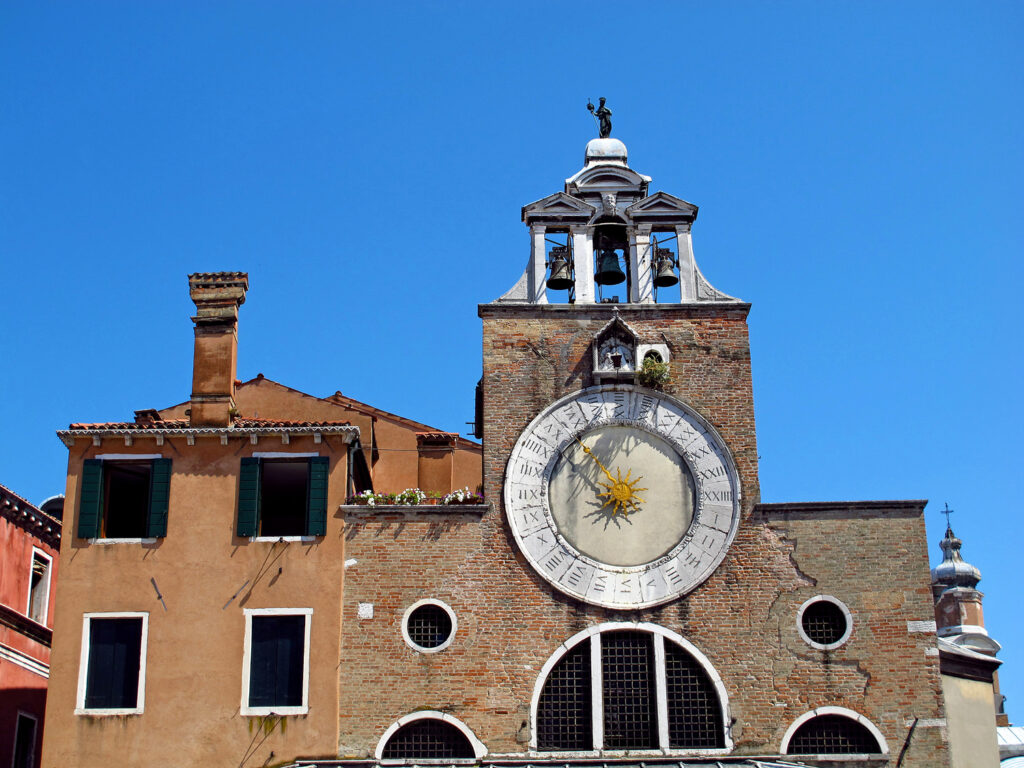
Venetian Street Names
As we make our way toward the Mercado di Rialto, we walk along the Ruga Degli Oresi. Like many streets in Venice, the Ruga Degli Oresi gets its name from the professions or trades which once were active in the area. Orsi means goldsmith , as there was once a large faction of gold and jewellery traders working here. Many other notable streets in Venice have the same kind of naming convention. There is the Calle de la Malvasia, where you’d find the winemakers.
The Campiello del Remer for the rowboats, the Calle de Forni, which was where you’d find the bakers, the Botteri for the coppers, Calle de Magazine for the grocery shops and even the C alle de Fiubera for the buckle makers! This would have made finding what you were looking to buy so simple! No need for yellow pages or even google! Find the street with the corresponding name, and you’re in the right spot.
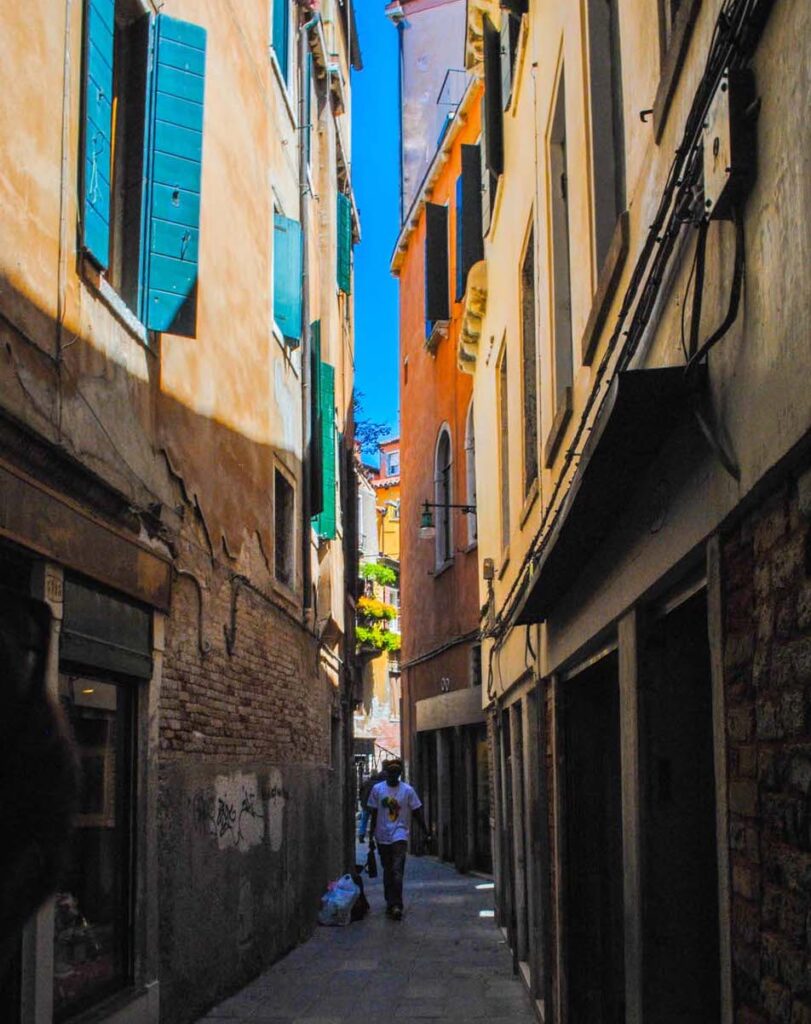
Mercado di Rialto
Now that you’ve been introduced to the city’s history, it’s time to meet the people of Venice. And there is no better place to get a peek into the real lives of its residents than to head to the Rialto Market ! The Rialto Market is one of the last remaining fresh food markets in the city and, as such, is a bustling place for locals to come and buy their food. Unlike in North America, where we shop for a week’s worth of food at a large chain grocery store, Italians buy only what they need for that day. And repeat the process every day of the week. While this might sound exhausting, it means fresh food every day and the chance to make lasting relationships with the vendors you buy your food from. Something I dearly long for and admire greatly when visiting cities like Venice.
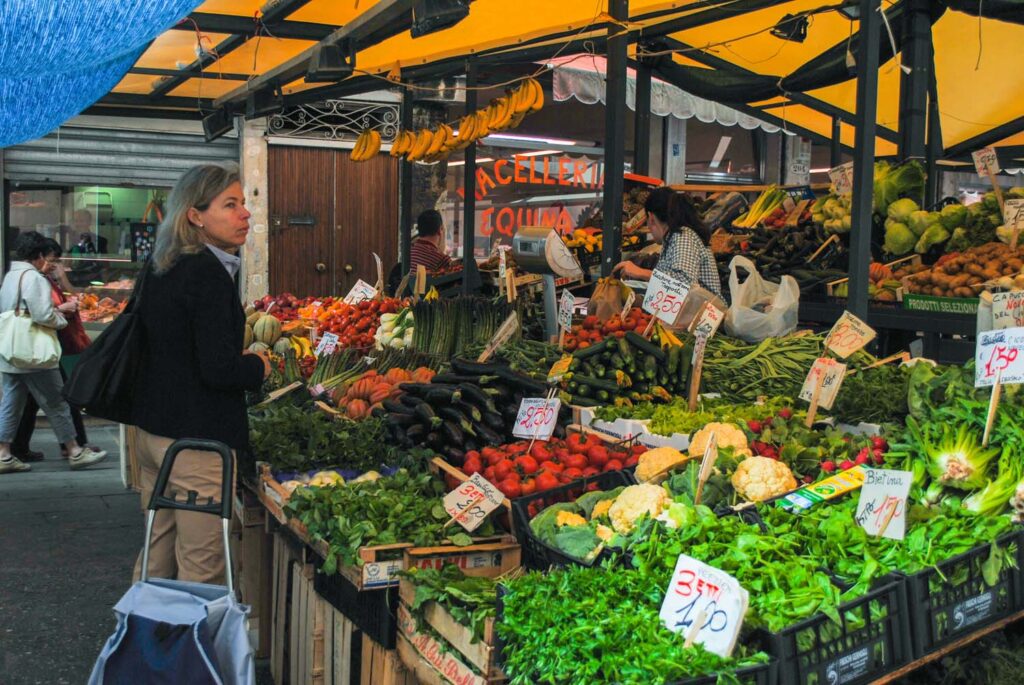
History of the Rialto Market
But the Rialto Market is much more than just a place to get some of the best food in the city! It is also a place of great historical value. Of all the rich bankers and traders who lived in the region, the most famous were the Rivoalto family. The Rivoalto traders were one of the first families to come into the lagoon to set up a trading post. They picked this location because it was well situated along the bend of the canal. This meant it was located on higher ground and therefore was spared from some floodings that other parts of the island suffered through.
The first known market opened here in 1097. Because the family didn’t have to constantly rebuild their homes, they were in a much better financial position than many other families in the area. There wasn’t home insurance to help you back then. The Rivoaltos grew in prominence and wealth and soon controlled so much of the neighbourhood that the area was named after them.
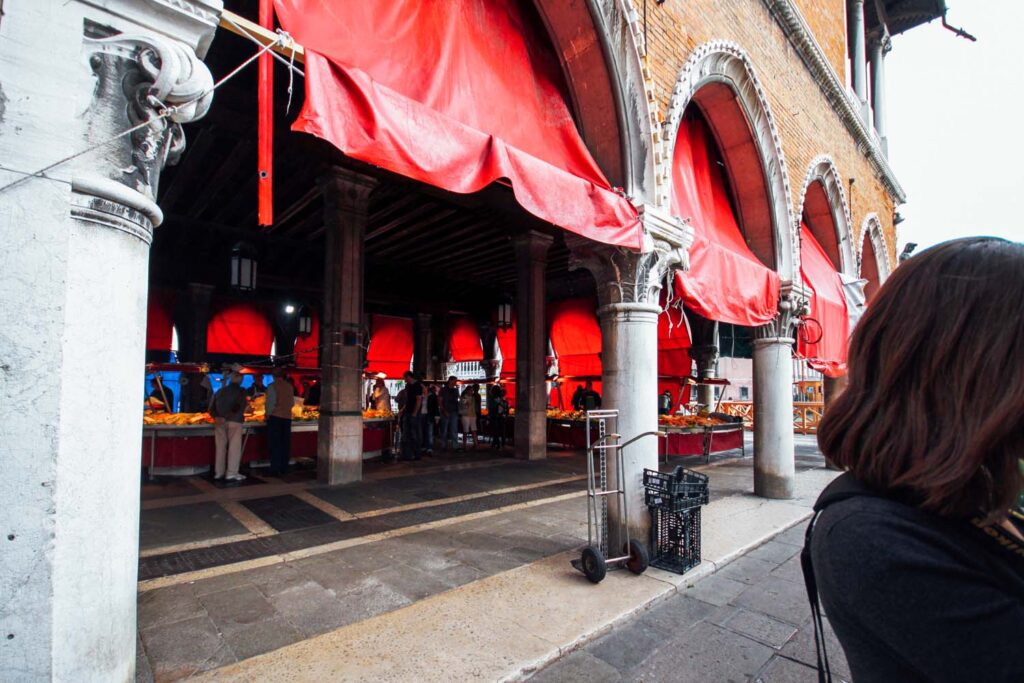
Layout of the Market
The outdoor portion of the market is where you’ll find seasonal fruits and vegetables under brightly coloured awnings. If you’re looking for a snack, there is nothing more refreshing than a basket of fresh fruit!
Opposite the green awning of the outdoor market is the neo-gothic fish hall, or Pescheria, built in the early 1900s. Outside the red brick building, there is still a marble plaque which you should study before heading inside. This plaque denotes the different types of fish allowed to be legally sold here when the marketplace was first built. Certain varieties of fish were being overcaught, and laws were set in place to ensure there was a limit on how many a household could buy to prevent their depopulation.
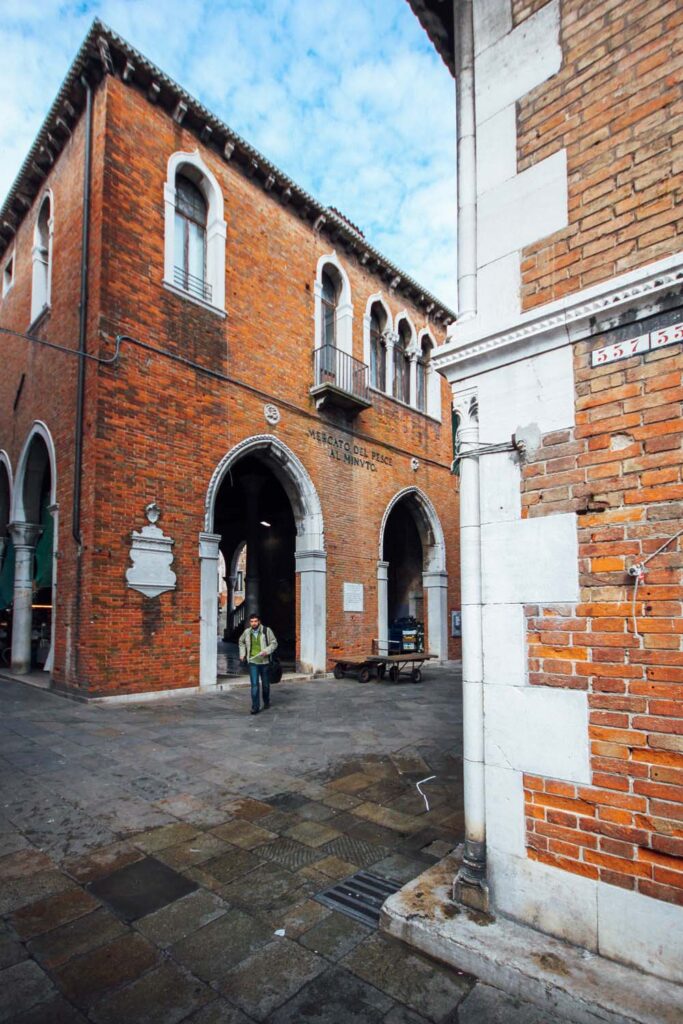
The Fish Hall
The fish hall is a rustic building with dramatic arches surrounding the exterior. Towering columns continue throughout the interior, making a simple stone building feel rich and illustrious. Fresh fish has long been one of the most important resources in Venice. All they have to do is throw out their rod, and the freshest fish comes jumping out of the sea and pouring into the market. It can’t get much more local than that!
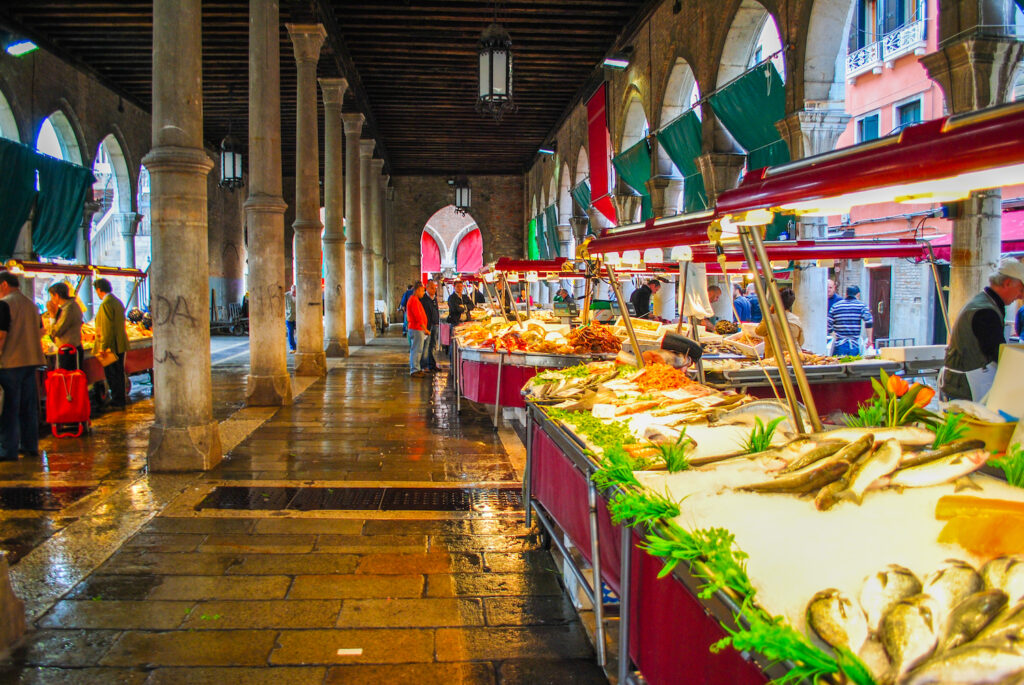
The marketplace was facing the chance of being shut down a few years ago due to a possible canal expansion for cruise ships. Thankfully, the citizens convinced the city to put a stop to this, and the market was saved. But as more and more people shop at larger grocery stores on the island, markets like this always face the chance of being closed. So if you visit, buy at least a little something to show your support. We bought some fresh raspberries and cherries, and they were absolutely delicious. The perfect on-the-go treat!
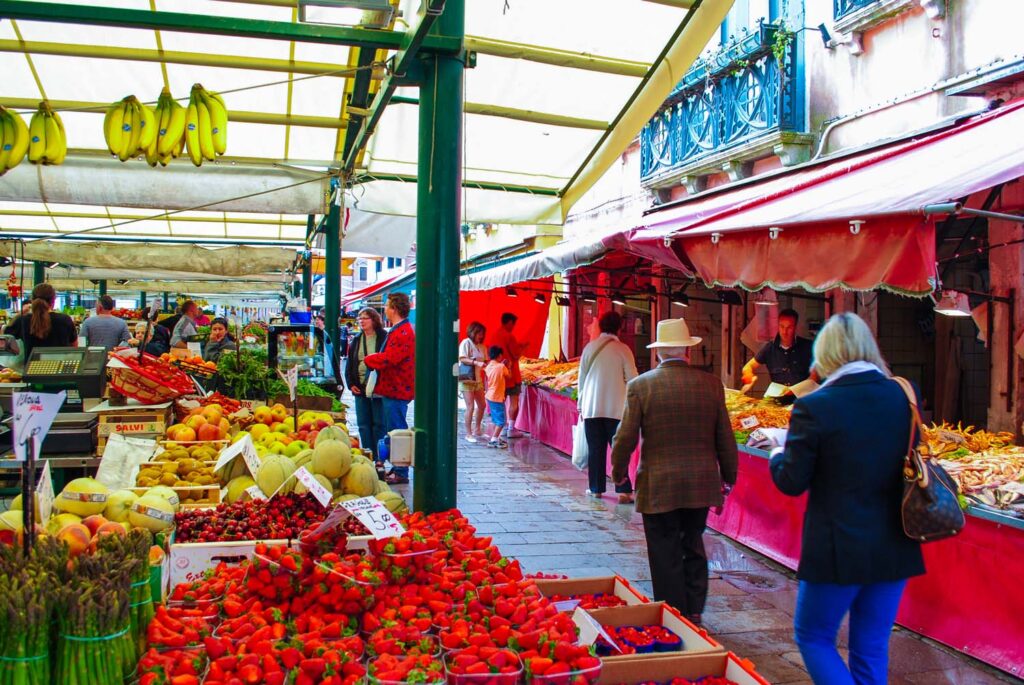
Ca’ d’Oro
Before heading to our next stop, walk to the corner of the Fondamenta de le Prigioni, across from the Campo de la Pescaria. From here, you have a perfect view across the Canal towards the Ca’ d’Oro . The Ca’ d’Oro of Palazzo Santa Sofia was an illustrious palace built along the Grand Canal for the Contarini family in 1428. The Contarini family was responsible for rearing eight different Doges and was one of the wealthiest families in Venice.
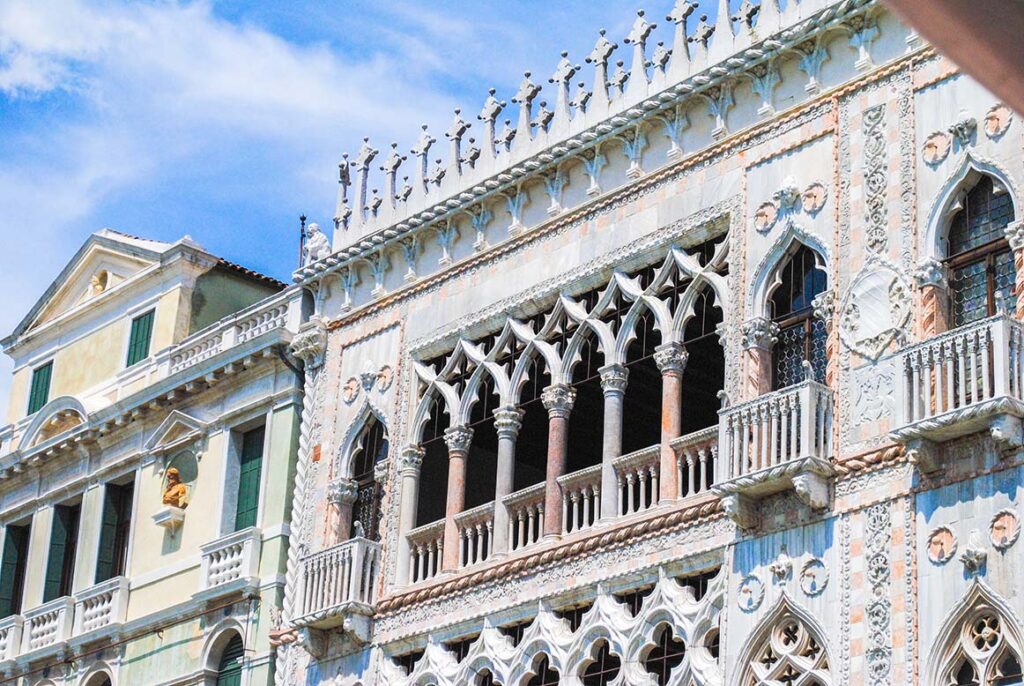
To show off their wealth and power, they wanted to create a palace that mirrored the greatness of the Doge’s Palace in St. Mark’s square. Ca’ d’Oro means the golden house . When the building was first constructed, the entire facade was covered in gilt polychrome, giving the effect of being made entirely of gold!
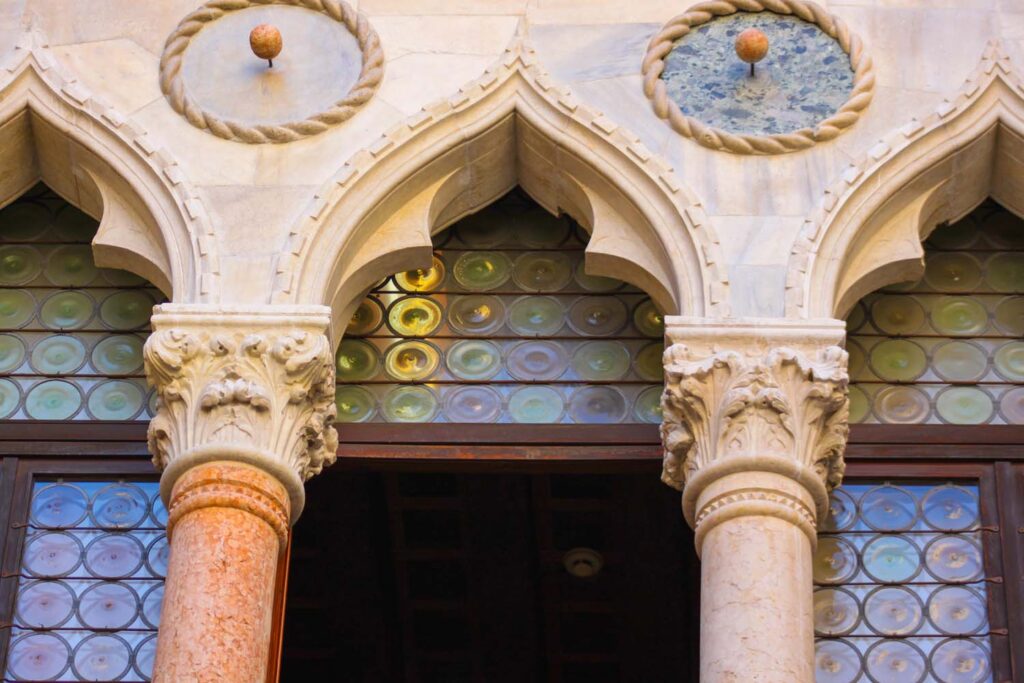
Venetian Gothic
The palace’s architecture is one of the best-surviving examples of Venetian Gothic architecture . The iconic elements characteristic of this style are gallery windows with heavy tracery details featuring quatrefoil designs and byzantine-inspired decorations. Ogee arches span the balcony’s facade, each capped with a wonderfully carved relief ornament.
Inside, the lavish details continue. Even the flooring was made into a work of art. Different coloured stones were used to create fanciful patterns. Since 1927, the building has served as the Galleria Giorgio Franchetti , which features a wonderful collection of 15th-century art.
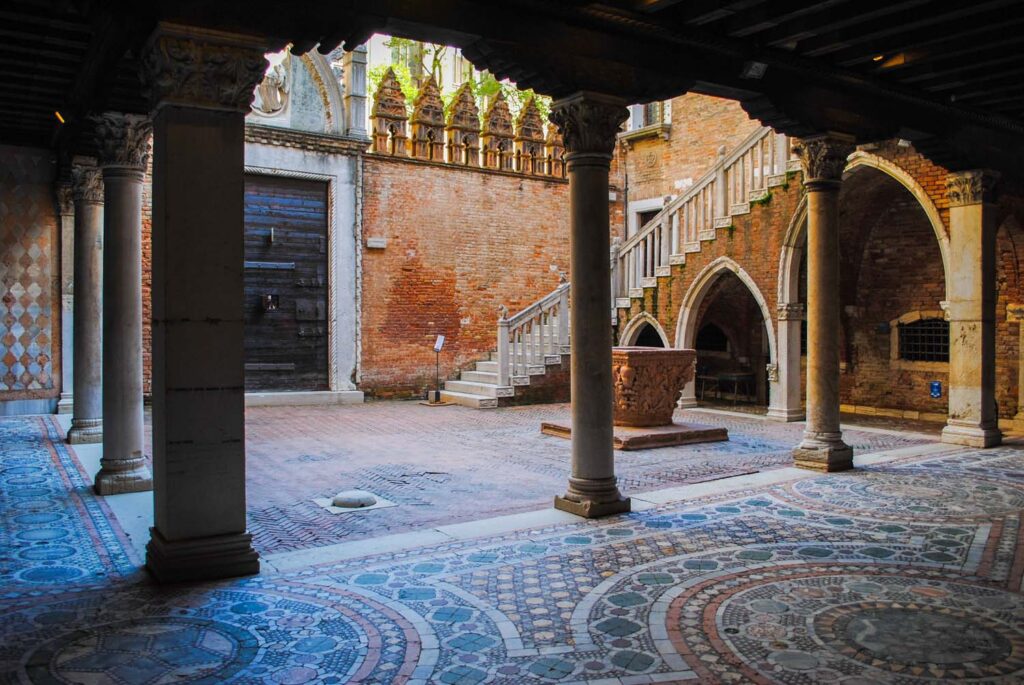
Riding a Traghetto
Instead of backtracking over the Rialto bridge to get to Cannaregio island (our next stop), we’re going to opt for a very Venetian method of crossing the canal, a Traghetto ! You can find the Traghetto ferry dock along the Fondamenta de le Prigioni , across from the Campo de la Pescaria . Walk over to the water’s edge, where you’ll see a small dock and what appears to be a series of black gondolas. “ But gondolas are so expensive! ” you say. And rightly so, they are. But these are not gondolas; they are traghetti . A traghetto (or traghetti if you’re referring to them as plural) means ferry in Italian. These little ferry boats take passengers across the Grand Canal when there are no nearby bridges.
This is essentially how many Venetians would have made these crossings long ago. A trip on a traghetto costs €2, which might seem a bit pricey for a quick journey, but they save you a ton of time. Plus, it gives you a short but sweet experience on a gondola-type boat. Sure, you might have to share it with a group but it’s the same design, just less romantic. The trip across the water provides a beautiful view of the Ca’ d’Oro from afar, so you can better study all of it in all its glory before getting up close and personal. The Traghetto will let you off at the Santa Sofia in the neighbourhood of Cannaregio.
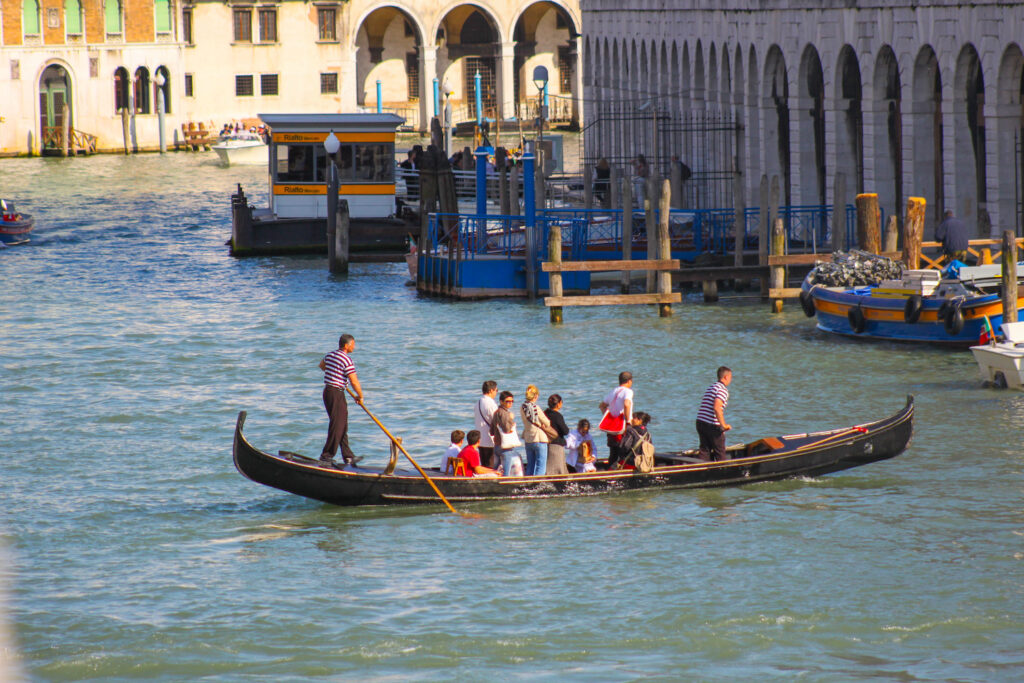
This area of the island is called Cannaregio . Cannaregio is home to the old Jewish Quarter and is where most of Venice’s permanent residents live. This means that you’ll see things more than just tourist attractions. Places like schools, corner stores, and traditional Venetian houses aren’t sprawling palazzos. If you’re looking for somewhere to stay in Venice, Cannaregio is my favourite spot, as it feels like the community’s beating heart.
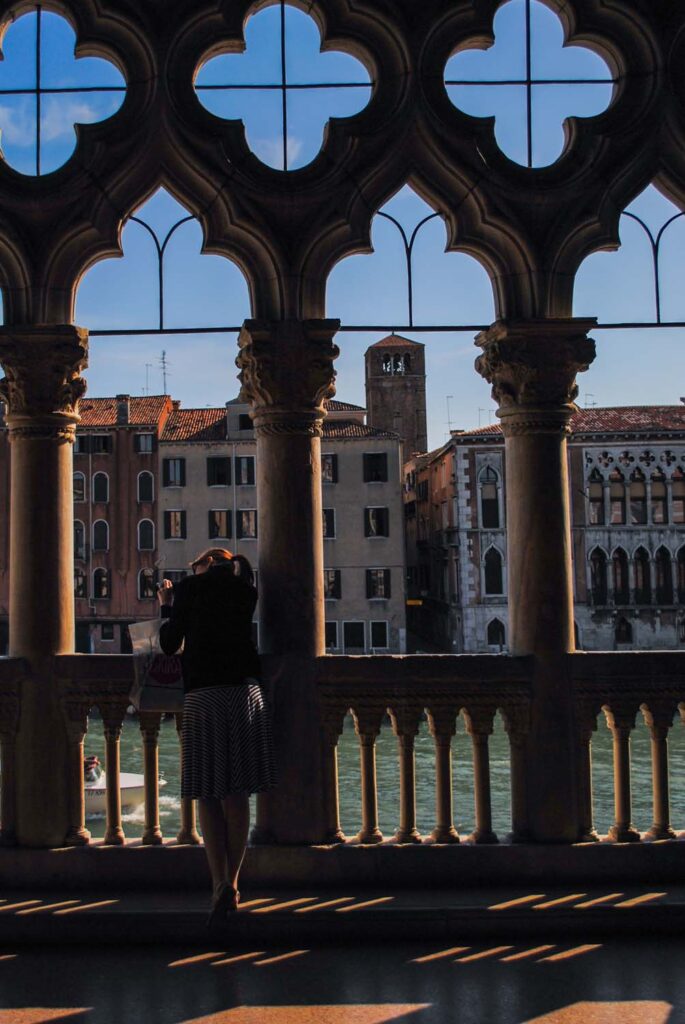
Ponte Chiodo
We are going to set off into Cannaregio via the Strada Nova. The Strada Nova a wide pedestrian street lined with shops and cafes. Turn right from the Strada Nova onto Fondamenta S. Felice. This is such a picturesque street and peaceful canal. As you look down along the canal, you can see four different bridges all along one short stretch of water. The most interesting of these bridges is towards the end of the street, called the Ponte Chiodo. The Ponte Chiodo dates back to the fifteenth century and is one of the last two bridges that doesn’t have any balustrades to prevent people from falling right into the canal! The city built another bridge just next to it with proper railings but kept the old one as a memory of the past.
View this post on Instagram A post shared by Matteo Belotti® (@_belotti.matteo_)
Scuola Grande della Misericordia
We continue west into Cannaregio across the Ponte della Misericordia to the first of two old schools we will look at. The Scuola Grande della Misericordia dominates the northern side of the sestiere Cannaregio. The Scuola Grande della Misericordia (New School of Mercy) was one of seven Scuole Grandi in Venice. These “Scuole Grandi” or “Great Schools” were religious and charitable organizations. Developed in the 13th century, they were the most important social institutions in the Serenissima Republic of Venice. The secular institutions played a crucial role in the fabric of political and religious life. The Old School of Mercy was built in 1308 in the typical gothic style (we will see this building at the next stop.)
But as the organization grew in size, a new building was commissioned to house the growing organization. Jacopo Sansovino was brought on to build the “Scuola Nuova,” or New School. Built in 1532, the imposing quadrangular structure was strongly influenced by Roman classicism. Building work continued over the next fifty years; unfortunately, Sansovino died before the building was completed. Today the building is used as a gallery and events space, but the exterior architecture has been preserved for us to admire.
View this post on Instagram A post shared by Caprioglio_Architects (@caprioglio_architects)
Scuola Vecchia della Misericordia
Head northeast on Sestiere Cannaregio toward Campo de l’Abazia . In this small square, you can see the old Chiesa dell’Abbazia della Misericordia in one corner and the original Scuola Vecchia della Misericordia in the other. The Scuola Vecchia della Misericordia (“Old School of Mercy”) was the first seat of the organization. When they built the new school, this building was sold off to the guild of the silk weavers in 1634.
View this post on Instagram A post shared by Leonardo Zonta // 1996 (@_zontaleonardo_)
Casa del Tintoretto
Continue west along Fondamenta de l’Abazia, across the wooden Ponte dei Muti, then along Corte dei Muti and turn left toward Fondamenta dei Mori. Along this canal-side street is the old Casa del Tintoretto . This crumbling old house bears a small plaque with the bust of a man on the top. This is the Casa del Tintoretto, where the artist Tintoretto lived from 1574 to 1594. Tintoretto is one of the few artists who lived and worked in Venice but who was also born here . Many artists flocked to Venice during the Renaissance as the art scene exploded, but Tintoretto was the original trendsetter. His great work helped form the Venetian school of art and even perhaps the artist style which defined the Renaissance itself.
View this post on Instagram A post shared by Hotel Roberta (@hotel_roberta_mestre)
Campo dei Mori
Continuing west, you are greeted by the small, peaceful square Campo dei Mori . As you turn into the square, take note of the strange statue on the corner of the Osteria l’Orto dei Mori . This statue looks almost as if it has a beak. Three carvings were made in the 13th century, one in each corner. They represent the three merchant brothers who famously opposed the Republic of Venice. Back then, it was treason to speak up against your government. In reaction to their controversial attitude, these unflattering carvings were made to mark their treason in stone forever. Years later, their bravery in speaking out against injustice is honoured, and the statues are revered. Venetians today are known to hang satirical comments on these statues. Addressing and airing their problems with local politicians.
View this post on Instagram A post shared by Best Venice Guides (@bestveniceguides)
Church of Madonna dell’ Orto
Continue north, along the Campo Dei Mori , and head across the bridge. Here you’ll come face to face with the grand Church of Madonna dell Orto. Considering this church’s history and beauty, you’d think it would be overrun with tourists. But, since it’s located so far away from the city centre, often you’ll find this square empty and all to yourself!
The church was first constructed in the mid-14th century for the Humailiati order. Never heard of them? Not surprising since they were ousted from Italy in 1462. Despite their name Humiliati , meaning “ humble ,” the pope famously referred to them as humiliating . He believed them to take part in sacrilegious behaviours, which included gluttony and lust. One of their members even tried to assassinate archbishop Carlo Borromeo, whose task was to reform their order. While the order was definitely not the most pious, they were certainly great art lovers, which can be seen in the design and decoration of this great church.
View this post on Instagram A post shared by Jozef Vlk (@wolfverine333)
Church Facade
This church’s facade is one of my favourite pieces of architecture. There are so many tiny details packed into this small space. The current facade dates back to 1460. The sloped sides of the church are lined with a series of twelve niches, where dozens of statues are placed depicting the twelve Apostles. The niches are each framed in bright white columns creating this very visually powerful ribbon effect along the roofline. On either side of the entrance door are two huge quadruple-mullioned windows that allow light to flow into the church’s interior.
View this post on Instagram A post shared by Marisol Michielin (@marisolmichielin)
Atop the ornate ogee archway leading into the church is the statue of St. Christopher, the patron saint of travellers. This was the saint the church was initially dedicated to. However, it changed consecration to the Holy Virgin later in the century. On either side of St. Christoper are statues of the Madonna and the Archangel Gabriel. Above St. Christoper, the pointed roof is decorated in small arches and bas-reliefs with geometrical motifs. The large Eastern-style onion-domed bell tower is surrounded by four statues of the Evangelists. And at the very top is a statue of the Redeemer made in white marble.
Church Interior
Enter the church if it’s open, as this church contains some fantastic works of art. As this is the district where Tintoretto lived, this church contains three different pieces from the great artist. Works by Tintoretto in the church include a Presentation in the Temple ( South aisle, close to the East end), Adoration of the Golden Calf, Last Judgement (both in the apse, either side of the main altar) and the Four Cardinal Virtues (in the upper storey of the apse, behind the altar), all from 1562 to 1564. Walk into the apse and find your way to the right Chapel. On the floor is a simple engraved tomb where master Tintoretto is now laid to rest. Happily surrounded by his amazing works of art.
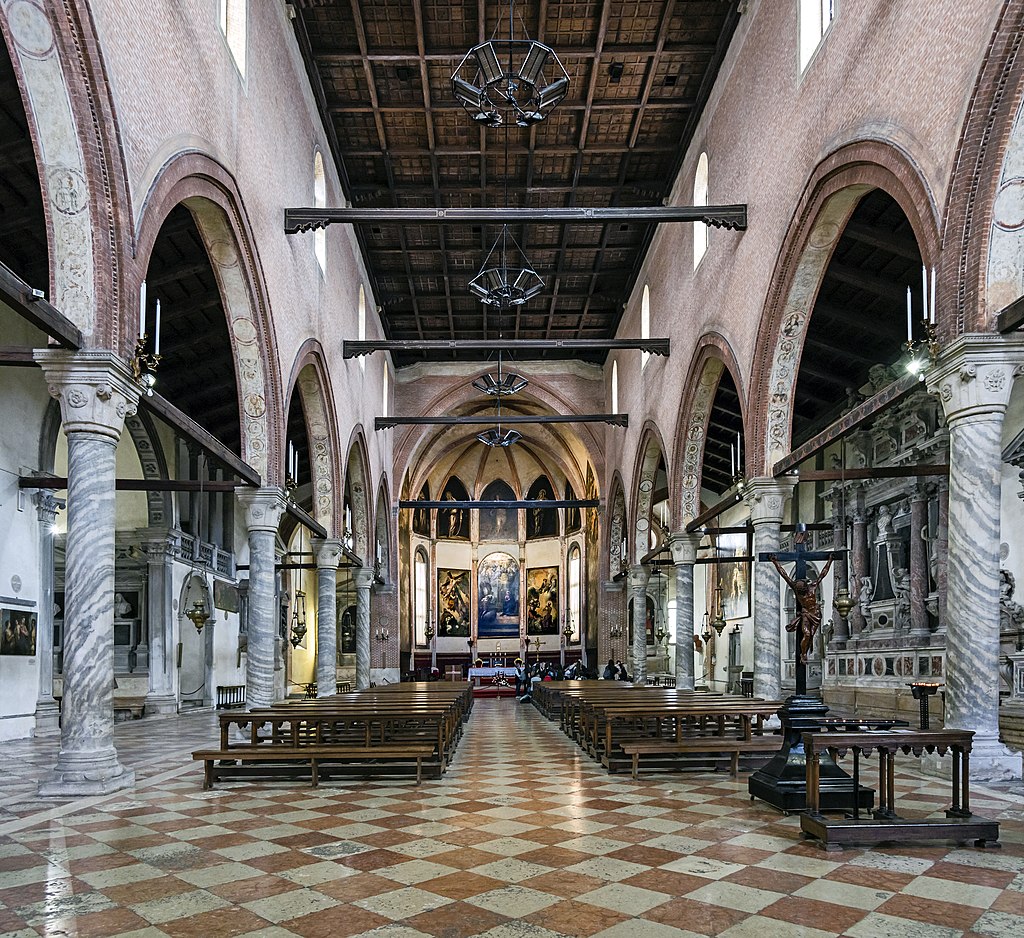
Jewish Quarter
From the Campo della Madonna dell’Orto head southwest along the Fondamenta Madona de l’Orto. Turn left onto Calle Loredan, where you’ll pass over a few little wooden bridges. When you arrive at Ponte del Forno, cross over onto the Calle del Forno. Turn right onto Fondamenta dei Ormesini and walk for a few minutes admiring the many different cafes and restaurants along this street beside the canal. When you spot the gorgeous iron bridge covered in swirling filagree, turn left onto Cl. Ghetto Vecchio into the heart of the Jewish Quarter. Hearing the words Jewish Ghetto , you might think we are entering an area built during WWII, but this ghetto had nothing to do with the Nazis. This neighbourhood actually area predates WWII by more than 400 years!
History of the Jewish Quarter in Venice
In 1509, a large portion of the Jewish community from Germany fled the mainland and moved to Venice. Venice had agreed to allow these Jewish refugees to live inside a small neighbourhood on the island of Cannaregio. But in that area alone. The area they were segregated inside was no bigger than an acre and contained hundreds of Jewish refugees. The old district had once been the location of the old copper foundries. The word ghetto was actually coined in Venice. In Italian, the word ghetto or ‘ get’ translates to ‘ foundry’ or ‘ foundries .’ But over time, the word became synonymous with an area where members of a minority group live, as was in the case of the original Jewish ghetto in Venice.
View this post on Instagram A post shared by @jewishvenice
Although Venice had given them a place to live, that didn’t mean their life was free and easy. Jewish Venetians were forced to make their living only by selling rags and running pawnshops. This was the only type of employment they were allowed to have at the time. The only exception was Jewish doctors and those with skills in the printing press industries. They worked on printing Hebrew texts and keeping their religion and culture alive in the Ghetto Ebraico or Jewish Ghetto .
Merchant of Venice
In the 16th century, Jewish citizens from Spain fleeing the Spanish inquisition also arrived in the ghetto. These Jewish Spaniards developed the narrative of the “ merchants of Venice .” They were skilled and sought-after traders and merchants. Soon, the Jewish quarter was the centre of foreign trade in Venice. This new industry brought in a substantial amount of money to the Serenissima, allowing them to stay in business despite previous restrictions on this kind of work in the quarter.
Although Venice allowed Jewish people to live and worship in this area, their lives were highly regulated and segregated. As early as the 16th century, Jewish citizens had to wear either yellow hats or yellow badges to distinguish them from Venetian Christians. The ghetto also had a strict curfew which the residents had to follow. Boats filled with members of the Serenissima would circle the canals at night to ensure no one broke curfew. The punishment for doing so was severe. To many residents, this area must have felt more like a prison than an escape from the persecution they had been trying to flee.
View this post on Instagram A post shared by Paola Scaccabarozzi (@paolascaccabarozzi_travel)
The First Vertical City
Despite these restrictions, the Jewish quarter’s population grew and flourished. More synagogues began to be constructed. But residential development was difficult. Since they were limited to this small island, their only chance for expansion was to go up vertically. The Jewish quarter in Venice was known to be the first real “vertical city.” Even today, walking around this part of Cannaerigio, you’ll see how much taller these buildings are compared to the rest of the city.
In 1797, Napoleon’s entry into Venice freed the Jewish people from their ghetto. Napoleon abolished these divisions. Jewish Venetians were finally free to buy property throughout the rest of the city. Since they were now some of the wealthiest citizens, they were able to buy up some of the most beautiful palazzos on the Grand Canal. Over the years, these Jewish citizens became as much a part of Venice as any other native Italian. Perhaps because they were such an important part of the fabric of Venetian society, their betrayal at the hands of Italian fascists later in WWII was so devastating. And almost led to their extinction.
View this post on Instagram A post shared by Guido (@guysebas)
World War II in Venice
Jewish people throughout Europe were rounded up and sent to concentration camps during WWII. But, thanks to the sacrifice of Giuseppe Jona , head of the Jewish Community in Venice, a large portion of Jewish Venetians managed to escape. When the Nazis demanded Jona make a list of Jewish people living in Venice, he agreed but used the time to warn his community. On the day he was told to deliver the list, he burnt the papers and took his own life, fearing he would be murdered for his actions. The Nazis were only able to find 243 Jewish Venetians who were deported. Only eight of them returned home.
Before WWII, Venice had a Jewish population of around 150,000. After the war, little more than 1,200 people returned to their homes. On one side of the Ghetto Nuovo square is a large bronze monument in honour of the victims of the Nazis. It was created in 1980 by artist Arbit Blata . The seven bronze panels depict several horrific tragedies Jewish people suffered during WWII. Today there are merely 450 Jewish Venetians left in Cannaregio. But they work hard to preserve and share their history with locals and visitors alike.
View this post on Instagram A post shared by 20 Regions in 2 Years (@20regionsin2years)
Scuola Spagnola
The Scuola Spagnola , or Great Spanish Synagogue , is one of the last remaining synagogues in modern Venice. The synagogue was built in 1555, founded by Jewish Venetians who had been expelled from the Iberian peninsula. The great synagogue was built by one of Venice’s most famous architects, Baldassare Longhena . He is also notable for designing other iconic Venetian buildings, such as; the church of the Madonna Della Salute, Ca’ Pesaro and Ca’ Rezzonico .
But the exterior of the synagogue isn’t anything like these other buildings. The facade is rather austere, with a plain, four-story cream-coloured finish. But it wasn’t for lack of inspiration, funding or skill that the exterior was so lacklustre. It was a condition of the Venetian state government in the 16th century. Although Jewish citizens were allowed to build their own places of worship, they needed to be concealed within a building that gave no appearance of being a house of worship. Essentially hiding their religion from the eyes of Christian Venetians.
View this post on Instagram A post shared by Jesús Ángel Carrasco Carmona (@jezucarras)
Inscribed upon the arch on the entrance of the building is a piece of script that reads, “ Blessed are they that dwell in Thy House and continue to praise Thee .” On the side of the building, there is also a stone plaque with the names of all the deported Jewish Venetian families who suffered death at the hands of the Nazis. Take a moment to pay respect as you pass by.
How to Visit a Synagogue?
Although tourists can’t enter the synagogue on their own (unless attending a service), I recommend booking a guided tour through the Jewish Museum of Venice if you are interested. They have a great connection with the local community, and you know this way you are supporting the preservation of their history through your contributions.
If you were to peek inside, you would be amazed at what you’d find. Stepping inside is like walking into a fantastical jewel box. Ornate carved wooden balustrade frames the ceiling in a variety of geometric shapes. Lavish red velvet curtains with golden tassels hand in front of the windows. Giant brass chandeliers drip from the ceiling and illuminate the rest of the room with warm candlelight. The highlight of the interior is the magestic sanctuary lamp known by its Hebrew name, Ner Tamid . The light inside this holy lamp symbolizes God’s eternal presence, which will never be extinguished.
View this post on Instagram A post shared by Axel Lapp (@axellapp)
Panificio Giovanni Volpe
Just down the street from the old Spanish Synagogue is Panificio Giovanni Volpe , one of Venice’s last remaining kosher bakeries. While visiting the Jewish quarter, it’s a good tourist practice to patronize their businesses. This is such an easy way to ensure their community continues to flourish. In this bakery, they still make many traditional Venetian desserts and also some unique Jewish recipes. Don’t be shy to ask what they recommend! Everything is delicious though.
View this post on Instagram A post shared by Panificio Volpe Giovanni (@panificiovolpe)
Guglie Bridge
To cross onto the next island of Santa Croce , we need to pass over the great Guglie Bridge . This crossing was established in 1285 with an early wooden bridge, but the current stone incarnation was built in 1580. The large balustrades which run over either side of the bridge are inlaid with gargoyles that watch over the canal. It is therefore dubbed the “ bridge of spies .”
View this post on Instagram A post shared by HAIR STYLE and MAKE UP VENICE ITALY (@luigimarchiori)
Chiesa di San Geremia
Standing in the centre of the Campo San Geremia is the church of the same name. The Church of San Geremia has stood here since the 13th century, and the old brickwork on the bell tower is some of the only remaining pieces of the original church. The rest of the edifice dates back to 1753.
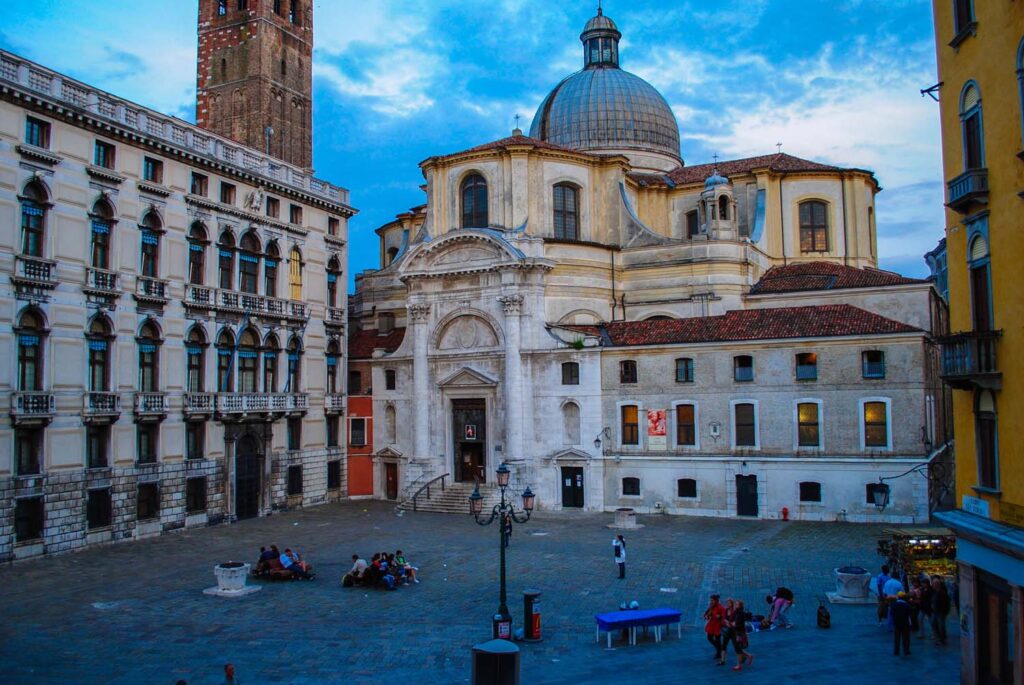
While the interior lacks any flashy ornamentation, this church is often seen as a pilgrimage sight because it carries the relics of Saint Lucy inside. Saint Lucy is the patron saint of eye illnesses. The story goes that she had devoted her virginity to God and would not marry. To make herself less desirable, she tore out her own eyes. When she was buried in the family mausoleum, they discovered her eyes had been miraculously restored, a sign of her martydom. She is seen frequently in paintings holding a golden plate with a pair of eyes laid upon it. Many people make a pilgrimage to this sight to pray for their own eye related illnesses.
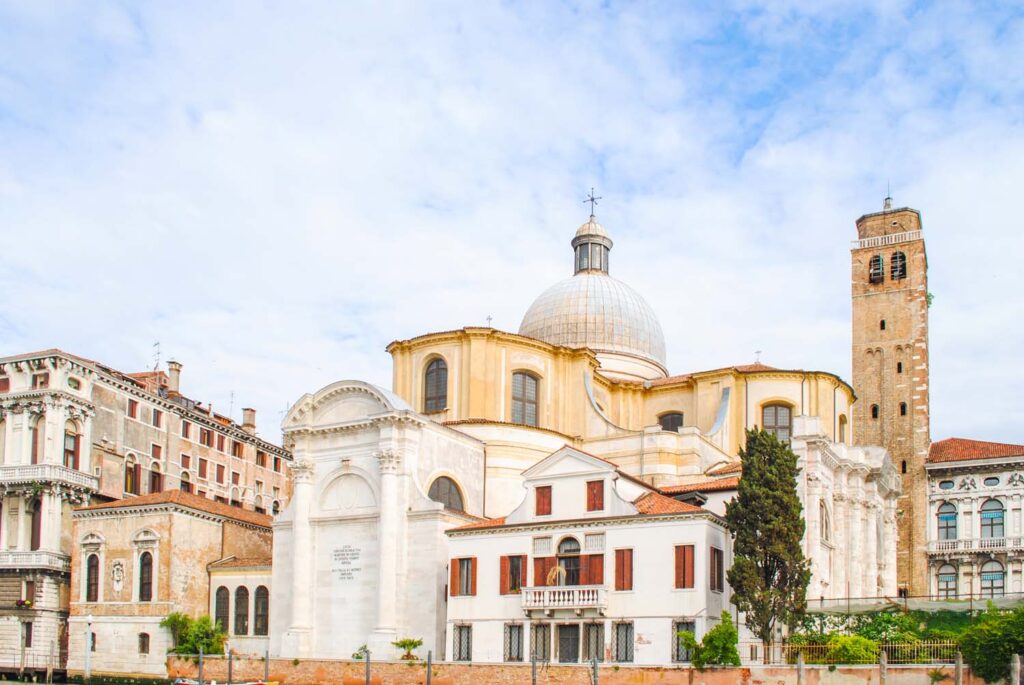
Pasticceria Dal Mas
You’ll find my favourite bakery on the charming Rio Terà Lista di Spagna street. The Pasticceria Dal Mas has some of the best cream-filled pastries in town! Their bright green pistachio cannolis are a dream. There are a few seats inside where you can sit and order an espresso or even an Aperol spritz to enjoy with your food. If you’d rather just stand at the counter and chat, you can also do that; how very Italian of you.
View this post on Instagram A post shared by Erica Eckman (@everythingerica)
Scalzi Bridge
You’ll come upon the Scalzi Bridge at the end of this street before reaching the train station. The Scalzi Bridge means “ bridge of the barefoot monks ” in Italian. The first bridge to be built here was right beside the old Carmelite order, also known as the “order of the barefoot monks.” But this current incarnation of the bridge is one of the city’s newest, completed in 1934. While the bridge isn’t as remarkable as some others, its modernity allows it to feel light and airy, almost defying the laws of gravity.
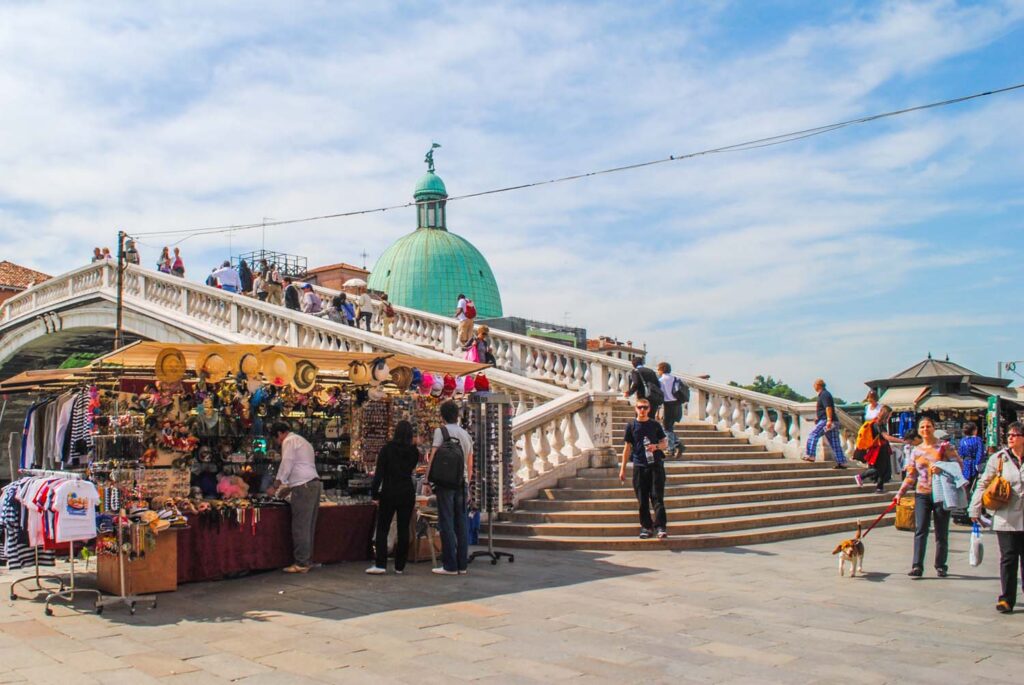
Santa Croce
Walking over the bridge, we are moving into the Santa Croce district. Santa Croce is where you’ll find the large train station, which brings people in and out of Venice every day. Leading to this neighbourhood being referred to as the city’s “transport hub.” Being located away from the top attractions, you’ll also find that Santa Croce has the least amount of tourists. This may be one of the reasons I find it the most pleasant to walk around. The people you’ll find on the street are locals, and there is an honest air about this neighbourhood.
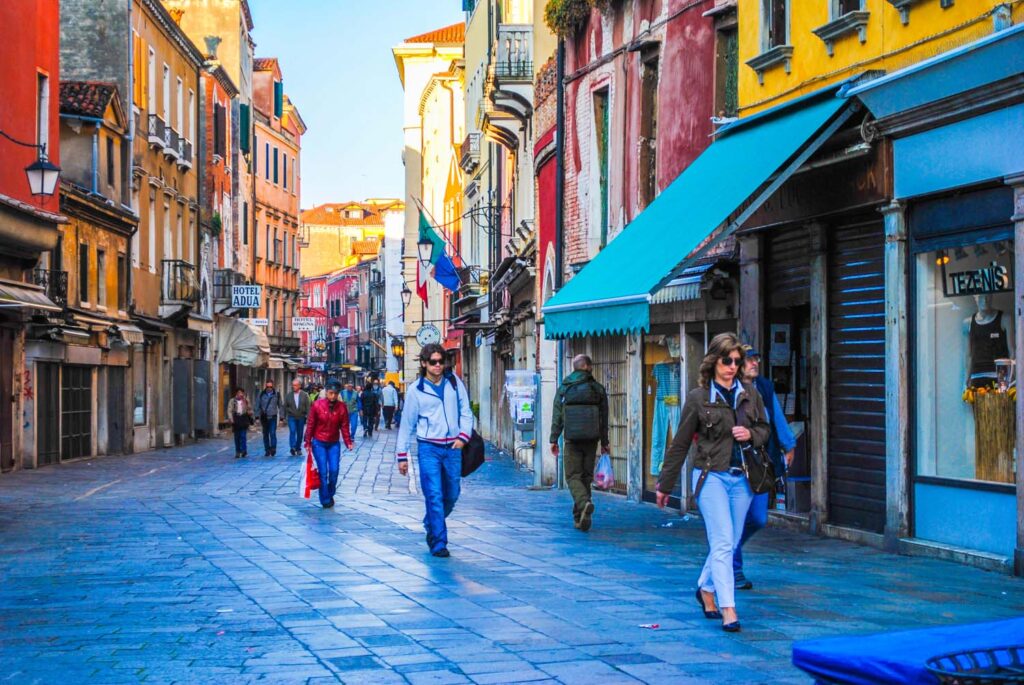
Crossing over the bridge, walk southwest on the Fondamenta del Monastero to tread along water’s edge. This area of the Grand Canal is bustling with action. You’ll find more than just gondolas and vaporettos here. Motorboats carrying fruits and vegetables chug up and down the water, and boats piled with wooden beams and other construction equipment jet over to their various destinations.
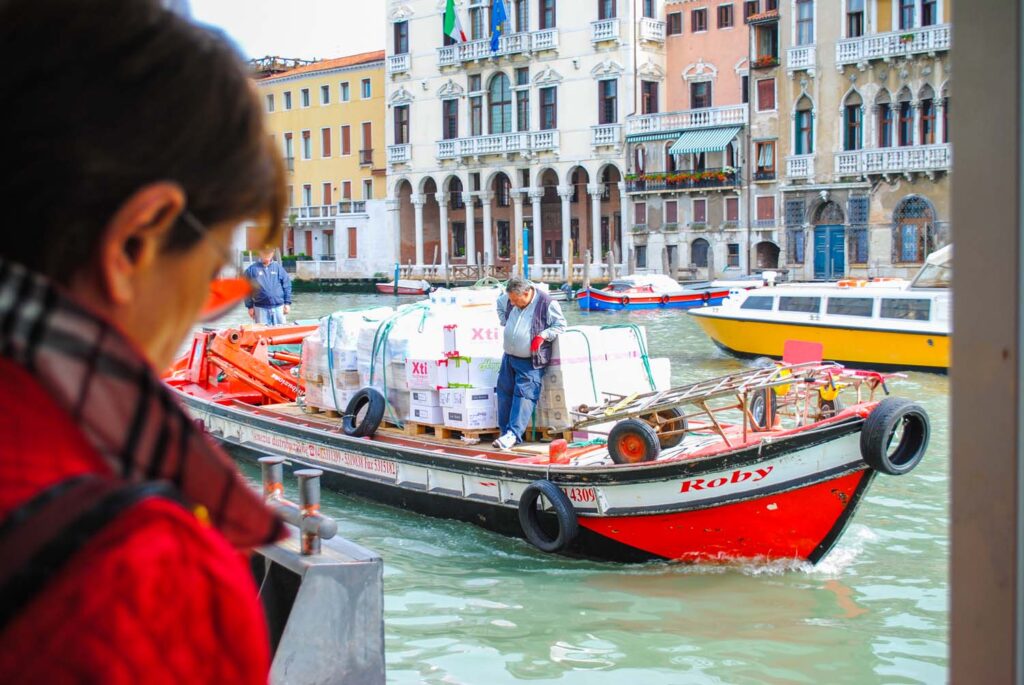
Giardini Papadopoli
Turn left down Fondamenta Papadopoli where you’ll quickly see the bright green trees sticking their heads above a brick wall. This is the Giardino Papadopoli , a beautifully manicured garden where locals Venetians come to get some shade and enjoy a bit of green space. The park spans more than 8,800 square meters and was built in 1834. While Venice has ample squares and waterways, there is surprisingly little greenery and lush parkland. The Giardino Papadopoli is Venice’s version of Central Park .
Among the gravel and stone paths are a variety of different trees like cypress, cedar, different fruits, elm, oleander, mulberries, and laurel. If you are even looking for someplace to come to escape the crowds and the noise, this is the oasis you’ve been looking for!
View this post on Instagram A post shared by Loredana Rossi (@lori_lo68)
Campo San Rocco
Walking through the park, exit at the south end, and cross the bridge over to the Calle dei Amai. Walking along the Calle dei Amai (which turns into the Calle de le Sechere) and turn right onto Ramo Cimesin. Ramo Cimesin veers slightly right and becomes Calle Tintoretto, and passes through Campo San Rocco.
Campo San Rocco is a charming square whose centrepiece is the church of San Rocco, an impressive Renaissance structure adorned with intricate marble carvings and frescoes. The surrounding buildings feature colourful facades and elegant balconies, creating a picturesque backdrop for a leisurely stroll or a cup of coffee at one of the outdoor cafes.
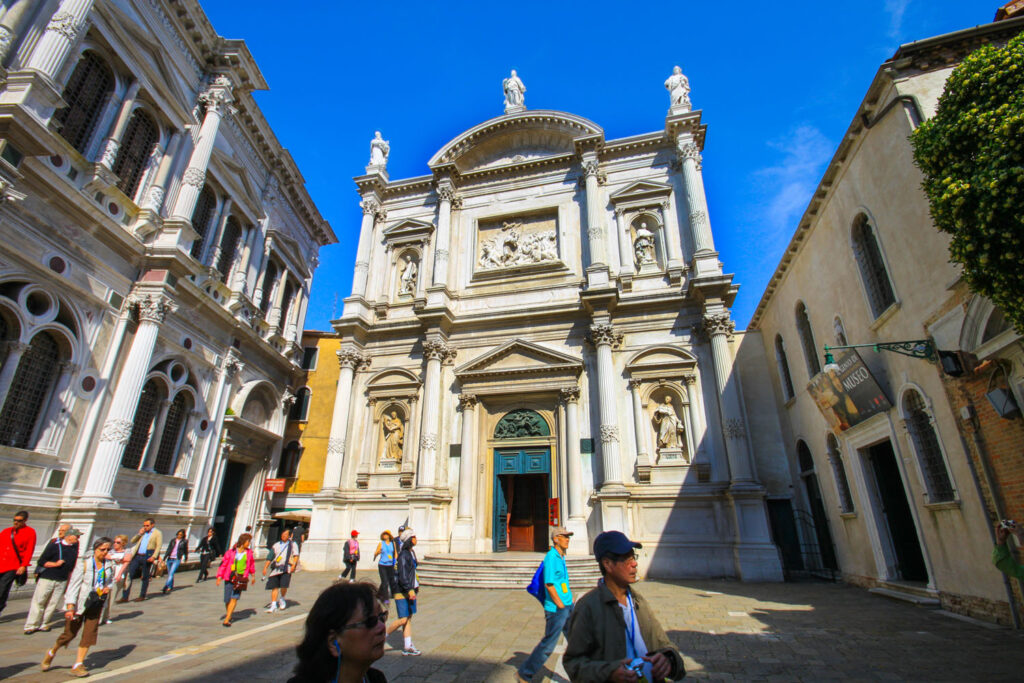
Basilica dei Frari
From the Campo San Rocco, walk toward Calle Fianco de la Scuola and continue onto Salizada S. Rocco. Turn left onto Campo dei Frari, where you are immediately struck by the towering Basilica dei Frari or Santa Maria Gloriosa dei Frari . But most people just call it the “ Frari ” for short. The church is the beating heart of this neighbourhood. In 1231 the Doge Jacopo Tiepolo donated this land to the Franciscans. The original church he had built was very small. As the Franciscans rose to power, they demolished it in exchange for a larger, more impressive design that better reflected their status in the city. The current version we see today was built in the 14th century in a high Venetian Gothic style.
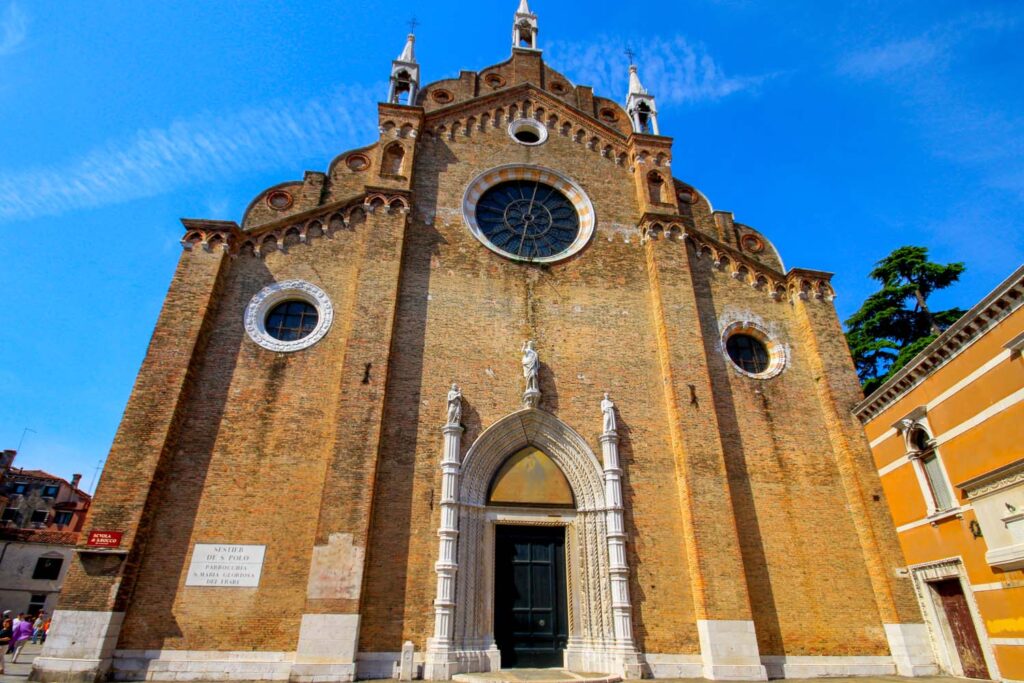
Looming over church is the great campanile, the second tallest tower in the city. The bell tower was built in 1396 and somehow still stands today! The unassuming facade might fool you into thinking at first blush this church isn’t very important. But in actuality, it is perhaps one of the most significant churches in the entire city.
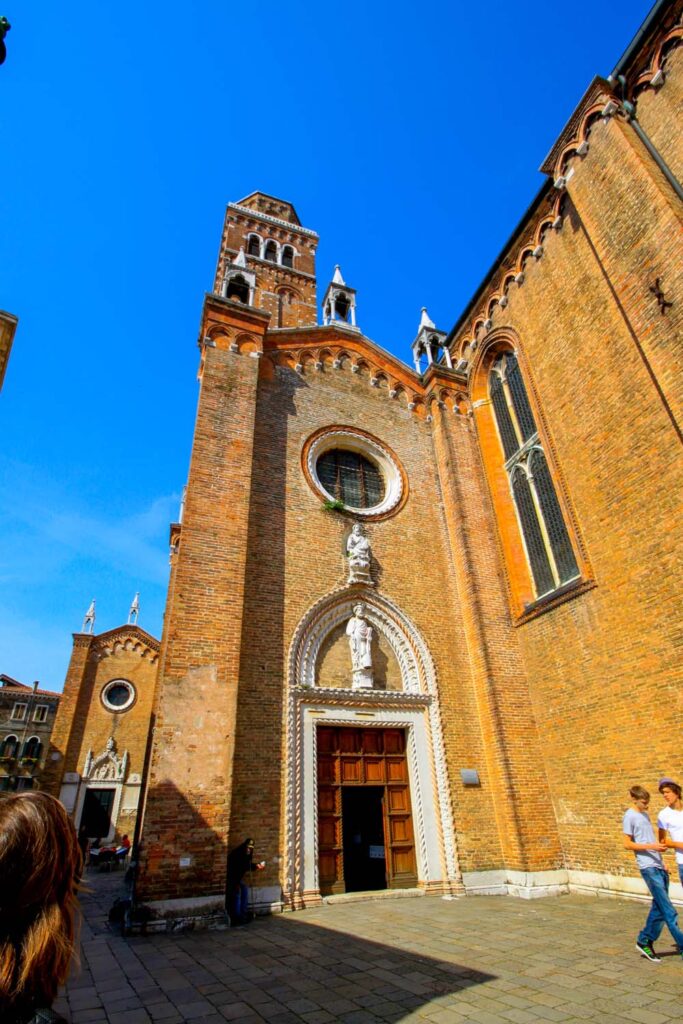
Entry into the Church
There is a small fee to enter the church (€ 3,00), but it is more than worth it to gaze upon the interior of this church and the famous works of art found inside.
Many Doges were buried here under the watchful eye of masterful works of art by the painter Titian . Titian, a Venetian himself, painted the great altarpiece inside the church. The Assumption of the Virgin by Titian is one of the first things your eye is drawn toward as you enter the church. It sits behind the high altar, lit by the glow of the stained glass windows behind it. This piece is perhaps the best example of Titan’s masterful work. Setting the standard for Venetian art during the Renaissance.
View this post on Instagram A post shared by @rebecca.photo.cese
Titian died of the plague at 94 years old, and a memorial to his life and death stands inside the great Basilica. The monument is gigantic! Looking like a small structure rather than a statue. A version of his famous painting is carved in relief into the stone. The image of the great master himself sitting in front. On either side of the artist are two figures representing universal nature and the genius of knowledge . The other four figures set in between the large columns represent Painting, Sculpture, Graphic Art and Architecture, each one being a critical force possessed by Titian’s art.
View this post on Instagram A post shared by Luca Brussato (@luca_brussato)
Campo Santa Margherita
From the church, head south through the Campo dei Frari. Turn right along Salizada San Rocco and left onto Calle S. Rocco. Cross over the Sestiere Dorsoduro and continue south down Calle S. Pantalon as it passes over the bridge, and the street turns into the Sestiere Dorsoduro. Leading you right in the Campo Santa Margherita.
The Campo Santa Margherita is a huge square in Dorsoduro District . Surrounding this square are houses that date back to the 14th and 15th centuries. Cafes have a tremendous amount of outdoor space in this large square, so you’ll hear the murmur of people laughing and the clinking of wine glasses at all hours of the day. Lovers lounge on the bright red benches, kissing under the sunlight. If you’re tired, this is a great place to end the tour early if you don’t want to explore the rest of the Dorsoduro District.
View this post on Instagram A post shared by Clairethefrenchbooklover (@clairethefrenchbooklover)
Dorsoduro District
The Dorsoduro district is located on the bottom of the Venetian islands. This area borders the Grand Canal and the Venetian Lagoon, making it a prime spot for traders to live. While it’s not as flashy as the other districts, think of this as a blue-collar neighbourhood. I still find it to be one of the most charming areas in Venice. Dorsoduro lacks the pretensions of the other spots. Since it’s home to Venice’s Ca’ Foscari University , you’ll also find the new blood of Venetian society, its students, who liven up the streets with modern music, food and entertainment.
View this post on Instagram A post shared by Francesca (@francescanr_)
Ponte dei Pugni
Head to the southern end of the Campo Santa Margherita and make a sharp left onto the Rio Terà Canal. Turn right to stay on Rio Terà Canal until you reach the Ponte dei Pugni . I love the view from this bridge. If you look towards the west, you can see the brick bell tower from the church of Santa Maria del Carmelo sticking its head up above the other buildings.
On either side of the bridge are a pair of footsteps marked onto the stones. This marking reveals a strange practice from the 18th century. Whenever two rival families were feuding, they would come here to battle it out with their fists. Unlike gun duals in the United States which were common to settle violent disputes, Venetians would fight each other with their fists. The first one to fall into the canal off this bridge was deemed the loser.
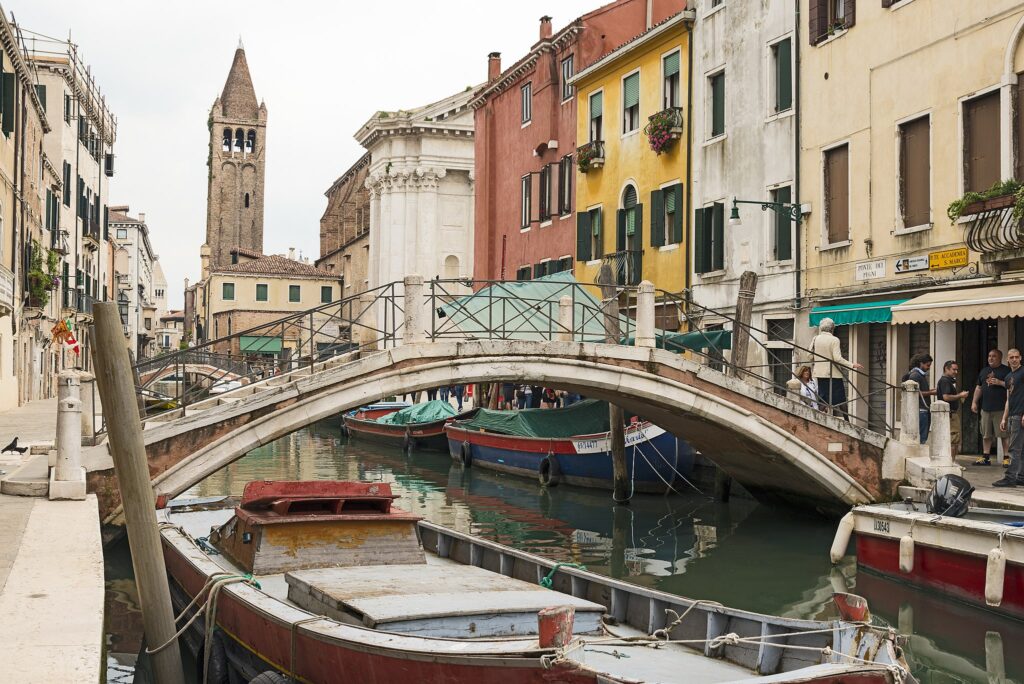
Cantine del Vino già Schiavi
We are approaching the evening by this time, but it’s not time for just yet dinner. Oh no, first we must have an aperitif ! And one of the best places to get it in Dorsoduro is Cantine del Vino già Schiavi . This bar sells Cicchetti (small snacks), which include Venetian classics like crostini topped with salt cod and wild garlic, pistachio cream or aioli with flower petals. Grab an Aperol spritz to drink while standing at the bar to feel very much like a local.
View this post on Instagram A post shared by Cantine del Vino già Schiavi (@cantinaschiavi)
Calle Nuova Sant’Agnese
Head northeast until you reach the Calle Nuova Sant’Agnese . This narrow street is filled with a variety of different shops. Being so far away from the touristy areas, these stores are known to sell authentic Venetian goods but at reasonable prices . In addition to the tourist shops, you’ll also find unique boutiques, which are a great way to support local businesses.
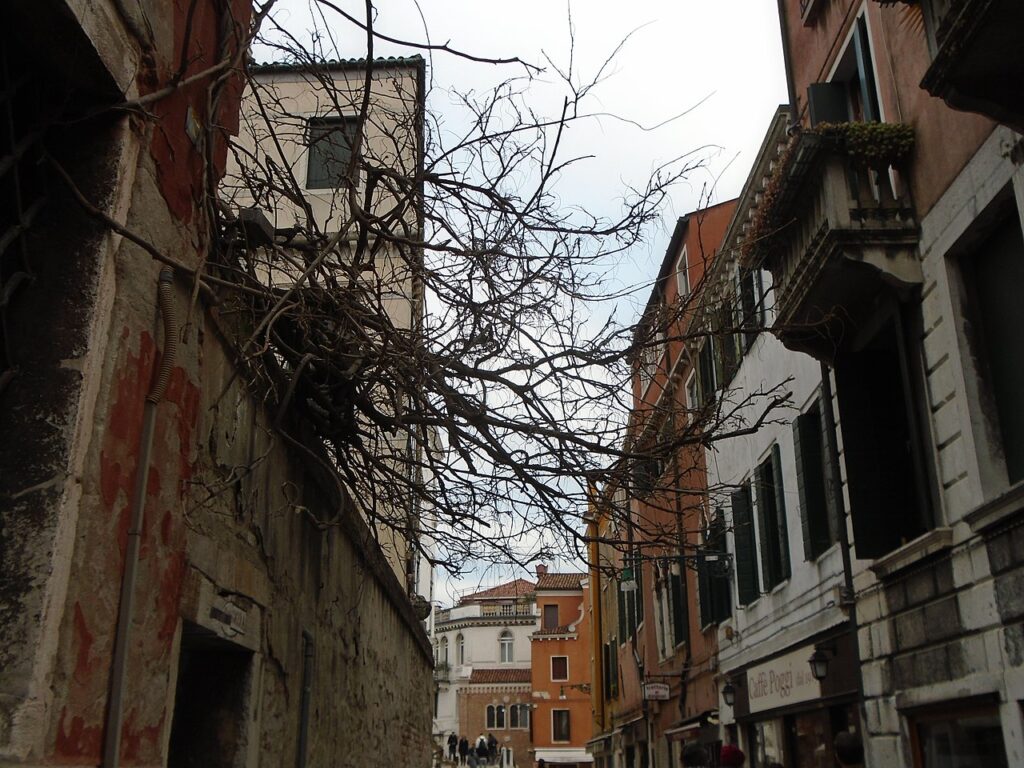
Basilica di Santa Maria Della Salute
If you’re still feeling up for it, continue walking through Dorsoduro, eastwards, along the Calle Nuova Sant’Agnese (which turns into Piscina Forner.) Continue onto Calle de la Chiesa and make a slight left onto Fondamenta Venier dai Leon walking along as it becomes Fondamenta Venier dai Leon. Turns left along Dorsoduro Street and follow the street into the Campiello Barbaro. Walk east along the Calle Barbaro as it becomes Calle San Gregorio and veer onto Calle de l’Abazia.
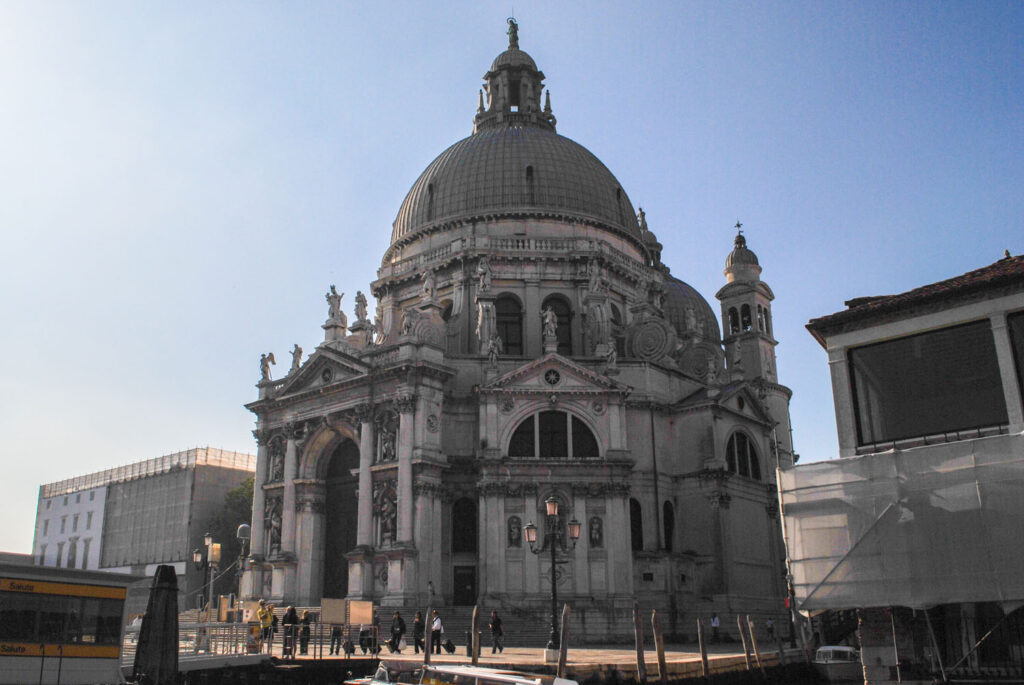
Stepping onto the stone of the Fondamenta Salute, you find yourself standing in front of the stunning white marble church of Basilica di Santa Maria Della Salute. Take a moment to both soak in the view of the church but also turn around to look at the great view of Saint Mark’s square across the river. This is where we first started the tour, and it’s amazing to see this spot from another perspective.
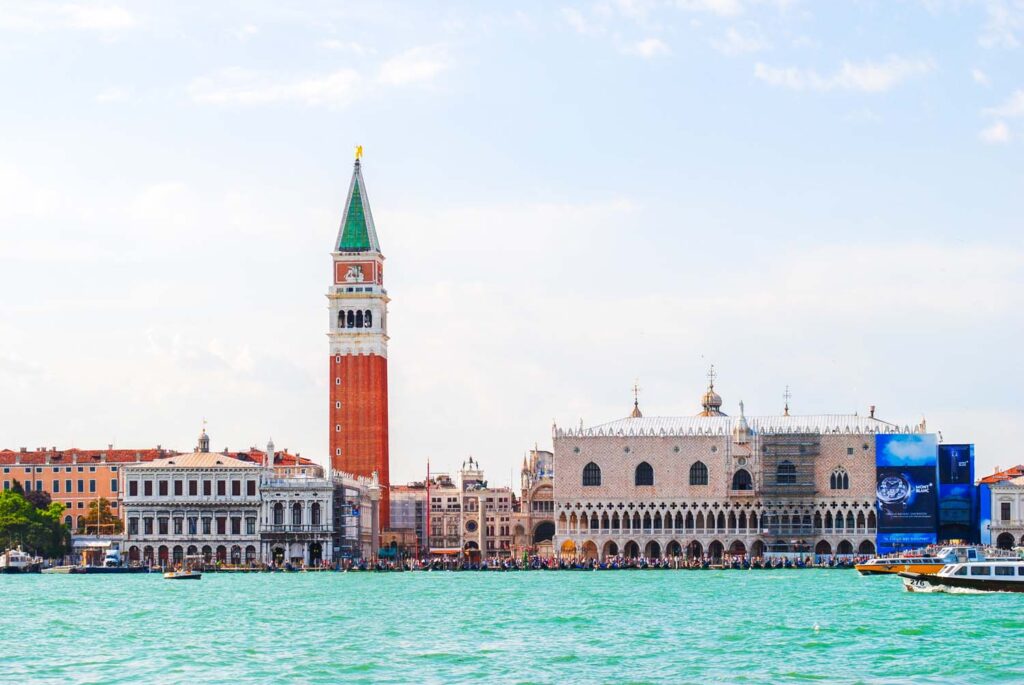
The Venetian Plague
In 1630 Venice was being ravaged by the plague. At the time, one of the ways people thought you could stop the plague was by making an offering to God and praying he would send deliverance to the city. So, the Republic of Venice built the church of Our Lady of Health as a last resort . Eventually, the plague period passed, and the city was able to start rebuilding itself. Nearly a third of the population of Venice died during the plague. Those that survived would remember that harrowing experience forever. Since the church was made in honour of stopping the plague, most of the art and symbolism you’ll find throughout the church in some way refers to death or the plague. Making it a very uniquely themed church.
The church is most notable for its humongous white dome, which dominates the sky. The dome, which almost seems to defy gravity, became a symbol of inspiration for artists in the city. To support the huge dome and weighty marble church, 1 million wooden piles were used to hold up the floating building.
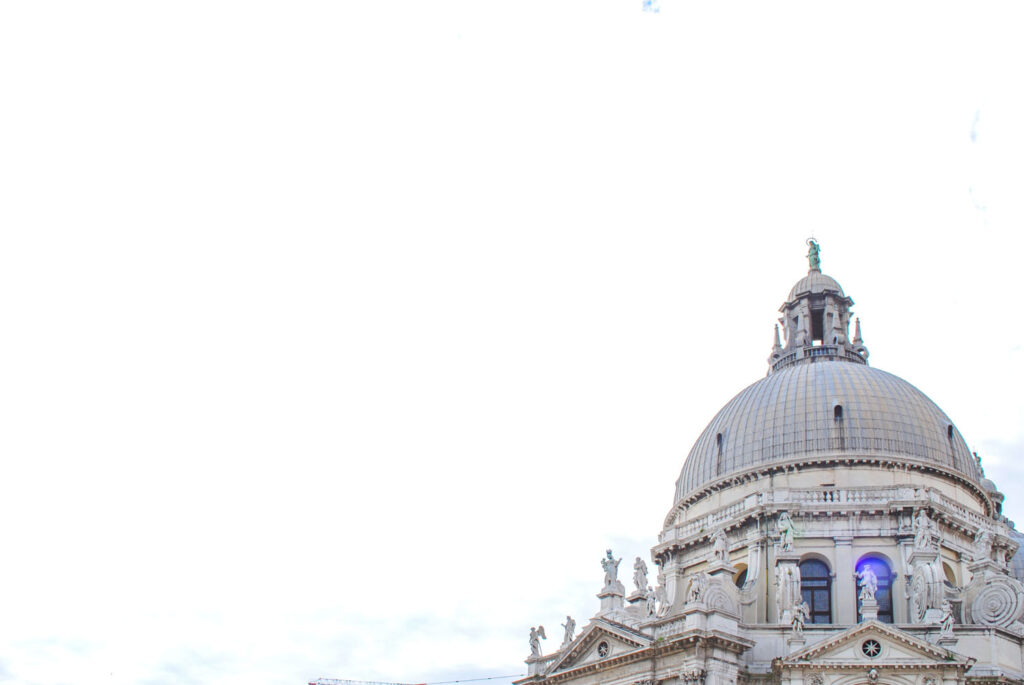
To finish the evening, walk down south towards the island’s far edge. The stone promenade which flanks the large waterway is called the Zattere . Zattere in Italian means rafts . In the 16th century, timber would arrive in the city on large rafts. Timber was not only used to construct the walls of grand palazzos and houses in Venice; it was literally the ground on which the houses were built. Timber was one of the most important imports in the city. It was also used to make gondolas up until the 18th century. Suffice it to say, the city was built around the timber industry, so its importance is not to be ignored. The earliest parts of the Zattere date as far back as 1520. Today the wide promenade is a great place to watch the sunset, reflection down against the mirror like waters of the canals.
View this post on Instagram A post shared by Giulia Zoppelli (@giulietta.z)
Trattoria San Basilio
If you’re feeling like you would like to dine somewhere close to your accommodation, there are Vaporetto stops all along the Fondamenta Zattere . But if you’re looking for something special along the water’s edge but away from the touristy hub, you should check out Trattoria San Basilio .
This down-to-earth restaurant is located inside the corner of one of the older buildings in the Zattere. It barely looks like a restaurant except for the awning and a few tables and chairs out front. But don’t let its modesty fool you; here, you’ll find a relaxing atmosphere, friendly staff, and traditional Venetian cuisine. Their seafood spaghetti with mussels, clams and squid tastes so fresh you’d swear the food jumped right onto your plate straight from the water. Try to get a spot outside to enjoy the sunset or watch as gondolas paddle past into the moonlight.
View this post on Instagram A post shared by Bettina Holstein (@bettinaholstein)
Phew, well, that brings us to the end of this tour. Hopefully, if you packed this all into one day, you found things along the way to return to see tomorrow! Let me know which neighbourhood was your favourite or what you’re most looking forward to visiting!
Happy Travels, Adventurers!
Buy the downloadable pdf for this walking tour.
With our downloadable PDF guide, you can take the tour at your own pace, without worrying about schedules or large tour groups. Plus, you can download the PDF to your phone or tablet to use even while offline.
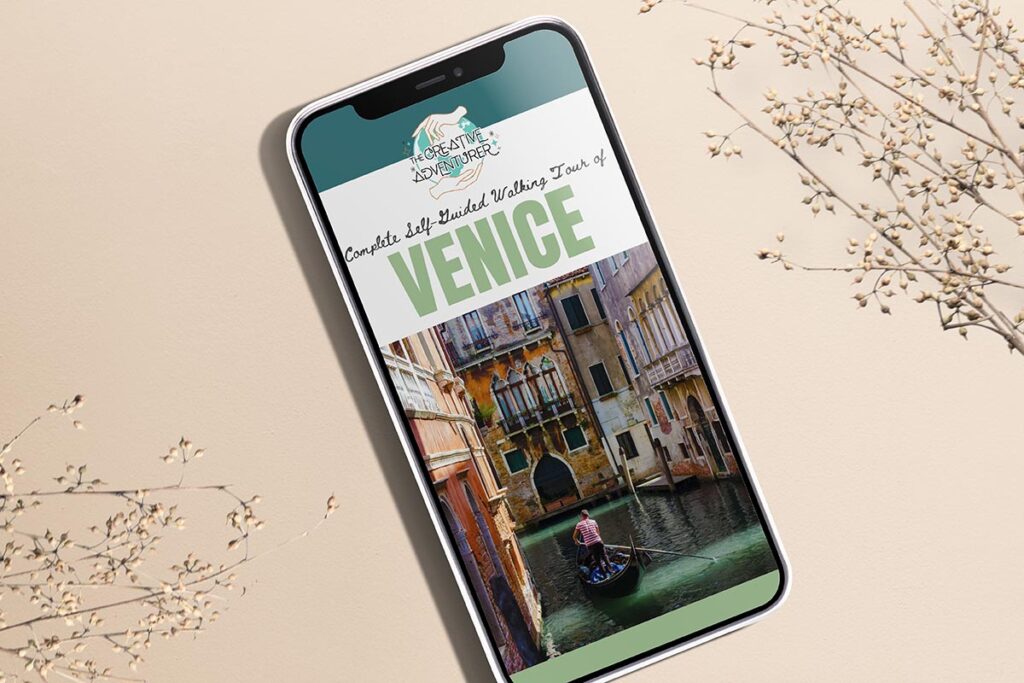
Happy Travels Adventurers!

« The Ultimate Guide to Exploring Teotihuacán, the Wonderous Pyramid of the Sun | Updated 2023
Ultimate self-guided murano island walking tour [updated 2022] », you may also like.
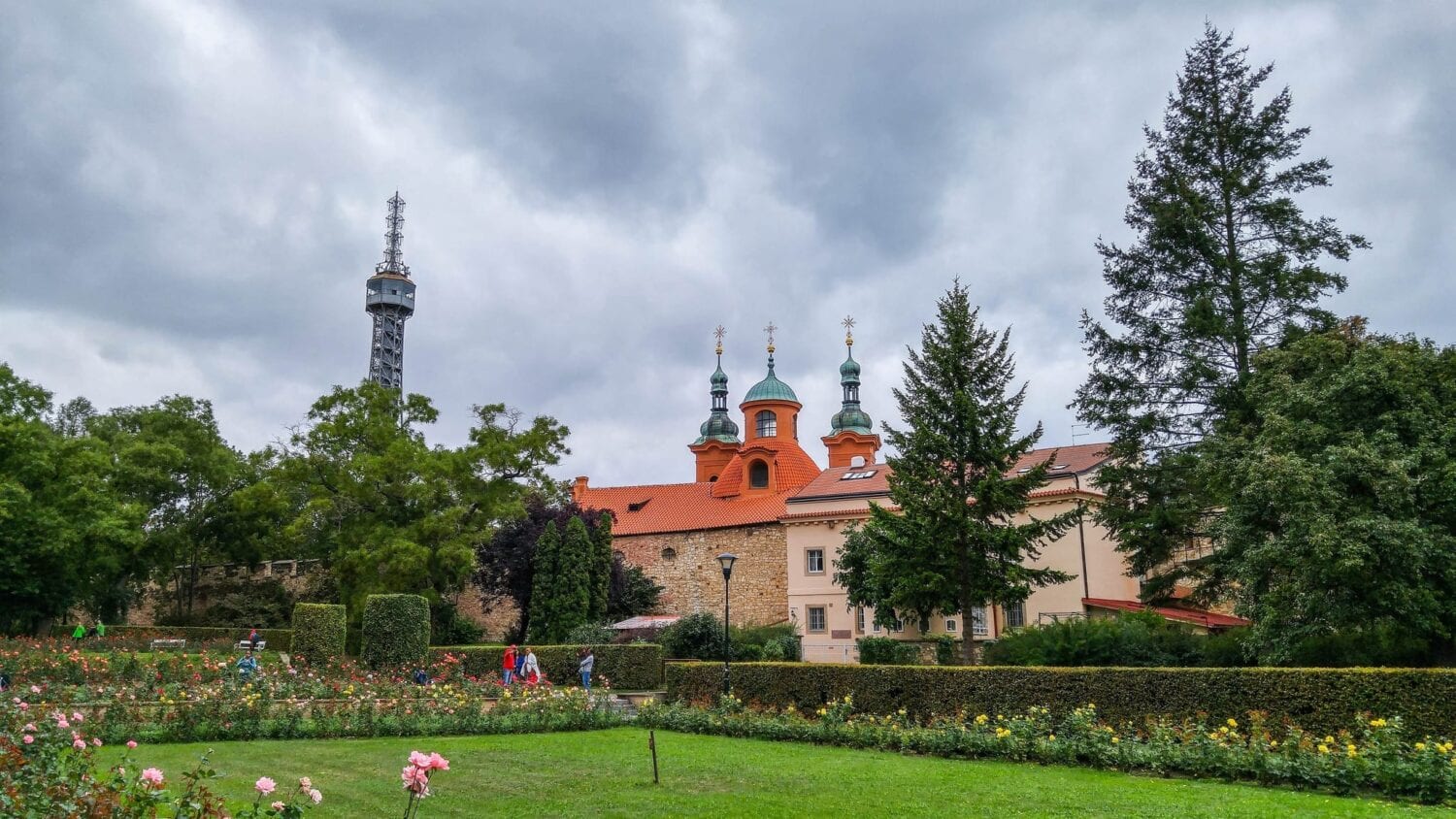
The Ultimate Walking Tour of Prague’s Peaceful Petrin Hill
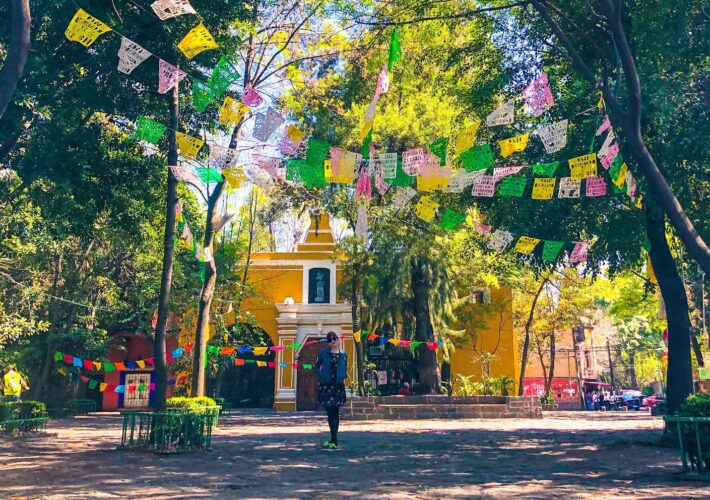
14 of the Best Places to Visit in Coyoacán to Spend the Perfect Day in Mexico City
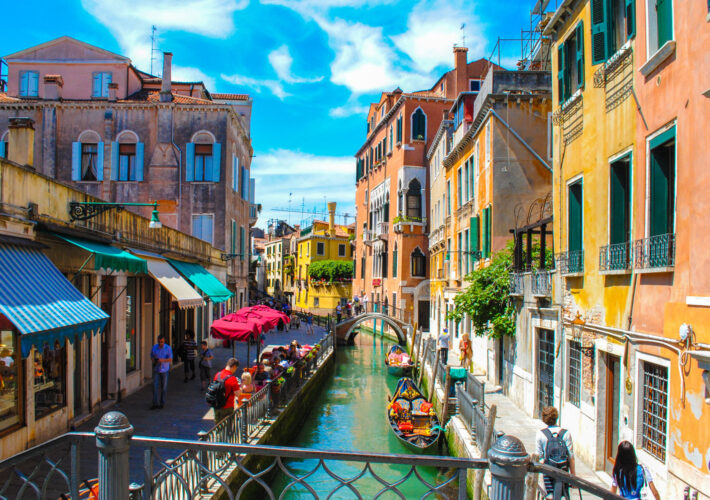
Escape to Venice: Your Ultimate Guide to the Perfect 48 Hours in the Floating City – Steal This Itinerary Today!
12 comments.
My wife and I took this walking tour just last week – June 2022. It was fantastic! We spread it out over two days as we stopped at lots of places to shop, east, and in 2022 there are lots of free art exhibits. Add a night tour of the Palace and the basilica and you will have a great trip!
laura.f.whelan
Thanks for the comment Phil, I’m so happy you and your wife enjoyed yourself on the walking tour. Two days is the perfect leisurely way to spread it out and make your own stops along the way. I’ve never known they had a night tour of the palace and Basilica but I looked it up and it looks incredible! What a special way to spend an evening in Venice!
Hello Laura, thanks so much for putting together these amazing walking tours! I’m heading to Italy next week and would love to do your Venice tour. However, wondering if it is possible to download it into my phone to follow it while I’m in Venice. Do you know if that is possible?
Thanks in advance, Juliana
The Creative Adventurer
Hi Juliana, I’m still working on the downloadable version of this walking tour! But you can always copy and paste the text to you notes app in your phone and download the google map I provided. Google has an offline map option you can download before you leave if you won’t have roaming while you’re in Italy. Hope this helps 🙂
Hi Laura Thank you so much for sharing this wonderful walking tour of Venice. My husband and I are going in April and as the previous commentator wondered if you had managed to complete a downloadable version yet? I am not very techy so not sure I could manage to copy and paste! My thanks in anticipation , Judi
Hi Judy! We finally have the downloadable version of the walking tour available in our store! You can purchase the PDF here to get all the information in this post and more available on your phone, iPad or desktop even when offline!
https://thecreativeadventurer.com/product/self-guided-walking-tour-of-venice-downloadable-pdf/
I hope you have a fantastic time on your vacation to Venice.
All the best, Laura (the Creative Adventurer)
Hi Juliana,
I am going to Venice next year and am so excited to do this walk. The effort and detail you put into this is incredible. What a wonderful person you are to share this. So appreciate. Can’t wait to discover this walk.
Thanks so much Nicole! I hope you have a fantastic time, Venice is spectacular and a true dream of a location.
Amazing, very well done! Anyone that wants to get of feel of venice should read and walk this. You should really make a documentary…..getting to know venice. thank you
Wow! Thanks for the amazing comment Jim!
I purchased the PDF on my computer but trying to figure out how to now open/save it on my phone. There wasn’t a follow up sent to my email with a link or anything. Please let me know how to obtain it, thanks!
Hi Tommy, I just sent you an email but you should receive an email shortly after payment with the link to the download. If you don’t get one shortly just reply to the email I sent and I will email it to you directly.
Leave a Comment Cancel reply
Your email address will not be published. Required fields are marked *
Copyright @ 2023 The Creative Adventurer | All Rights Reserved | Privacy Policy

Take a DIY walking tour of Venice, Italy
- August 22, 2019
Venice, Italy surprised me. You always hear about people saying how crowded it is, how un-Italian it is (because there are too many tourists), and so on. We had it in our heads that we wouldn’t enjoy it, but you know what? We shouldn’t have listened.
This is a sponsored post, but all opinions are my own.
We found plenty of lovely spots on the main island of Venice and the other nearby islands. A lot of that was thanks to using the Marco Polo Venice guidebook to have our own walking tour of Venice. We’ve used their guidebooks before when we (very uncharacteristically) visited Hong Kong and Singapore. The way I see it is that you can’t have too many insights into a place you know NOTHING about! We always tend to find good restaurants, viewpoints, and areas we wouldn’t have gone to otherwise.

This post contains affiliate links which means this website may earn a commission if you make a purchase through these links. More information in the footer.
Why do a DIY walking tour of Venice?
For this trip, we focused on getting away from the crowds. We did such a good job that we didn’t even see Saint Mark’s Square. We stayed in the Castello neighborhood which was great because we were in between 2 water-bus (Vaporetto) stops Celestia and Arsenale
Since we weren’t trying to be around everyone else on the island, we decided to take the “In the footsteps of Palladio” walking tour that Marco Polo has in their book. I actually wanted to do the “Exploring the lesser-known islands” one but wanted something a little shorter. When we go back (ohhhhh yesssss we are definitely going back!) we’ll be doing the other tour to see even more of what most visitors don’t see.

The thing about Venice is that it can feel overcrowded at times. There are cruise ships that dock and lets thousands of people disembark and they all want to see the same things. That’s why these self-guided walking tours of Venice are the best! Whether you are staying in Venice for a day (from a cruise ship or for another reason), or you are staying on one of the islands for a few days, this is a great way to feel something that many don’t take the opportunity to feel — a little peace and quiet.
Take the Vaporetto to San Giorgio Maggiore
Make sure you have a public transportation ticket. You only have to validate (tap in) once unless there are barriers, then you’ll have to tap to get through them. As we usually do, we opted for a multi-day ticket so it’s less to worry about on a day-to-day basis.
You’ll need to find the number 2 Vaporetto from the San Marco-San Zaccaria stop. There are a lot of Vaporetto stops in this area, so make sure you find number 2 going in the direction of San Giorgio! Not that it’s a horrible thing if you got on the wrong one (unless you are short on time).
Anyway, back to the task, the tour! Though, I could ride those Vaporettos all day 🙂

You’ll pull up to this small island and hop off into the vast open space before you which still doesn’t get enough room to fit the whole church into a photo without an ultra-wide lens. It is massive and beautiful. This is where you start to understand the name of the tour because Andrea Palladio created this masterpiece for the Benedictines in the 16th century.
Head on inside to check out the scale of the building. When we visited there was an art exhibit that had a colorful square tower in the middle that you could walk in. I must say, it was a bit strange to see in that setting, but it also gives it a cool new vibe.

The thing to do here is to wander through the church and the monastery, then go up into the tower where the views are unreal. I just wanted to cry because it was so beautiful. There are spots in all corners of the tower and, although there were plenty of people, you didn’t feel overly crowded. That’s the funny thing about taking the time to go somewhere a little different. You aren’t fighting for a spot.
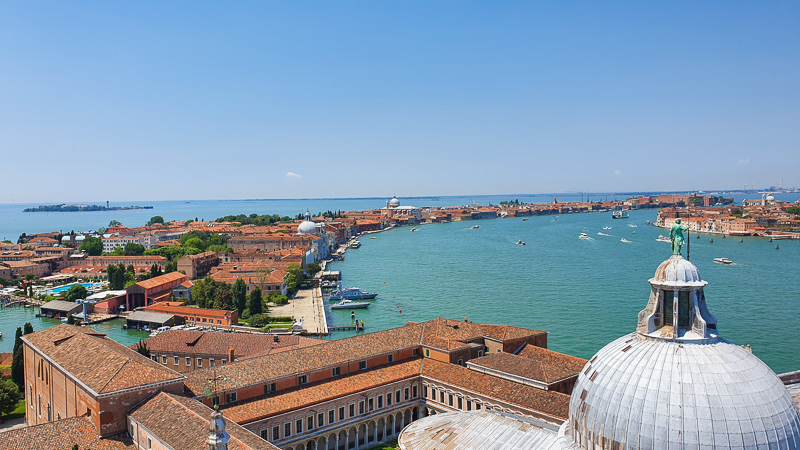
The view is what did it for me. I don’t appreciate the church setting as much as Sean, but I know he did enjoy that visit.
Next, it was time to catch the next Vaporetto to Giudecca. Just hop on the next one headed in the same direction you came in, and go one stop. The vibe is so different but you can still see across the water into the main part of Venice.

Secret gardens to explore
Ohhhhh this is my FAVORITE part!! I was a little apprehensive because the secret gardens mentioned in the Marco Polo Venice guide are part of a hotel…a bit of a fancy one, at that. But it was easy peasy. We walked in and asked the guy who looked like a guard if we could go look at the gardens, and he was fine with it and pointed us in the right direction. If you are able to dine in this hotel, I would recommend it. It’s stunning.
Head out back and experience something else that brought tears to my eyes. There are four gardens and each with a different personality. I was SO happy. Even thinking about them now makes me smile. Whether you want a wide-open space with the shade of a tall tree, or a pergola covered in greenery and flowers, or a rustic garden with a maze-like feel, it’s all here. They are perfectly kept and I actually wanted to run around like a child at that moment. It felt so freeing and so different from any other part of Venice we encountered.

We probably spent more time than we realized in these gardens. I didn’t want to leave and I instantly looked up the property to see if we should stay there next time. If you are interested in booking that property, here it is on Booking.com . It’s called Palladio Hotel & Spa. Fitting for this tour, huh? 🙂

Visit the Il Redentore
Another Palladio piece, the Il Redentore, a 16th century Roman Catholic church is stunning from the outside. He built it as a votive church and is a thank you to God. It’s also at the heart at one of the biggest Venetian festivals, the Feast of the Redentore.
Il Redentore is a major Renaissance masterpiece and if anyone loves this kind of architecture, this is a must-visit place to go. It’s not very crowded (similar to most places on this tour), and you’ll likely be in awe the entire time.

This might be random, but it’s good to know, there’s a water bottle fill station just outside the church, so it’s a good time to fill ‘er up! Stay hydrated, especially on hot days.

Have an afternoon snack
In the Marco Polo guidebook, they suggest stopping at La Palanca. That was such a good idea!! They do run on reservations, but it was after the lunch rush, so we got a table right away outside and one table away from the water’s edge. The staff was so nice (not sure why, but I wasn’t expecting that). We asked for recommendations and ended up with a platter of local favorites.

So, yeah, we were eating Venician favorites, with wine, next to the water, across from the San Marco’s Square area. Life is so good and chill.
It was a moment of pure bliss. The saying of “Eat, drink, and be merry” is one of my favorites and totally fits here. Venice is so special. I get it now. But, you might just have to get a little away from the crowds to feel it.

Order your Marco Polo guidebook for Venice , or wherever you are planning to travel next !

Treat yourself to a late afternoon drink with a view
Who am I kidding? Seeing Venice is a treat in itself. However, I’m a big fan of getting up high to see everything you can see. I know the PERFECT place for you to do that, get a drink, and let the time pass.
Walk on along the water. It’s a theme on this island. Just keep walking. Just keep walking.

Just over one of the bridges, you’ll see the Molino Stucky Hilton Hotel. Walk in and head straight to the back. You’ll see a sign for the Skyline Rooftop Bar.

Be sure to check their hours ahead of time. You can walk around on the roof area by the pool which also has breathtaking views…add this hotel to the list of hotels I want to stay in while in Venice. If you can afford it, book it here .
Grab a drink and a snack and marvel at Venice from above. The rooftops are beyond gorgeous. I wonder when they built Venice, did they know how beautiful it was? I can’t get over it.

Seriously, though. Venice has stolen my heart and part of that is because of this guidebook that helped us discover areas we probably wouldn’t have found otherwise.
We can’t wait to visit again! They do have a problem with too many tourists, but as with similar cities, spreading people out will really help and taking a walking tour like this one will actually, in a small way, help you be a more responsible traveler.

Until next time, Venice, arrivederci! Wishing you all joy and travels!
Hi! I’m Jessica, an American who made Amsterdam her home in 2014. I share European gems through food and memorable experiences. Want to know more? Head to my about page or check out my YouTube channel .
Latest Posts
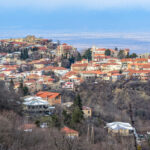

The Best Food & Wine Day Tour from Tbilisi, Georgia

A Guide to Bee Tourism in Egypt

Visiting Cyprus – Off The Beaten Path

Mini guide on German train travel

Visiting Graz, Austria? Travel Deeper with these Travel Tips

For many people, Venice is the most enchanting city on Earth. Seeing it for the first time is a breath-taking experience. From a distance its palaces, houses and basilicas defy reality, appearing to float above the city’s natural lagoon. Like something from a fairy tale or fantasy, daily life is organised around the water: over 400 bridges span the canals, while many front doors open straight onto them.
Urbs' audio tours of Venice are the ultimate way to see the sights, including the many hidden gems dotted throughout the city. Whether you’re visiting for a day trip or longer, there’s no better way to take it all in than a self-guided walking tour of Venice.
The Urbs Way
Listen & discover.
.png)
Enjoy 4+ hours of audio content written by cultural experts Explore 60+ fascinating cultural locations Discover 80+ restaurants, cafes, bars and shops recommended by local writers
Plan your route
.png)
Plan your perfect day with our unique route plotting function You can also use one of our curated routes which can be amended according to interests, schedule and budget
Book tickets

Find out which locations require tickets Book attractions and activities in advance to avoid the queues
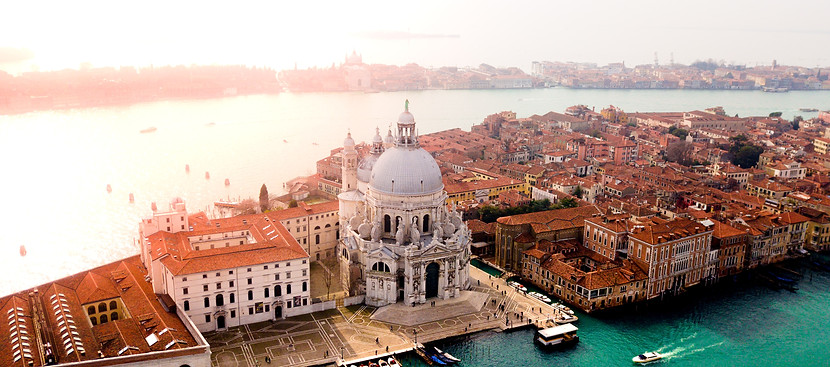
Viva Venice!
With its canal waterways, marbled buildings and exquisite architecture, Venice is an extraordinary city that comes to life in the summer months. Its beauty is something to behold in person - perhaps by gondola ride, or maybe on a walking tour.
With so much content and information available, simplify your trip with an audio tour of Venice. It’s the best way to get around and take in the sights as you go. No more having to Google your way around, or navigate an out-of-date map. Urbs it the modern way to access the city and make the most of your visit. Best of all, it’s easy to make your own travel guide with the accessible dashboard. All you need is a mobile, some headphones and a holiday to look forward to!
Venice uncovered
It’s one of the most famous waterside cities in Europe, so when in Venice, Italy there are a few places you need to check out. All of these places and regions (plus more) can be found on the Urbs app, which you can even access offline on your self-guided walking tour of Venice.
World-famous architecture
The most breathtaking architecture awaits you on an audio tour of Venice. Perhaps one of the most famous of these is St Mark’s Basilica, an ornate church right next to another hotspot, the Doge’s Palace. Located in the uber-famous St Mark Square, also known as Piazza San Marco, this is a wonderful place to amble about, with a heady mix of locals, tourists, students and visitors from all over the world.
As well as St Mark’s, there are many squares and piazzas to enjoy during your day out in Venice. Great as a spot for a time out, to sip a coffee and watch the world go by. Campo Santo Stefano and Campo Santa Maria Formosa are both picturesque places to add to your viewing list on your audio tour of Venice.
There are an astonishing 300 bridges in Venice, so don’t forget to pack your iPhone for all those photos you’ll be taking. In the heart of the city you’ll find the Rialto Bridge (Ponte di Rialto) - this is one of the most famous and oldest to explore. Take a moment to capture the iconic red and white masts as gondolas glide below.
Another must-visit for culture lovers is the Bridge of Sighs - distinguished by its white limestone material. Rumour has it that couples that kiss going under the bridge will enjoy everlasting love! If that sounds up your street, add it to your audio tour of Venice!
With 188 islands making up Venice it’s easy to see why boat is the best way of getting around the canals, many of which can be found in St Mark’s Square. The Grand Canal is the most famous to tour, its spellbinding views make it a popular way to travel. Dare to get off the beaten track and there’s so much to marvel at outside the heart of the city. One of these is the quaint island of Torcello. It’s one of the best kept secrets to enjoy during your audio tour of Venice, with plenty to see and sample – including great local seafood.

Explore Venice by App
Aside from being your very own pocket tour guide, Urbs has a host of benefits that have helped travellers from all around the world. You won’t want to leave home without it – here’s why:
Navigate the city
Why take the same old tourist route, when you can make your own self-guided walking tour of Venice? Using the Urbs app, you can build your dream trip, from the hundreds of events, attractions and places available. Alternatively, you can tap in to pre-selected walking tours to get the best out of your trip.
Get your tickets
Great news if you’re planning to visit the many attractions within the city. Urbs allows you to book tickets in just a click. It’s the perfect way to keep all your bookings in one easy to find place.
Handpicked by experts
We’ve teamed up with local experts based in Italy, to bring you the very best of Venice. It’s the perfect way to visit the city and soak up all the sights, from the most popular, through to hidden gems that only the locals (and now you) know!
Plenty of choice
Did you know that there’s over 130 different places on our app, which you can add to your audio tour of Venice? Mix and match your itinerary, so you can make the most of your time during your route.
Download the app
Planning a trip to Venice? Then don’t miss the chance to access the city in this audio feast, now available to download on Android and iOS devices.
.png)
Once you’re ready to put your audio tour together, download the App to your iOS or Android device, get some headphones and you’re all set. Ciao, as they say in Italy!
Self Guided Tours
Our venetian guides' ll walk you through the secrets and our way of life..

DAILY ONLINE
Online 7/7 days
BUY LOCALLY
Discover Venice like
Two offices in the heart of the city
Discover Venice between past and nowadays
Saint mark and rialto panoramic self-guided tour, discover romantic venice self guided tour.

very nice gondola ride, appreciated commentary on board with our mobile Jean Caruden
I went in Venice last week with my friends and we downloaded the Full Venice App, it was very fantastic! We visited a lot of places and we went around the magic city of Venice, all day and all night. Also we tried the Treasure Hunt, we had a lot of funny! It's a very easy to learn about a new city. Thanks for all. Eleonora Boccolo
The best tour of the Grand Canal and a beautiful gondola ride! One of the best choices to discover the real Venice! I highly recommend it Mirko Milanese
nice experience the romantic self guided tour, it's like a game or a treasure hunt, you really find by yourself the hidden romantic treasures of this wonderful city, recommended. Joseph Von zamer
Amazing Private Gondola Ride!! I have already booked the canal grande self guided tour with this company. Really professional team! Many thanks!! Iryna Drevetska
Brilliant!! With their application, a new and smart way to visit the most beautiful city in the world. Thanks to the courteous and professional local staff. We'll see again! Jeff Wolf
Secure payment

Partner with

San Marco 1130, Venezia
04351870276
Authorized by

© 2022 - Venice Tours - All Rights Reserved | Legal Terms | Privacy Policy | Update advertising tracking settings

Europe » Italy
The Best Self Guided Walking Tour of Venice | Sherpa Tours
Table of contents.
A self guided walking tour of Venice is one of the best ways to discover the sights, sounds, and canals of The Floating City.
Venice is one of the most romantic and alluring destinations in Europe. Palaces, ornate buildings, and gothic churches sit atop a lagoon, spread across islands etched with canals plied by gondolas. The city is like a museum; you could easily spend your entire trip on the water, admiring the gorgeous architecture.
But it’s inside the buildings where Venice really comes to life. This city has a rich history as the heart of a vast trading empire, and the museums are suitably impressive. Also enticing are the art galleries hiding away a wealth of Venetian art and the remarkable churches with intricate interiors.
When you’ve worked up a hunger, you’ll quickly realize that the Venetians know how to put on a feast. The most popular way to indulge is to sample a range of cicchetti , the city’s take on tapas. Wander from bar to bar, sipping on wines and wolfing down different creations, before setting up at a waterside restaurant to sample the city’s incredible seafood.
Get your bearings in this magical city with our self guided walking tour of Venice before striking out to discover its art, palaces, and incredible beauty.
History of Venice
The First Settlement
Although there aren’t any records, historians today widely agree that Venice first began around the 5 th century AD. Refugees from Roman cities on the mainland were fleeing invading forces, retreating to the islands on the lagoon that make up Venice. As the population grew, so too did their need for more space. The inhabitants decided to drive wooden stakes into the ground, build platforms, and began to construct their buildings on top. From their outpost in Ravenna, the Byzantine Empire soon took control of the growing city. As soon as the Lombards conquered Ravenna, Venice installed its own Venetian Doge , or ruler, chosen by the wealthy merchant families that had emerged.
Expansion to a Trading Empire
Venice saw incredible growth from the 8th century onwards thanks to its strategic position and wily trade deals. Money poured in from both the Islamic world and the Byzantine Empire; Venice even struck a deal with the latter that saw the city’s merchants grow even richer. Soon, as the Byzantine Empire began to fade, Venice took control, using Crusaders to seize and sack Constantinople. A flourishing navy fleet also made Venice near-invincible, and they established a trade empire throughout the eastern half of the Mediterranean.
The City’s Decline
Centuries later, in 1453, Constantinople fell to the invading Ottoman Empire, which would continue to capture Venice’s trading outposts. The city’s power began to wane as new trade routes around the Horn of Africa were discovered, and Venice was regularly challenged by forces like the pope and the Turks. By the 17 th and 18 th centuries, Venice’s fearsome naval fleet was soon outgunned by the British and the Dutch, and their days as a trading power were well behind them.
The Kingdom of Italy
The Republic of Venice fell when Napoleon successfully conquered the city in 1797, forced into a pro-French democracy. Soon, the city would fall under Austrian rule; afterward, it passed between French, Italian and then back to Austrian rule. After a brief stint of independence, Venice finally was merged into the new Kingdom of Italy, of which it remains today.
Venice’s history is one of the most fascinating in Italy. Delving into this beautiful city’s story is a must while visiting; luckily, Sherpa offers the best walking tour of Venice there is. If you’re not in the destination but still want to try it out, our walking tour is also available as a Venice virtual tour, letting you discover the city from the comfort of home.

Where to Stay in Venice
The 5 Best Neighborhoods to Stay in Venice
San Marco is a fantastic choice for visitors to Venice. Home to the famous Piazza San Marco, this is the neighborhood where our walking tour of Venice takes place. Filled with canals, restaurants, bars, and the city’s most famous sights, this is the heart and soul of Venice as a destination. Winding through the labyrinth of streets reveals churches, intricate architecture, and of course, the romantic sight of gondolas plying the canals.
Across the river to the northwest of San Marco is where you’ll find San Polo, another central downtown area in Venice. It’s a neighborhood filled with history, more churches, restaurants, and bars, and it is within an easy distance of the main attractions of San Marco. Prices up here are also a little bit more affordable than across the river – but not by much.
Dorsoduro is the area further to the south, a large neighborhood that’s great for travelers of all types. There’s art, history, culture, food, and more to discover, all of it without the hectic crowds found in San Marco and San Polo. The area is also just a 15 – 20-minute walk to San Marco and the beginning of the tour.
Castello is the largest neighborhood in Venice, and as such, can be quite varied depending on where you stay. Its western edge borders San Marco, so if you’re staying closer to that side, you can expect more facilities for tourists, such as restaurants, bars, and shops. As you move closer to the eastern end, things start to feel more local and less overrun, with it turning into a residential-like area.
Finally, Cannaregio is in the north of Venice, a great spot to stay if you’re looking to save some money on accommodation. More affordable due to the distance from the city center, this area has a very local feel. Historically, it has been one of the last remaining bastions of local life as the city’s population has continued to decline. It’s relaxed, friendly, and filled with great restaurants and bars where you’ll rub shoulders with actual Venetians.
What to Eat in Venice?
5 Must-Try Dishes in Venice
- Bigoli in Salsa
- Baccalà Mantecato
- Spaghetti al Nero di Seppia
- Sarde in Saor
Cicchetti is to Venice what tapas is to Spain. These small dishes of food are best enjoyed as a pre-dinner aperitif, with a big variety of different types. There could be deep-fried olives, slices of baguette topped with seafood or cured meats, or something else entirely. Each plate costs between 1 and 3 euros, meaning you can easily sample several dishes before sitting down for your main meal.
One of the mainstays of menus around Venice is bigoli in salsa . This simple pasta dish features a noodle that’s a little bit fatter than spaghetti, cooked in a rich and delicious sauce made from fresh sardines and onions. The seafood flavors are perfect for recharging after a Venice self guided walking tour.
Another seafood-based anti-pasta is the baccalà mantecato. This is a popular starter dish, where creamed cod paste seasoned with olive oil, salt, and pepper is spread on fresh bread. It can also sometimes be served alongside grilled polenta, another popular Venetian food.

Daring foodies will want to try the spaghetti al nero di seppia , another seafood pasta dish. Squid ink is the star of the show, mixed in with wine, onions, and tomatoes to create a delicious sauce. The black can be off-putting, but the flavors are sensational. It’s also possible to find risotto al nero di seppia, as rice is a popular ingredient in Venice.
Finally, sarde in saor has been around since the Middle Ages and is one of the most popular dishes in Venice. Sardines are fried with onions and balsamic vinegar and then sweetened with raisins and pine nuts. It lives on today and is often found as either a cicchetti or a starter at restaurants.
Insider Information
Is venice sinking.
The waterways and canals of Venice make it one of the most romantic destinations in the world. But every year, it slowly sinks into the ground, thanks to a combination of factors. The muddy lagoon on which it is built is by no means adequate to support such a city; groundwater was being pumped out from underneath the city, and the gradual rise of ocean levels worldwide all combine to make this destination one to see before it’s too late.
Gondola Rides in Venice
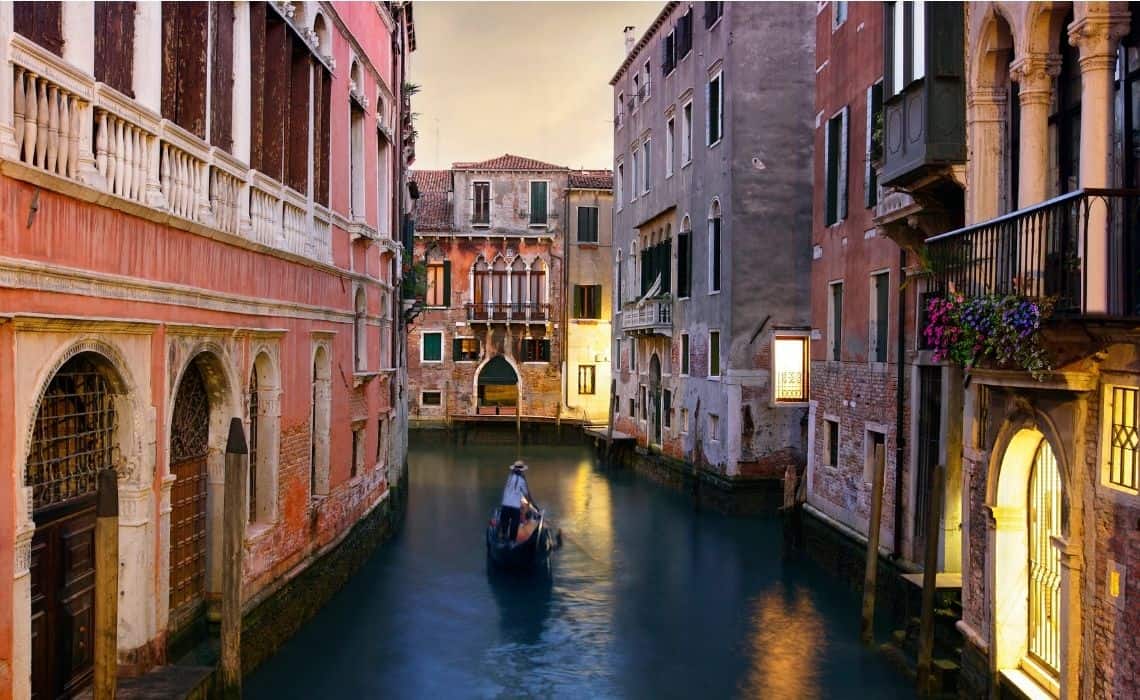
Enjoying a gondola ride on the canals is one of the classic tourist experiences of a trip to Venice. But there are a few things to know before you go. The first thing is that gondola rides are quite expensive; 80 euros for a daytime ride and 100 at night. Rides last 40 minutes, but a gondola can hold up to 6 people making the cost a little easier to bear. The Grand Canal is more crowded, so we recommend going for a ride in the quiet back canals of the city.
Responsible Tourism in Venice
Venice has been hitting the headlines across the world lately, but for all the wrong reasons. Overtourism has become a big problem in the city, as over 100,000 visitors arrive each day, crowding around the main tourist areas. But there are ways to be a responsible traveler in Venice.
How to Be a Responsible Traveler in Venice
- Stay as long as you can
- Visit in the off-season
- Eat in the local restaurants
- Buy local arts, crafts, and goods
Venice is a wonderful destination in Italy and should be high on your bucket list of places to visit. For a wonderful introduction to this fabulous city, check out our self guided walking tour of Venice below. And remember, our app provides virtual tours of Venice as well.
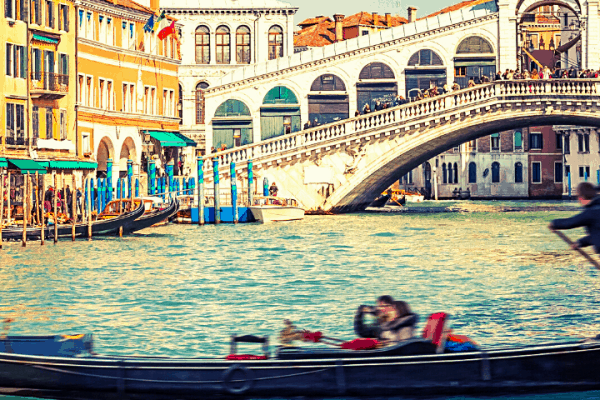
Essential Venice
This website uses cookies to improve your browsing experience and analyze the use of the website. Learn More

St. Mark's Square Venice

In this post, we list the 12 must-see thing in St. Mark's Square in Venice.
We also include directions on how to get here, a map to help you explore on your own, as well as recommendations for guided tours.
St. Mark's Square Map

Click the map to enlarge or download it to your phone.
1. St. Mark’s Square
This public square is lined with several historic buildings, cafes, shops, and other notable sites.
At around 2 ½ acres, St. Mark’s Square is quite large and there are a lot of interesting things to see in the area.

St. Mark’s Basilica is located at the far end of the square, and you’ll find its 92 meter (300 ft.) tall bell tower to the right of the structure.
Between the basilica and the bell tower, you will see the Doge’s Palace in the distance.
The buildings surrounding the square are mostly former government offices that were in charge of Venetian trading outposts.
Napoleon once called St. Mark’s Square “the most beautiful drawing room in Europe,” and it’s not hard to see why.
This is a great place for people-watching during the day, but after dark, the lamplight really reveals how little has changed about this location throughout the centuries.
2. Caffe Florian
There are a few different cafes in the area of St. Mark’s Square, and each offers the same types of food at the same general price, often with local musicians performing classical music.
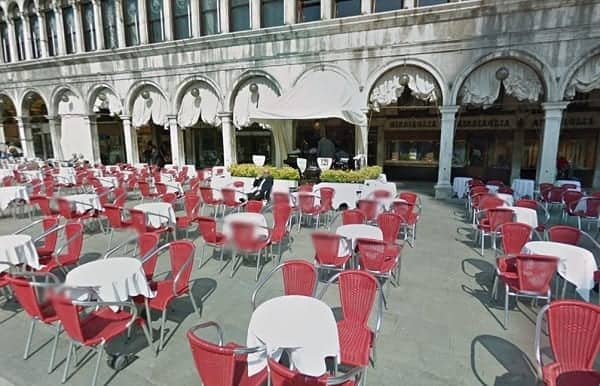
Caffe Florian, located on the Southern end of the square, has been around since 1720, and famous people such as Casanova and Charles Dickens have all dined here.
3. Caffe Quadri
Caffe Quadri is on the opposite side of the square, and they have also hosted several notable guests including Stendahl and Richard Wagner.
These are the two most notable cafes on the square, but there are others you can visit if you’re just looking for a quick bite or something to drink.
4. St. Mark’s Basilica
This is one of the oldest churches in all of Europe, dating back to 1063.
It is named after St. Mark, who wrote the story of Jesus in the bible.
Mark’s remains are said to be buried under the main altar in the basilica.
Despite its age, this is actually the most recent church founded in Venice.

The architecture on display here reflects the history of trade in Venice, with influences from Roman, Greek, Byzantine, French-Gothic, and even Muslim architectural styles.
Many consider this one of the most interesting churches in Europe.
And with all the different artistic approaches that were taken in its development over the years, it’s clear that this is one basilica that can’t be compared to any other.
You can enter this church and see the interior for yourself, and there’s even a free audio tour of St. Mark’s Basilica as well.

5. Torre dell'Orologio
You’ll find this structure to the left of St. Mark’s Basilica, and it dates back to about 1500.
If you look at the top of the tower, you’ll see two bronze Moors.
These were initially intended to be giants, but after the metal darkened over the centuries, they were given a different cultural background.
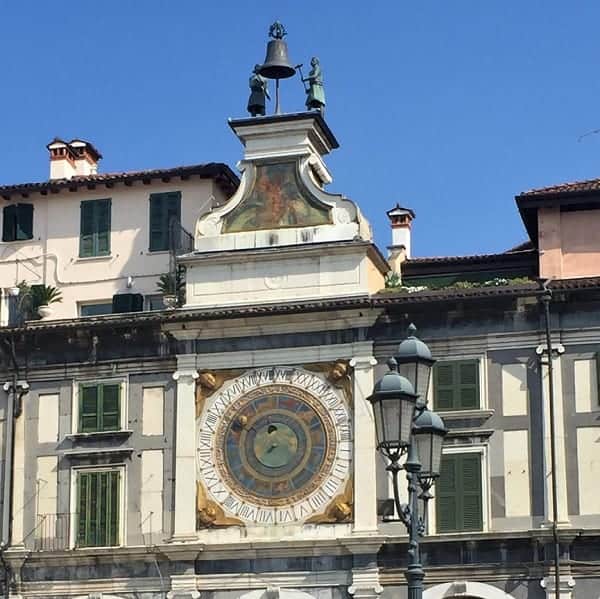
At the top of each hour, the moors swing their clappers. The dial of the clock shows all 24 hours, the zodiac, and even the phases of the moon at its center.
Look above the traditional dial to see the first digital clock in the world.
The clock tower also has a winged lion, the symbol of St. Mark, which holds an opened book reading “peace be with you, Mark.”
You can find this winged lion symbol all over the square if you look closely enough.
Shops & Crafts
With Venice’s history of trade, it should be no wonder there are several shops in the area where you can find a variety of items for purchase.
Some of the most popular items for sale in this city include glass products, masks, lace, and more.
You’ll find shops either up and down Mercerie street or under the arcade on the Northern side of the square.
6. Campanile/Bell Tower
Located near the center of the square and opposite the clock tower, the campanile was once actually the lighthouse which guarded the entrance to the Grand Canal.
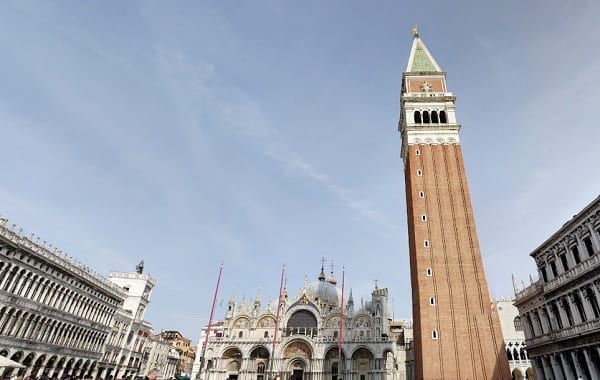
The bell tower you see today is not the original structure, as the first campanile fell in 1902.
That said, it was faithfully rebuilt 10 years later, and it’s a much stronger building today.
There is a lift which will take you to the top for excellent views of the city.
Floods at St. Mark’s Square
This square floods quite frequently, and when it does, you will hear warning sirens to let you know that the area is no longer safe.

Keep an eye out for puddles forming from the round white stones in the pavement.
During strong tides, the water flows like a river to the lowest areas of the square.
Although many doorways are designed to avoid flooding, it doesn’t always help.
This problem is expected to get worse as a result of rising sea levels.
7. Doge’s Palace
Located to the right of St. Mark’s Basilica, this pink Venetian Gothic building housed the government of the Venetian empire and has also served as the home of the Duke (or Doge).
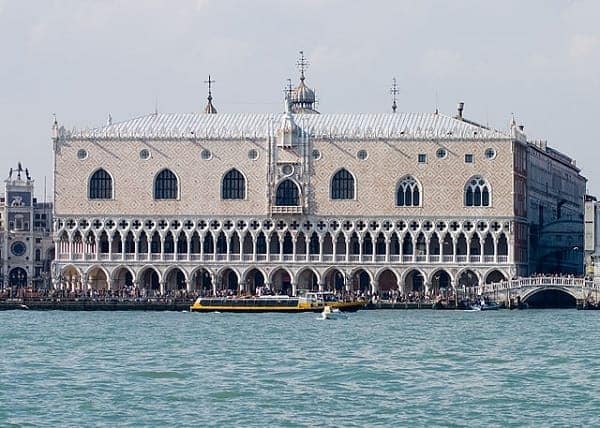
It is said that from 1150 - 1550, this was the most powerful location in Europe, despite its lacy and unprotected surroundings.
The palace was intentionally built this way to show that the Doge was an elected official and he had nothing to fear from his citizens.
Tickets are available to enter the palace, and its walls are lined with beautiful works of art from famous artists, so it’s definitely worth a visit.
8-9 Piazzetta
This is the small square between St. Mark’s Basilica and the San Marco Basin.
You’ll find the Doge’s Palace on one side of the Piazzetta and the Campanile on the other.
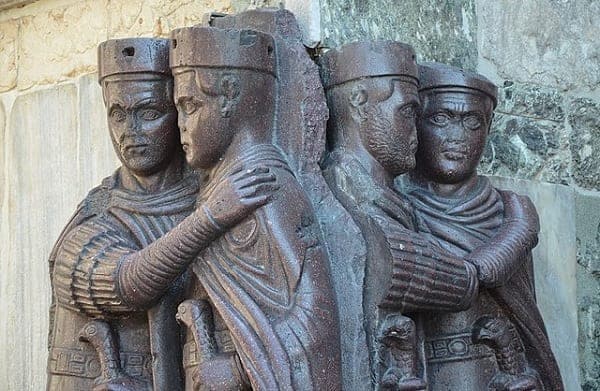
There are many small things to see in this area, including the Tetrarchs at the gate of the Doge’s Palace, the 7th Column of the palace, the San Marco Column, and the San Theodore Column.
Those last two columns were once taken from Constantinople and in the past they were used as execution sites for criminals.
You’ll find this stop just south of the Piazzetta.
It’s the site of a special celebration in which the Doge would board a boat and head out to the lagoon to perform a ritual in which he would toss a ring into the water.

The ring was a symbol of the marriage between Venice and its waters, an offering to reaffirm that connection.
The lagoon is 212 sq miles, and it’s home to many other islands.
Although it is big, it is also quite shallow, and you could technically walk across most of it.
12. Gondolas
As you stand and look out at the lagoon, chances are you’ll see a few of these boats in the area.
These gondolas are one of the most popular ways to get around the city.
These boats use just one oar, which is used both to thrust the boat forward and turn it one way or another.
They typically travel at about 3 miles per hour and take about as much energy as walking.
Today, there are only around 500 gondolas in Venice, and they are only available for tourists.
It can cost €100 or more to ride a gondola, so it’s probably a good thing you’re saving money on this tour!
We have a post explaining how to take a gondola ride .
13. Bridge of Sighs
Head to the bridge just beyond the Doge’s Palace to get a good look at this historic site by looking inland to the next bridge on the canal.
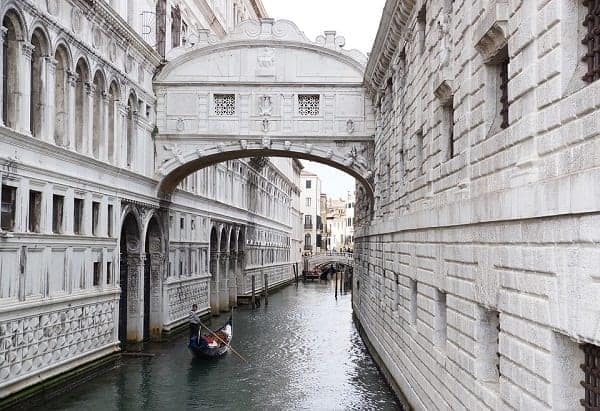
The Bridge of Sighs connects the palace with the prison.
It is said that after criminals were sentenced, they would be walked across the bridge, where they could take one last look at Venice before heading to jail.
The reality was likely far different than this romanticized version of events.
But, leave it to a poet like Lord Byron to give this bridge a wistful name despite its dark history.
And be sure to check out our other free walking tours of Venice .
This free self-guided walking tour will serve as a companion piece to a free audio tour of St. Mark’s Square (Piazza San Marco).
Whether you don’t have headphones to enjoy the audio version or you just prefer reading about the location, this is an excellent alternative.
How to Get to St. Mark’s Square
This public square is located on the southern end of Venice at the bottom of the Grand Canal. There are two main methods for getting here: on foot or by boat.
If you’re on the other end of the Grand Canal, the easiest way to get here is by hopping on a gondola or boat and enjoying a trip down the winding waterway.
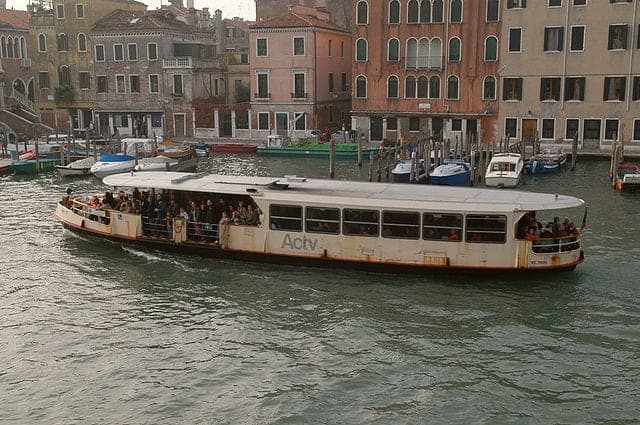
Public Vaporetto
One of the most affordable options is the Vaporetto, a public waterbus that will take you down the entire length of the canal.
This option typically takes around 35 minutes to complete the journey.
It’s also worth noting that there is actually a free audio tour you can take which covers some of the more notable sites you’ll see on a boat ride down the Grand Canal.
The stop for St. Mark’s Square is at the end of Calle Vallaresso.
Walk up this road and turn right when you reach Piazza San Marco road, which will lead you directly to the square.
TIP: If you’re interested in this option, it’s worth noting that transportation on the Vaporetto is included at no extra cost with the Venice City Pass , which also includes admission to Doge’s Palace!
Alternatively, you could also take a Gondola ride down the canal , because there's actually a very active gondola stop right at St. Mark's Square!
If you’re planning to walk and you’re coming from the west, use the Ponte dell’Accademia to reach the eastern side of Venice.
For visitors coming from the city center, the Rialto Bridge will be the easiest way to cross the Grand Canal to the east.
Anyone coming from the north likely won’t need to cross any major bridges to reach St. Mark’s Square.
TOUR OF ST. MARK'S SQUARE
We will cover important details about the most notable sites in St. Mark’s Square below.
The tour takes approximately 60 min (unless you go inside St. Mark's)
We based this route on the free audio tour from Rick Steves . Our content is unique, but we recommend listening to his well-produced tour.
You can also download his free tour wherever you get podcasts or simply download his Audio Europe app.
Choose a Destination... I want them all PLUS general travel tips. Amsterdam Berlin Boston Charleston Chicago Dubai Lisbon London Los Angeles Miami Nashville New York City New Orleans Paris Philadelphia Prague Rome San Francisco Washington DC
About The Author

Stephen Pickhardt
North america, united kingdom & ireland, middle east & india, asia & oceania.

comprehensive tourist maps for busy professionals
Essential walking map of venice.
This walking map of Venice includes all the best things to see in Venice , and more! Use this Venice walking tour map to explore top-rated tourist attractions at your own pace and preference.
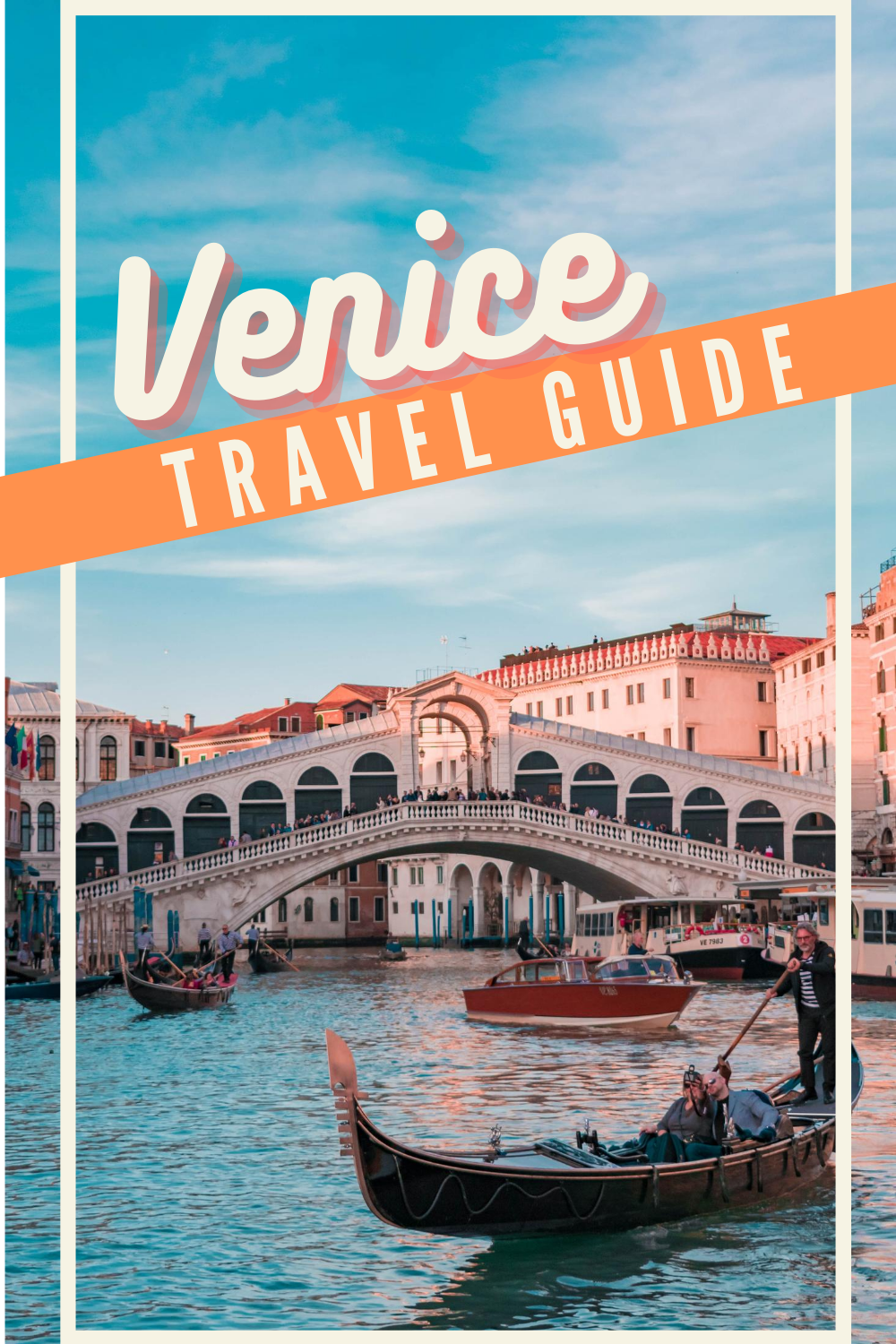
Venice is an iconic European city. It’s winding canals, quaint bridges and living history are legendary. Venice is a romantic city for couples. Many parts of Venice have been designated as UNESCO World Heritage sites .
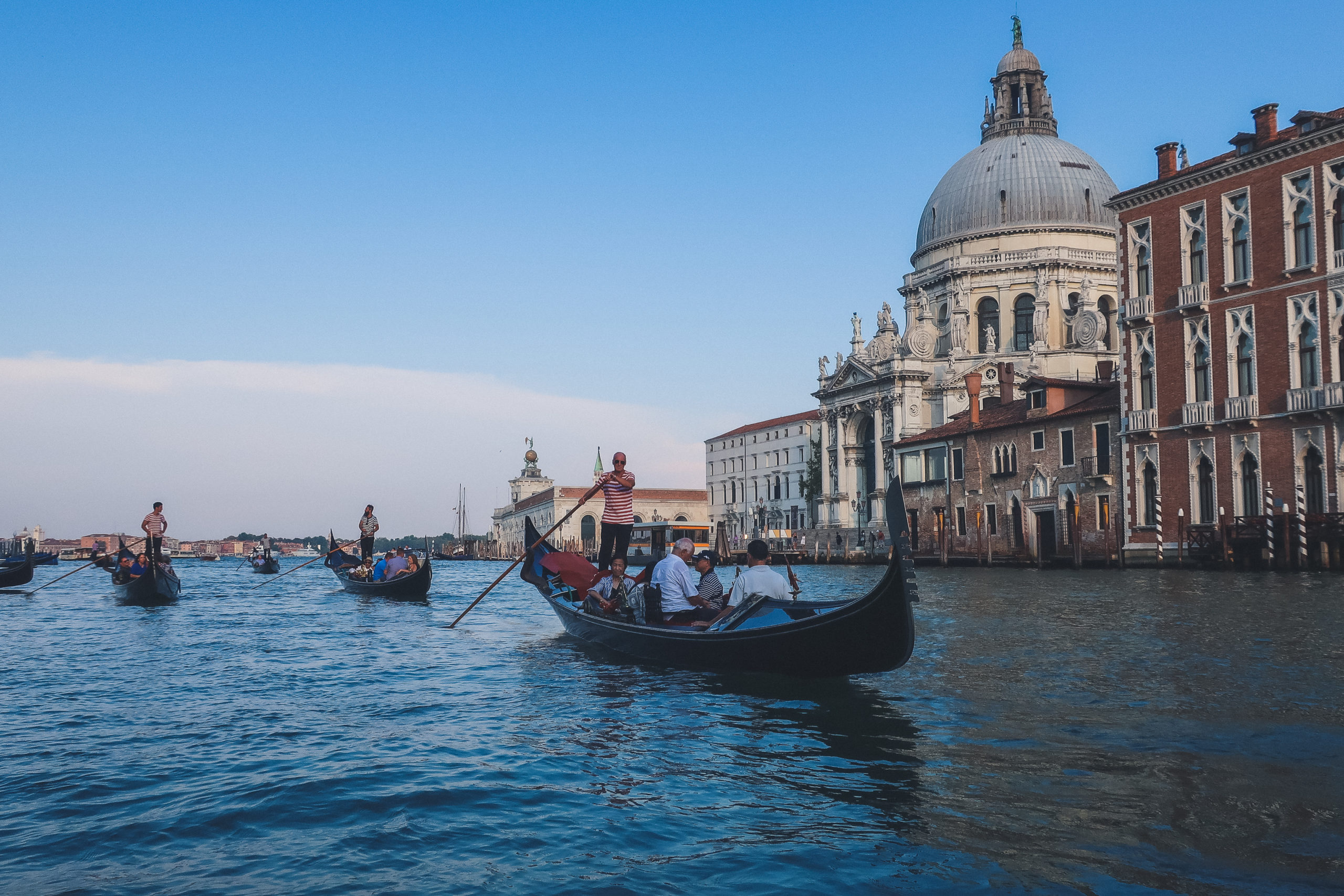
Popular activities in Venice include taking gondola rides, visiting museums, and eating freshly-caught seafood . If you are saying in Venice for 1 day or 10 days , you’ll need a walking guide…
Interactive Walking Map of Venice
Table of Contents
Rialto Bridge
Grand canal , bridge of sighs, saint mark’s square, scala contarini del bovolo, burano & murano, doge’s palace, correr museum, gallerie dell’accademia, peggy guggenheim collection, ca’rezzonico, saint mark’s basilica & clocktower, church of san zaccaria, church of saint julian, basilica san maria della salute.
This Venice Map is interactive, adjustable, and available for offline use . There are many ways you can use this walking map of Venice.
There are a few layers to this Venice Tourist Map. The best things to do in Venice are marked by blue pins. That includes famous landmarks, museums, and churches (in Italy, churches are museums).
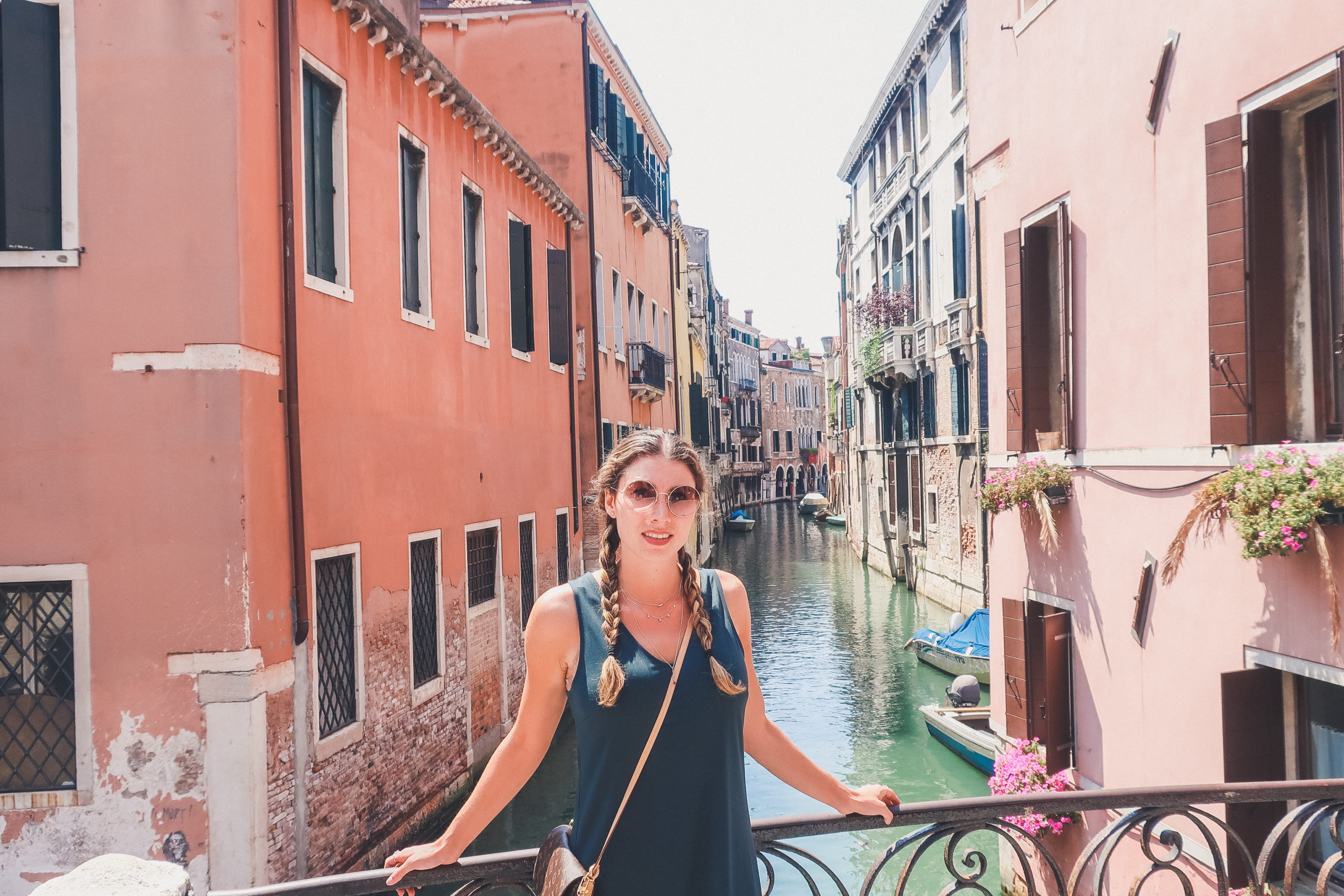
This interactive map of Venice also includes recommended restaurants . You’ll find those are marked with a green knife & fork icon. G elaterie can be identified by the pink ice cream icon. You can even find rooftop bars in this Venice attractions map! Those are indicated by purple drink icons.
How to Use This Map: If you click the tab at the top left corner, you’ll be able to select specific layers. Click the checkmark to select or hide specific categories.
Save This Map: Click the brackets in the top right corner to expand the map in full view. It will open in a new tab. Under the map title, right of the map description, there is a star. Click this star and the map will be saved to your Google account in Google Maps. You can access it later from your computer or device. On desktop, go to Google Maps and click ‘Your Places,’ and ‘Maps.’ On app view, select ‘Saved, scroll down and click ‘Maps.’
Walking Map of Venice
This map of Venice Italy includes a lot of paid attractions. Venice isn’t a cheap destination! Although, if you choose not to enter inside any of the museums or churches, you can use this walking map of Venice Italy to enjoy a completely free experience!
If you’re visiting with a special someone, make sure to check out our Venice guide for couples .
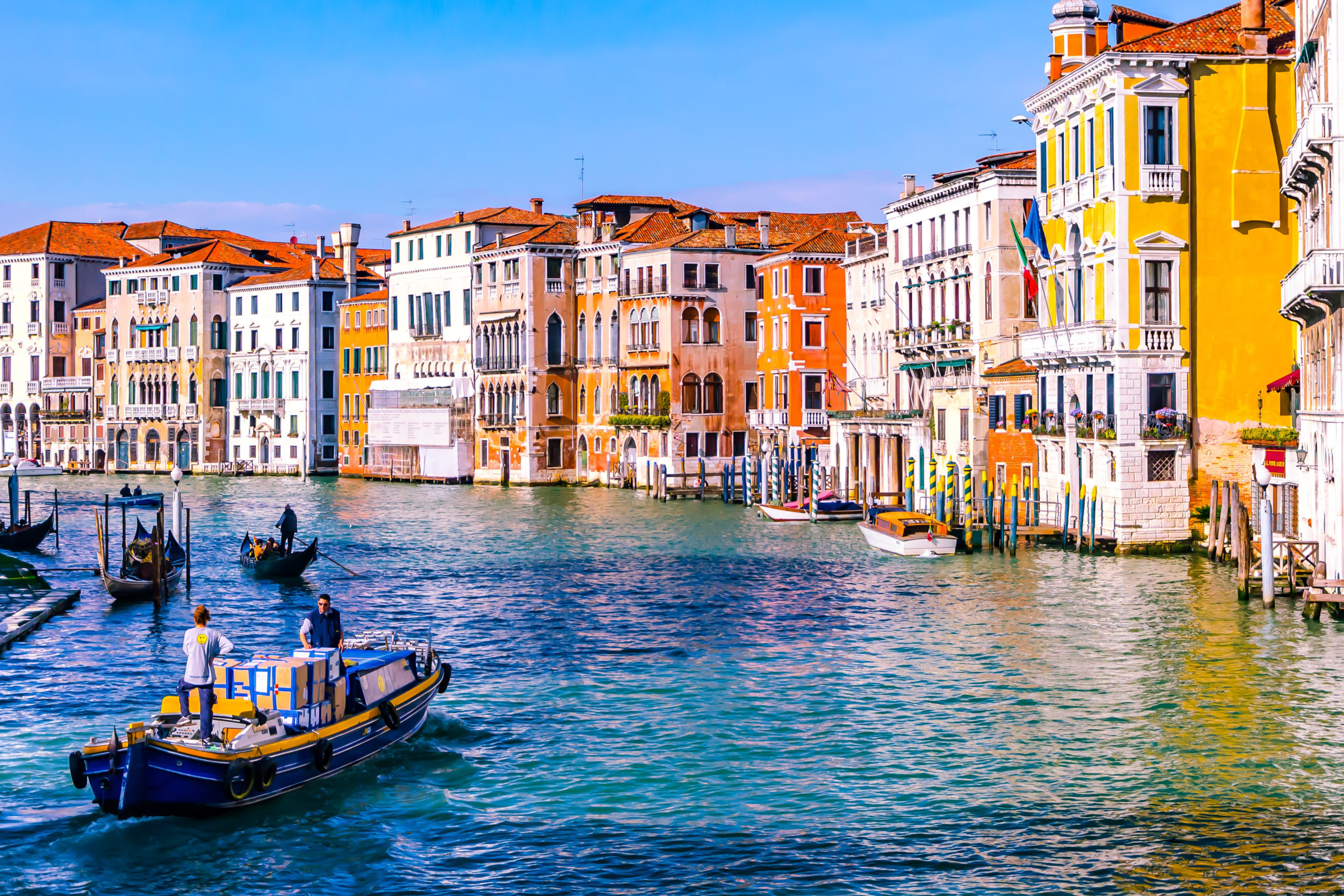
Famous Landmarks
This free Venice walking tour map includes all the famous landmarks you won’t want to miss. Including some famous bridges. Venice is known for its bridges — there are over 400 of them after all! Under those bridges, some 300 gondolas roam about among the winding canals.
Enjoying the waterways and bridges is one of the best free things to do in Venice Italy. Make sure to hit these famous landmarks when you use this Venice self-guided walking tour map!
The Rialto Bridge is one of the Venice main attractions. It is one of four bridges on our sightseeing map of Venice that spans the famous Grand Canal. This is the heart of Venice.
Walking across the Rialto Bridge is one of the best free things to do in Venice. It’s an incredible piece of history — built over 400 years ago! The Rialto Bridge is the oldest bridge to span the Grand Canal.
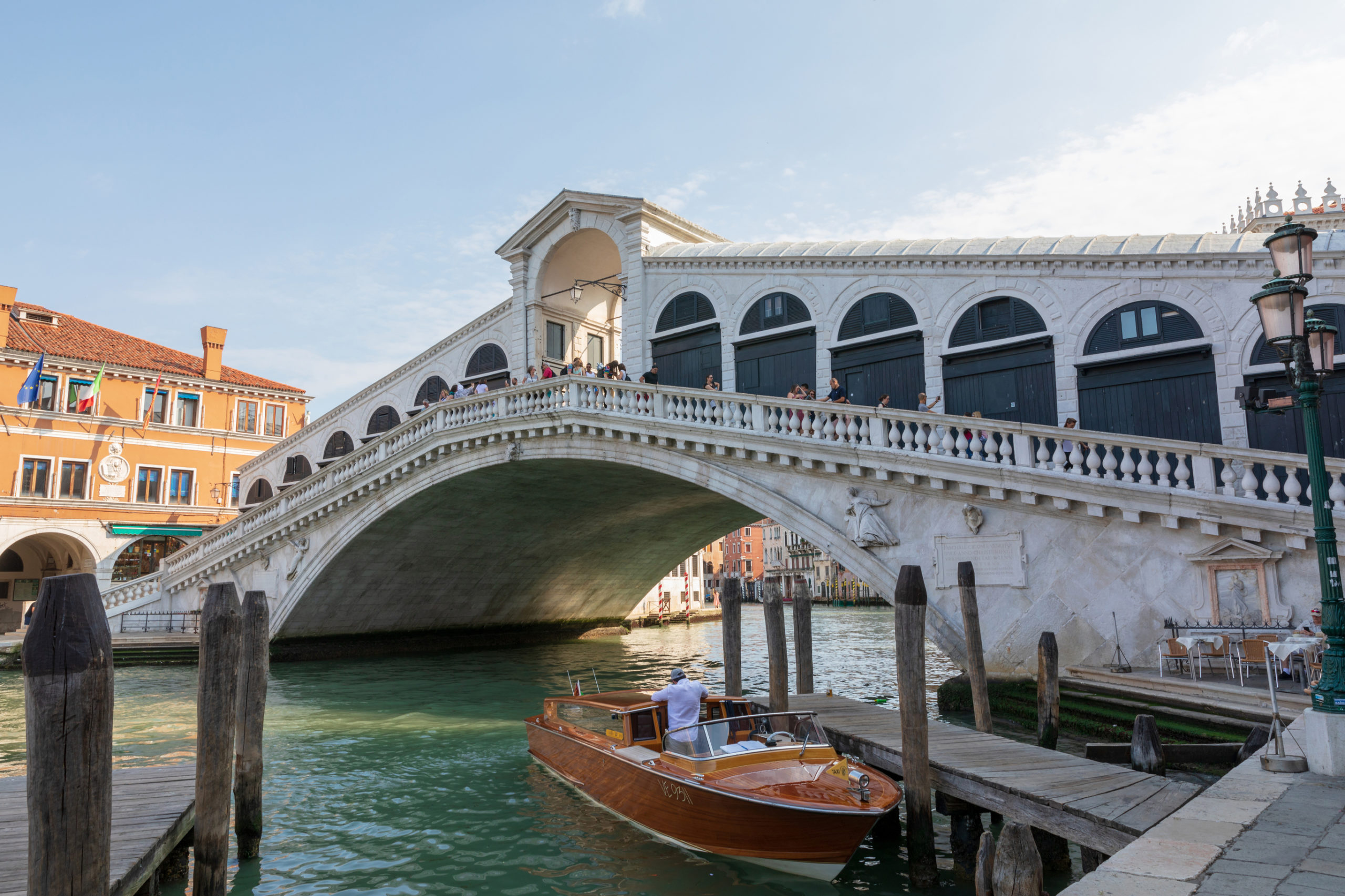
In the present day, it’s usually very busy with tourists. There are many interesting shops on either side. It’s a densely packed, high-traffic area . The real estate surrounding this bridge is some of the most pricey in all of Venice!
If you’re walking in Venice Italy, you can’t skip the Rialto Bridge. Nearby, you can get authentic gelato at Grom or La Boutique Del Gelato . Great places to eat nearby are Baci & Pasta and Osteria alle Testiere .
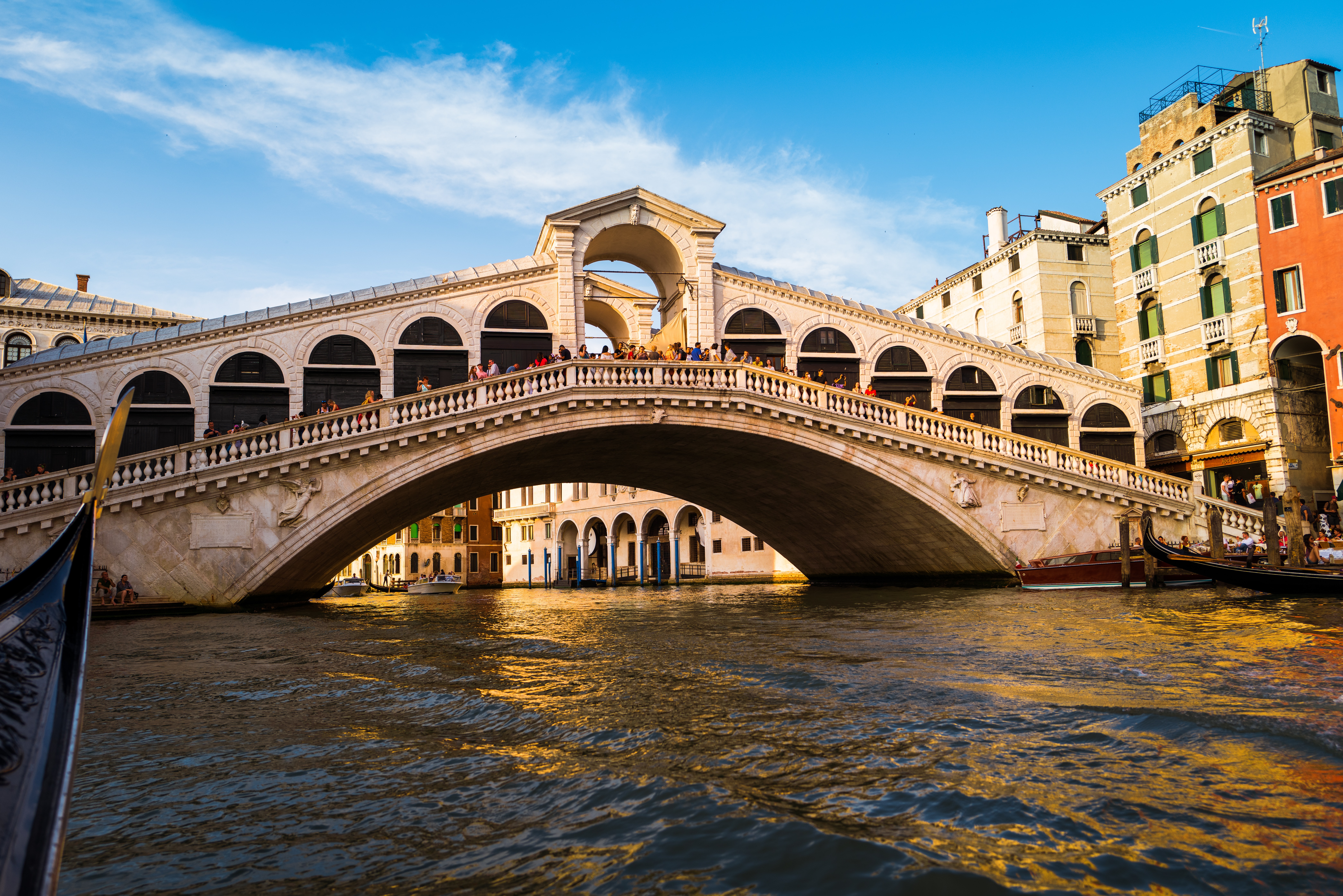
Baci & Pasta is another great joint near the Rialto Bridge that you’ll find on this tourist map of Venice. It’s a casual, budget, option. Osteria alle Testiere is a formal dining restaurant nearby serving authentic Venetian fare.
Experience Venice through food.
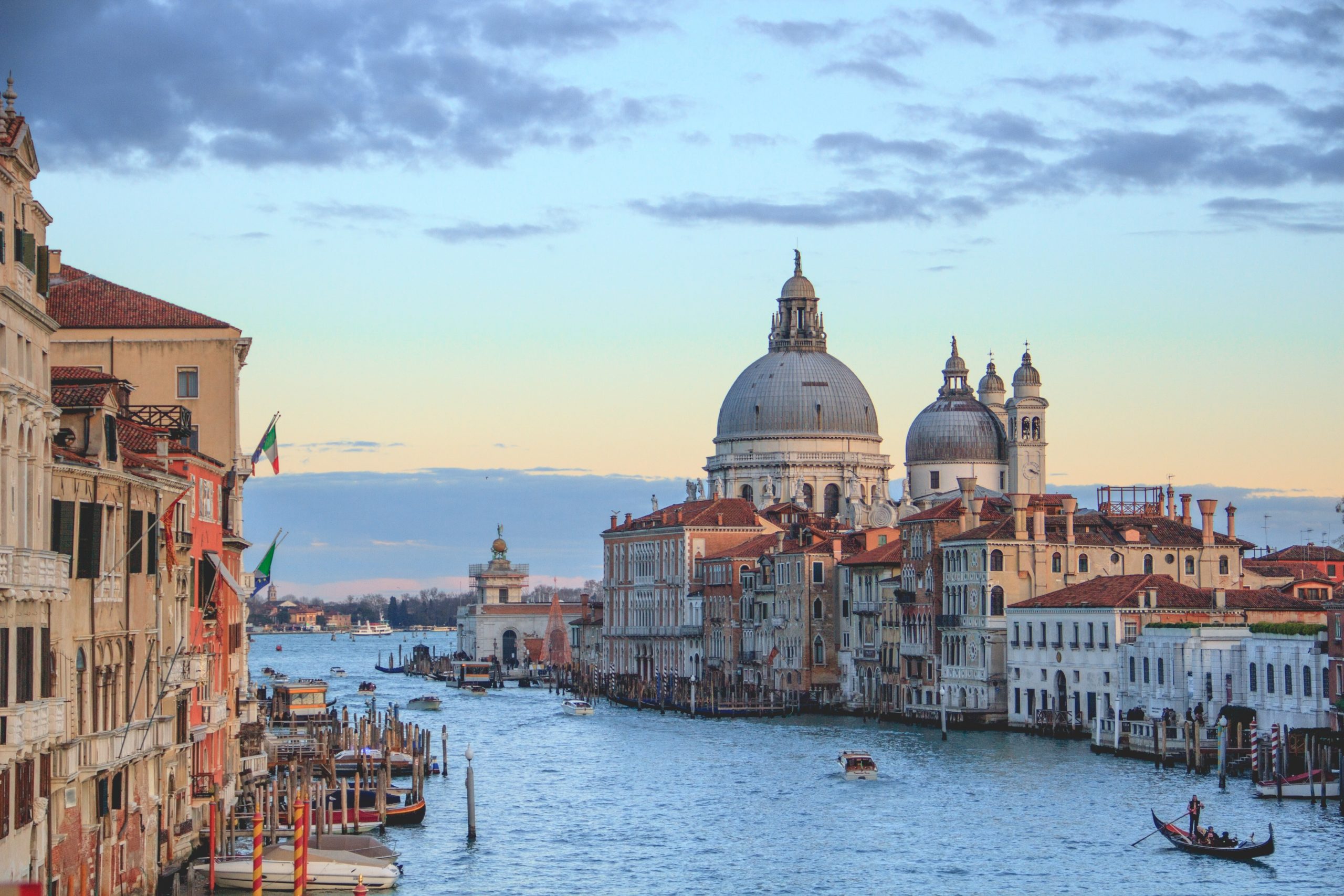
Take a tour of the legendary Grand Canal.
Along the Grand Canal, you can find buildings in Venitian Gothic, Venitian Baroque, and Venitian Byzantine. Hundreds of years ago, the wealthiest and most prestigious families built homes along the Grand Canal. Many of the top sights in Venice today are still lining the Grand Canal.
The Grand Canal isn’t exactly Venice off the beaten path… it’s pretty touristy! Although, it’s an important part of the city and one of the must-do things in Venice.
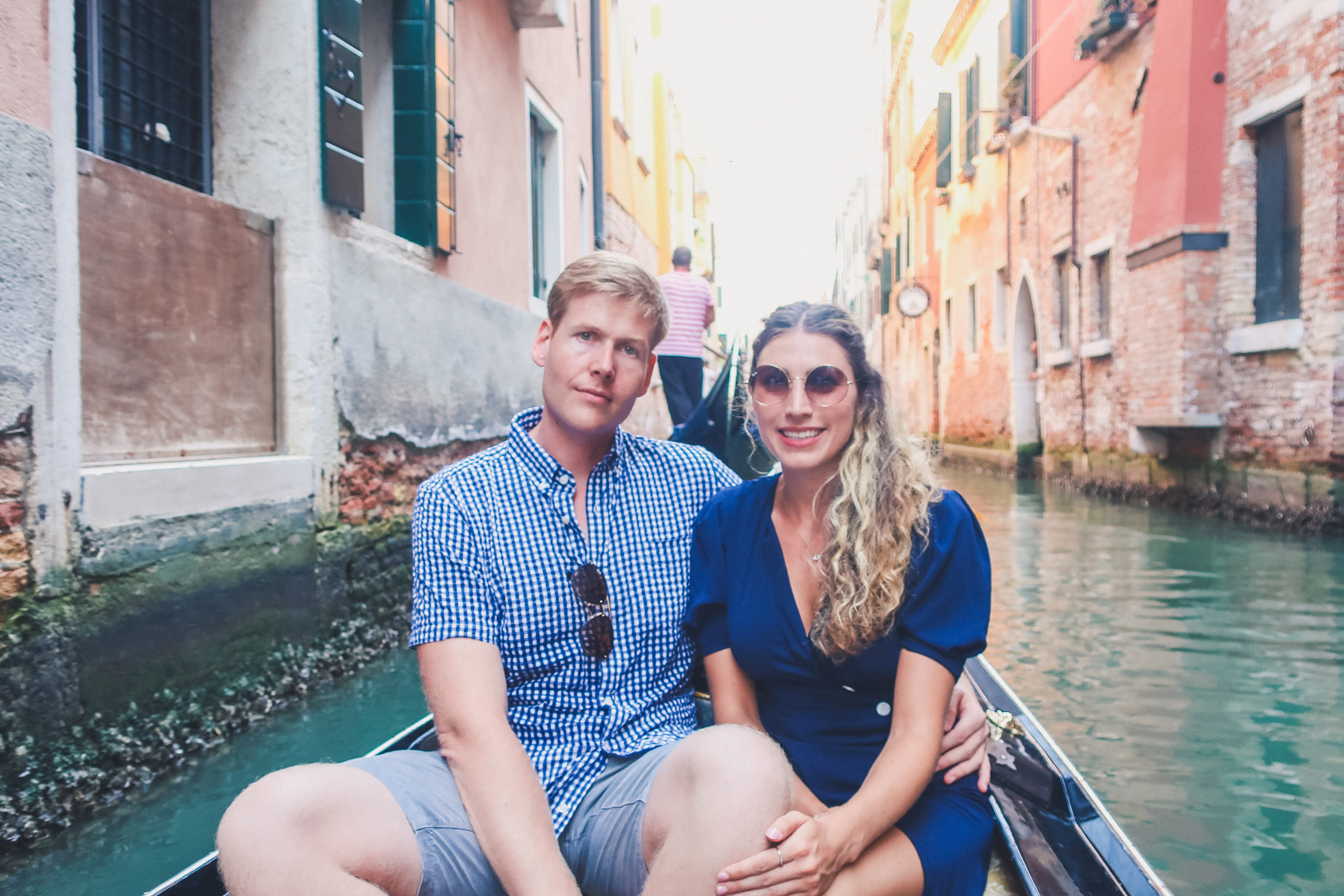
Book your gondola ride today.
A gondola ride through the Grand Canal is one of the must-do things in Venice. There are many gondola operators in this area. A gondola ride is the best way to experience the Grand Canal and it’s one of the most romantic experiences in the city!
If you want romance on a budget, visiting the Grand Canal is one of the best free things to do in Venice at night. You can watch the sunset over the city from the top of this historic bridge. Couples may also consider a romantic photo shoot in Venice.
The Bridge of Sighs is another one of the popular places to visit in Venice. You can’t walk along the Bridge of Sighs, you can only see it!
The best place to view the Bridge of Sighs is from the Bridge of Paglia ( Ponte della Paglia ). The Bridge of Sighs is one of the famous Venice attractions. Its purpose was to link Doge’s Palace with a prison. Legend has it that prisoners would sigh on this bridge as they got their final glimpse of beautiful Venezia .
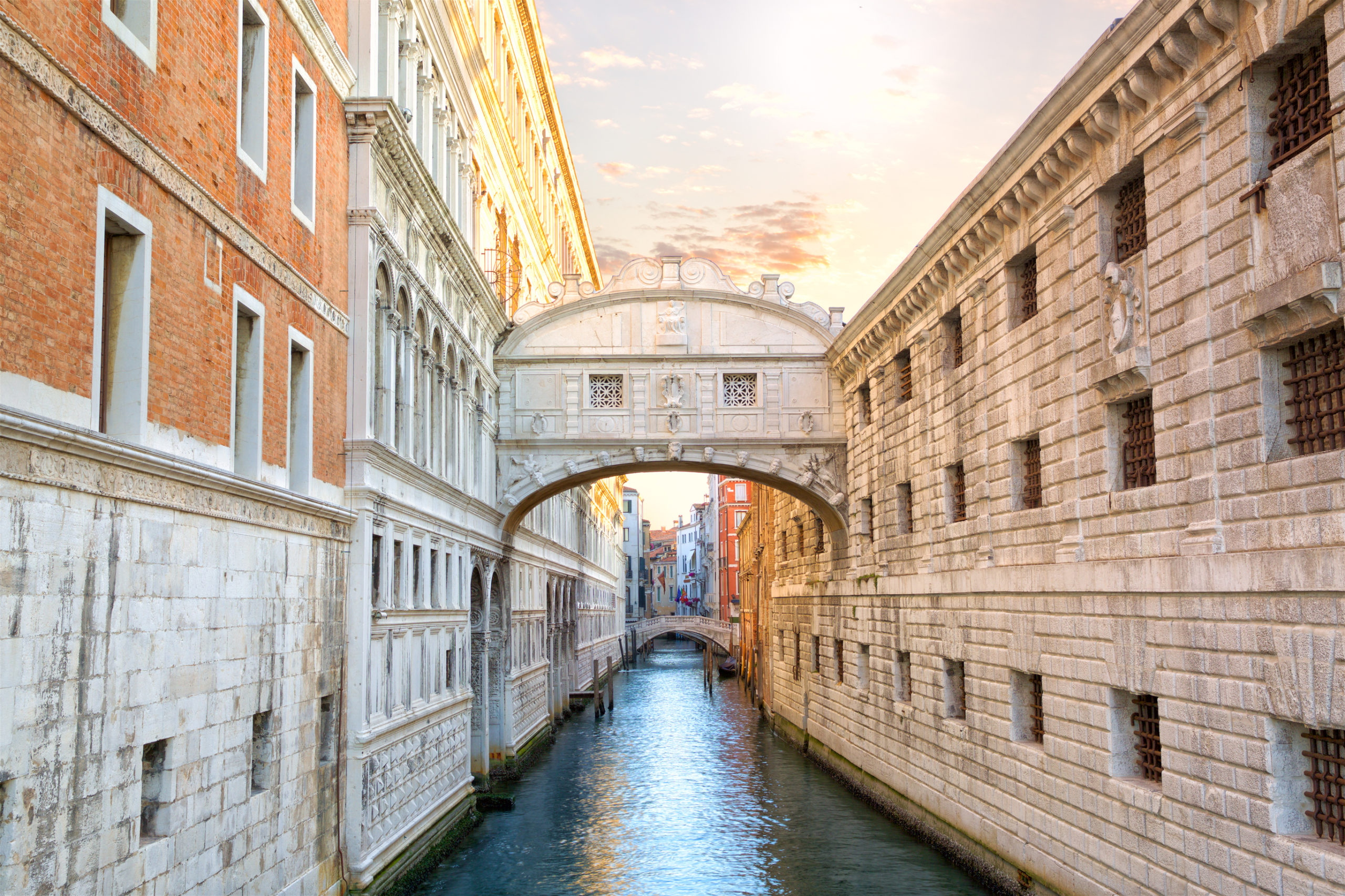
The Bridge of Signs is an enclosed in white limestone . It has windows with stone bars through them. The designer of this bridge was the nephew of the man who designed the Rialto Bridge –adding fame to these Venice tourist attractions.
In reality, not many big-time criminals passed through this bridge. By the time it was built, inquisitions and executions weren’t happening anyone. Also, it wasn’t possible to see much through the tiny barred windows.
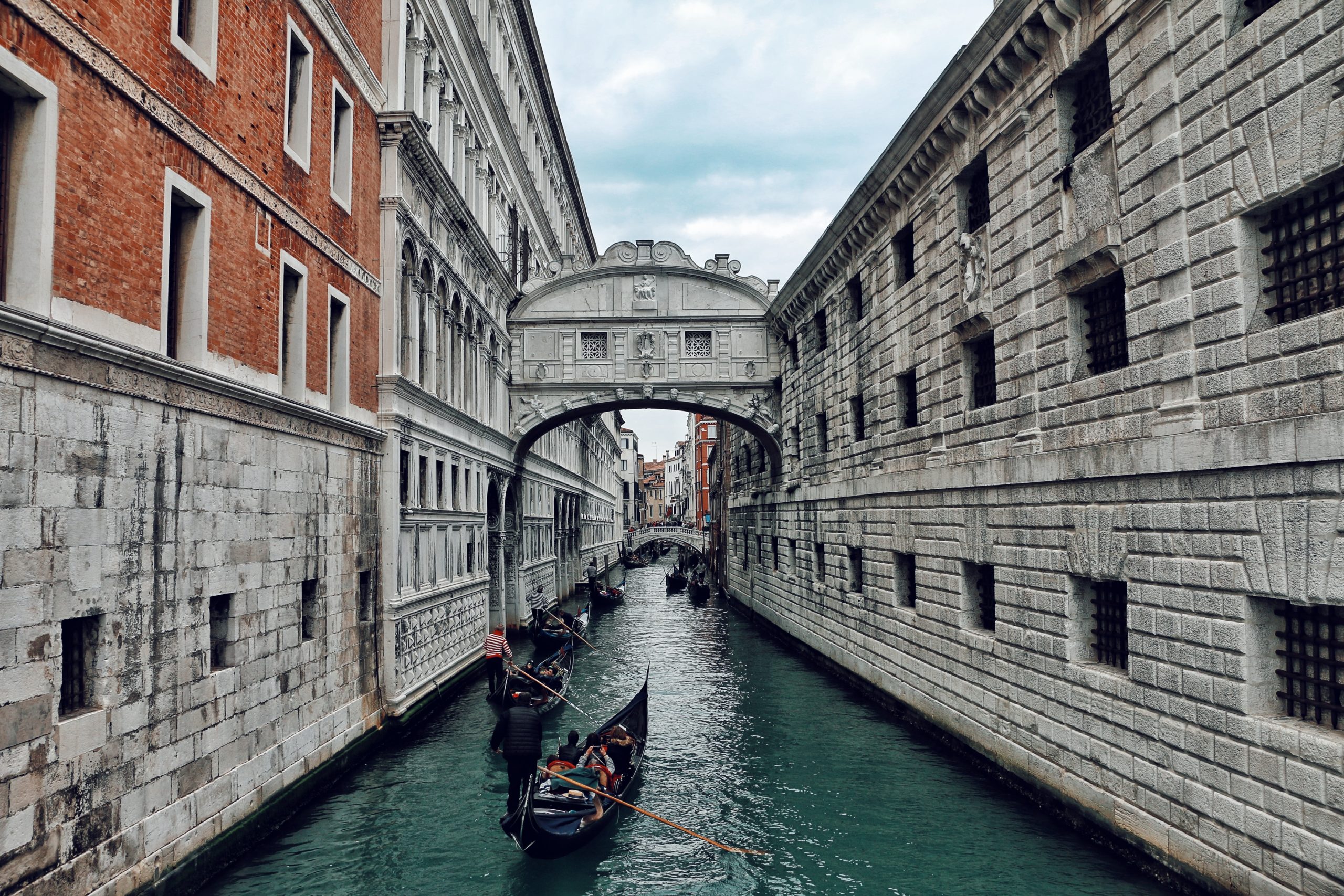
Although, it’s still a beautiful spot and visiting this bridge is one of the top things to do in Venice. Another reason that this is one of the best things to do in Venice is that it’s completely free to visit!
Saint Mark’s Square is one of the best places for Venice sightseeing. This is where everyone in Venice comes to see and be seen. It may be the largest and most important square in Venice, but it’s also considered one of the most famous squares in the world.
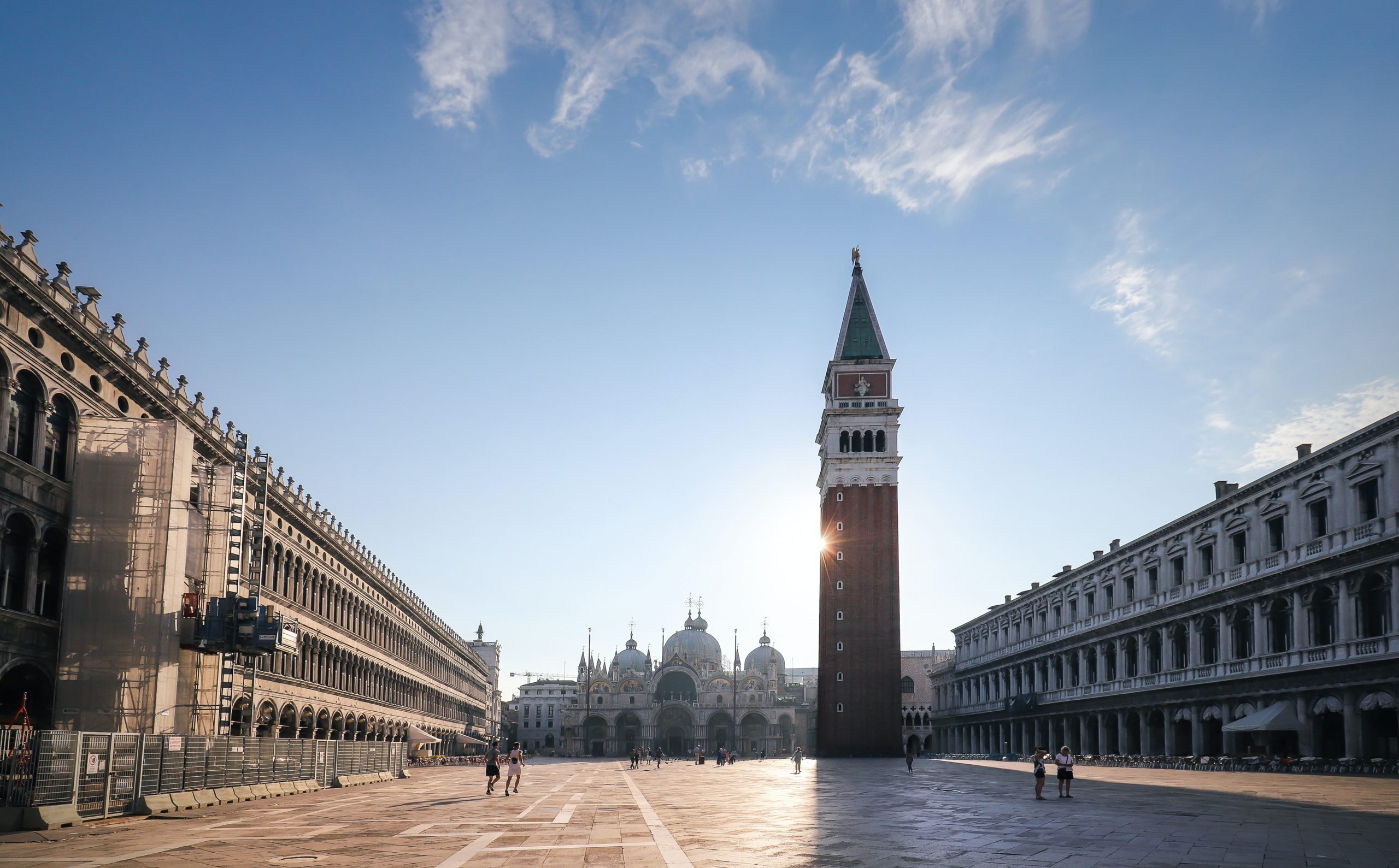
St. Marks Square offers the best views of St. Mark’s Basilica and campanile. This is a common stop on any Venice itinerary and a meeting place for many tour groups. Doge’s Palace and Museum can also be accessed from Saint Mark’s Square. Visiting Doge’s Palace is another one of the activities you must do in Venice.
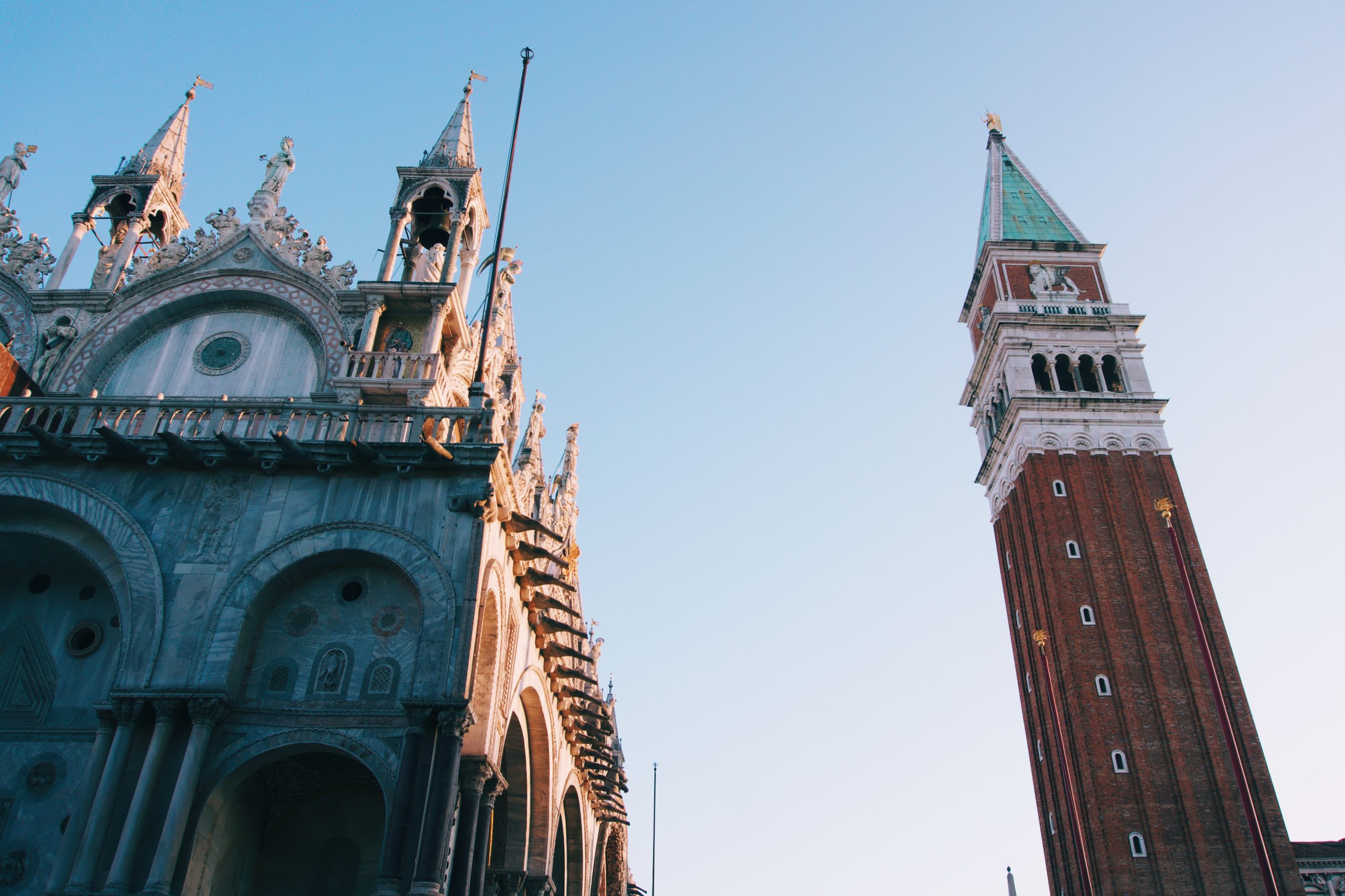
Explore the legendary St. Mark’s Basilica.
St. Mark’s Square is a must see in Venice! The square’s history dates all the way back to the 9th Century. This is a lively and busy part of the city. Stopping by for espresso and dessert at the nearby Caffè Florian is one of the recommended things to do in Venice at night. It’s considered the oldest cafe in Europe!
The Scala Contarini del Bovolo —roughly, “ staircase of the snail ” is one of the best places to visit in Venice. It’s a photographer’s dream! As you climb the staircase, you’ll notice the staircase’s unique design . It has features from a few different architectural styles.
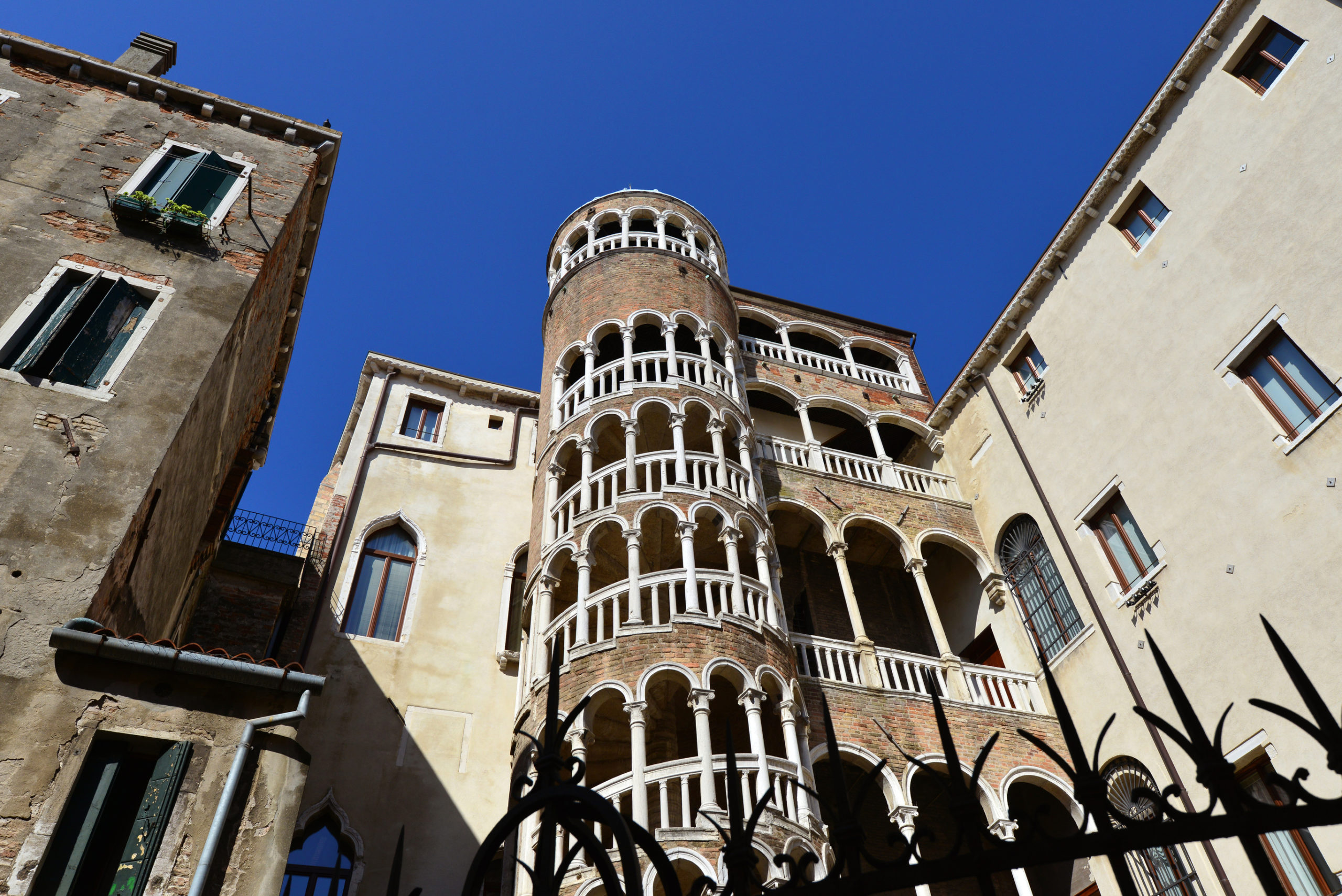
The staircase ascends into a tower. Once at the top, you’ll find amazing views of Venetian rooftops. This is one of the most amazing things to see in Venice Italy.
This staircase was originally built in the 15th Century . Entering does require a small fee, or you may choose to visit with an organized tour. No matter how you choose to visit, this is one of the top things to see in Venice for first-timers.
Burano and Murano are Venitan islands on our downloadable map of Venice that aren’t connected by a bridge. Visiting these other islands by boat is one of the adventurous things to do in Venice.
Each island has a unique vibe and atmosphere. Burano is known for its distinct, brightly painted houses. It’s very magical looking. Lacemaking and fishing are the common trades on Burano. You can shop around for handcrafted goods.
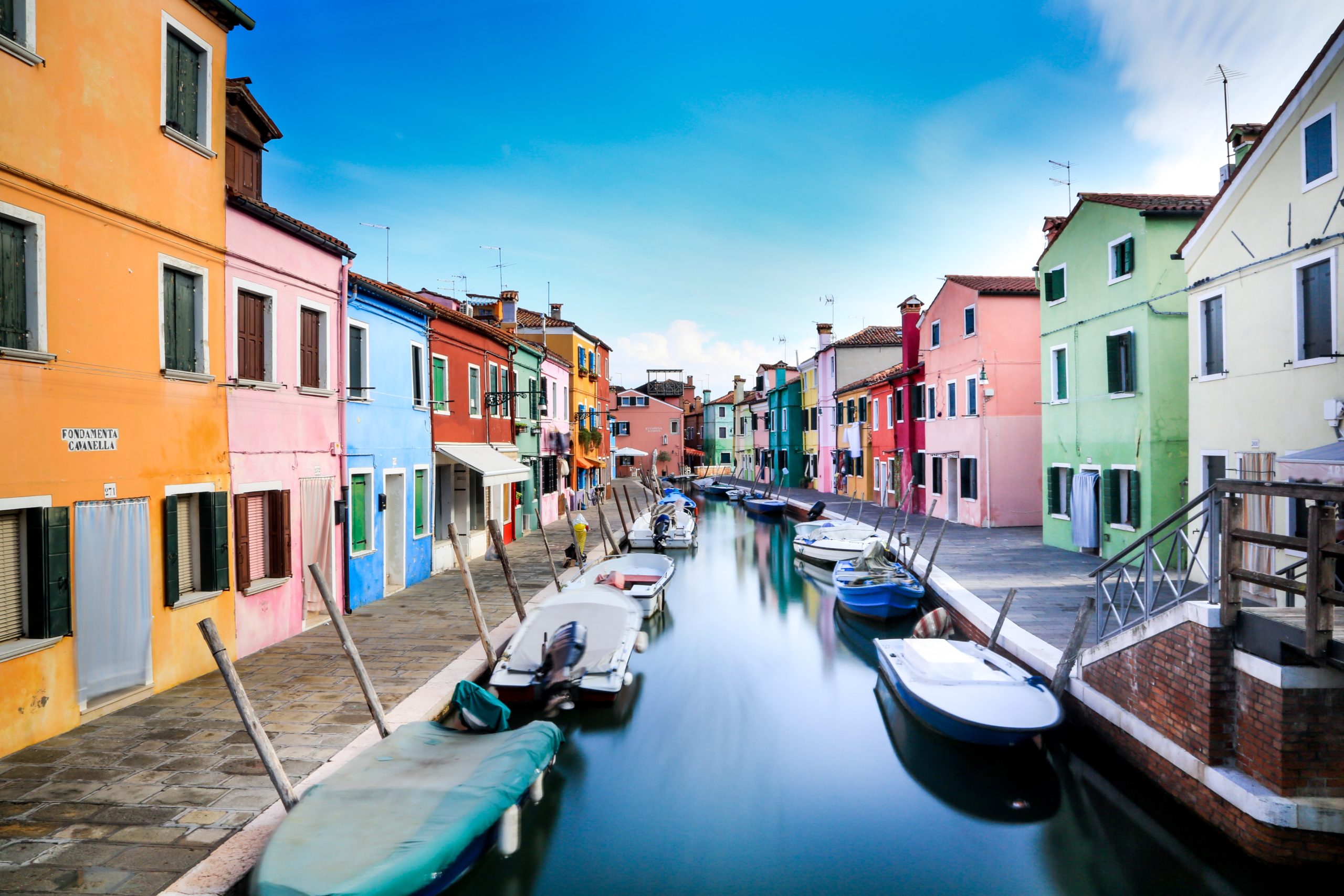
Find out how you can visit Burano & Murano.
The Lace Museum in Burano is one of the famous places to visit near Venice.
Murano island is another one of the Venice top attractions. Murano is well-known for glassmaking. Glass has been made on Venitian islands for over 1,000 years! If you are lucky enough to visit Murano with a guided tour, you’ll likely get to witness the glassmaking process. Make your own glass in Murano.
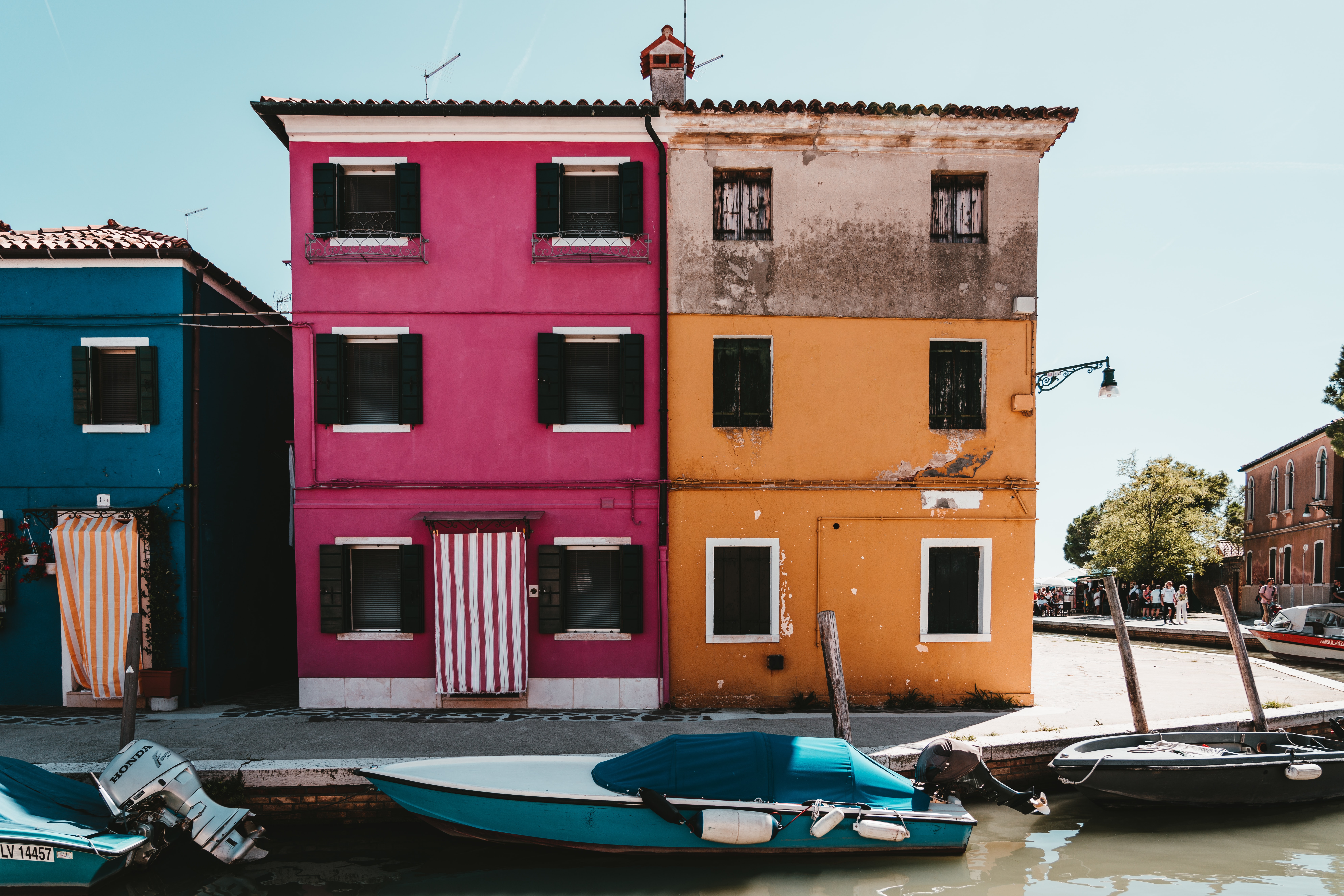
Sign up for an unforgettable glass-making workshop in Murano.
These islands are some of the less touristy places to visit in Venice Italy.
While you enjoy a Venice walking tour, you’ll have to stop at some of the legendary museums. Venice is highly regarded for the art collections and history you can find.
Some of the popular spots on our free map of Venice include Doge’s Palace, the Gallery of the Academy, the Peggy Guggenheim Collection, and the Museum Correr. We will discuss these main highlights.
If you’d rather do art than see art, check out this painting class in Venice.
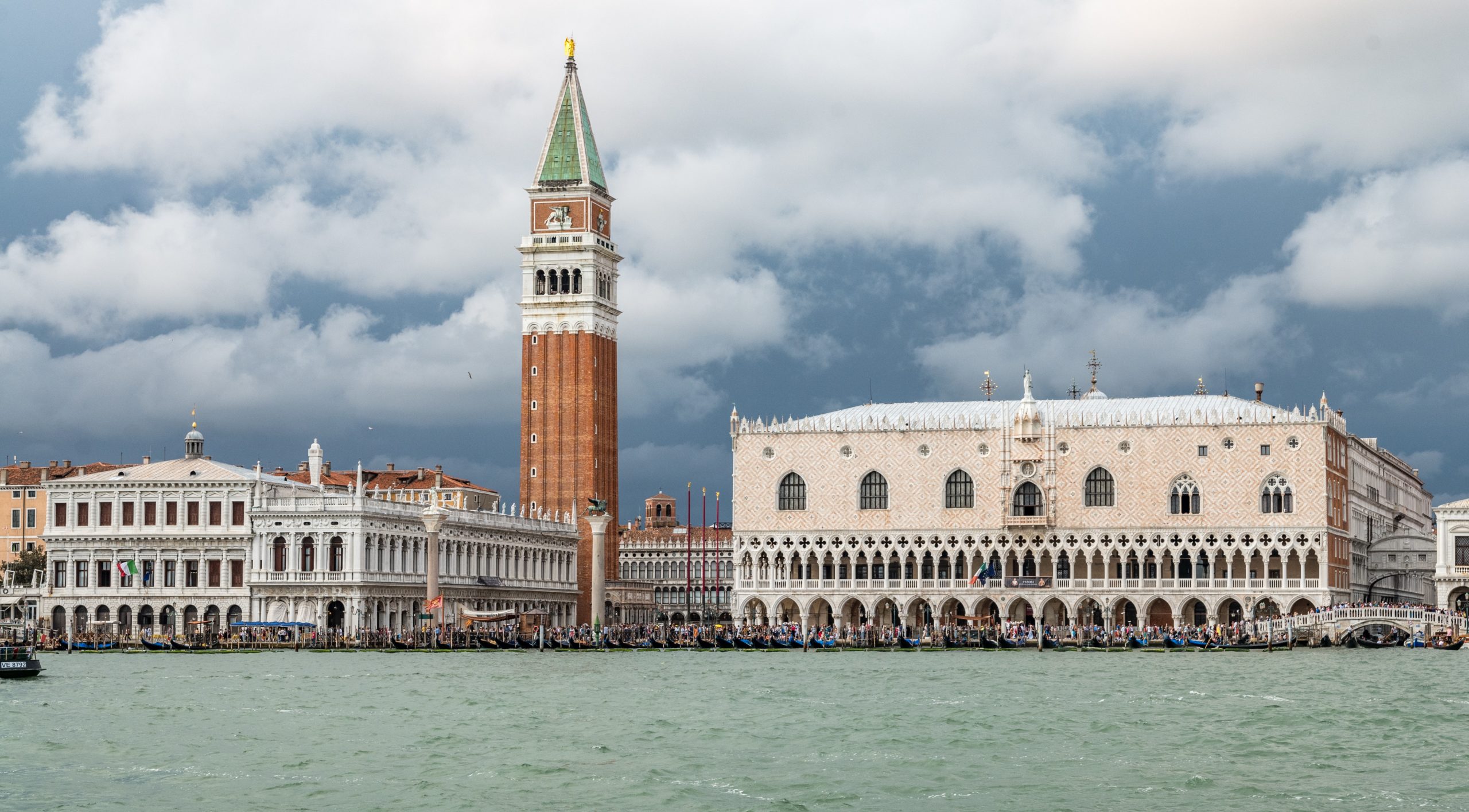
Other museums you can find on the map of Venice with attractions include a music museum at the San Maurizio Church and the Museum of Glass. This Venice walking guide also includes numerous churches (that might as well be museums) because they contain priceless art and artifacts.
Doge’s Palace is one of the top sites in Venice Italy. Doge’s facade is an excellent example of Venetian Gothic architecture . The palace was destroyed, rebuilt, and restored several times since its original construction in the 9th Century by Doge Agnello Participazio.
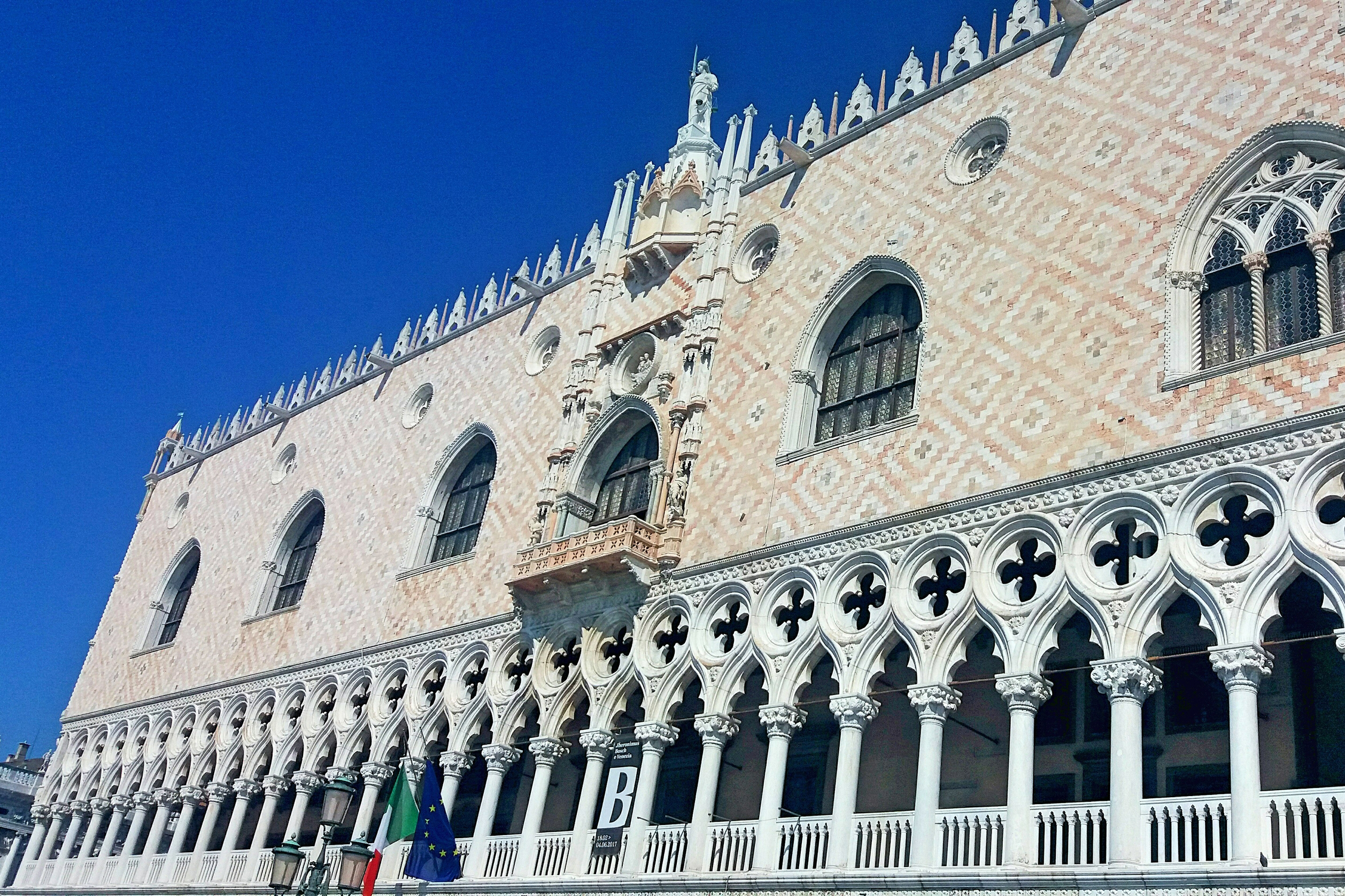
In the 17th Century, the palace served as the seat of g overnment, the city’s courtrooms, and a jail. It was an important base of power for the Venitian Republic. One of the important things to know about Venice is that Venice was an independent republic for over 1,000 years!
Doge’s Palace is impeccably lavish. Including gilded ceilings, frescoed walls, and grand staircases . Visiting the Doge’s apartments and prison cells is one of the things you must do in Venice.
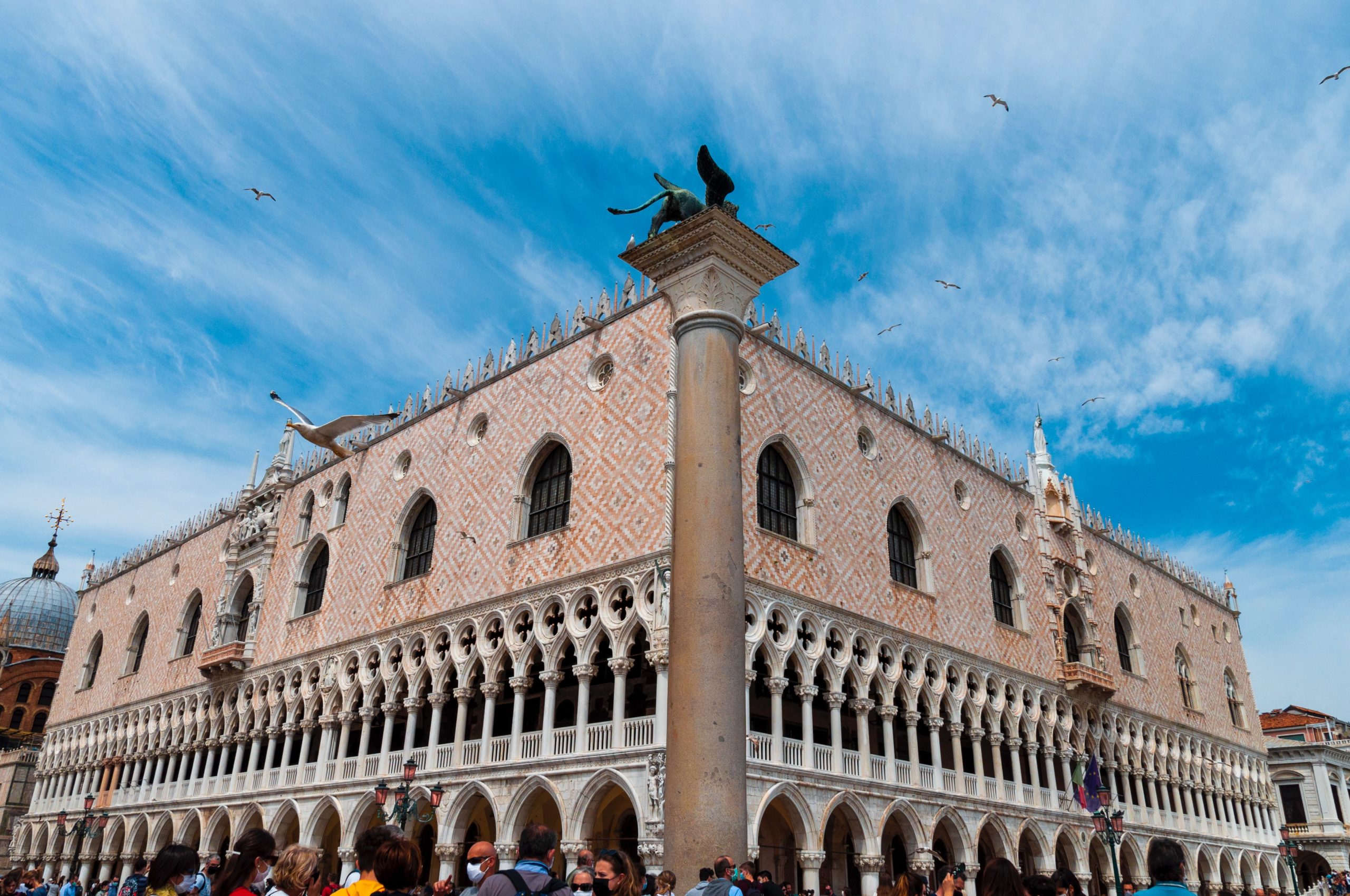
Check out this top-rated tour of Doge’s Palace.
Doge’s is an important landmark and one of the best places in Venice Italy for art lovers. There are many admirable paintings and sculptures to explore. The building itself is an artistic marvel. It’s a must-visit in Venice!
The Correr Museum is one of the most interesting places in Venice. It’s highly regarded Napoleonic Wing dates back to the early 19th Century. During this time, Napoleon held power and Venice remained part of the Kingdom of Italy.
This museum is also located in the bustling St. Mark’s Square. It’s one of the most popular places in Venice. Guests can explore neoclassical residences of Kings and emperors.
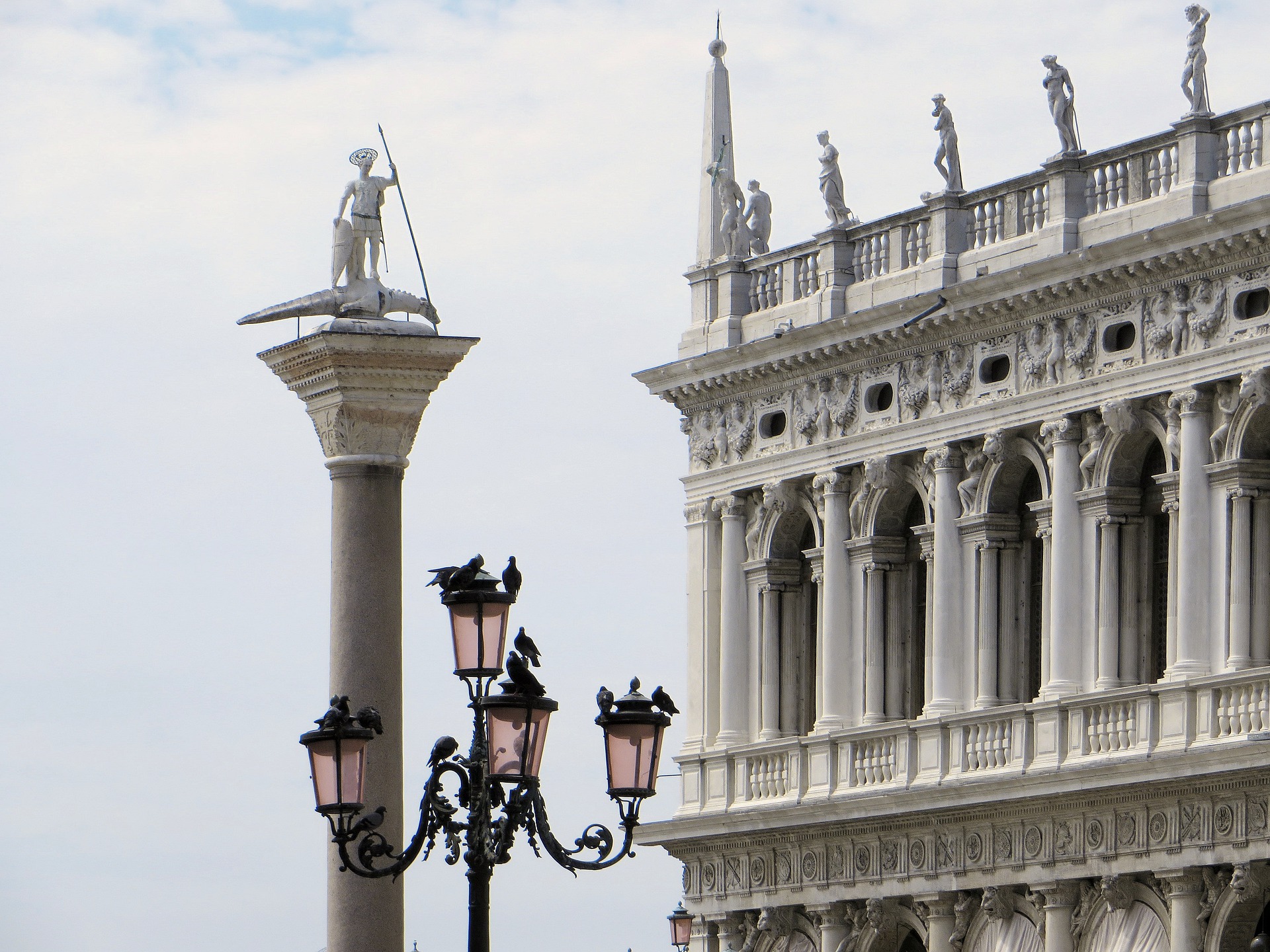
This is one of the Venice main attractions because you’ll find unimaginable treasures . The Correr Museum displays paintings, sculptures, furniture, instruments, and much more!
Cross the Bridge of the Academy and you’ll be in front of the Gallery of the Academy . This bridge is less crowded and maybe a good place to take a traditional canal side photo. It’s one of the places of interest in Venice for art and history lovers.
The Gallery of the Academy is one of the top sites in Venice because it has an impressive collection of 19th Century art. The root institution behind this museum was one of the first to adopt art restoration practices in the 18th Century.
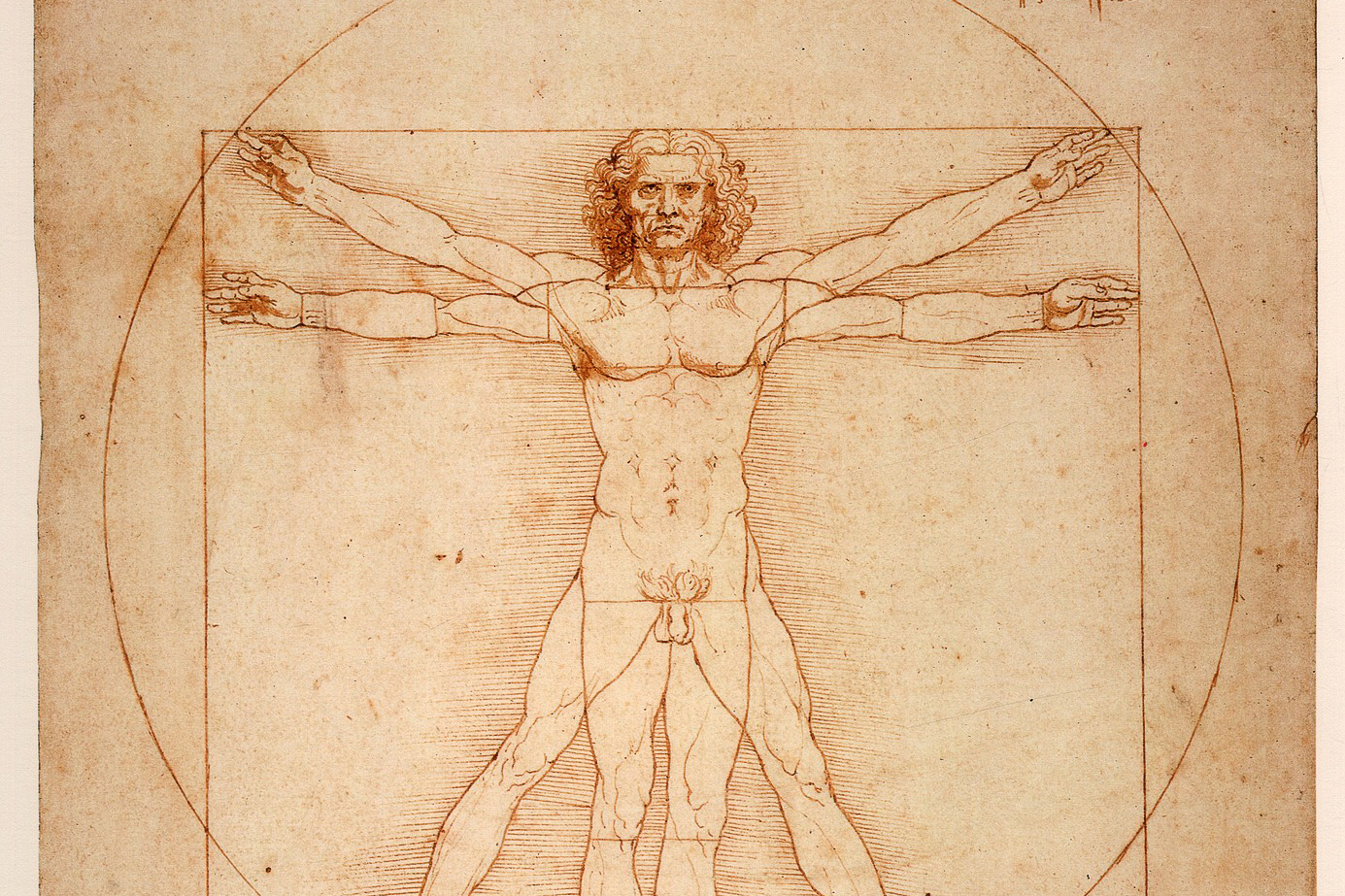
You can find many masterpieces in the Gallery of the Academy of Venice. The collection includes Leonardo da Vinci’s drawing of the Vitruvian Man which is occasionally displayed. This is one of the best sights in Venice.
Let’s not forget that dining and drinking are also some of the best activities in Venice Italy. Near to the Gallery of the Academy are a few great dining opportunities. Cantine del Vino già Schiavi is a wine bar off the beaten path. Osteria Al Squero is a local favorite known for authentic bites in a modest setting. Then, stop by Gelateria Nico for dessert.
The Peggy Guggenheim Collection is one of the most important 20th Century art museums in Italy. Visiting this place to appreciate American and European art is one of the fun things to do in Venice.
The modern art of the Peggy Guggenheim Collection is housed in an opulent 18th Century palace . Peggy Guggenheim lived in this palace for over 30 years. It’s one of the best things to see in Venice!
Peggy Guggenheim was an American heiress and socialite . She later became a prestigious art collector and traveler. Interestingly, her father died during the sinking of the Titanic.
Peggy Guggenheim loved Venice and established her most famous museum there along the Grand Canal. Viewing examples of surrealism, cubism and abstract expressionism at the Peggy Guggenheim Museum is one of the top things to do in Venice Italy. It’s also one of the romantic things to do in Venice for couples.
Surprise, Surprise…another museum inside a waterfront palace. The Ca’Rezzonico Museum was built in the 17th Century for a noble Venitian family . This is one of the most visited Venice tourist spots.
Interestingly, the family that originally commissioned this palace ran out of money before its completion . Also, the architect who designed it perished before it could be complete. The palace was finally completed over 100 years after the project was initially started !
The facade of the museum is a notable example of Venetian baroque and rococo architecture. Even if you decide not to stop inside, viewing the facade of this glorious building is one of the cool things to do in Venice. This is one of the best places to go in Venice for architecture lovers.
Inside the museum, you’ll find plenty of works by Venetian painters of the 18th Century. It’s a living time capsule into the 18th Century . There’s seemingly endless frescoes, sculptures, carved figurines, and other impeccable accents and artifacts.
Ca’Rezzonico Museum is one of the best museums & top places to visit in Venice.
While you’re walking in Venice, you may notice many churches. We’ve included several churches in this tourist map of Venice Italy because churches are essentially museums.
Quick Note About Churches: You don’t have to be Catholic, or even religious, to appreciate the history, culture, and architecture of Roman Catholic churches. While you should be respectful while inside, churches in Venice are open to visitors of all faiths and backgrounds.
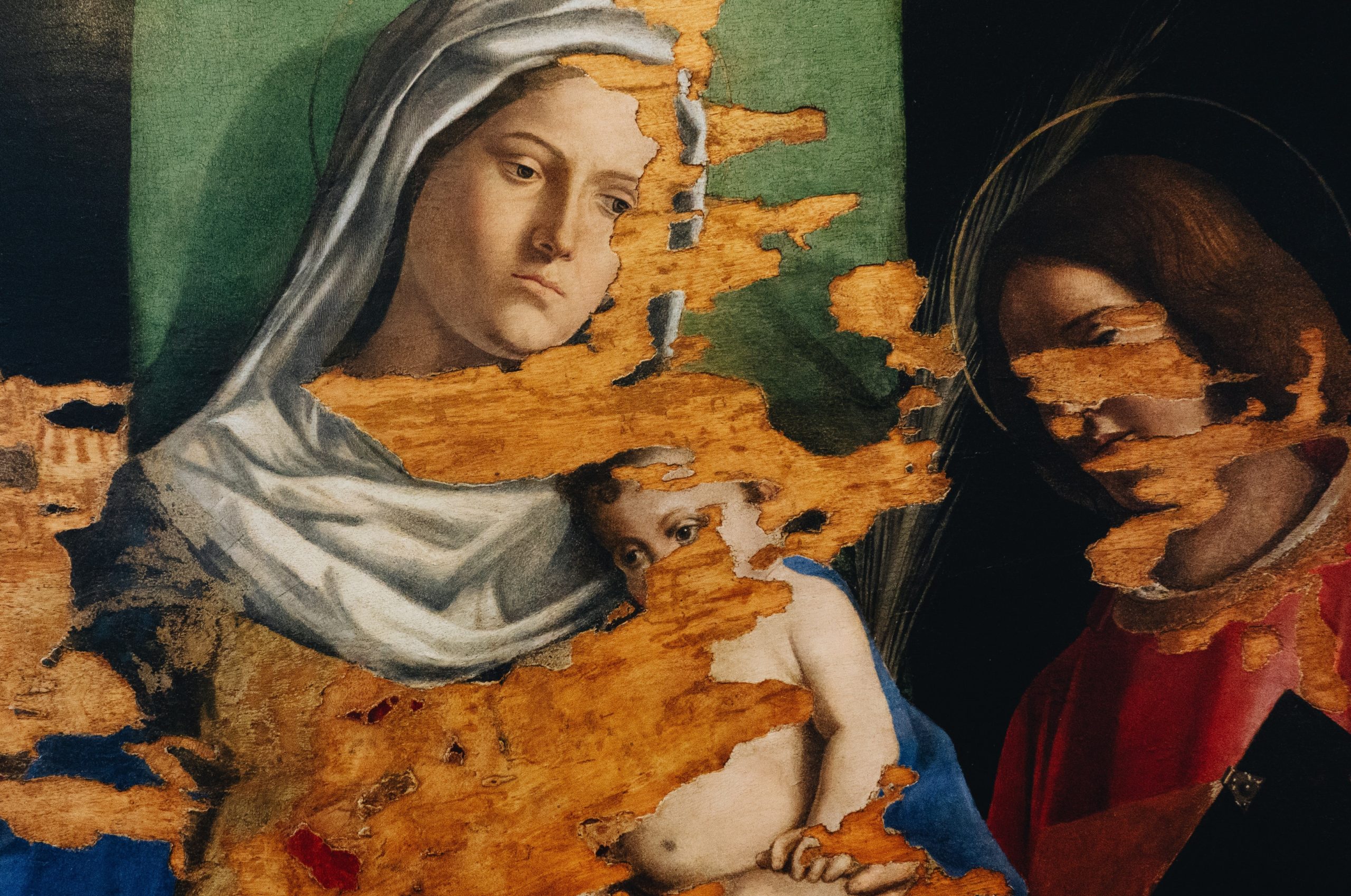
So, while you’re walking around Venice, stop inside a church or two. While they are treasure troves of art and history, admission into churches is much cheaper than that to museums.
Gaining entry allows you access to beautiful frescos, elaborate tombs, and unique stories . Although, entry is by no means necessary. Seeing these churches from the outside is worth your time.
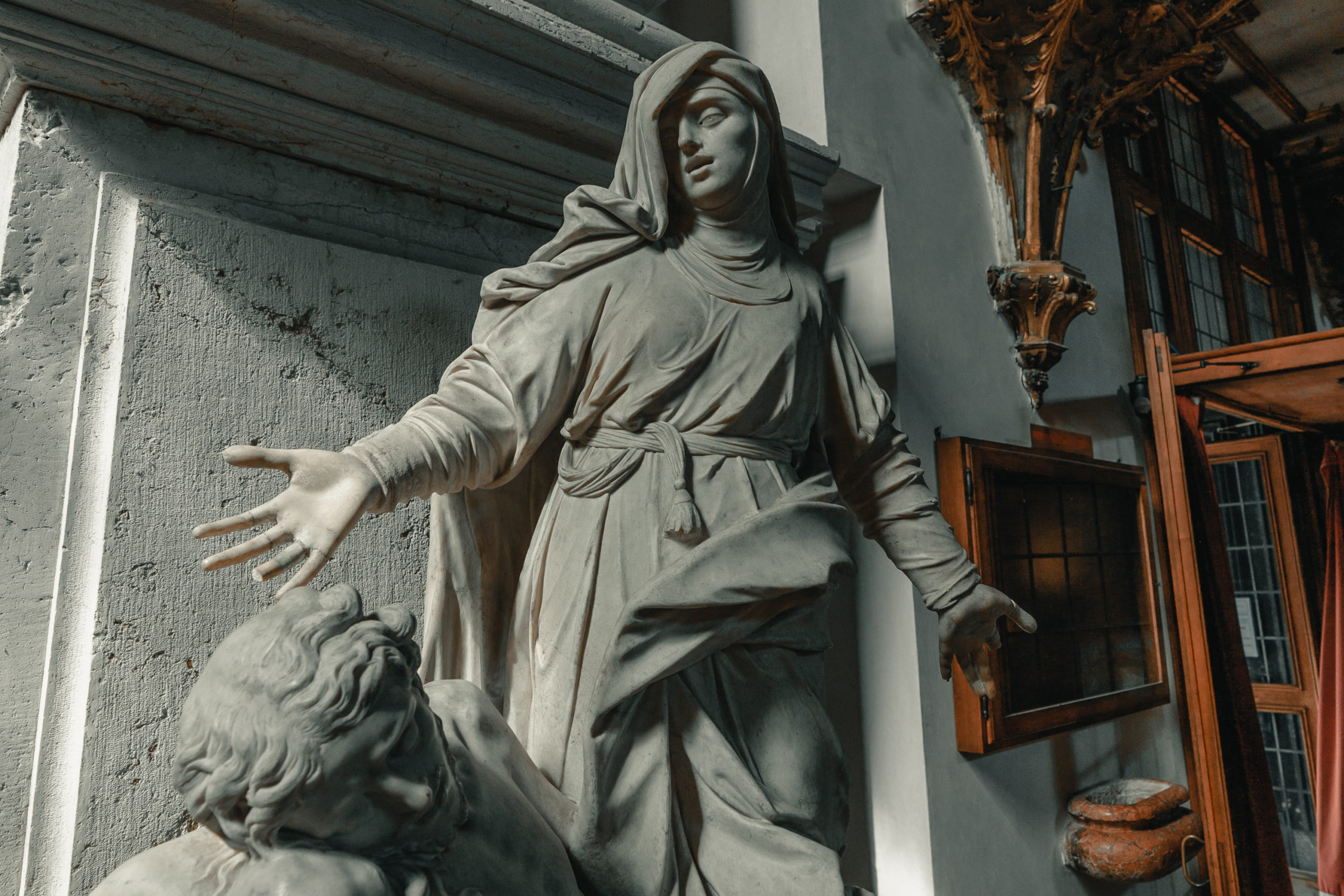
The following discussion focuses on some of the most important religious buildings on this map of Venice.
St. Mark’s Basilica is one of the most popular Venice sites to see. It is a cathedral style church , and it is considered one of the best examples of Italo-Byzantine architecture .
The facade of St. Mark’s Basilica has over 500 columns . Even if you don’t venture inside, St. Mark’s Basilica is one of the famous sites in Venice that you need to appreciate.
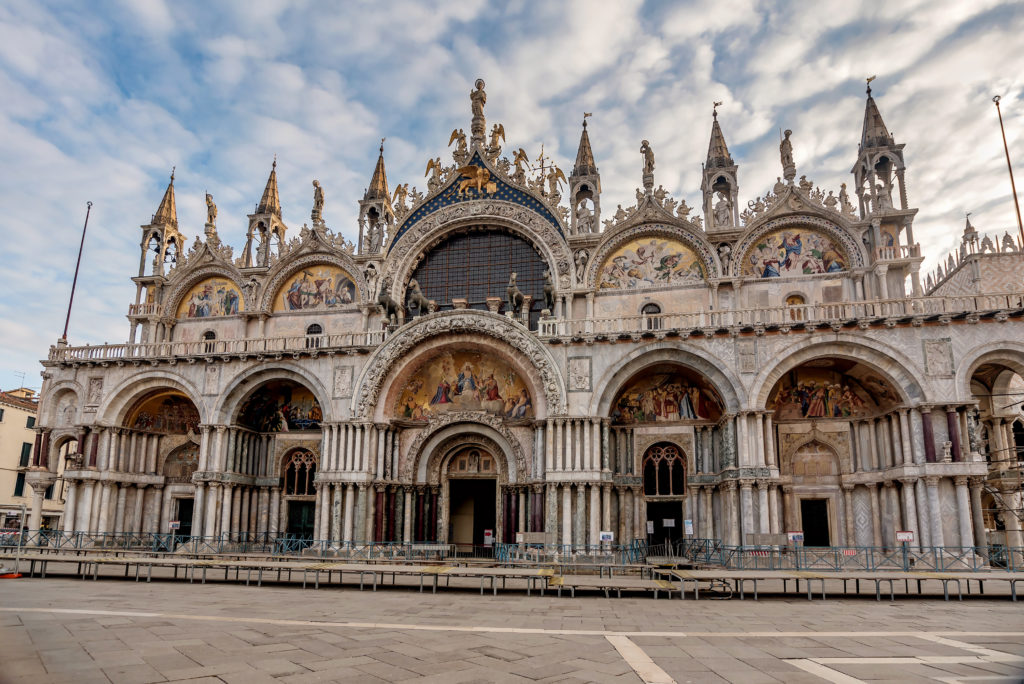
Inside Saint Mark’s Basilica, there are over 850,000 square feet of mosaics ! Wow. Many of these mosaics were added over 800 years ago . Much of the tile inlay of these mosaics are made of gold . Much of the treasures you’ll find inside come from the Crusades. So, it’s no wonder this is one of the best Venice Italy tourist spots.
The grounds of St. Mark’s Basilica also include a Renaissance style Clocktower and a prominent public square. Visiting this place is one of the legendary activities to do in Venice Italy.
The Church of San Zaccaria is one of the lesser-known famous things in Venice. This 15th-century Gothic church has somewhat a simple façade. However, it holds renowned paintings and precious artifacts.
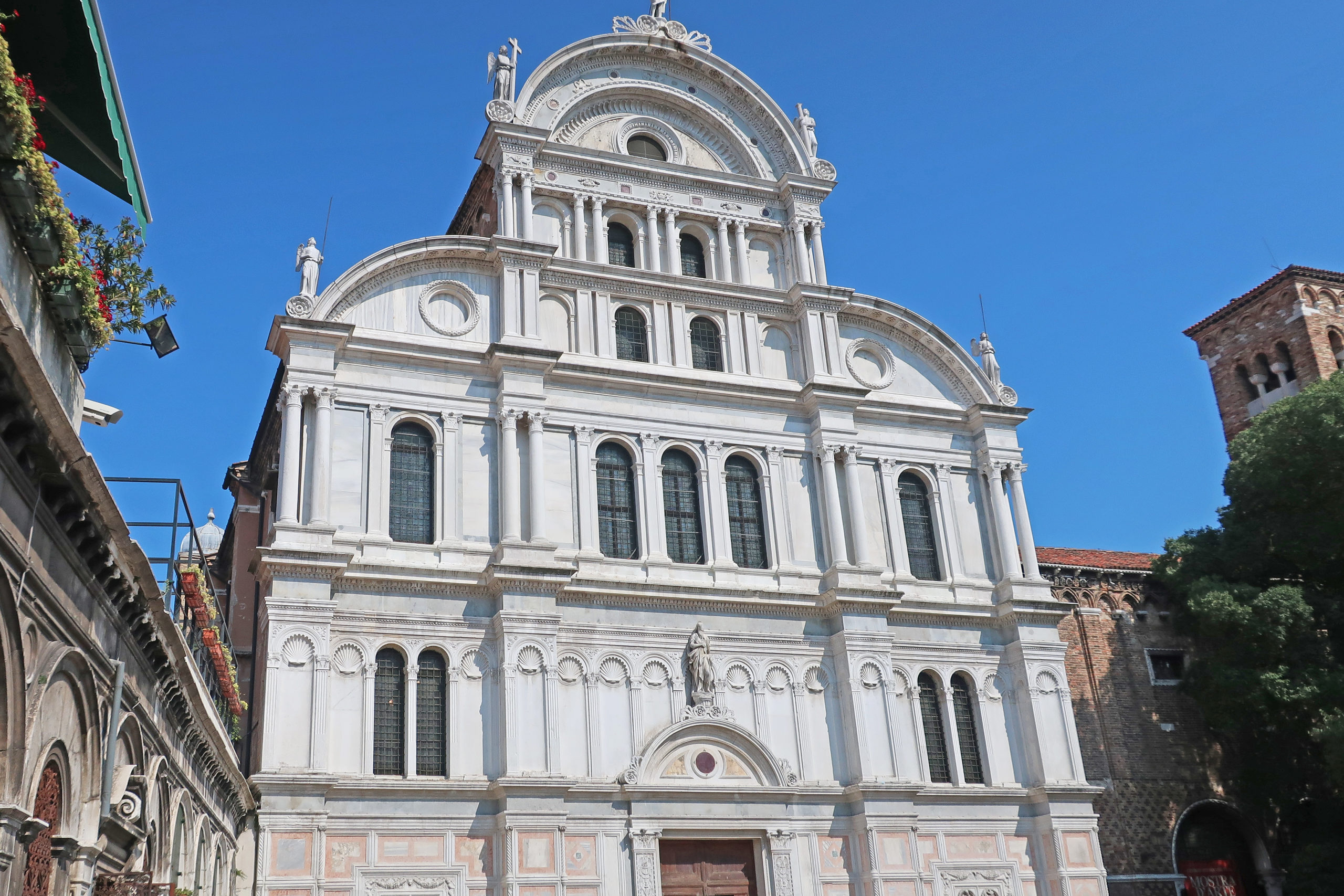
This church is significant for being one of the earliest monastic foundations in the city. It was first established in the 7th Century! For this reason, it’s one of the best attractions in Venice.
Despite its small size, the marble facade of this church is quite stunning. One of the noteworthy pieces you’ll find within is Giovanni Bellini’s Madonna and Four Saints . This is one of the top places in Venice for the off-the-beaten-path traveler.
The Church of Saint Julian is one of the important religious sites to see in Venice. The facade of the Church of Saint Julian follows th e traditional flattened temple style .
The consecration of this church was made possible by a local scholar and physician. You’ll see the statue of Tommaso Rangone above the door to the Church of St. Julian. Rangone grew his wealth by selling herbal remedies to Syphilis and yellow fever.
The Church of Saint Julian is one of the interesting places to go in Venice to view masterpieces and living history. These are incredible frescoes, sculptures and marble works inside.
The Church of Saint Julian is not far from the Church of San Salvador –another one of the must see things in Venice. As you walk from one church to the other, you’ll be in the main shopping street in Venice. This is a great spot to grab a magnet, leather goods, or other local trinkets.
Visiting historic churches is one of the unusual things to do in Venice . There’s no better Venitian church than the Basilica San Maria della Salute.
You can view this church while you’re enjoying the sightseeing in Venice Italy at Saint Mark’s Square. Look out past the Grand Canal, and you’ll be able to spot it!
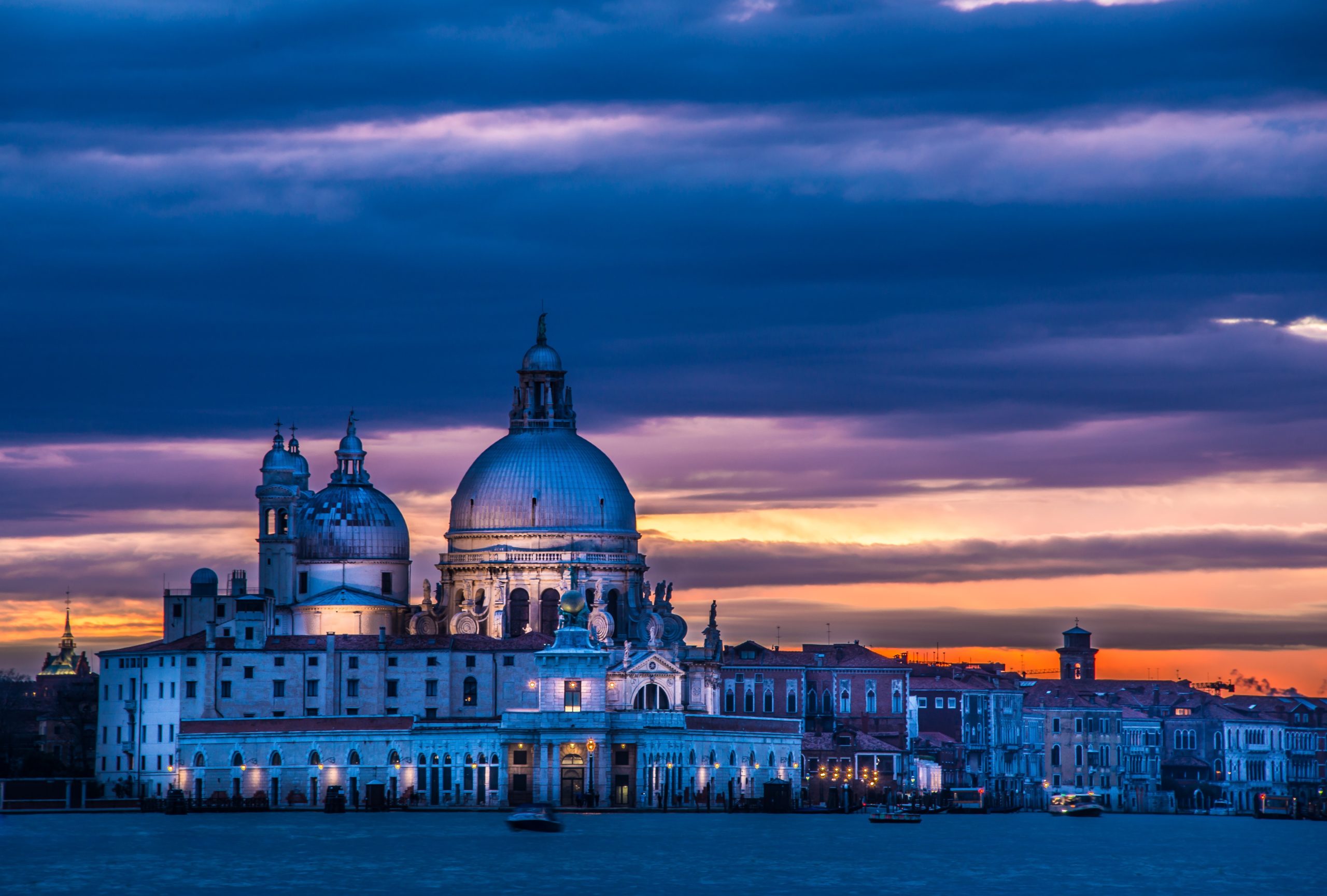
The facade of San Maria della Salute is remarkably baroque . It was built during a devastating outbreak of the plague, and many references to the Black Death can be observed in this church.
These are the best places to see in Venice. The top museums, churches & famous landmarks. They’re all mapped for you to enjoy.
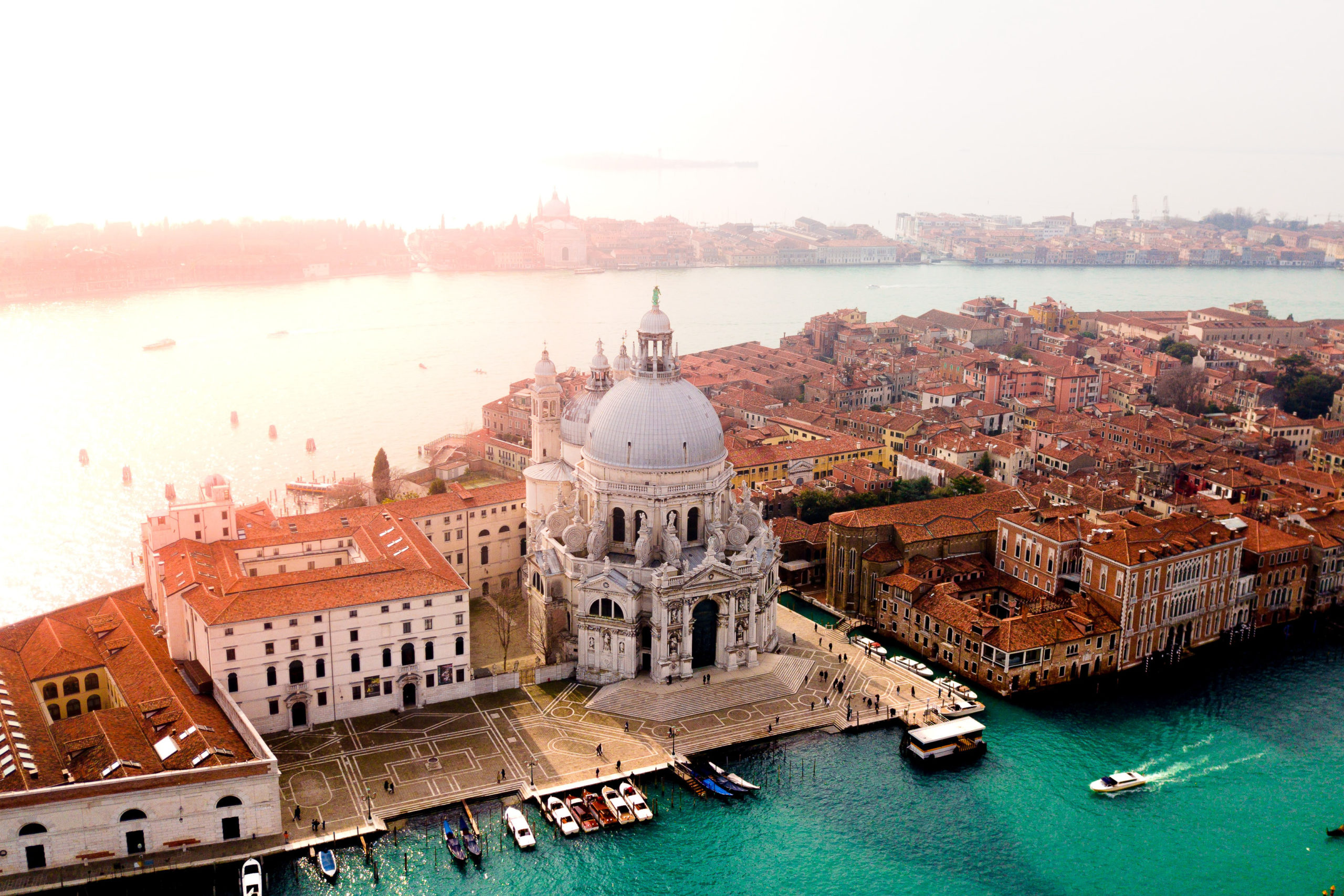
Learn more about how to use this map while you navigate around to the best tourist attractions in Venice Italy.
Think I missed something on my map? Comment below.
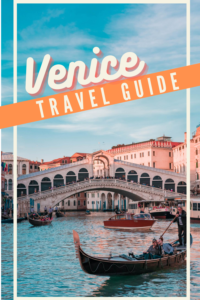
This post may contain compensated links. Please read our disclaimer for more info.
How to Find The Best Gelato in Italy
20 best views of chicago + 8 free chicago skyline views, you may also like, 16 romantic things to do in venice for..., dining in italy: how to find the best..., leave a comment cancel reply.
Save my name, email, and website in this browser for the next time I comment.

Doge’s Palace Venice: Self Guided Walking Tour
Have you decided to visit the Doge’s Palace in Venice but don’t know what this marvel of Italian artistic heritage has to offer?
You’ve come to the right place! I am Paolo from the Doge’s Palace Venice, and in this post I will tell you about the visit and special itineraries of the Doge’s Palace, also known as the Doge’s Palace, a monument that is a symbol of Venice and Italy.
Here I will explain the route of the visit that you can take on your own or by following a professional guide.
Are you ready? Let’s get started!
Before we start, a brief preamble: if you plan to visit the Doge’s Palace in Venice, (either by guided tour or on your own) it is strongly recommended to buy your ticket online , to avoid the long queue that may form at the ticket office. By purchasing the ticket in advance, you will be able to access the Palace by skipping the queue at the entrance.
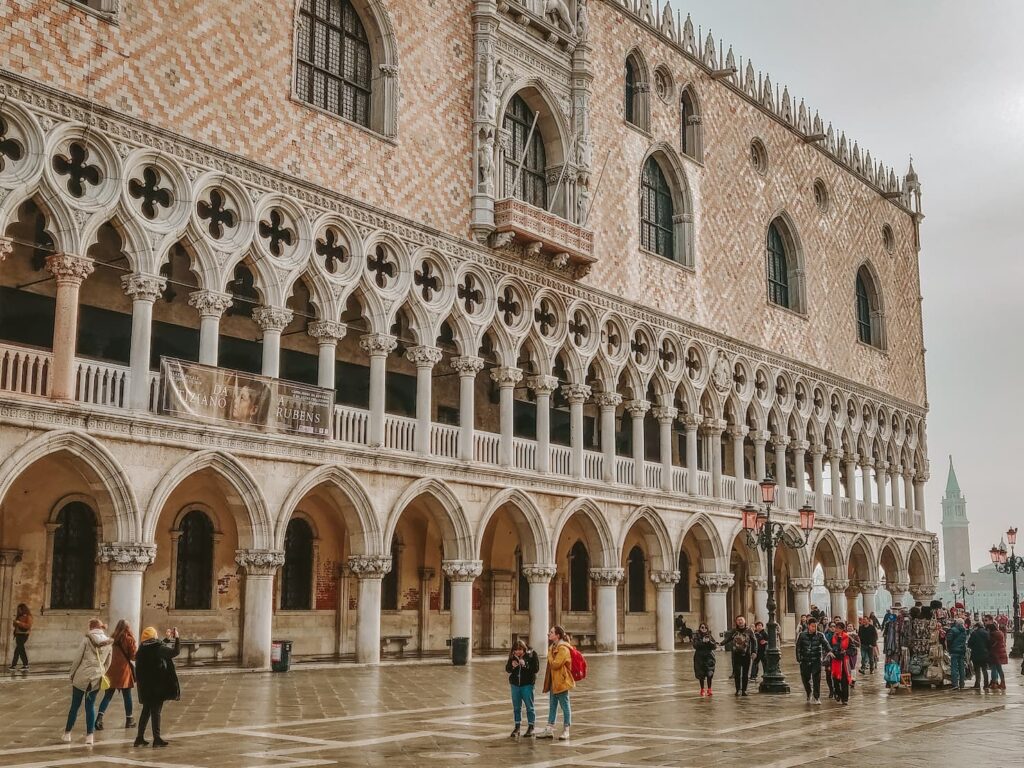
Doge’s Palace Venice skip-the-line ticket: quick access
Buy online. Choose your preferred time. Visit Venice’s Doge’s Palace, Bridge of Sighs, prisons and more.
You can cancel for free up to the day before your visit.
Table of content
- 1 Visit the Doge’s Palace: the route in brief
- 2.1 Courtyard
- 2.2 Opera Museum
- 2.3 Loggias Floor
- 2.4 Doge’s Apartments
- 2.5 Institutional Chambers (Part I)
- 2.7 Institutional Chambers (Part II)
- 2.8 Bridge of Sighs and New Prisons
- 2.9 Institutional Halls (Part III)
- 3.1 Secret Itineraries
- 3.2 The Doge’s Hidden Treasures
- 4 Doge’s Palace tour Venice: FAQ
- 5 Doge’s Palace self guided tour: conclusions
Visit the Doge’s Palace: the route in brief
Looking at the Doge’s Palace, or Palazzo del Doge, you will notice that it consists of four wings extending around the central porticoed courtyard . In height, however, it has three floors (the loggia, first and second noble floors) in addition to the prison building, which is external and accessible via the Bridge of Sighs between the first and second floors. In this context, you do not follow a linear route but find yourself going up and down the floors in stages.
To enter the Palace, you have to go to the Porta del Frumento – South Wing, overlooking St Mark’s Basin – from which you access the large porticoed courtyard .
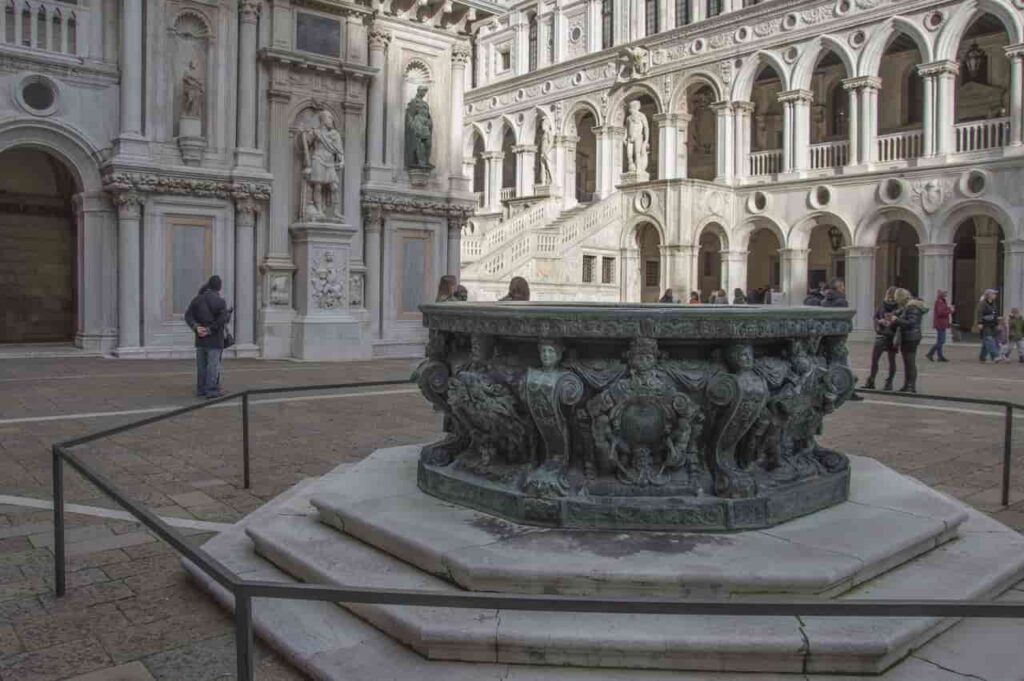
Here, you can admire the two wellhead buildings, the majestic Giants’ Staircase and the clock façade of the Renaissance wing.
This floor is also home to the Opera Museum , where you can discover the ancient capitals of the Palace, replaced and displayed here following a renovation in the 19th century. To continue your visit, cross the courtyard to the west wing and take the Censors’ Staircase leading to the upper floors.
A short passage to the first floor, called the Piano delle Logge , will allow you to stroll through the loggia and admire the large inner courtyard from above. From here, continue following the signs to access the sumptuous Golden Staircase leading to the first and second piano noble.
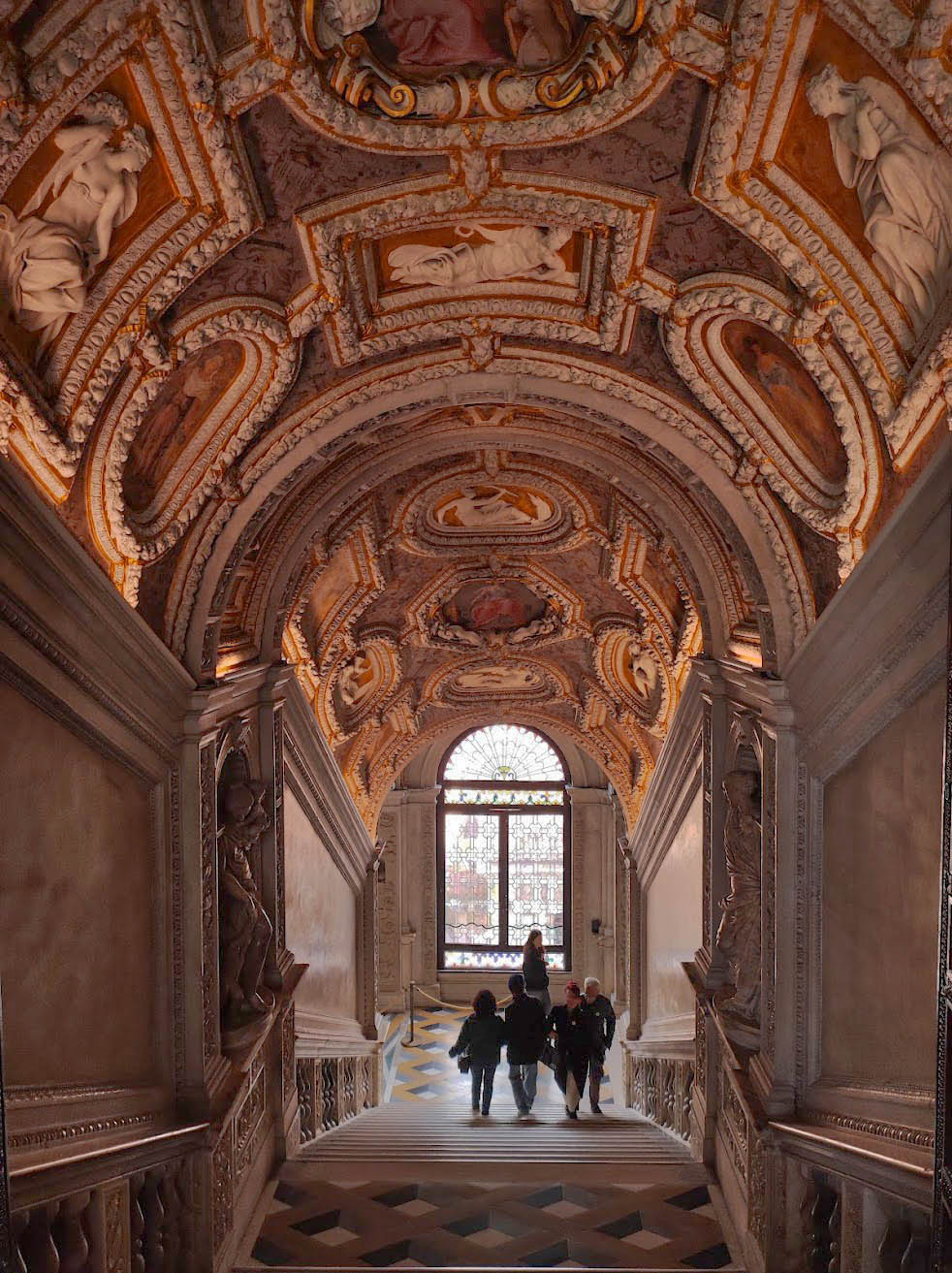
On the first piano noble is the Doge’s Apartment located in the west wing. Here you can walk through the state rooms and learn more about the figure of the Doge through the works on display. Exhibitions and temporary exhibitions are also held in these rooms.
The last flight of the Golden Staircase will take you to the second piano noble (top floor) where you will visit the first part of the Institutional Chambers . On this floor is the Sala delle Quattro Porte (Hall of the Four Doors), named after its four finely ornamented marble doors, and the Sala del Senato (Senate Hall) , where the senators whose job it was to control Venice’s finances and foreign policy gathered.
On the same floor, you can continue to the Armory, a former weapons depot divided into four rooms, which today displays more than two thousand pieces of weapons, armor and even instruments of torture.
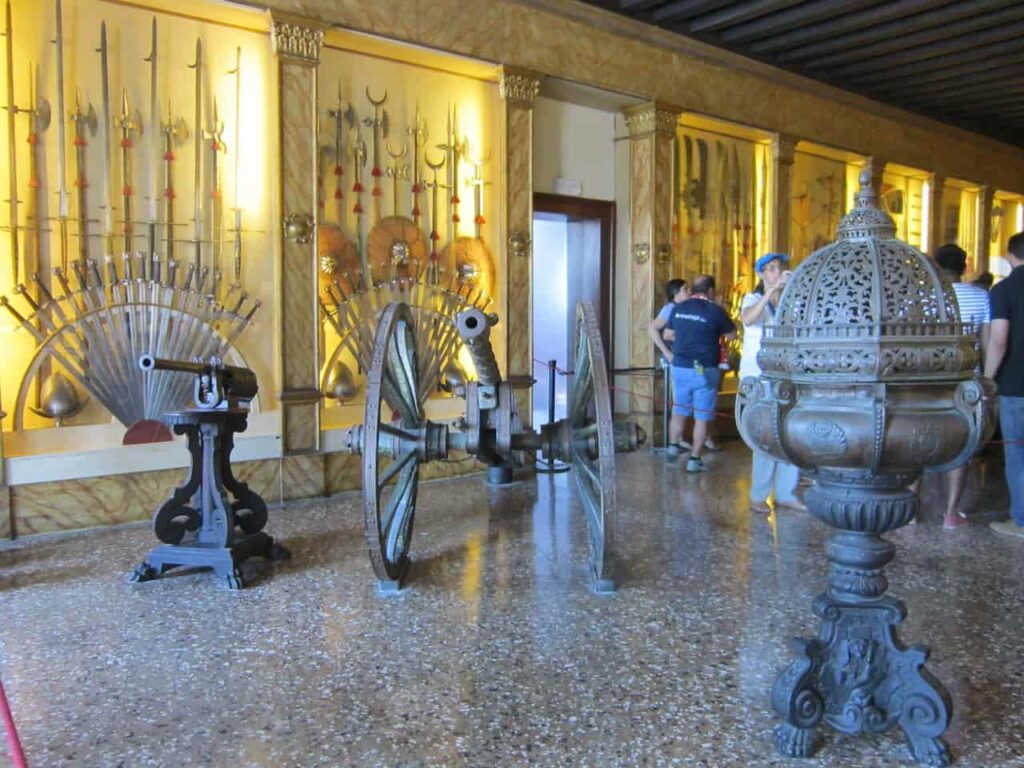
After leaving the armory, descend back to the first floor through the Censors’ Staircase to visit the second group of institutional rooms .
On this floor the Halls also extend to the south wing, almost entirely occupied by the majestic Great Council Chamber , and to the west wing with the Scrutiny Room .
These rooms are the largest in the Palace:
- the first hosted the meetings of the Great Council, the highest political order of the Venetian Republic, chaired by the Doge;
- the second , originally used as a bookshop, later became the place for counting elections .
The exploration of the first piano noble ends in the Sala del Magistrato delle Leggi (Hall of the Magistrate of Laws) : from here you descend via the small staircase to the famous Bridge of Sighs .
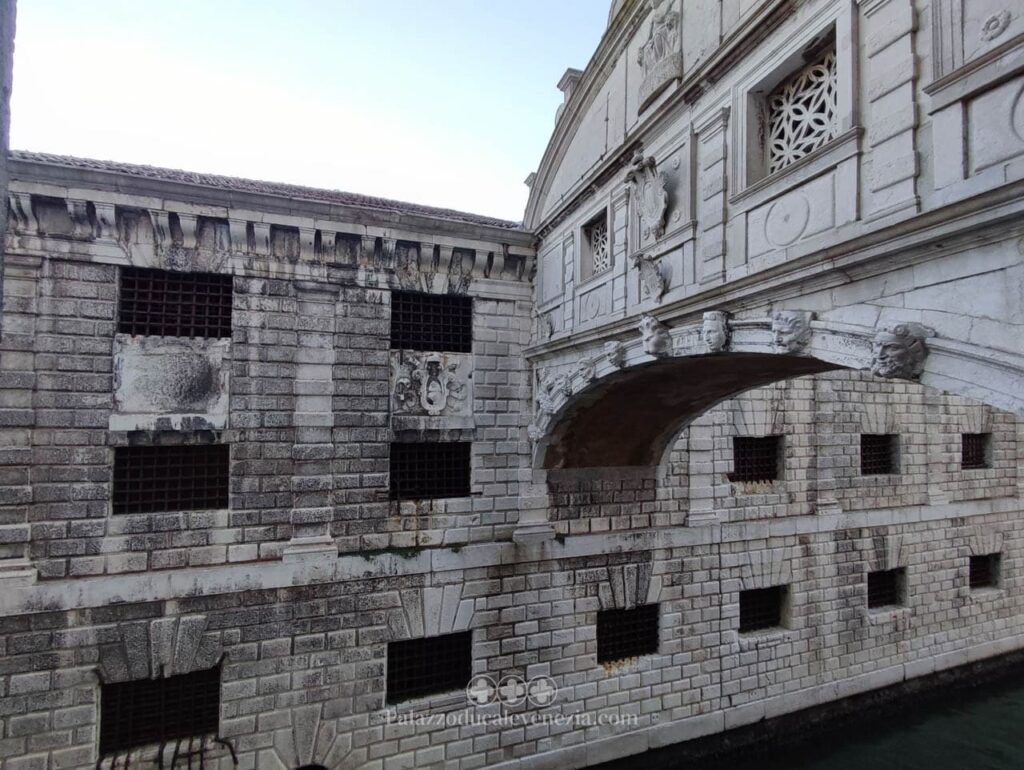
Cross the bridge and you will arrive at the New Prisons , located in a separate building on the other side of the Rio di Palazzo. In the building, erected in the second half of the 16th century, you will be able to see the former prisoners’ places of detention .
Retracing the Bridge of Sighs – via a second walkway – return to the Piano delle Logge to visit the last institutional rooms. From the last room, the Sala Milizia del Mar , you will finally reach the Bookshop.
At the end of the visit, descend back down to the courtyard to arrive in the 16th-century Senators’ Courtyard – where they gathered to await government meetings – to the right of the Giants’ Staircase.
From here, passing under the Renaissance Arco Foscari, you can finally reach the exit of the palace through the monumental Paper door , which I recommend you observe carefully from the outside to admire its magnificence .
The tour is free , but guided tours are also organized.
In addition, you can visit the Museum at night (times vary according to the season) to get a unique and evocative perspective of the Palace and the works inside.
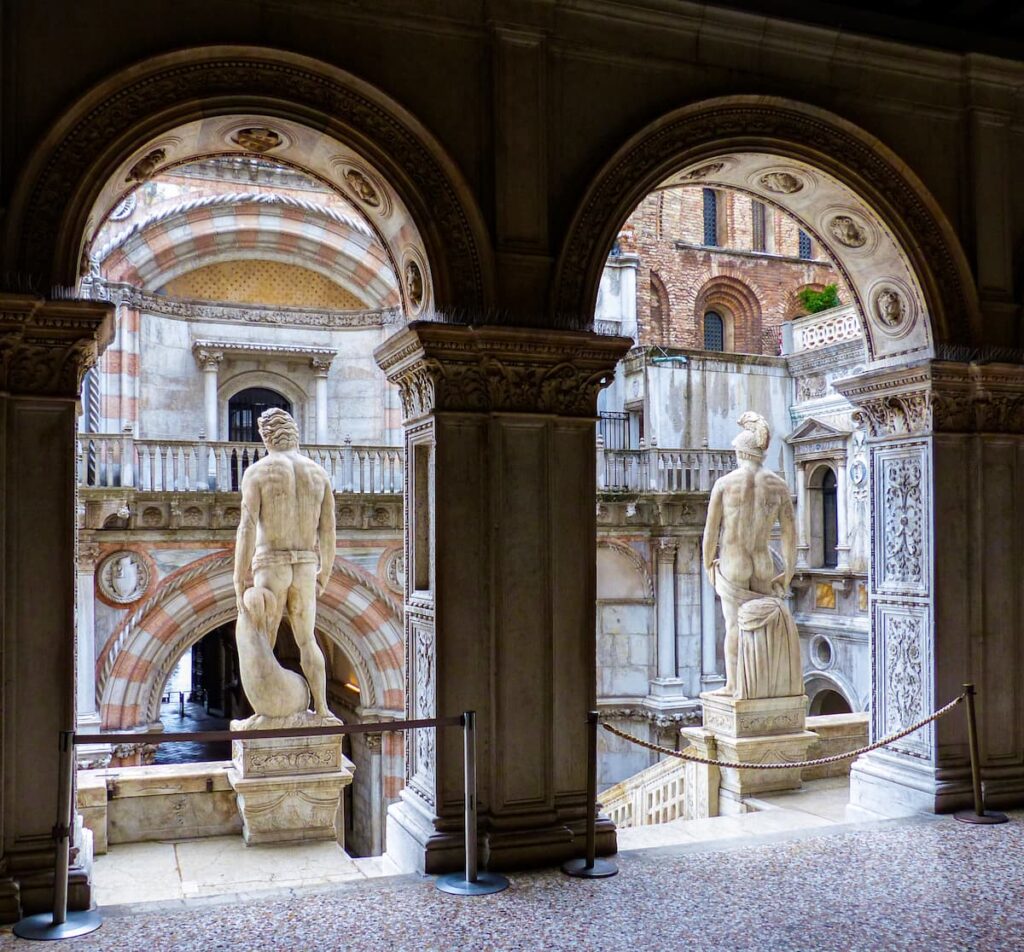
Venice Doge’s Palace self-guided tour
In this section we discuss the visit route in detail . You can follow this guide as an indication for a visit on your own , or as an anticipation for a visit together with a professional tour guide .
We begin our tour of the Doge’s Palace from the wonderful courtyard .
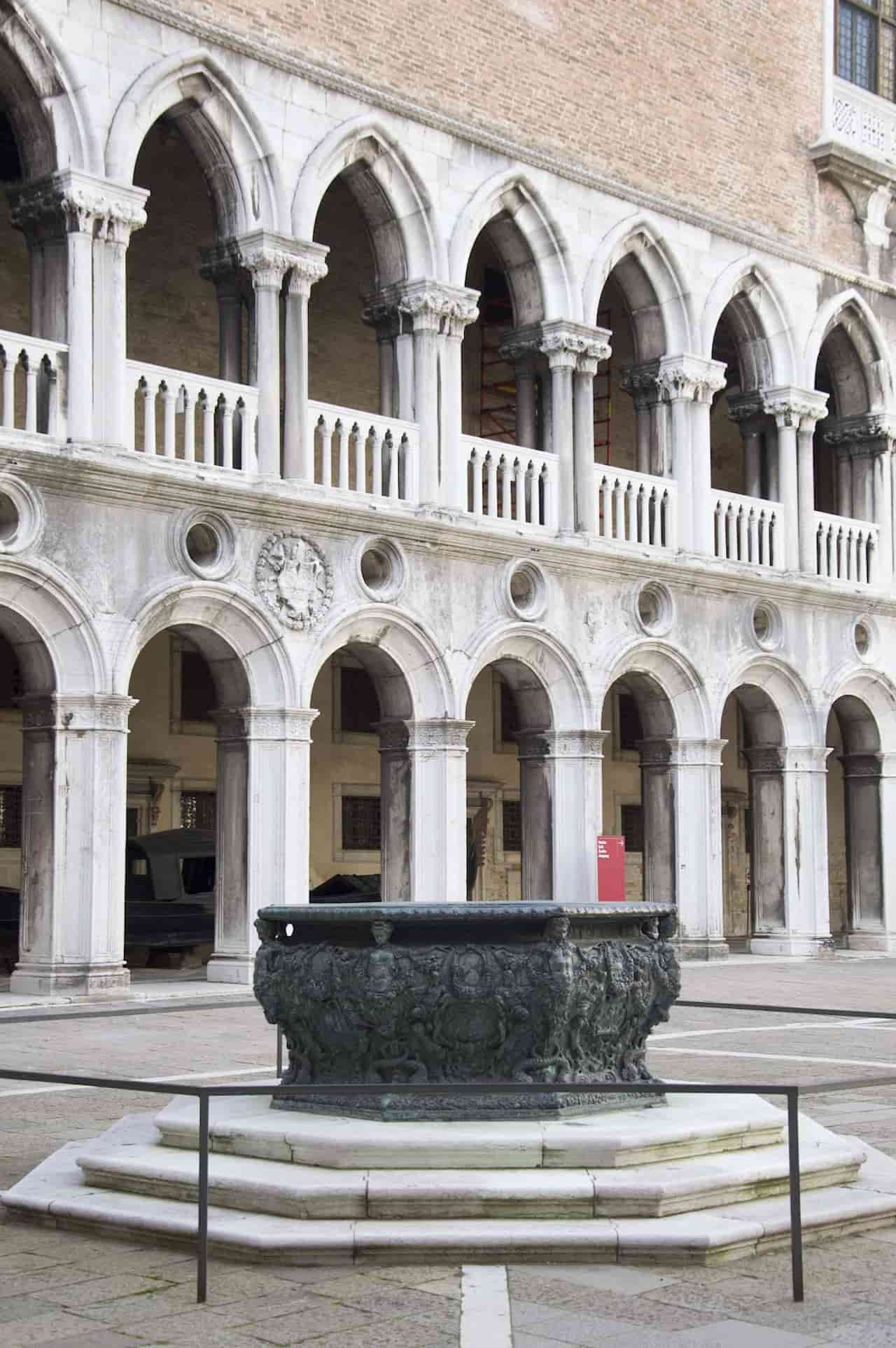
To enter the Museum you will have to pass through the 14th-century south wing, which overlooks the Bacino di San Marco, and go through the Porta del Frumento , named after the Ufficio delle Biade that once stood nearby. Pass the ticket office and enter the courtyard to begin your visit!
Interior facades
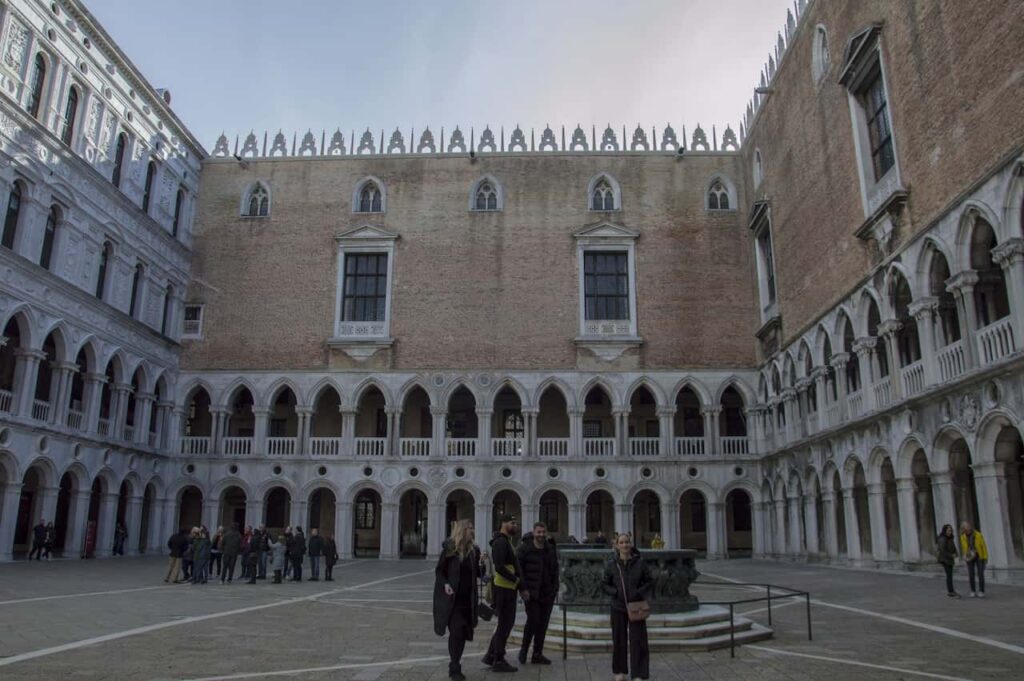
Inside, on the left side is the wing facing Piazzetta San Marco to the west, on the right side is the Renaissance wing to the east, and finally the courtyard is closed off by a fourth side to the north, where the Doge’s Palace borders St Mark’s Basilica , which was once the Doge’s chapel.
If you look around, you will notice that the southern and western interior brick façades retain the characteristic Venetian Gothic look of the corresponding exterior façades.
The eastern façade of the courtyard, on the other hand, is decorated with Renaissance marble and was designed by architect Antonio Rizzo after the radical reconstruction of the wing following the devastating fire of 1483.
Arco Foscari and the Paper door
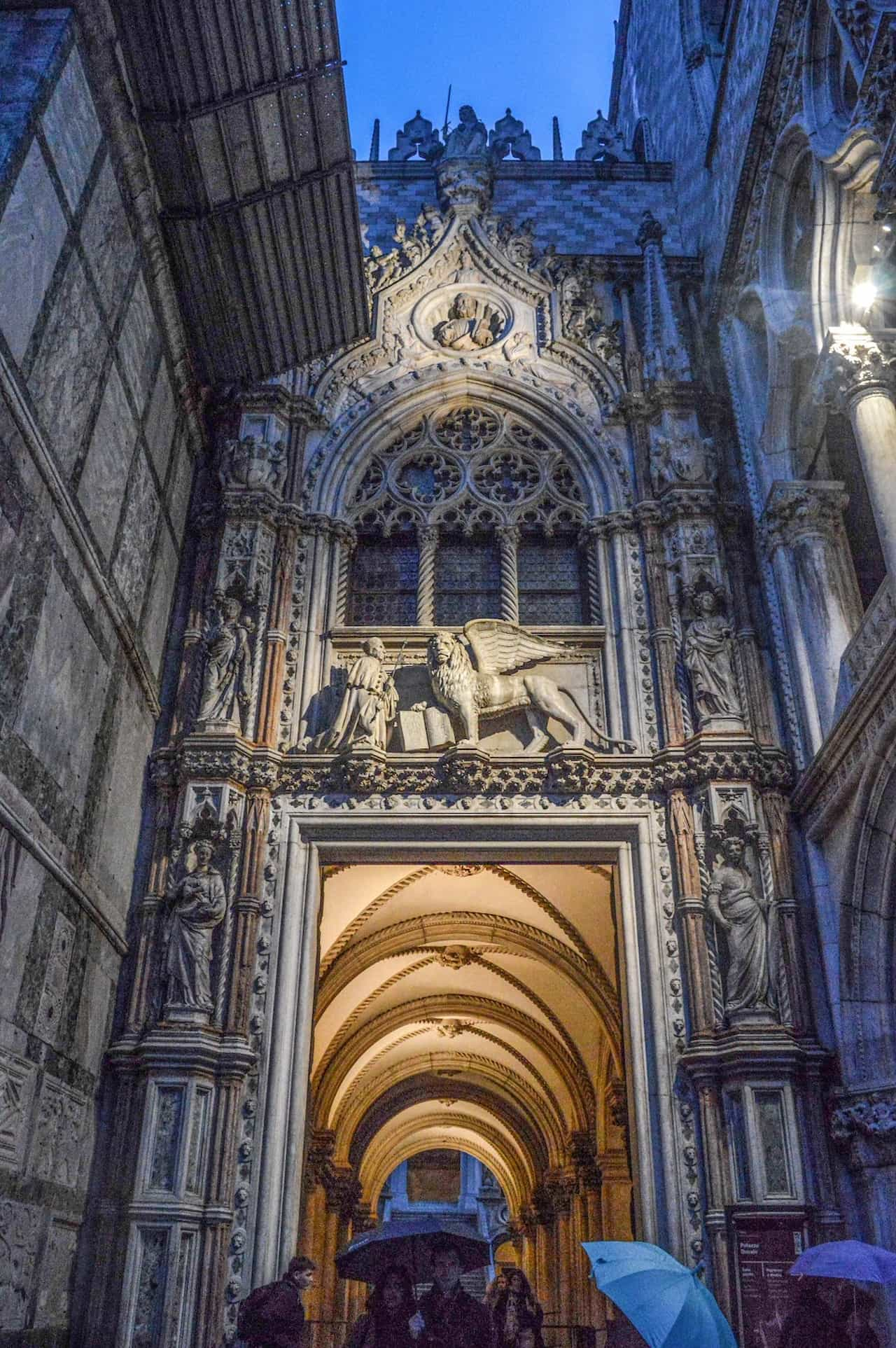
By continuing the tour of the Doge’s Palace , on the north side is the Porticato or Arco Foscari : a round arch made of white Istrian stone and red Verona marble.
If you look up, you will notice a large clock at the top of the façade, the work of the German watchmaker Johan Slim, who made it in 1614 with a mechanism made of weights that reached down to the foundations of the palace and touched the water of an underground canal.
The Arco Foscari connects the inner courtyard to the majestic Paper door : once the main entrance to the palace, now the museum’s exit.
The Giants’ Staircase and the Senators’ Courtyard
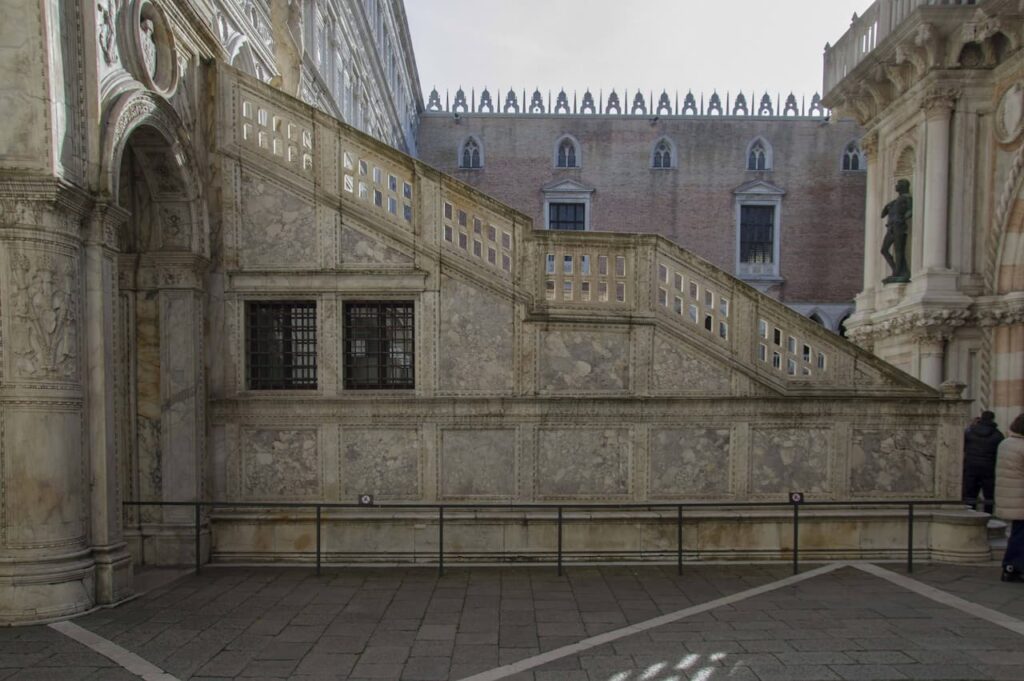
As you stroll through the courtyard, you will see two massive and ornate bronze well-casters from the mid-16th century in the center and the imposing Giants’ Staircase : a natural extension of the Arco Foscari and the ancient entrance to the upper floors, it houses at its summit the statues of Mars and Neptune , sculpted by Sansovino in 1565, symbolizing the power of Venice.
To the right of the Giants’ Staircase you will find the 16th-century Senators’ Courtyard , where senators used to gather for government meetings.
The Censors’ Staircase
Also on the same side, but in the opposite direction to the majestic staircase, stands the Scala dei Censori under the elegant portico. This was built in 1525 to an architectural design by Antonio Abbondi, known as Scarpagnino.
Just by climbing the Censors’ Staircase you can continue your visit to the upper floors and immerse yourself in the rich artistic and historical heritage offered by the Doge’s Palace.
Opera Museum
The Opera Museum housed a technical office responsible for the maintenance of the building , located in the south-west corner of the ground floor.
In the 19th century, the Doge’s Palace was in a terrible state of disrepair, so it was decided to carry out a major intervention in 1876 . A major restoration project was initiated in which 42 capitals of the exterior colonnade and other architectural elements were removed from the palace’s outer walls and courtyard and replaced with replicas.
The originals were restored and housed in the Opera Museum.
The capitals in the Museo dell’Opera are a precious and important part of the extraordinary sculptural apparatus that enriches the medieval facades of the Doge’s Palace . It is not just a simple decorative apparatus, but an articulate allegorical, religious, moral and political cycle that was certainly easier for a 14th and 15th century citizen to understand than it is today.
The sculptures on the capitals represent a veritable poem in stone, peopled by women, men, children, animals, plants, zodiac signs, myths, symbols, vices, virtues, grouped in tales, parables and demonstrations, allegories and moral foundations, along a path that, in a typically medieval process, combined history and legend, astronomy and astrology, the sacred and the profane.
The Opera Museum offers an itinerary based on this tale in stone and is currently divided into six rooms.
This room contains six capitals and their columns from the 14th century portico of the palace overlooking St. Mark’s Basin. These are the oldest in the building, which was begun in 1340.
The first one you meet on your way, on the right, represents Solomon and the seven scholars .
Unlike the capitals in the previous room, the four capitals in this room , with their columns, were originally located on the façade facing the Piazzetta.
The reliefs, of great sculptural quality, are very rich in allegories and moral teachings , dealing with topics related to work, the fruits of the earth, astrological correspondences, etc. On the entrance wall is a late 16th-century infill of one of the arches of the portico overlooking Ponte Paglia.
After the great fire that broke out in 1577, it was decided to plug the last arches for structural reasons.
This room houses three capitals with columns . The first on the right, described by Ruskin as ‘the most beautiful in Europe’, was located in the corner between the square and the pier, under the sculptural group of Adam and Eve.
Approach the sculpture of The Creation of Adam, the planets and their houses : it is from this position that one can appreciate the importance of this sculptural group in the great iconographic program of the Palace.
The reading begins with the creation of the first man , visible on the left with his back to the entrance, and continues with the depiction of the planets and corresponding constellations. The image of God seated on a throne has just completed the formation of Adam, followed by the elderly and bearded Saturn, seated in Capricorn, with his precious Aquarian vessel, counterclockwise.
His attribute, the sickle, is still visible, making him the protector of work in the fields and reminding the government of his old age and death; next to it, Jupiter, with a cloak around his neck and a doctor’s hat, touches the sign of Pisces and sits above Sagittarius, armed with a bow and arrow.
Mars sits in Aries , flanked by Scorpio, like an armored warrior with sword and shield. A beautiful young man with his head covered in rays of light occupies the fifth floor. The Sun sits in Leo , holding a star in his left hand.
Venus is elegantly dressed with a belt across her chest, sitting in Taurus with Libra in her arms, admiring her beauty in the mirror. Next to her is Mercury , dressed in a toga and holding an open book. It is located between Virgo and Gemini .
Finally, the Virgin is placed on a boat , lifting the Moon’s hawk and touching the crab, symbol of Cancer . The boat and the canopy, moved by the wind, recall the Moon’s influence on the tides and the wind. At the end of the room, the last capital represents the deadly sins.
Moving away from the entrance and proceeding counter-clockwise, we find Pride , in the form of a warrior armed with sword and shield and wearing Satan’s horned helmet; Wrath, an old man tearing his clothes and cursing the heavens; Avarice , closing two bags with his fists; and Sloth, trapped between the branches in a lazy, passive posture. The next page depicts ‘ vanity ‘, which is not included in the seven main vices.
She is depicted as a maiden , her head adorned with flowers. She looks at herself in a mirror placed in her lap and touches her breasts. The jealousy that follows shows that she is aware that she is no longer an object of desire for others and is tormented by anger. The serpent above her head and the dragon grasping her breasts emphasize her demonic appearance. Desire exposes her breasts in the mirror and finally her throat lifts the glass and brings her thighs to her mouth.
In this room are two porch shafts and a massive stone wall with large rough-hewn and juxtaposed boulders, dating from an earlier phase of the building.
Along the wall of the entrance are two other columns of the portico , while the one on the adjacent wall, with the foliate capital, belongs to the loggia of the façade facing the Piazzetta; a part of the gallery of the loggia was also placed in this room, with its succession of capitals resting on the pointed arches that give life to the quadrilobe surmounted by the rosette cornice . In the wedges of the arches are lion heads.
There are 29 loggia capitals in this room.
Turning back along the right wall, one comes across a bust . This is all that remains of the group depicting Doge Cristoforo Moro with the Marcian Lion, which was placed in the niche in front of the Scala dei Giganti, demolished during the fall of the Venetian Republic in 1797.
At the same end, the group with Doge Francesco Foscari kneeling in front of Bartolomeo Bon’s Lion above the Paper door, of which only the Doge’s head can be seen on the same side, goes towards the exit.
The group currently on the Paper door is a copy made in 1885 .
Loggias Floor
From the floor of the loggias, the route begins along the three wings east, south and west of the palace , with fascinating views of the courtyard and Piazzetta San Marco.
It is precisely the loggias that give the palace’s architecture that characteristic lightness effect .
Today, the loggia floor houses the offices of the Soprintendenza per i Beni Ambientali e Architettonici di Venezia (Venice’s Environmental and Architectural Heritage Office) and some of the offices of the palace management, the Venetian Civic Museums, as well as one of the museum’s bookshops .
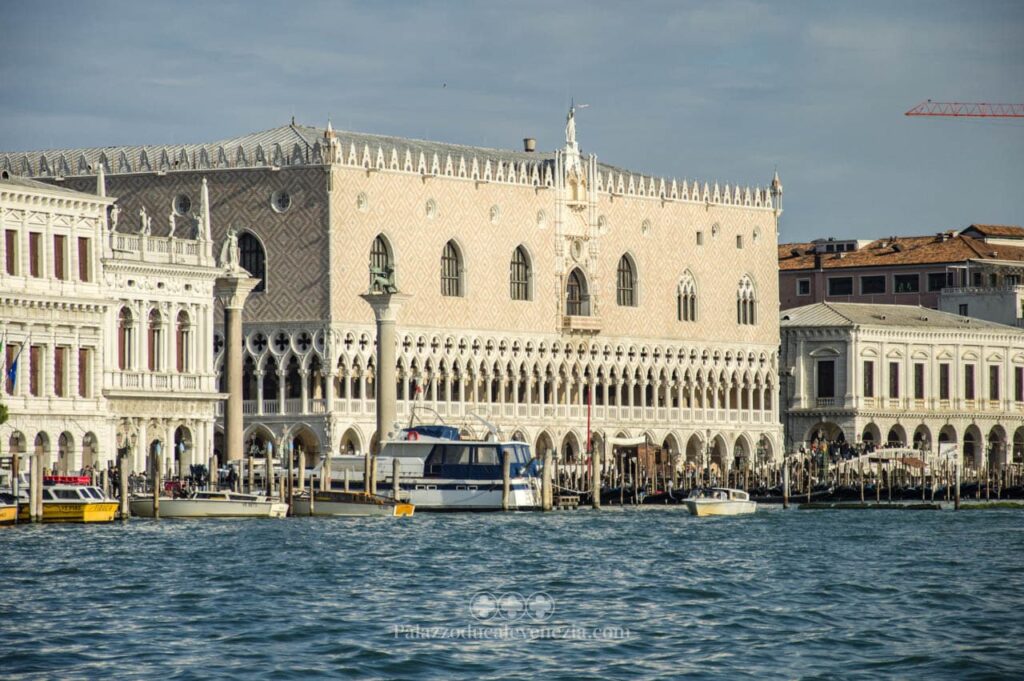
Doge’s Apartments

In 1556, as a continuation of the Giants’ Staircase , Doge Lorenzo Priuli gave Jacopo Sansovino the task of designing a staircase leading to his flats and state rooms.
The staircase was called the ‘ Golden Staircase ‘ because of the preciousness of the stuccoes covered in gold leaf and the fresco panels decorating the vault of the staircase.
At the top of the first ramp are two further ramps, one to the west and one to the east, both leading to the Doge’s Apartment on the First Noble Floor . The staircase served as a separation between the area of the Palace reserved for institutional functions and the Doge’s private area.
The Doge’s Apartment was located in the northern part of the Renaissance wing and ran between the mezzanines and hidden rooms, such as the antichiesetta and the chapel, which are not visible on the standard tour (Special Routes).
In 1505, the small Church of St Nicholas by Giorgio Spavento was built to close off the courtyard on the north side.
Today, the flats house a permanent exhibition dedicated to the figure of the doge and the city of Venice.
Institutional Chambers (Part I)
The tour of the institutional halls begins on the third floor of the palace . All you have to do is walk down the Golden Staircase and you will find yourself in the first room of the tour .
Square Atrium
The last step of the golden staircase leads to the square atrium.
This room leads to the hall where the most important meetings of the political life of the Venetian Republic took place.
In the center of the ceiling, Doge Girolamo Priuli (1559-1567), the eponymous saint and the symbols of peace and justice are depicted on an octagonal canvas by Tintoretto.
Eight side paintings with putti symbolizing biblical episodes and seasons were also painted by Tintoretto’s workshop. Currently on display are sacred scenes painted in the second half of the 16th century : the ‘Annunciation to the Shepherds’ by Girolamo Bassano and three canvases attributed to Veronese: ‘Adam and Eve Driven from Paradise’, ‘Prayer in the Garden’ and ‘St. John Writing the Apocalypse’.
Hall of the Four Doors
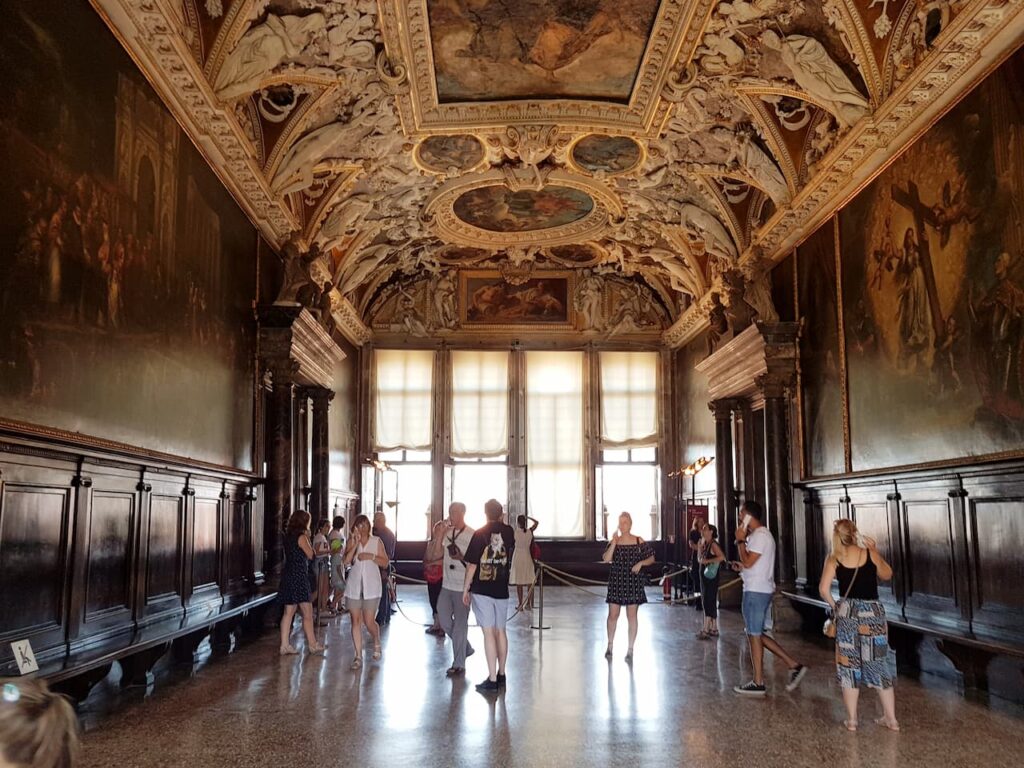
The Hall of the Four Gates was a solemn hall that filled the entire width of the floor , from the courtyard to the Rio. This hall served as a place for high-ranking representatives waiting to be admitted to the Council and as a link between the halls where the highest executive offices of the Republic met.
After a fire in 1574 , it was restored according to plans by Andrea Palladio and Giovanni Antonio Rusconi. The barrel vault is decorated with gold and stucco work by Giovanni Battista Cambi, known as Bombarda.
The iconographic program of the ceiling is the work of the polyglot Francesco Sansovino.
Above the vault are allegorical figures, gods, putti, winged spirits, sirens, tritons and other grotesques .
The frescoes by Jacopo Tintoretto , of which little remains because they had to be restored due to weather and humidity problems, emphasize the strong symbolism.
The canvas, elliptical in shape, shows the personification of Venice and its subordinate cities (Verona, Brescia, Istria, Padua, Friuli, Treviso, Vicenza and Altino), with broad strokes depicting Jupiter ceding control of the Adriatic to Venice, Juno bestowing Venice with the insignia of power, and Venice removing the yoke of slavery.
There are canvases by Giambattista Tiepolo, Neptune Offering a Gift to Venice , made in 1758, and Venice Leaning on the World, by Niccolò Bambini.
Each of the four doors designed by Andrea Palladio features a sculptural group that recalls the activity of the governing body of the hall accessed:
- Vigilance, Eloquence, Ease of Hearing for the College
- Peace, Pallas, War for the Senate
- Authority, Religion, Justice for the Council of Ten
- Secrecy, Diligence, Loyalty for the Chancellery.
The decorations on the walls include votive scenes and re-enactments of historical events.
Antichamber of College
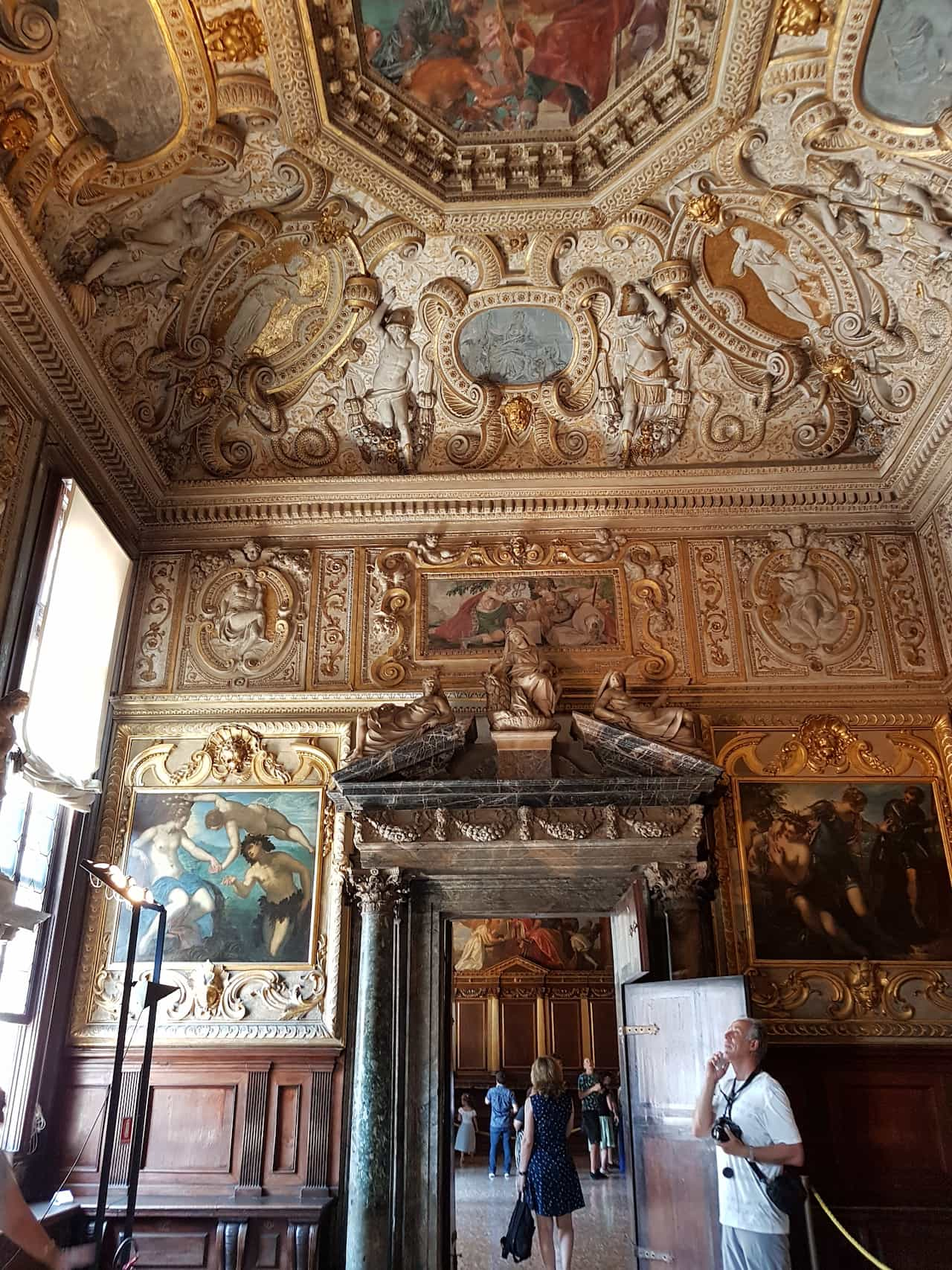
The Antichamber of College was the antechamber of honor where foreign delegations, Venetian ambassadors and magistrates returned from their duties to be received by the Serenissima Signoria .
This room was also damaged by fire in 1574 and was restored according to plans by Palladio and Vincenzo Scamozzi. On the pedestal above the monumental fireplace with the two marble telamons is a relief of Venus asking Vulcan for weapons for Aeneas.
The same technique is used for the wall and ceiling decorations , made by Marco D’Agnolo in 1576-77. In the centre of the ceiling is an image of Venus asking Vulcan for weapons for Aeneas.
In the centre of the ceiling is an octagon frescoed by Paolo Veronese depicting the distribution of wealth and honours by Venice.
On the walls are four mythological canvases by Jacopo Tintoretto, originally made for the square atrium: Mercury and the goddesses, Pallas driving out Mars, Arianus being picked up by Bacchus and The Forge of Vulcan . The allegories of these seasons can be interpreted as signifying the wise and reflective politics of the Republic.
Above the tympanum of the portal leading to the College Hall are three sculptures by Alessandro Vittoria personifying Venice, Concordia and Glory.
Senate Hall
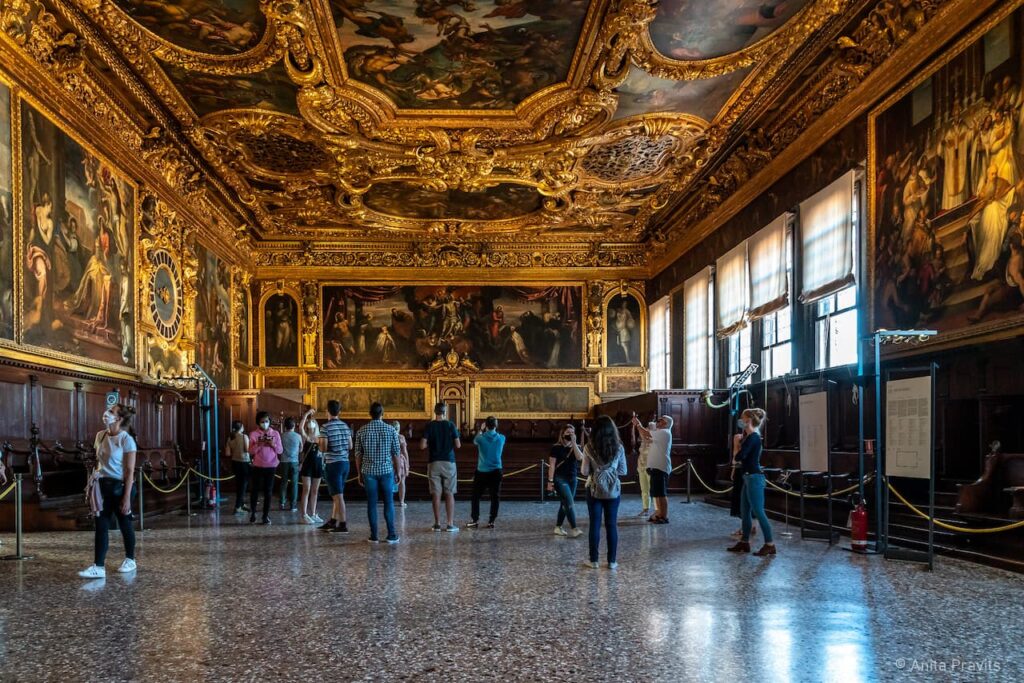
The Senate, also called the Council of Pregates , consisted of a committee of 60 nobles and an equal number of nobles called Zonta.
During the meetings, the Senate was joined by the Small Council, the Quarantia, the Avogadori di Comun, the Council of Ten, the Saviours and, if necessary, other magistrates, making a total of 200 members.
This room was also restored by Antonio da Ponte after the fire.
The ceiling is wooden , with a central painting of the Triumph of Venice by Domenico Tintoretto, surrounded by various autographs depicting the virtues of the Republic.
The walls of the hall are decorated with two clocks , one of which depicts the twelve signs of the zodiac, allegorical scenes and votive paintings from the late 16th century.
Above the courtyard is a painting by Jacopo Tintoretto and Officina della morte di Cristo, supported by angels worshipped by Abbots Pietro Lando and Marcantonio Trevisan, and the triumphal return of Christ by Parma the Younger to Abbots Lorenzo and Girolamo Priuli.
Other paintings in this room are by Tintoretto, Parma the Younger, Tiepolo and Marco Vecellio .
Hall of the Council of Ten
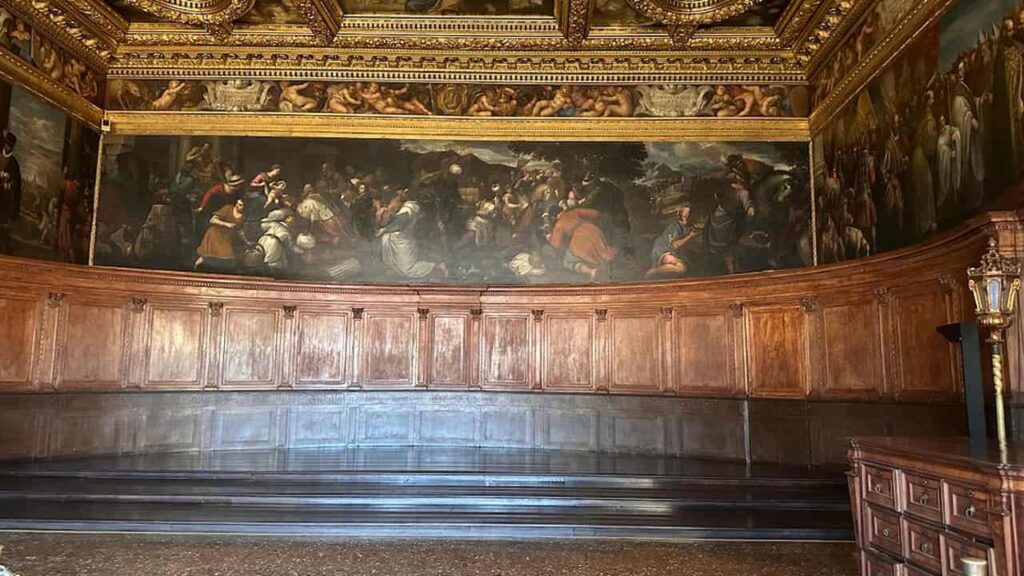
This room housed a committee of ten, a small council and a commission consisting of at least one avogador from the comun .
Secret meetings were held here on sensitive issues such as national tranquility and prosperity, public order and morality, the punishment of crimes committed by political prisoners and nobles, and the morals and manners of citizens.
To achieve its goals, the commission could also resort to torture .
There are wooden bumps around the room where the deputies sat, but the bumps on the semicircular platform are missing.
A door led to the office behind and, via a staircase, to the prison.
The walls are painted with putti, allegorical figures and the coat-of-arms of Doge Francesco Dona on a frieze by Giambattista Zelotti, the Adoration of the Three Doctors by Antonio Ariense and the Peace of Bologna between Charles V and Clement VII from 1530 by Marco Vecellio, canvases from the late 16th and early 17th century adorn the walls.
They are by Giambattista Poncino da Castelfranco and Paolo Veronese. A series of chiaroscuro paintings with allegorical and symbolic subjects surround large panels depicting the gods and greatness of the Republic.
Compass Hall
The name of this room comes from the compass door in the corner of the room. The compass leads to two hidden passages above the statue of Justice .
From here, witnesses, lawyers and defendants could enter and leave the room where the trials of the three heads of the Supreme Court of the Republic, the Council of Ten and the Magistrate’s Court took place.
The place where the magistrate’s organs sat was connected to the old prison by a staircase that ascended from the well to the ponds .
In the center of the ceiling is a canvas depicting St. Mark Crowned with the Theological Virtues , a 19th-century copy of Paolo Veronese’s original, now in the Louvre after it was stolen by the French in 1797.

Down two flights of stairs you will find yourself inside the armory .
The armory collection consists of four rooms and includes more than two thousand weapons for the most diverse uses.
The first exhibition room , called the ‘Gattamelata Room’ after the armor of the condottiere Erasmo da Narni, known as Gattamelata, contains profiles of horses and their armor from the 16th century. Also on display are models of swords from various epochs, a model of a crossbow, a typical painted leather tulkassi for storing arrows and a lantern from a Turkish ship taken from the enemy (with its characteristic crescent moon).
The second gallery is decorated with the triangular Turkish flag at the famous Battle of Lepanto in 1571. In the center is an inscription in honor of Allah and his prophet Muhammad, with a verse from the Koran embroidered on the border. Of particular note is the armor donated to the Republic by Henry IV of France during his visit in 1604. Also in this room are two ornate fire lances, several broadswords and a 15th century horse’s head armor.
Room III takes its name from the bust of Francesco Morosini in the back niche; during the war against the Turks from 1684 to 1688, the admiral was appointed supreme commander of the Venetian fleet and was given the honorary nickname Peloponnesian; in 1688 he became doge. This room contains numerous swords, pikes, arrowheads and crossbows, often inscribed or painted with CX’s initials. A culverin from the mid 16th century, a small decorated cannon and a 17th century arquebus with 20 barrels (10 long and 10 short) can also be seen in this room.
Various types of weapons are displayed in Room IV, including a 16th century fire crossbow, a fire club, an axe, a fire sword and an arquebus from the 17th century. Of interest are the so-called ‘Devil’s Box’, a trap that conceals poisoned arrows, four gun barrels that explode when opened and a trap. In this room are torture instruments, chastity belts and various weapons that were banned because they were small and easy to hide. They belonged to the Carrara family of Padua, exterminated by the Venetians in 1405.
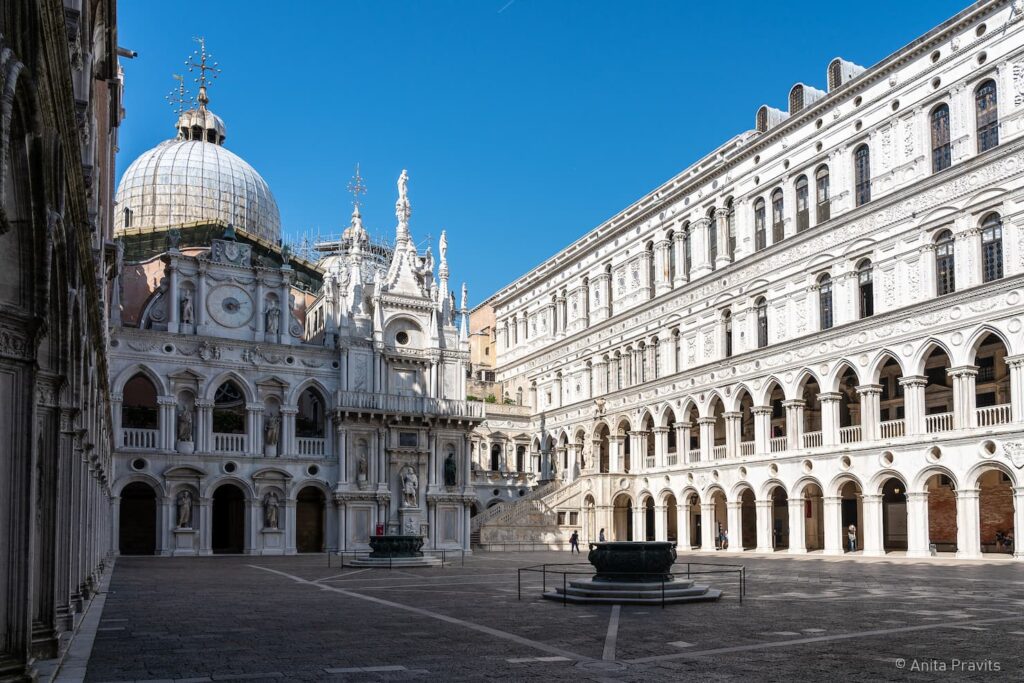
Institutional Chambers (Part II)
From the armory, you will descend a few flights of stairs to the second floor of the palace to continue your tour of the institutional rooms.
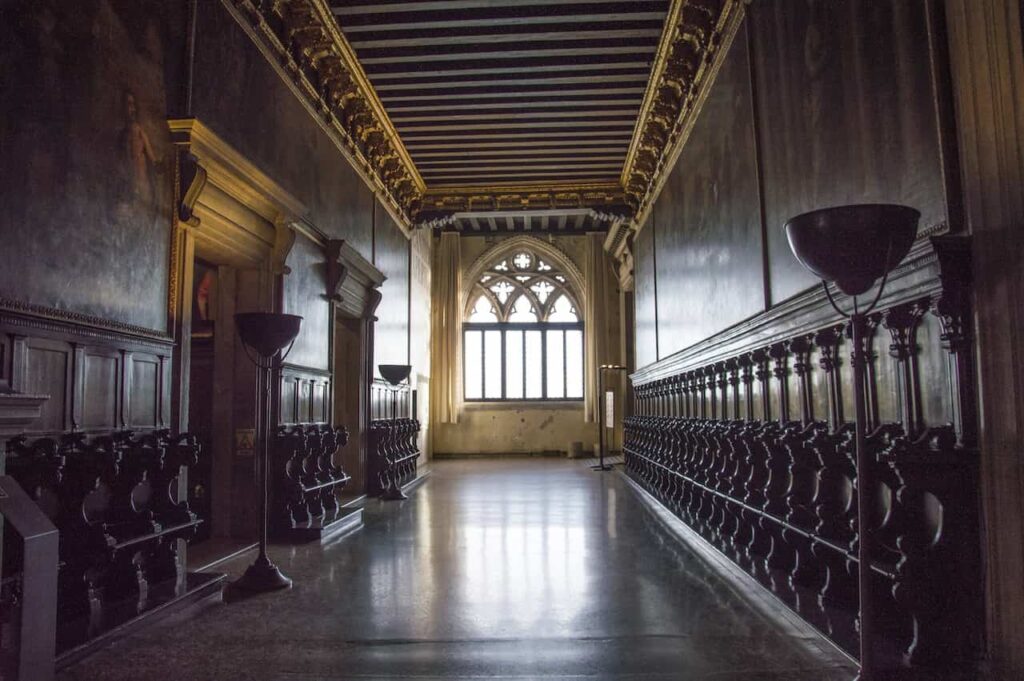
This room was used as an antechamber to the Great Council Hall .
The gilded beamed ceiling dates back to the 16th century and features works by Domenico Tintoretto (Governor Giovanni Bembo in front of Venice, depicting sailors, transformations and allegorical figures presenting a model of a galley in Santa Giustina), Jacopo Palma (in front of the Virgin with figures representing the city, religion and discord, Patriarch Marcantonio Memmo), among others.
On display in the adjacent vestibule are the sketch of the mosaic for the second external portal of St. Mark’s Basilica by Sebastiano Ricci (‘Arrival in Venice of the Body of St. Mark’) and three sculptures by Antonio Rizzo (‘Adam and Eve’, ‘The Shield Bearer’), intended to decorate the Foscari Arch.
Hall of the Quarantia Civil Vecchia
The room housed the Magistracy of the Council of Forty , which operated in judicial matters. In the 15th century, the Council was divided into three councils:
- The Criminal Quarantine for Criminal Offences
- The Quarantia Civil Vecchia for the Lawsuits and Appeals of the City Venice
- The Quarantia Civil Nuova for the Lawsuits and Appeals of the Mainland
The space, which took on its original conformation in the 17th century, is dominated by the large Gothic window on the side of the river , and preserves behind the wooden dossals on the perimeter, traces of a fresco from the previous decoration.
The 17th-century canvases depict themes related to the celebration of Venice.
Guariento Hall
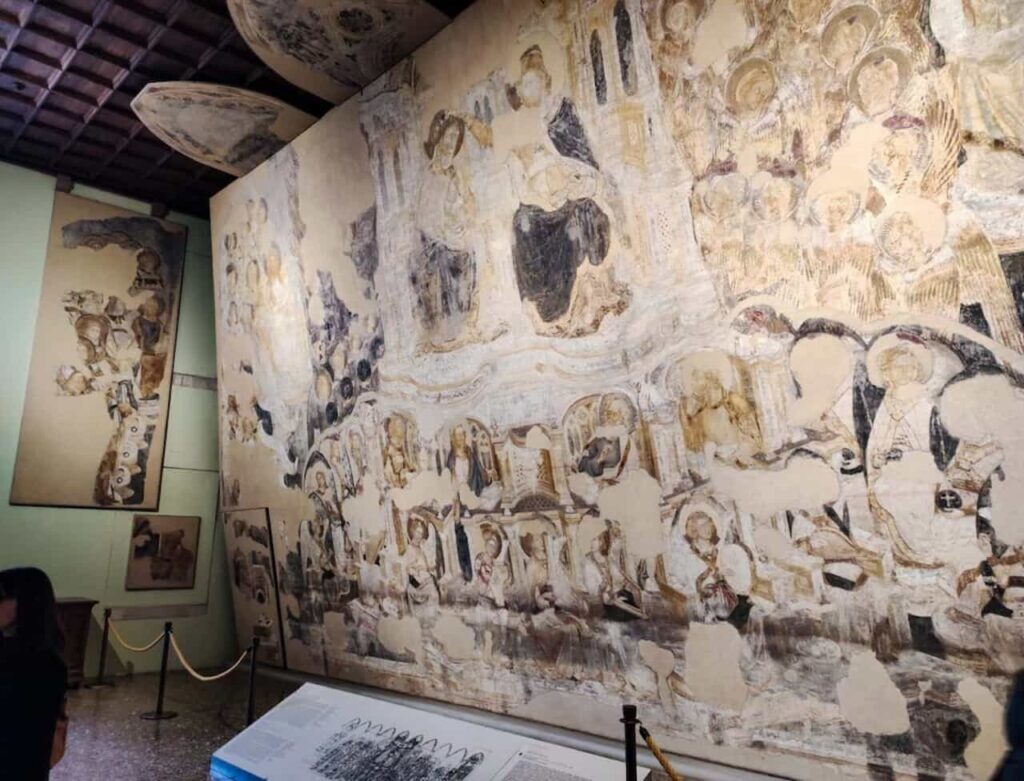
This small room was used as an ammunition depot, as well as a resting place for the military corps that supervised the meetings of the Great Council.
The interior houses the large 14th-century fresco by Guariento , which was found under Tintoretto’s painting of Paradise, and then detached and relocated in 1903. The work represents the Coronation of the Virgin seated on a throne next to the Redeemer.
Great Council Hall
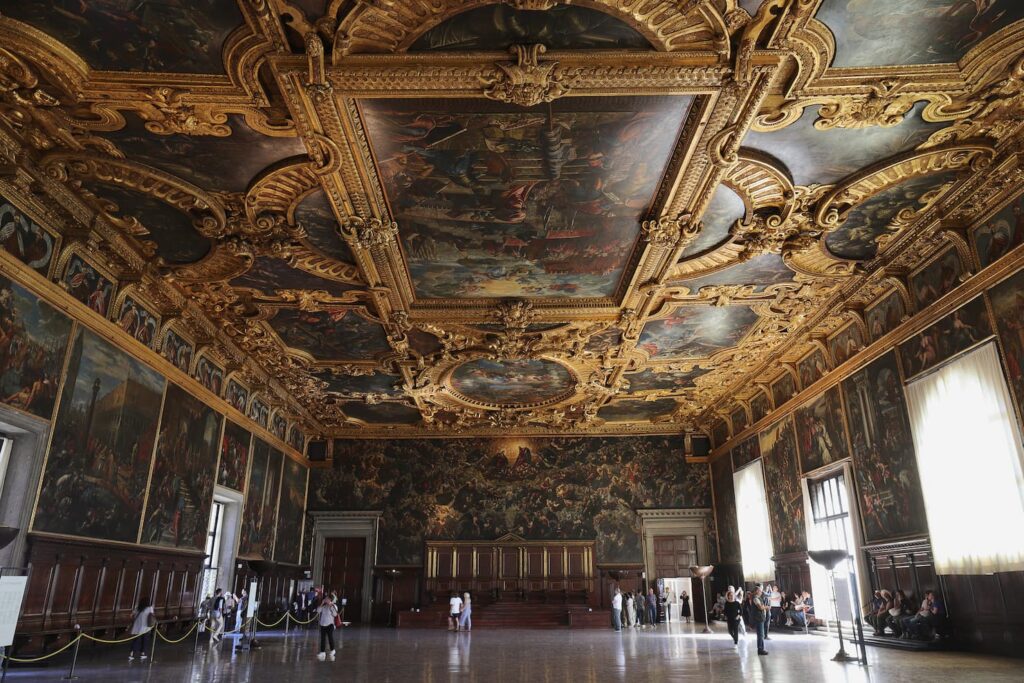
The wing of the Doge’s Palace facing St. Mark’s Basilica is almost entirely occupied by the Hall of the Great Council , where the Plenary Council of the Republic was held.
The Doge sat in the center of the hall with his councillors, surrounded by the three heads of the Council of Ten , the Quarantia Criminale, the Avogadori di Comun and the censors, while those entitled to vote sat on the side seats surrounding the hall and on the double seats in rows of nine.
The huge hall, measuring 53 meters long and 25 meters wide , could seat more than 2,000 people , occupying almost the entire wing of the palace facing St. Mark’s Basilica.
The wooden ceiling is completely covered with gilded and painted canvases , and its structure consists of a system of beams and trusses capable of supporting the heavy ceiling without the aid of columns.
The walls are covered with large canvases depicting episodes from the history of Venice, such as the Fourth Crusade in 1202 and The Peace of Venice, which concerns relations with the Papacy and the Holy Roman Empire.
The canvases that adorn the roof of the room depict the deeds and virtues of valiant Venetian citizens , while in the center is the Triumph of Venice Crowned with Victory , an allegorical eulogy of the Republic by Veronese. It depicts a Venice crowned with glory and surrounded by honor, peace and happiness, with the entire Venetian society, from the nobility to the people, protected by mounted guards.
Toward the courtyard are depicted twelve episodes relating to the events of Alexander III and Frederick Barbarossa .
Under the ceiling is a frieze by Tintoretto , with portraits of the first 76 doges of Venice (804-1556).
At the end of the room is a painting of “Paradise” painted by Jacopo Tintoretto between 1588 and 1592.
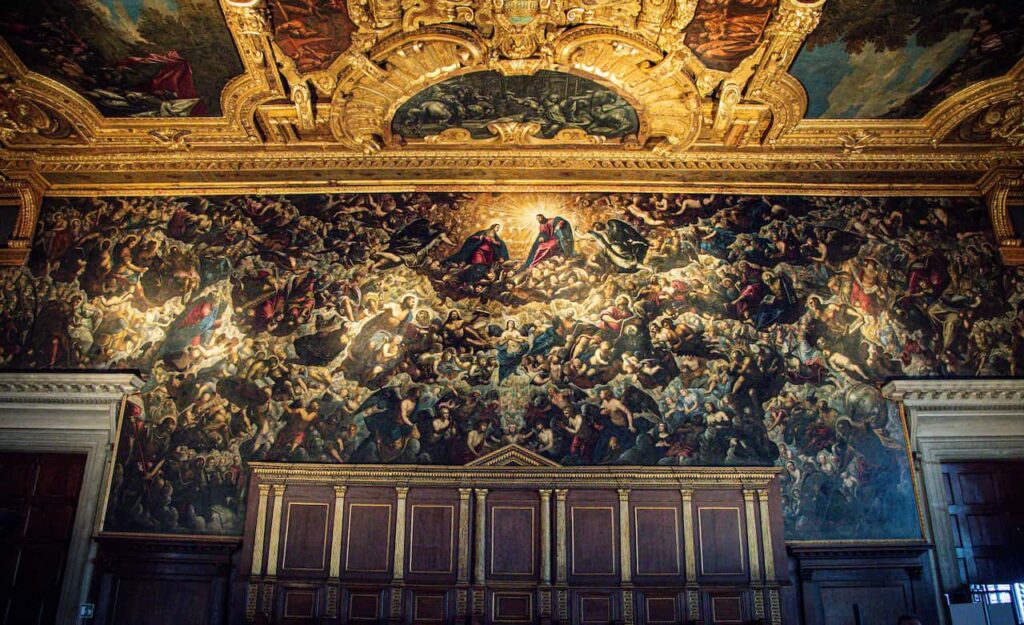
The painting features Jesus and Mary as protagonists, with the light descending on them and the Holy Spirit descending right on the tympanum of the throne on which the Doge sits.
The theme is not only religious, but also an allegory of good governance , of the light that enters the figure of the Doge and the divine essence that enables him to always make the right decision.
Scrutiny Hall
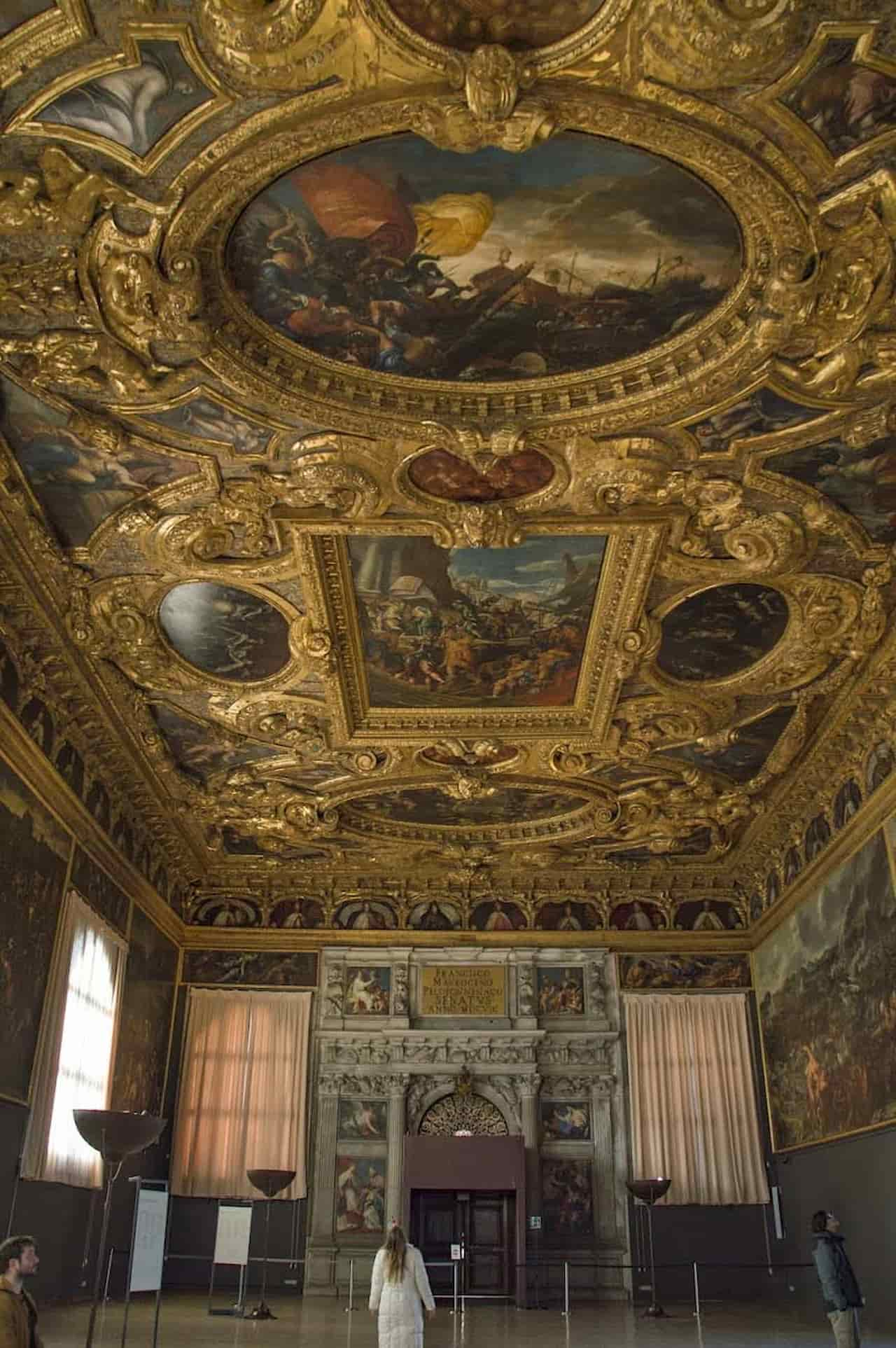
By trespassing through the corridors and adjoining rooms where the Quarantia Civil Nuova was opened, one arrives at the voting room .
Before being destined for this purpose, it housed precious manuscripts donated by Francesco Petrarca and Cardinal Bressanone to the Venetian Republic and later transferred to the Biblioteca Marciana.
The original works in this room were destroyed by fire in 1577 . The new design was created by Cristoforo Forte.
The wall paintings depict the illustrious exploits of the citizens of Venice . Of particular note is the painting of the Last Judgement by Jacopo da Palma il Giovane (1594 – 1595).
The Picture Gallery
Starting in 1615, a nucleus of paintings owned by Cardinal Domenico Grimani, and acquired by the Venetian Republic after his death, was exhibited to the public in the rooms of the Doge’s Palace. The Flemish easel paintings, which had nothing to do with the history of the place, were soon permanently exhibited in the rooms of the Palace.
Marco Boschini, in his ‘ Guide to Paintings ‘ in Venice in 1664, mentions ’15 small paintings by Civetta (Heri de Bresse) in the path leading to the Council of Ten room, and a triptych of crucified saints, the Martyrdom of Santa Liberata, by Jeronymus Bosch’.
In 1773, Anton Maria Zanetti confirmed that the 15 paintings Boschini had seen a century earlier were in the palace.
Zanetti stated that these were eight landscapes in the antique style , a triptych and four compositions ‘with eccentric inventions’, which he attributed to Civetta, and which were exhibited in the Sala dei Tre Capi of the Council of X from 1771, together with the triptych of Santa Liberata.
In the 1770s, in an attempt to re-establish this tradition, a space was created in the hall of the Magistrate of Laws , together with the hall of the Three Chiefs, to display the original paintings existing in the palace, including the panels by Yeronymus Bosch , now in the Accademia Gallery in Venice.
The building was also used as the main exhibition space of the Palace .
The current layout of the Hall of the Criminal Quarantia , the Hall of the Hides and the Hall of the Magistrate of Laws was part of this tradition, where easel paintings from private collections were also exhibited, alongside decorative apparatus.
The Vision of the Apocalypse , the only Flemish work visible to the public in the palace after 1615, had previously been attributed to Owl, but is now attributed to an anonymous follower of Bosch.
Next to it is a 16th century Flemish painting by Maarten de Vos . Next to it are 16th century Flemish paintings by Maerten de Vos, Quentin Metsys and Frans Floris .
The other rooms display masterpieces by the best of Venetian art – Giovanni Bellini, Titian, Jacopo Tintoretto and Giambattista Tiepolo – Anthony van Dyck . The exhibition also includes works by the ‘heroine’ painter Artemisia Gentileschi .
Criminal Quarantia and Leather Hall
This room was one of the three Quarantia (the highest courts of appeal in the Venetian state); the Quarantia Criminal, founded in the 15th century, dealt with criminal decisions .
Its members were also members of the Senate, which also gave them legislative powers. The hall is decorated with wooden stalls dating back to the 17th century .
The next room was the archive of this judiciary.
It is assumed that the walls were lined with shelves and cupboards , of which the one on the back wall is an example. The gold-embroidered leather called ‘cuoridoro’ on the other walls is not original furniture.
Hall of the Magistrate of Laws
This room housed the authority of the administrators and enforcers of the laws and orders of the municipal offices of St. Mark’s and Rialto, created in 1553 and entrusted to three patricians whose task was to enforce the laws that regulated the legal profession.
In Venice, a pre-eminent commercial city, the judicial branch was of great importance (one thinks first of all of the enormous number of lawsuits, disputes and trials caused by the existence of such a vast market as the Rialto).
Bridge of Sighs and New Prisons
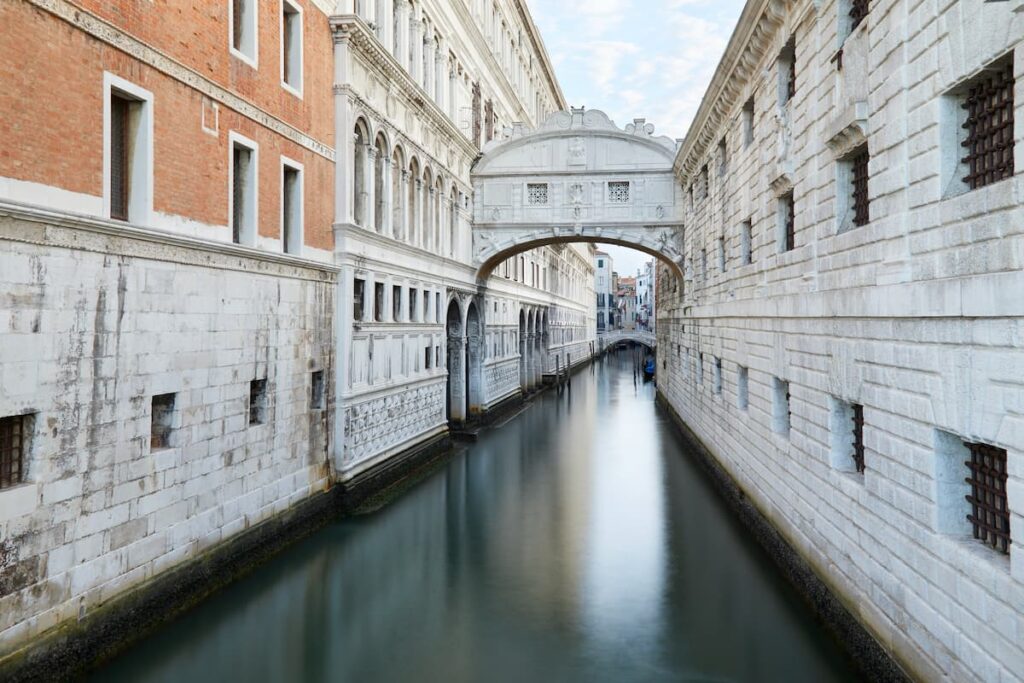
The construction of the bridge took place in the early 17th century, in conjunction with the renovation of the prison of the Doge’s Palace in Venice, which had been devastated by the great fire of 1577.
The interior consists of two narrow corridors separated by thick walls , the first leading to the Hall of the Magistracy and the second to the Hall of Avogadria and the Parlatory.
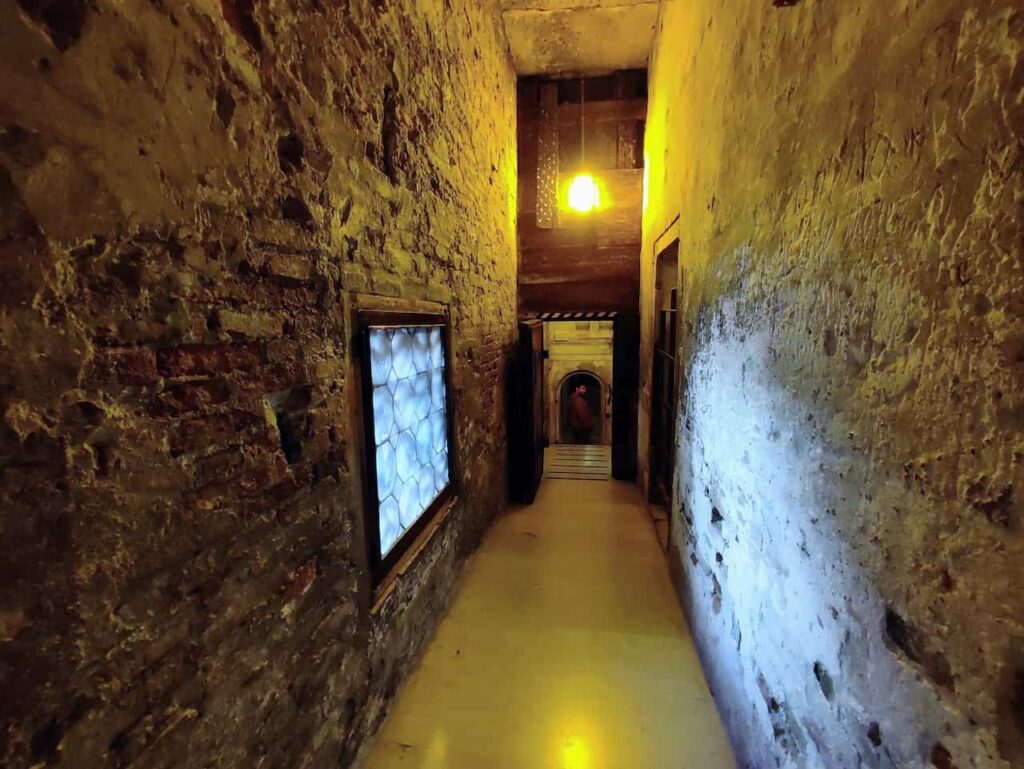
In 1602, Doge Marino Grimani commissioned the Swiss-Italian architect Antonio Contin, grandson of Antonio da Ponte, the architect who built the Rialto Bridge .
The plan was to build new prisons of modern design , on the opposite bank of the Rio di Palazzo, and to connect them to the Doge’s Palace by means of the bridge , designed as a completely closed suspended passage to prevent prisoners from escaping.
After crossing the Rialto Bridge, you will find yourself directly inside the New Prisons, where you can observe the old prison cells of the building until you reach the inner courtyard.
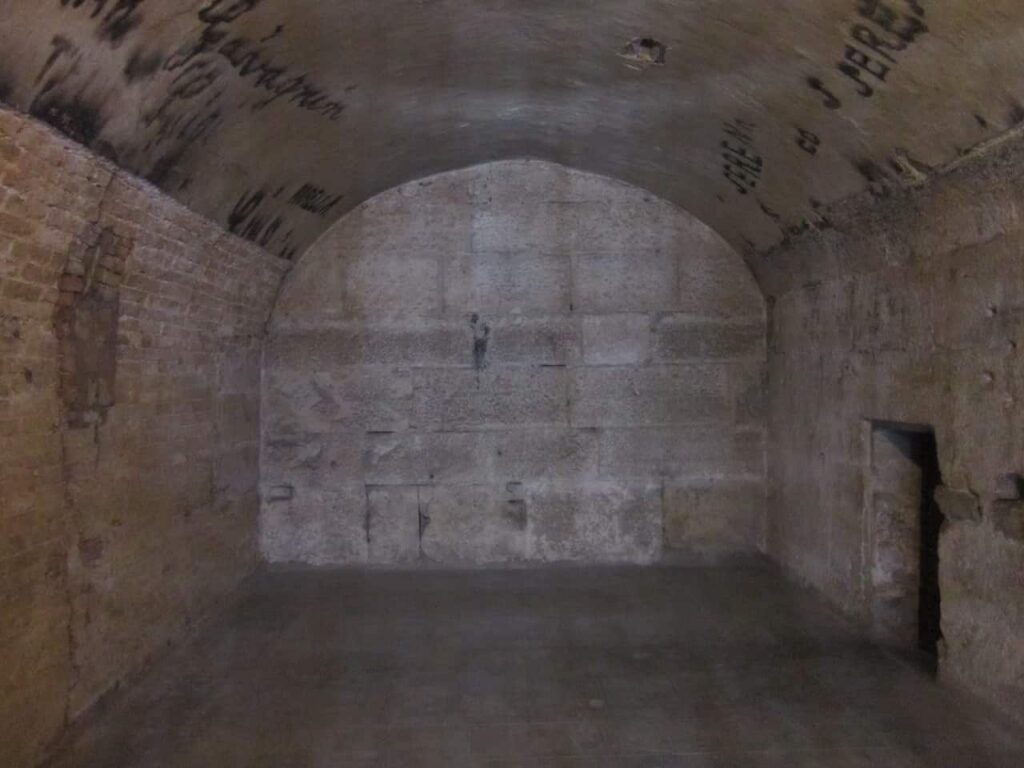
The last room of the prisons displays archaeological finds with interesting examples of handicrafts, especially ceramics, from different eras, from Roman to modern times, collected during excavations carried out by the Venice Environmental and Architectural Heritage Office as part of the restoration of the historic center and the lagoon.
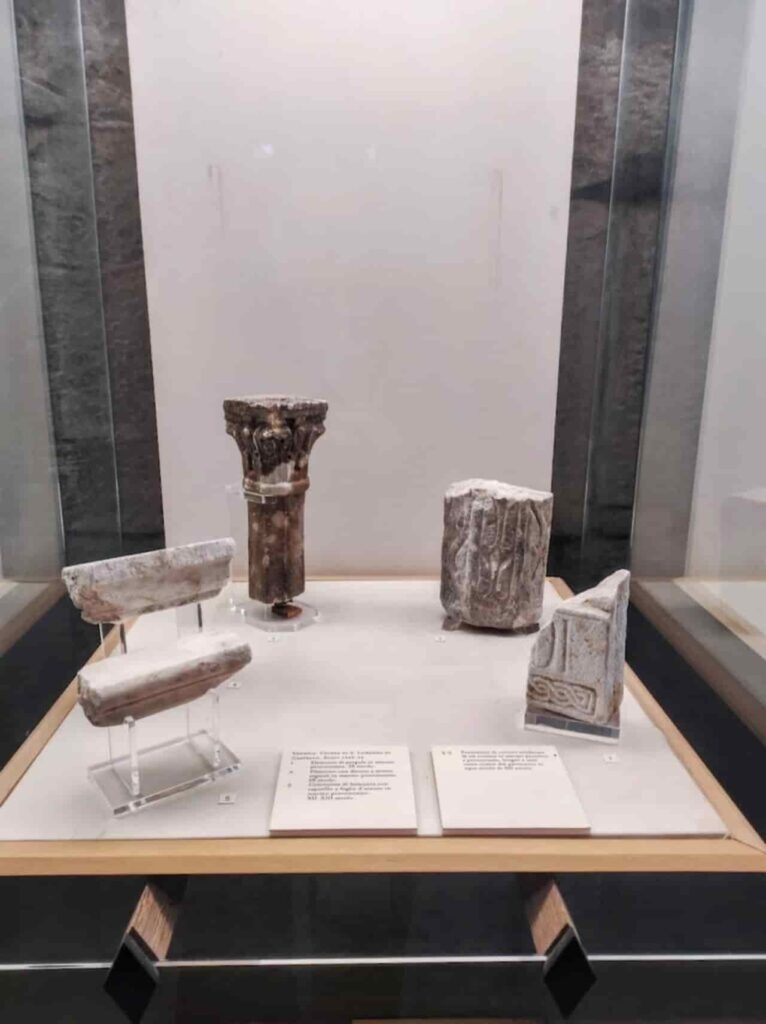
The oldest specimens come from the deepest part of the excavations carried out in 1902 in St. Mark’s Square after the collapse of the bell tower, where fragments of Roman, late antique and early medieval amphorae and numerous food remains (animal bones and mollusk shells) were found, as well as other more recent artefacts dating back to the 16th and 17th centuries.
Excavations in the church of San Lorenzo di Castello, on the other hand, yielded Byzantine and Middle Eastern vases from the 11th and 12th centuries, as well as locally produced common pottery from the 9th and 10th centuries and Middle Eastern ceramics from the 11th-12th centuries.
A large quantity of graffito ceramics was also found. Bowls, plates, basins and jugs; most of the material, estimated to date between the 14th and 16th centuries, comes from the excavations at Malamocco and from the National Archives in Venice (formerly the Frari Monastery), where a few shards of imported ceramics, in particular of Hispano-Moorish origin, were recovered in association with local pottery.
Findings from the restoration of the New Prisons and the restoration of the National Archives document the continuity and consistency of local manufacturing over the centuries until the early 19th century.
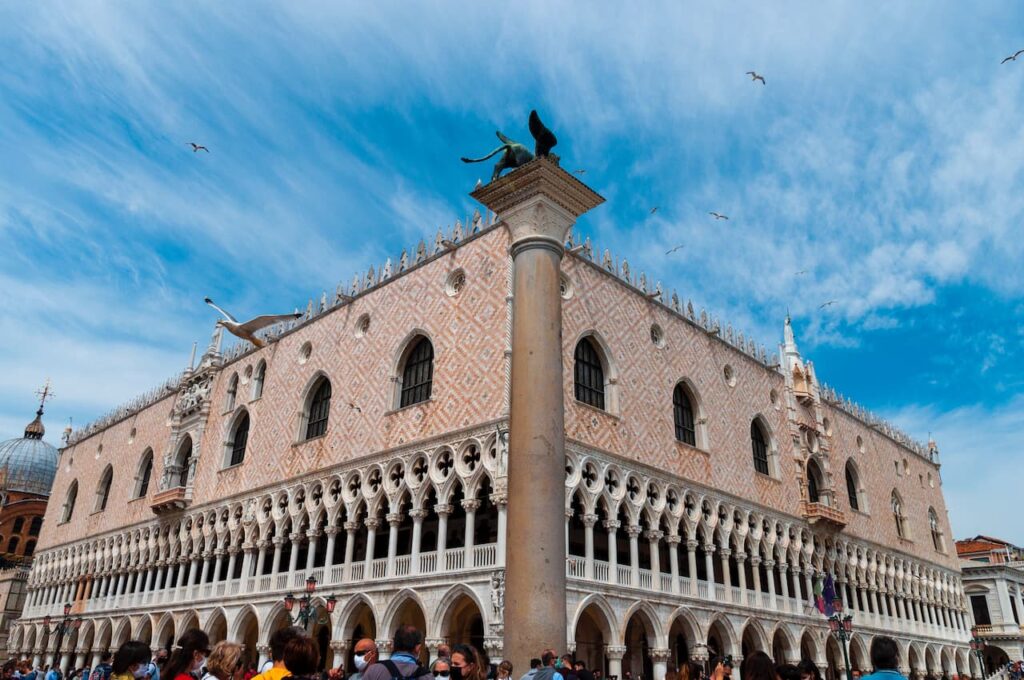
Institutional Halls (Part III)
After crossing the Bridge of Sighs and the New Prisons you will be taken back inside the Doge’s Palace, where you can complete your tour of the institutional rooms .
Hall of Censors
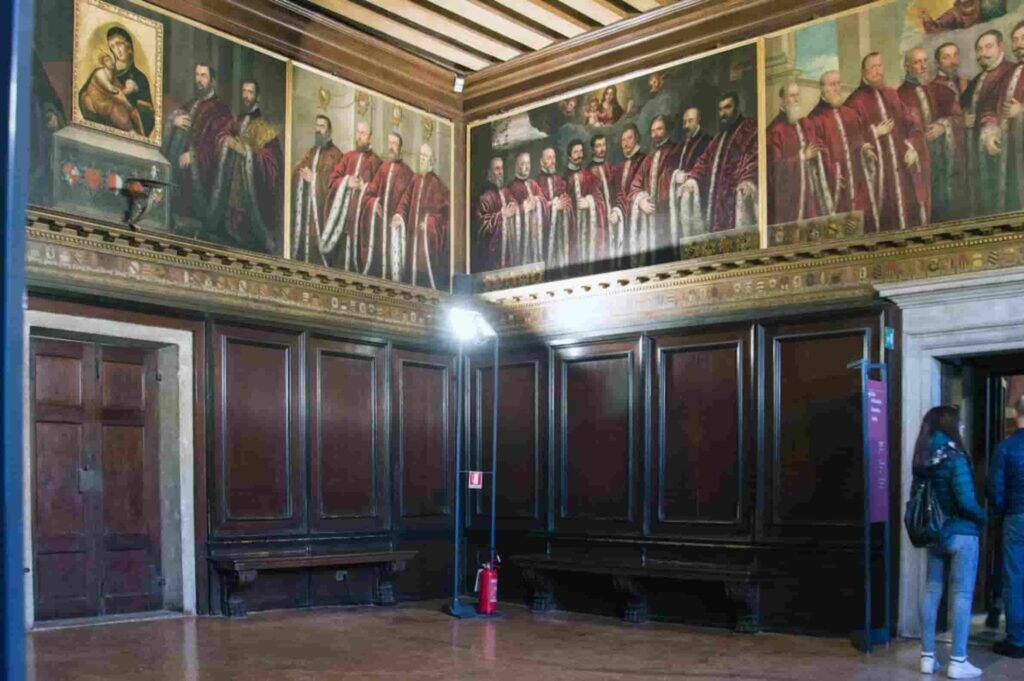
Here is a room dedicated to judicial bodies : the figure of the Censor was established in 1517 on the initiative of Marco Foscari di Giovanni, cousin of Doge Andrea Gritti (1523-1538) and nephew of the great Francesco Foscari.
In reality, the censor was not a judging body but a moral advisor . A series of paintings by Domenico Tintoretto depict various magistrates on the walls, with the coats of arms of those who held this office underneath.
Avogaria Hall
The Avogaria de Comun, as its name suggests, is a very old judicial institution, dating back to the Commune period (12th century), where the task of the three avogadors was to uphold the principle of legality , i.e. the correct application of the law.
Until the fall of the republic, it constituted, after the Council of Ten, the most authoritative administrative body for the defense of the law.
They also controlled the purity of the nobility , i.e. the legitimacy of noble marriages and births recorded in the Golden Book. In this room, the avogadors are depicted performing acts of devotion in the presence of the Virgin, the risen Christ and the saints.
Casket Room
The Venetian aristocracy originated from the ‘ Serrata ‘ of the Grand Council in 1297, but only later, at the beginning of the 16th century, was a set of rules decided upon to protect the nobility.
Marriages between nobles and people of different social classes were banned and checks to confirm the title of nobility were strengthened.
Thus, if someone did not formally notify themselves, they risked being excluded from the nobility and, consequently, from participation in the Grand Council and political activity.
Thereafter, all nobles, regardless of the social status of their wives, were obliged to present the marriage certificate to the avogaria .
In other words, in addition to the requirements of ‘civility’ and ‘honor’, these were people who could boast ancient Venetian origins , i.e. those who provided the state with a host of officials, including the ducal secretariat.
The gold book and the silver book were kept in the casket in this room. The one seen today, which occupies three sides of the niche, dates back to the 18th century and is lacquered white and decorated with gold .
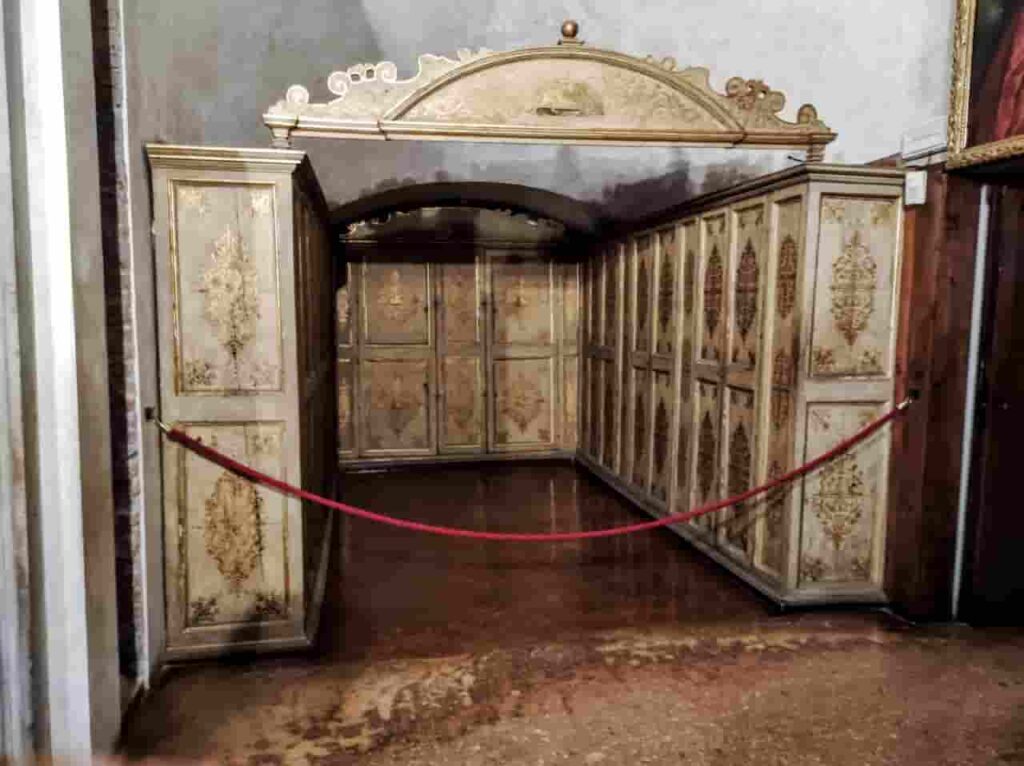
Militia da Mar Hall
Established in the mid-16th century, this body consisted of about twenty members of the Senate and the Great Council and was responsible for recruiting crews for the war galleys.
This was not an easy task, given the numbers needed for the vast Venetian fleet.
This office was associated with a magistrate called proveditori all’armar, who was mainly in charge of the fitting out and dismantling of ships, i.e. the hull and provisions on board.
The furniture in the dossal hall dates back to the 16th century, while the torches on the walls date back to the 18th century.
The next room was the office of the Lower Chancellery . From here one could exit into the loggia, overlooking the Scala dei Giganti.
Special tours of the Doge’s Palace
Secret itineraries.
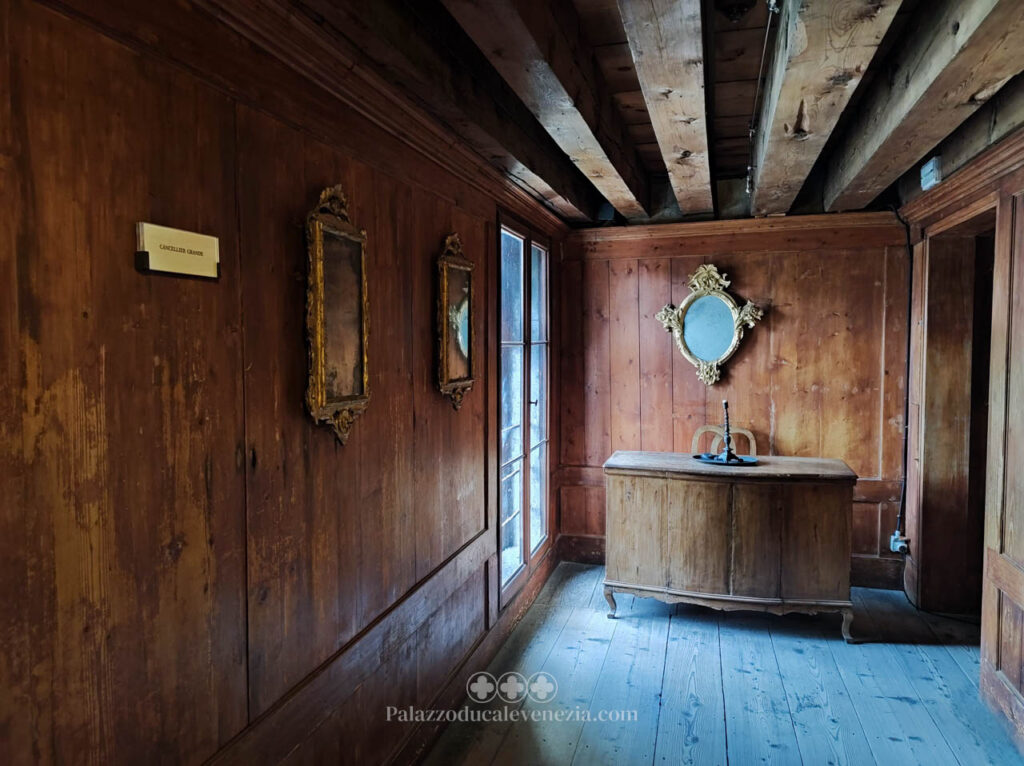
The ‘ Secret Itineraries ‘ guided tour includes, in addition to the canonical tour of the palace, described in the previous paragraphs, the guided tour inside the rooms used for the administration of justice in criminal cases . The name ‘secret’ alludes to the fact that these rooms are hidden in the palace , behind closed doors.
The tour starts from the prisons on the ground floor, then the visitor will be led through the ‘secret’ rooms of the Doge’s Palace where officials of the bureaucracy had their offices and where the supreme judicial body of the Council of Ten met, and finally the secret archive , where the most important state documents were kept.
The tour will take the visitor up to the attic where the upper cells, called Piombi , are located, in which political prisoners, sometimes foreigners, were locked up, including the famous Giacomo Casanova , who also managed to escape in 1757.
The tour will end in the square atrium hall , from where you can continue your tour of the palace on your own.
You can find out more about this visit by visiting the article on the Secret Itineraries of the Doge’s Palace Venice.
The Doge’s Hidden Treasures
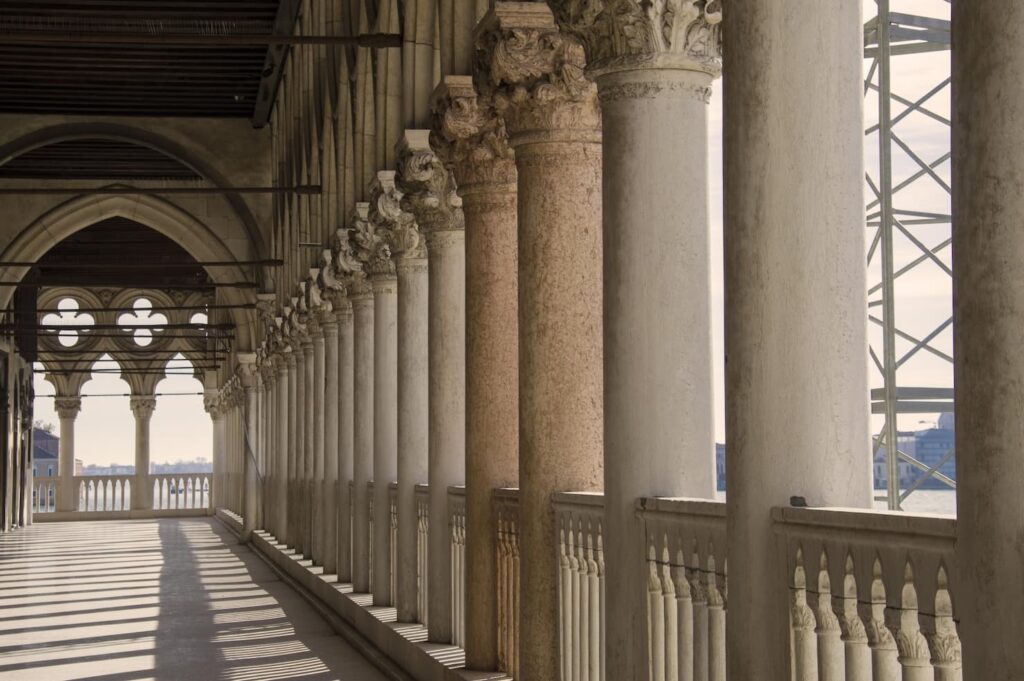
This guided tour allows you to visit the private routes, secret rooms and passages reserved for the Doge , including the privilege of admiring St. Mark’s Square from the loggia from which the Doge contemplated between two red columns.
The tour starts at the Loggia Foscara, and from here a trained guide will take you to the Foscari arch terrace, the secret archive , the treasure room , and the doge’s private chapel .
The tour ends in the antichiesetta room, and from here you can resume the visit of the palace on your own.
Read on to discover the visit route in detail .
You can find out more about this visit by clicking on the button below.
Doge’s Palace tour Venice: FAQ
The average visit lasts two hours. However, it depends on how much you want to explore the different rooms and works, who you are travelling with, and how much time you have available. If you would like to know more, read the article on how long a visit to the Doge’s Palace Venice lasts .
If you would like to visit the Doge’s Palace on your own, you can purchase a ticket for the Doge’s Palace . If, on the other hand, you would like to visit the building together with a professional tour guide, you can purchase a ticket for a guided tour of the Doge’s Palace .
The full price ticket to the Doge’s Palace costs €30, the reduced one €16. For more information, read the article on the cost of tickets for the Doge’s Palace in Venice .
The standard ticket for the Doge’s Palace Venice includes a visit to the Doge’s Palace, the Correr Museum, the National Archaeological Museum and the Basilica Marciana.
Of course! You can follow the self-guided walking tour found in this article and visit the Doge’s Palace in Venice on your own.
Doge’s Palace self guided tour: conclusions
Here we are at the end of this long post on visiting the Doge’s Palace in Venice, in which I have listed in succession all the rooms you will be able to visit and the secret itineraries provided by the museum.
If you have any doubts or other questions, leave a comment below , I will be happy to answer you!
Related posts

Doge’s Palace Hidden Treasures Tour: Useful Info, Review, Tickets
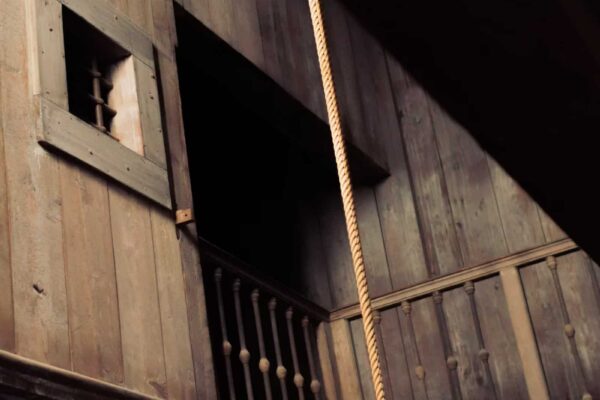
Doge’s Palace Secret Itineraries Tour: Useful Info, Review, Tickets
Leave a reply cancel reply.
Your email address will not be published. Required fields are marked *
Post Comment

Join a Guided Venice Walking Tour & Discover Its Enchanting Secrets
V enice in Northern Italy is often referred to as the “City of Canals” or the “Queen of the Adriatic,” is unlike any other place on Earth (no Venice in Vegas is never an option!)
While we’re not raving fans of Venice, we do think it should be on every traveler’s bucket list, simply because it is so unique with a long history worth learning about.
One of the best ways to see mysterious Venice, is on foot. While a Venice walking tour doesn’t take you around the entire city, it does take you to the unmissable sites, and a few hidden gems, whilst simultaneously interacting with the locals and getting tips for visiting the city.
If you’re like us and you’re only visiting Venice for a day (that was more than enough for us) then you might be tempted by a walking tour of Venice.
But is it worth it? What do you see? And which walking tour organization should I go with? These are all excellent questions, which we will be answering below.
What is the best way to see Venice?
- Rialto Neighborhood: Venice's First
The Rialto Bridge
Wandering the alleyways, marco polo house, campo san giovanni e paolo, st mark’s basilica vip access, let’s finish with a gondola ride, local venetian tour guide, other venice tour options with walks of italy, final thoughts on a walking tour of venice.
Venice is not a huge city and so the best way to see it is on foot. You could easily walk around the main historic sites within an hour. If you require public transportation in Venice, your best bet is to hop on a water taxi.
The Venice Walking Tour Itinerary
Nestled on a cluster of 118 small islands in the Venetian Lagoon along the northeastern coast of Italy, Venice’s distinct beauty is immediately apparent.
The city’s architecture, prevalent in Gothic and Renaissance palaces, as well as iconic canals, and romantic gondolas make it a dream destination for many.
However, while its intricate network of canals, alleyways, and bridges conceal hidden treasures waiting to be discovered, it can also lead you to feel lost in a maze of winding streets.
With a limited time for sightseeing, how do you know how to fit it all in, not get lost, and experience its enchanting secrets?
If you’re wondering what a walking tour experience of the floating city is like, here’s where our three hour guided tour took us:
Rialto Neighborhood: Venice’s First
We started our tour outside Chiesa di San Giacomo di Rialto, Venice’s first church and the city began on 25th March 421.
Legend has it that Venice began with the population from the mainland trying to find a place where they felt more protected from their rivals. The lagoon and marshlands provided them with that.
After our introduction to the city and tour, Paolo, our local tour guide, guided us through this Rialto neighborhood, along the canal, and through the fruit and vegetable markets and Rialto Fish Market, which closes at midday due to the heat.
We didn’t get to see the bustling Rialto market that draws people from all over Venice, but we got to experience its lingering smell!
It was a wonderful way to start the tour away from the crowds and learn more about Venetian life including its love for good seafood and prosecco, which comes from Venice! Venice also has its own winery, which you can enjoy on this wine tasting tour !
On the way to Rialto Bridge, we passed the souvenir shops on the main street. I bought a lovely pink scarf from here – out of necessity -as Kalyra was wearing shorts, and knees and shoulders must be covered when entering St Mark’s Basilica – one of the best stops on our Venice waking tour.
In the past, these souvenir markets were filled with luxury products like silk and spices as Venice was a central stop on the space trading routes, helping it to become an important economic global center in 1300s and 1400s.
No walking tour of Venice would be legit, if you did not walk over the oldest bridge across the Grand Canal. As a central crossing point, it has always played a vital role in the daily functioning of the Republic of Venice.
In the middle of the bridge are more souvenir shops which have been there since its beginning.
The Rialto Bridge dates to the 12th century and was built as a wooden structure, but it collapsed twice before they decided to reconstruct it in the more reliable stone between 1588 and 1591 by Antonio da Ponte.
We stopped here briefly to marvel at the bridge’s architectural beauty, snap our “I was here photo”, and watch life go by on the Grand Canal. Paolo steered us over to the other side of the bridge – the less crowded side for a different but just as enjoyable Grand Canal view.
Top Tip: Get to Venice early, ( like we did ) and visit the bridge before 10am for views without the crowds.
With her small flag to help us see her through the crowds, Paolo zig zagged us through the quiet squares and alleyways that whisper stories of the past.
She shared those, but also practical tidbits like where to chow down on the best local eats and how to navigate the maze-like city streets are on the menu too.
I enjoyed learning more about Venetian life including the need to get around on ferries or gondolas to escape the 30 million visitors a year, and their obligations to clean up the mess, including dog poo.
Venice has six districts, three on one side of the Grand Canal and three on the other. If you have more time in Venice, it’s worth exploring to appreciate life in Venice beyond the top tourist attractions.
This continued as we wandered the narrow alleyways of Corte del Milion to visit the site of Marco Polo’s house in the quarter of San Giovanni Crisostomo.
The famous explorer and merchant lived here for the last 25 years of his life, until January 1324. We learned a lot about his life as we stood in this square.
The original house unfortunately burnt down in 1596. All that remains is a great archway with a beautiful Veneto-Romanesque arched lintel and on the foundations of this big house, in 1678, the actual Malibran theater was constructed.
Some of the gondola rides will pass by it. I did on my first visit to Venice, but our gondola ride this time did not. Our tour proceeded on the other side of the building for views from the canal.
Paolo told us a lot about Marco Polo’s travel life, which was one of my favorite parts of this walking tour.
We winded through more alleyways, learning more about Venetian life to the much quieter Campo San Giovanni e Paolo, for an espresso break.
In Venice campo is piazza, which means grass meadow. Each Island in Venice has its own campo serving the villages, and each campo has a church named after it, and a community well. The villagers would build tanks and fill them with sand to filter the brackish water into drinkable water.
It’s one of the largest squares in Venice and is where you’ll find Santi Giovanni e Paolo, one of the largest churches in the city. It’s named after St John and Paul the protectors and has the status of a minor basilica. Twenty-five doges are buried here.
Paolo also told us more about the Scuola Grande di San Marco hospital on the square, which used to be the home for the brotherhood fraternity.
Here you can pay €1.50 to use the restrooms or buy an espresso for the same price or less and use their facilities with it. #nobrainer
Now we’ve had our afternoon espresso fix, it’s time to stroll past the lines and into St. Mark’s Basilica, or Basilica di san Marco, with our pre-reserved skip-the-line tickets.
Since we’d spent three weeks in Europe already, we were more than happy to visit St Mark’s Basilica on this guided tour. It’s small enough that a quick tour is more than adequate, and with a guide no time will be wasted looking at things you don’t understand.
I loved having an excellent guide point out the most key features and sharing the Venetian history of Italy’s second most important church to us. He was full of interesting facts, anecdotes and information that you wouldn’t find in the guidebooks.
St. Mark’s Basilica is another awe-inspiring Byzantine masterpiece, highlighting intricate golden mosaics, gilded domes, and exquisite relics. Prepare to have your jaw meet the floor.
It really is worth a visit, but there was no way I wanted to wait in line with most other people for hours waiting to get in. Skip the line with our Walks of Italy guided tour was impressive.
We also passed through St Mark’s Square, or Piazza san Marco, which was half taken over getting ready for an evening concert. To be honest, I find St Mark’s Square very underwhelming. As it’s open and free, you can visit it at any time on your trip to Venice.
You really can’t come to Venice and not do a gondola ride. There are some touristy attractions that just have to be done.
We finished our guided walking tour with the 30-minute gondola ride. It was part of the tour, which meant we could skip the lines!
When you see that some of the gondola rides are the same price as this three-hour walking tour, you can understand the value of doing this tour as it’s included!
With just a handful of fellow adventurers on board, you’ll glide through the dreamy waterways, soaking in the cityscape designed for this exact view.
As we were a family of four, we had a gondola all to ourselves, which we really appreciate. And since we were on the afternoon tour, we rode the gondola at the ideal time – late afternoon to early evening, just as the sun hit golden hour.
This is the time when the Venetian architecture and quaint canals are awash in golden light, illuminating their finer details and intricate designs.
Taking a gondola ride in Venice is like stepping into a dream. As you drift along the city’s labyrinthine canals, you’ll be transported back to a time of romance and elegance.
Is a Guided Walking Tour of Venice Worth It?
We recommend joining a guided tour of Venice, like we did with Walks of Italy. They have various tour options to see all the sights and more.
The longer I travel (and with kids), especially now to destinations like Europe that have such a rich history, the more I see the value in guided tours.
It allows me the opportunity to switch off from being mum and head tour guide, and connect a little deeper to the destination, the city’s history and culture. Otherwise, it gets lost in a sea of complaints, bored brains, tired feet, crowd hustle, and endless navigation.
Even if you have more than a day in Venice, a guided tour is a great way to orient yourself to the city and discover places you want to return to for a deeper look, and a more lingering Venice experience. Just ask your local guide to tell you some of those hidden secrets!
If you’re ready to dive into the enchanting vibes of Venice without getting lost in a sea of maps, this is the tour for you. In just three hours, you’ll go from being a tourist to a Venice insider, all thanks to your local guide’s passion and know-how.
We joined the Welcome to Venice: Walking Tour, St Mark’s Basilica & Gondola Ride tour as guests of Walks of Italy (but under no obligation to write this post).
We also did a guided walking tour in Florence with Walks of Italy and food and wine tour in Florence , a street food tour of Rome , and Montmartre food tour in Paris with their sister company Devour Tours and found both companies and tours to be professional, informative, and enjoyable.
One thing I love about Walks of Italy is that all tour their professional guides are local – either born and bred – or have lived there for some time. They also often have art and history degrees so are deeply knowledgeable about the area they are guiding you through.
Our local guide Paola has lived in Venice for over two decades and was very passionate and well versed in Venetian culture and way of life.
Listening to Paola describe everyday life in Venice was the first time I understood why people would live here and battle the never-ending threat (and reality) of encroaching flood waters. (not too mention the never-ending tourists!)
She was kind, gentle, and attentive, answering all questions and keeping us at a gentle pace but making sure we didn’t miss anything.
Unfortunately, we did have some tourists behaving badly on our tour. I’ve done hundreds of tours around the world, and this was the only time I’ve experienced such embarrassing behavior.
It was a gift for my girls to see this and appreciate their own respectful behavior but to understand the importance of considering others.
It’s important for you to know this behavior is NOT normal, is in no way indicative of the Walks of Italy tour and did not spoil it.
What it is indicative of is the classy way Paola handled it. She was firm and direct and artfully knew what behaviors to ignore and which ones to address. Everyone else on the tour spoke so highly of her because of it and had deeper gratitude for her.
Walks of Italy have other options for guided tours of Venice. We wanted to join their Venice Boat Tour with Grand Canal & Clock Tower Climb but it was sold out. So be sure to book in advance !
As we enjoyed our Europe food tours so much, and Venice has a unique and delicious food scene, their Cicchetti, Food & Wine Tour at sunset would be a highlight!
With more time in Venice, you may want to escape the crowds with this enchanting day trip to Venice’s lesser-visited outer islands, such as the Island of Murano & Burano, complete with an exclusive wine tasting and private glassblowing demonstration from master glassmakers.
With its enchanting labyrinth of waterways, historic architecture, rich cultural heritage, and iconic landmarks, Venice has captured the imaginations of travelers for centuries.
Taking this guided walking tour of Venice will allow you to toss those maps aside and effortlessly explore Venice and form a deeper connection to its history, culture, and people one quirky alley and majestic bridge at a time!
Wondering what else to do with the rest of your day in Venice? We have you covered: Check out our one-day itinerary of Venice with a few hidden food spots, and our surprising favorite tour. We also have a post sharing the top things to do in Venice and tips for visiting Doge’s Palace.
And while you are in this region, you must visit Verona . We stayed in Verona and traveled to Venice for the day. Many people do it the other way around, but for me, Verona has my heart. It’s a charming and romantic Italian town with more space and fewer crowds than Venice. See more tips and ideas in our Northern Italian itinerary .
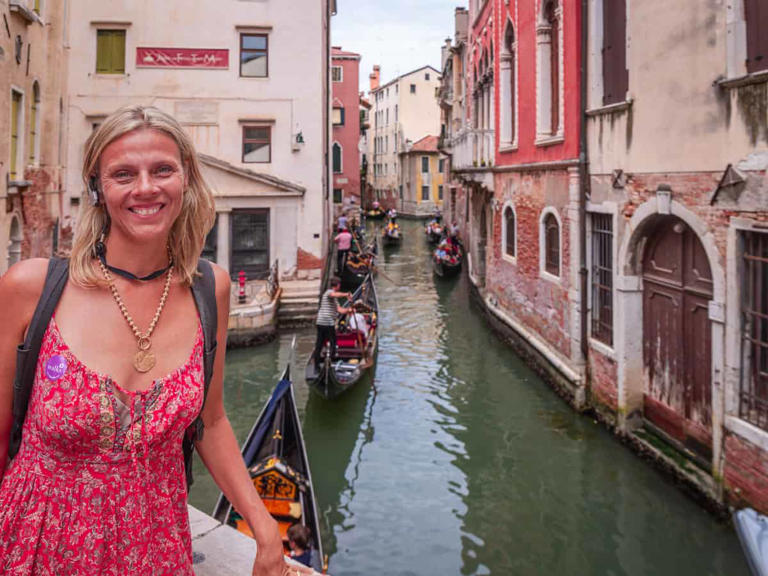

IMAGES
VIDEO
COMMENTS
Experience Venice on foot. Book the perfect tour today! Full Refund Available up to 24 Hours Before Your Tour Date, Quick & Easy Purchase Process
Order Your Venice Tours With Expert Guides Guaranteed. Book Tickets for the Best Prices. Experience The Best of Venice. Discover Italy. Order Now!
The Ultimate Self-Guided Venice Walking Tour [UPDATED 2023] on July 5, 2020. *I may be compensated if you purchase through any affiliate links on this site. Thank you for supporting the Creative Adventurer*. The city of Venice is made up of 118 islands, 400 bridges and 150 canals. But you might be surprised to learn it's a pretty walkable city.
Venice Walking Tour The Walking Tour Route. Distance: . This self-guided walking tour loop is 2.8 miles/4.5 km long. The Libreria Acqua Alta is the half-way point of the walk, to the far right of the map.. Walk half the loop or do the full tour. Either way, it's a great way to spend the day exploring the less-trodden neighborhoods of Venice.
That's why these self-guided walking tours of Venice are the best! Whether you are staying in Venice for a day (from a cruise ship or for another reason), or you are staying on one of the islands for a few days, this is a great way to feel something that many don't take the opportunity to feel — a little peace and quiet.
To gain a more complete understanding of painter Titian and the real-life Giacomo Casanova, follow Casanova's Venice and Titian's Paintings Walk, respectively. In all, we have prepared 14 self-guided walks for you to explore Venice, which cover everything from the top landmarks along the Grand Canal to charming spots on nearby islands.
Tick off Venice's highlights by following this Venice half day self-guided walking tour itinerary. When we visited Venice in December of 2019, we were battling a few things. Firstly, we were coming all the way from the Alpine town of Bolzano, which is a few hours away from Venice. Secondly, we were visiting on New Year's Day (hello ...
Explore Venice's city center at your own pace, discovering its history and origins through a 4km self-guided tour with historical facts and riddles to solve. It's also worth checking out some other tours and experiences nearby. Musica a Palazzo 'Traveling Opera' Performance in Venice. From Venice: Murano and Burano Half-Day Island Tour by Boat.
Venice: Heart of the Floating City Self-Guided Walking Tour is a captivating way to take in the charm and allure of Venice. With approximately 1.5 hours of exploration, this tour takes visitors on a journey through the city's most iconic landmarks, offering a unique perspective on its rich history and architectural wonders.
Discover the charming narrow lanes of Venice and romantic canals on a self-guided walking tour on your phone. Encounter artisan workshops and immerse yourself in local life as the sun sets. About this activity. ... 13 Venice Self-guided activities. 14 Venice Activities for couples. 15 Venice Deals & discounts. 16 Venice Museums & exhibitions ...
Guide Location: Italy » Venice (See other walking tours in Venice) Guide Type: Self-guided Walking Tour (Sightseeing) # of Attractions: 16. Tour Duration: 3 Hour (s) Travel Distance: 4.1 Km or 2.5 Miles. Author: greghasleft. Sight (s) Featured in This Guide: Palazzo Ducale (Doge's Palace)
Wander through Venice's city center and learn about its origins on this treasure hunt-style historical walking tour. Follow the route on your smartphone between landmarks like the Rialto Bridge and St. Mark's Square, and enjoy 11 historical riddles to solve as you explore. Start this self-guided tour from the San Polo district.
The most breathtaking architecture awaits you on an audio tour of Venice. Perhaps one of the most famous of these is St Mark's Basilica, an ornate church right next to another hotspot, the Doge's Palace. Located in the uber-famous St Mark Square, also known as Piazza San Marco, this is a wonderful place to amble about, with a heady mix of ...
Discover Romantic Venice Self Guided Tour 7 unique itineraries that will lead you to the heart of the city. A wonderful experience to live the city walking peacefully through calli (streets) and campi (squares), discovering palaces and old taverns where you can stop for a "cicchetto" and a glass of wine.
A self guided walking tour of Venice is one of the best ways to discover the sights, sounds, and canals of The Floating City. Venice is one of the most romantic and alluring destinations in Europe. Palaces, ornate buildings, and gothic churches sit atop a lagoon, spread across islands etched with canals plied by gondolas. The city is like a ...
Explore Venice walking, playing, and learning on this self-guided scavenger hunt and walking tour in one. Using your phone as your guide, solve riddles and see the city's important attractions.
And be sure to check out our other free walking tours of Venice. This free self-guided walking tour will serve as a companion piece to a free audio tour of St. Mark's Square (Piazza San Marco). Whether you don't have headphones to enjoy the audio version or you just prefer reading about the location, this is an excellent alternative.
Venice is known for its bridges — there are over 400 of them after all! Under those bridges, some 300 gondolas roam about among the winding canals. Enjoying the waterways and bridges is one of the best free things to do in Venice Italy. Make sure to hit these famous landmarks when you use this Venice self-guided walking tour map! Rialto Bridge
Embark on an exhilarating Venice walking tour that offers a unique and interactive way to explore the city's rich history and hidden treasures. This self-guided scavenger hunt allows you to discover the enchanting city while solving riddles and puzzles at each stop. The benefits of a self-guided tour in Venice are abundant.
Guide Name: Piazza San Marco Walking Tour. Guide Location: Italy » Venice (See other walking tours in Venice) Guide Type: Self-guided Walking Tour (Sightseeing) # of Attractions: 10. Tour Duration: 1 Hour (s) Travel Distance: 0.6 Km or 0.4 Miles. Author: naomi.
Venice walking tour by following my self-guided tour which takes a full day and allows you to see theessential of Venice. See itinerary details below. See itinerary details below. The trap to avoid, when you only have 1 day to visit a city like Venice, is to go to the heart of the city and go a little randomly without any particular program.
The tour is free, but guided tours are also organized. In addition, you can visit the Museum at night (times vary according to the season) to get a unique and evocative perspective of the Palace and the works inside. Doge's Palace Venice skip-the-line ticket: quick access. Buy online.
Tour Duration: 2 Hour (s) Travel Distance: 3.6 Km or 2.2 Miles. View all walking tours in Venice, Italy. Self-guided walking tour: Dorsoduro Walking Tour in Venice, Italy. The detailed walk route map can be downloaded to your mobile device for turn-by-turn travel directions.
Taking this guided walking tour of Venice will allow you to toss those maps aside and effortlessly explore Venice and form a deeper connection to its history, culture, and people one quirky alley ...
Cannaregio Walking Tour (Self Guided), Venice. Venice is a city that spoils its visitors with superlative architecture, a fascinating history and of course the canals. One of the less well known, but no less fascinating parts of this beautiful city is the Cannaregio district. It is the most northerly sestiere in Venice and is characterized by ...